| 300a. Faculty Meetings with Rudolf Steiner I: Twelfth Meeting
14 Jun 1920, Stuttgart Tr. Ruth Pusch, Gertrude Teutsch Rudolf Steiner |
|---|
| In the case of these two children, they came only after Christmas. Now that we have the remedial class, it is possible to place those children who will be unable to meet the goals of the class into the remedial class; for example, those who are slow learners. |
| 300a. Faculty Meetings with Rudolf Steiner I: Twelfth Meeting
14 Jun 1920, Stuttgart Tr. Ruth Pusch, Gertrude Teutsch Rudolf Steiner |
|---|
A teacher reports about the independent religious instruction in the beginning and intermediate classes. They discussed verses from the mystery plays and “Cherubinischen Wandersmann” (Cherubic wanderer). Dr. Steiner: It is important that you don’t ignore the children’s level of feeling. Can you give a concrete example? A teacher: In the upper class, I had the children recite, “Let me peacefully act in you.…” Dr. Steiner: Do you think the children can work with that? Yes, then you can continue with it. A teacher: Perhaps we could divide the courses. Dr. Steiner: That is certainly true. I think that if we divided the beginning class in two and left the upper class as it is, things would go well in all three groups. That is, grades 1-3, 4-6 and 7-9. A teacher reports that he had used three hours for the preparatory instruction for the Youth Festival. Dr. Steiner: Isn’t that too much for the students? How many are there? A teacher: Twenty-six. Dr. Steiner: It will be difficult to say anything until we have seen a real success. It is certainly good to try that. If it is not successful, then we will need to see how we can do it differently. A teacher reports about the course in social understanding. There were two hours per week in the sixth through eighth grades, and also some for fifth grade. Dr. Steiner: Of course, the age from eleven to fifteen is difficult, but this is a separate class. A teacher: We are also visiting factories. Dr. Steiner: If you do this really livingly, make it lively, and connect it with all the questions about life that arise at that age, then things will work. I would try to see if the children have too much to do, and then try to connect things to life concretely wherever possible. I believe the children may be overworked now, and that will, of course, certainly come out in some odd place. It would be a good idea not to have eight hours on one day. I don’t understand why it is necessary to spend three hours preparing for the Youth Festival. Why wasn’t one hour sufficient? In such questions, the amount of time is not so important as the time available for them. It would, perhaps, be better if we could limit those things we can definitely limit. We could do that for those children attending the Youth Festival by dropping the independent religious instruction as such and connecting it with the preparation for the Youth Festival. A question is asked about who may attend the Sunday services. Dr. Steiner: That is certainly a problem. We had never thought that anyone other than the parents would attend. Of course, having begun in one way, it is difficult to set a limit. How should we do that? Why did you admit people who are not parents at the school? If we allow K. in, there is no reason we should send other members away. Where does that begin and where does it end? It’s mostly people who think this is just one more tea party. We have also had other disturbances by people from outside the school being at the school. The thing that disturbed me most was that people who have absolutely nothing to do with the school became involved in discipline. I certainly have nothing against strictly limiting the admission to the services to the parents, no siblings and no tea parties. We did not create that service for that. Now there are no limits. We should admit only the parents or those whom the faculty recognizes as moral guardians. A teacher asks again about an older member in connection with the Sunday services. Dr. Steiner: She should stay away. You need to make that clear to her in an appropriate way. That is the problem. The moment we allow someone in who has no child, it becomes difficult to draw the line. Where we need to make exceptions is in the Anthroposophical Society, or we simply leave it as it is. A teacher: That has been impossible to do. Dr. Steiner: The exceptions should perhaps only be for once or twice, but they grow. A teacher: It should not be strictly a school affair. It is separate from the school. Dr. Steiner: We hold the Sunday services within the context of the school. They are a part of the school in just the same way as, for instance, a class for a particular craft would be. That would also be something special that would be within the school, but not a part of the school. We can do things only in that way, otherwise we will have all these problems. I was recently asked if we could arrange to have a Sunday service in H. for their anthroposophical youth. At the present, when we are under attack from every direction, that is total nonsense. There are already such areas of attack, such as when Mr. L. stands up and conducts a service for the anthroposophical children. He has already received permission to observe our service. I would certainly deny any association with a Sunday service outside the school. It only makes sense if there are a number of children receiving religious instruction from an anthroposophical basis and there is a Sunday service in our school for these children. Thus, we would never admit someone from outside the school. A teacher: Then we should leave it that way. Dr. Steiner: We could leave things that way, but there are exceptions. It is difficult to understand how we could turn someone away when we say that Mrs. G. said they could come. Then we would have to turn away Mr. Leinhas, but he is a member of the Waldorf School Association. Eventually this will become a kind of right and will include everything connected to the school in any way. A teacher: Can we include the wives of faculty members? Dr. Steiner: Of course, we cannot admit them. If they have no children, they also have no right to it. A teacher reports about the deportment lessons. An attempt was made to teach the children a soul diet. The children brought all kinds of gossip into school. Dr. Steiner: It is unavoidable that the anthroposophical children hear things at home. That is not dangerous as long as the parents are reasonable. The healthy attitude of the parents will keep the children from becoming too wild, even though those things may go in deeply. The things we have often had to struggle against, such as those you mentioned about O.R. may arise because the parents talk about silly things. You will have noticed that the instruction is bearing fruit. I would mention that particularly in critical cases, you have had good success with stories that have a particular moral. If you are certain a child has a specific kind of misbehavior, then you can think of a story in which that type of misbehavior becomes absurd. Even with very young children, you can rid them of their greed for sweets and such if the mother tells a story that makes that behavior absurd. If you think of something along the lines of the dog who goes over the bridge with meat in his mouth, that strongly affects the child and has a lasting effect. That is particularly true if you allow some time to go by between the misbehavior and telling the story. Generally, you can achieve more when the child has slept, and you return to the subject the next day. To take up the behavior immediately after it occurred is the worst thing. That sounds very theosophical, but it is also quite true. It would also be a good idea if we, as the entire faculty, could take up individual children, or groups of children, who are a source of concern and speak about them. That seems to me to be something very desirable. It requires only that we give some interest to it. This morning I asked about P.I. He has disappeared. You remember that his father had told me certain complaints he had. It would be a good idea if we could compare what is happening with the boy to what the father is complaining about. The father appears to be a rather useless complainer, always blaming things. I will talk with the boy. It seems to me that the father always complains and picks up small things that bother the boy. Then he expands them into fantasies so that the boy does things the father suggests. The boy certainly does not know what he wants to do. That is a major problem in every school because it is so difficult to keep everything under control. Precisely in such questions, we must have complete clarity within the faculty about the individual students. Some things are very interesting when you look at the statistics in detail. I have looked at all the classes. It is striking to me that there are very few children lacking in talent and also few who are gifted, but there are a large number of average children. One sign of that is that they are all making good progress. I always want to differentiate between progress as such and the content of the progress. It is possible that some things have not gone forward, but the tempo is good. In the fourth grade, there are actually only two slow children and three who are not really moving along. However, the others, at least according to their writing, are sufficiently talented children. It is possible that there may be a number of pranksters, but those whom we have called such are actually gifted pranksters. That certainly hits the nail on the head. All that relates to something else. When we raise the general level of morality, then things will even out. A characteristic of the Waldorf School students is that they are terribly jealous about their teachers. They only like their own teacher, and that is the one who does things right. That is certainly the case. But, on the other hand, although that has its good side, it also has a darker side. The main thing is not to pay too much attention to it. You shouldn’t feel flattered when you hear such things. That is readily apparent during class when Mr. A. is no longer a human being. The children see him almost as a saint. Why shouldn’t the children laugh? That is more in keeping with the school. If you know anything, you will know the most important people were pranksters. If you connect that with life, you will see it has another aspect. It would be good if they were not so loud. The fourth grade is terribly loud. But, we should not take these things so seriously. Morally, it is very significant if you have changed a child’s obtrusive characteristic. For instance, if you can achieve that the fourth grade is not so loud, or if you can break B.Ch.’s habit of throwing his school bag ahead of him. If you can change such an obvious characteristic, regardless of whether you view that as good or bad behavior. It has great moral significance if you can break the boys in the fourth grade from all that terrible yelling. I would say it is a question of general didactic efficiency, how far the speaking in chorus goes. If you develop it too little, the social attitude suffers. That is formed through speaking in chorus. If you go too far, the capacity to comprehend will suffer because that has a strongly suggestive force. When they speak as a group, the children will be able to do things they otherwise have no idea of. It is the same as with a mob in the street. The younger they are, the more they can fool you. It is a good idea to randomly request them to do the same thing again individually, so that each has to pay attention to what the other says. When you are telling a story, you can give some sentences and then let the children continue. You should do things I have done, for instance, when I said, “You there, in the middle row at the left end, continue on,” “You there in the corner, continue,” so that they have to pay attention and that you can make the children move along with you. Speaking in chorus too much leads to laziness. The tendency to shout in music confirms that. Particularly in the fourth grade, you should pay attention to the intangibles. I am speaking of the very real intangibles that exist in the tension within the entire class. For example, there is the ratio between the number of girls and boys. I don’t mean you have to change that. You need to take life as it is, but you should at least try to pay some attention to such things. If I am not mistaken, in the fourth grade there is the highest ratio of boys to girls. It occurs to me that the physiognomy of the class is related to the ratio of boys to girls. In Miss Lang’s case, the situation is different. You should pay attention to such things. In Miss Lang’s class, there are significantly fewer boys than girls. Today, there were certainly twice as many boys in the fourth grade, twenty-five boys and eleven girls. In the sixth grade, there are twelve boys and nineteen girls. That is something you should certainly pay attention to, don’t you agree? The fifth grade is interesting for its balance. Today there were twenty-five to twenty-five. (Speaking to Dr. von Heydebrand) Today was certainly a good opportunity, because you had brought some very interesting material to the class. That is the proper way to bring anthroposophy. Such things are what we should pay attention to. A teacher: I believe I have perceived a relationship between the phlegmatic children and a deep voice, the sanguine children and a middle tone, and a higher voice with the cholerics. Is that correct? Dr. Steiner: That is certainly true with the first two. The question regarding the higher voices is rather interesting. In general, it is true that phlegmatics have lower voices and the melancholic and sanguine children, middle tones. The sanguine children are among the highest voices. The choleric children spread out over all three. There must be some particular reason. Do you thing that tenors are mostly choleric? Certainly on the stage. The choleric element spreads out everywhere. A teacher: How can we have such differing opinions about the temperament of a child? Dr. Steiner: We cannot solve that question mathematically. We can certainly not speak in that way. In judging cases that lie near a boundary, it is possible that one person has one view and another, another view. We do not need to mathematically resolve them. The situation is such that when we see and understand a child in one way or another, we already intend to treat it in a particular way. In the end, the manner of treating something arises from an interaction. Don’t think you should discuss it. There is a further question about temperaments. Dr. Steiner: The choleric temperament becomes immediately annoyed by and angry about anything that interrupts its activity. When it is in a rhythmic experience, it becomes vexed and angry, but it will also become angry if it is involved in another experience and is disturbed. That is because rhythm inwardly connects with all of human nature. It is certainly the case that rhythm is more connected with human nature than anything else and that a strong rhythm lies at the base of cholerics, a rhythm that is usually somewhat defective. We can see that Napoleon was a choleric. In his case, the inner rhythm was compressed. With Napoleon you will find, on the one side, something that tended to grow larger than he grew. He remained a half-pint. His etheric body was larger than his physical body, and thus his organs were so compressed that all rhythmical things were shoved together and continuously disturbed one another. Since such a choleric temperament is based upon a continuous shortening of the rhythm, it lives within itself. A teacher: Can we say that one sense predominates in such a temperament? Dr. Steiner: In cholerics, you will probably generally find an abnormally developed sense of balance (Libra) and an external display of that in the ear canal through an autopsy. The experience of rhythm, the sense of balance and sense of movement, the interaction of these, rhythmic experience. In sanguines (Virgo), in connection with the sense of balance and sense of movement, the sense of movement predominates. In the same way, in melancholics (Leo) the sense of life predominates and in phlegmatics (Cancer) the sense of touch predominates physiologically because the touch bodies are embedded in small fat pads. That is physiologically demonstrable. Now, it is not so that the touch bodies transmit sense impressions. What occurs is a reflex action, just like when you compress a rubber ball and allow it to spring back. The little warts are there to transmit it to the I, to transmit the impression in the etheric body to the I. That is the case with each of the senses. A report is given about the eurythmy instruction. Dr. Steiner: The enthusiasm for eurythmy is somewhat theoretical. We always have the desire for the Eurythmeum before us, but we do not have enough rooms. If we did more tone eurythmy, we would want to have someone who played the piano. That might be necessary. We have until now done relatively little tone eurythmy. Miss X. started a children’s tone eurythmy group in Dornach and has been very successful with it. One thing we should take note of is that except for those older children who are more talented, the younger children more easily learn eurythmy, that is, they more easily develop their grace through it so that in fact eurythmy has been quite fruitful. With the older children, it is more difficult because they don’t want to get used to properly springing up, but the younger children learn it quite gracefully. It would never occur to people that having the younger children spread their legs is something ugly. It is certainly not ugly, but I am convinced that would never occur to them. A teacher reports about gymnastics. Some children are cutting the class. Dr. Steiner: We certainly have to ask if those children are avoiding gymnastics, or if they only want to sneak away to fool around. A teacher: M.T. is very graceful in eurythmy, but outside he is clumsy. Dr. Steiner: Just in his case, I can imagine he is avoiding things in order to do something else. A teacher: He is lazy. Dr. Steiner: Since he is fooling around so much, he is certainly very active. He is a very good boy. A teacher makes a remark. Dr. Steiner: In my opinion, it is very good that O.N. copies the writing. You can see that in marriages where the husband often writes like the wife or vice versa. There is a report about working in the garden and shop class. There are difficulties with some children who are unsocial and lagging and don’t want to help each other. Dr. Steiner: Are there many? We can hardly do anything else than put all of them together, give them a certain area so they are ashamed when they don’t get anything done. They need something that would be obviously complete so that they will be ashamed of themselves when they finish only a quarter. But not a hint of ambition. What I said does not count upon ambition, but upon shame. We could also form a group that looks at what they have done in the presence of the children and brings some dissatisfaction to expression. I think that if Mrs. Molt and Mr. Hahn were called upon to look at what he did, then M.T. would certainly decide to work in order not to cause any words of displeasure. Another method would be that you take those children and keep them close to you during class, but that is difficult to do. We must make them feel ashamed when they do not finish. I would not arouse the feeling of ambition, but of shame. A teacher asks if it might be possible to form a bookbinding shop. Dr. Steiner: I am not certain if that is consistent with the school. Bookbinding is something normally contained in the curriculum for the continuing education school. We could, however, try binding. Is there someone here who could take up such a course for the continuing education school? One or two perhaps, since we can certainly develop bookbinding as an artistic craft. We had no transition from those beautiful old volumes, which are slowly disappearing, to these monstrous modern volumes. The things made now are mostly just trash. It is always intriguing to accomplish something through artistic craft. What are made today are really not books. We should make books again. That is something that falls within the realm of the crafts in the continuing education school. As such, it is a simple job, but we certainly could accomplish something. Of course, we will need to master the technique. That would give the children something to improve upon. I mean, for instance, when it comes to gold leafing, there is certainly much that can be improved. What they need to learn is relatively simple, though. It is simply practice. A teacher: I am not certain I could take that over. Dr. Steiner: This is a question we must discuss in connection with the continuing education school. A teacher: Should I give a few lessons in my class? Dr. Steiner: Then we would come into the question of subject teachers. That is something we must avoid as long as we can. As long as someone is there who can do it properly, then that will do. A teacher: Two periods a week for handwork are not enough. Could we increase the number of hours? Dr. Steiner: I notice that there is considerable ability in the handwork class. As soon as the Waldorf School Association provides us with many millions, we will be able to have many rooms and employ many teachers. Now we can hardly add more work time. We must accomplish everything else by dividing classes. Two hours per week should be sufficient. We must divide the classes and then that is only one hour. A teacher: Should we take the boys and girls separately? Dr. Steiner: I would not do that. I would prefer to begin by dividing the whole class into two halves. You let the boys do things other than knit in handwork, don’t you? The girls, of course, also. Nevertheless, I would not do it. I would not begin separating the boys and the girls. We need to find another solution. A teacher: Should the preschool be like a kindergarten? Dr. Steiner: The children have not started school yet. We cannot begin teaching them any subjects. You should occupy them with play. Certainly, they should play games. You can also tell stories in such a way that you are not teaching. But, definitely do not make any scholastic demands. Don’t expect them to be able to retell everything. I don’t think there is any need for an actual teaching goal there. We need to try to determine how we can best occupy the children. A teaching goal is not necessary. What you would do is play games, tell stories, and solve little riddles. I would also not pedantically limit things. I would keep the children there until the parents pick them up. If possible, we could have them the whole day. If that is possible, why not? You could also try some eurythmy with them, but don’t spoil them. They shouldn’t be spoiled by anything else, either. As I said, the main thing is that you mother the children. Don’t be frivolous with them. You would not want to do anything academic with them. You can essentially do what you want. In playing, the children show the same form as they will when they find their way into life. Children who play slowly will also be slow at the age of twenty and think slowly about all their experiences. Children who are superficial in play will also be superficial later. Children who say that they want to break open their toys to see what they look like inside will later become philosophers. That is the kind of thinking that overcomes the problems of life. In play, you can certainly do very much. You can urge a child who tends to play slowly, to play more quickly. You simply give that child games where some quickness is necessary. There is a question about speaking in chorus. Dr. Steiner: You can certainly do that. You can also tell fairy tales. There are many fairy tales you should not tell to six-year-olds. I don’t mean the sort of things that the Ethical Culture Association wants to eliminate, but the stories that are simply too complicated. I would not have the little children repeat the tales. However, if they want to tell something themselves, then listen to it. That is something you will have to wait on and see what happens. A teacher asks about student reports. Dr. Steiner: We spoke about that already. You will need to emphasize some things, but not pedantically. You should try to have a little bit of personal history at the beginning, and then go into each child individually. For instance, you could write something like, “E. reads well and speaks interestingly,” and such things, so that you create the text yourself. You create a sentence freely written in which you emphasize what is otherwise simply a subject. You may need to speak about all subjects, but perhaps not. I would print the report form so that it has only the heading, “Independent Waldorf School, Yearly Report for …” and then leave room for you to write. Each of you will describe a student in your own way. If more than one teacher has had the child, then each should write something. It would, however, be preferable if the various statements were not too contradictory. For example, one of you says, “He reads quite well,” and another says something that supports that. The best is that the class teacher begins the description of the child and the others go from there. It certainly will not do if the class teacher writes, “He is an excellent boy,” and then someone else writes, “He is really a terror.” You will have to put things together. A teacher asks about the reports from the religion teachers. Dr. Steiner: Well, they will have to write their two cents worth, also. We must also include the religion teachers. Here, they will have to control themselves, or they won’t be able to write anything. A teacher: Do we need to have the parents sign the reports? Dr. Steiner: I would simply have an introduction that says that those parents who want to have their children return the following year should sign the report. If the children are not returning, then we don’t need to do anything, but if they are, the parents should sign it. We made it through without any midyear reports. Do the parents want a midyear report? Yes, the children will simply report and bring their report cards. They will receive them again at the end of the year when the report is already a booklet. It can certainly be a booklet, but perforated. Suppose at the beginning a child is not very good, then you could write a criticism. Perhaps later the child is better and would want to have the previous report removed. The booklet can be perforated. Then you can write something that is not praise. You cannot give these two children reports that say their writing was very good, but you could phrase it in a way that describes how well the child writes without criticism. With little M., I would write, “He has not accomplished more than copying simple words. He often adds unnecessary strokes to the letters.” Describe the children. Another question is asked. Dr. Steiner: We hold the child back. I would only differentiate between those moving on to the next class, and those we have determined will go into the remedial class if they return. I don’t want to keep children back. In the case of these two children, they came only after Christmas. Now that we have the remedial class, it is possible to place those children who will be unable to meet the goals of the class into the remedial class; for example, those who are slow learners. It is not a good idea to begin failing the others. We should have held them back when they began school. It would certainly be preferable not to fail children. I don’t see how we could do that. In your class, there are at most three others who might be held back, aside from those two who we could place in the remedial class. For now, you will have to bring them along by not excessively praising them, but also not criticizing. Simply state that they have not quite reached the goals of the class. It was our responsibility to place the children in the proper classes when they entered the school. It would not be wise to fail them. It is important that we discuss H. and how we will treat her. We had to put her in the third grade; after we promised that, we had to put her there. In general, we should not keep the children the entire year, especially those who come from other schools, and then let them fail. But, now they are in this situation. The children we need to carry along are really not so bad, but we should never put a child into a class that is too advanced. A teacher: How should we place children from other schools? Should we go according to their age, or is there some other way? Dr. Steiner: In the future, when the children come at the age of six and go through all the grades, then this will no longer happen. For now, we must attempt to put the children in the grade that is appropriate for them, both according to their age and to their ability. A teacher asks if a child can be placed in the remedial class. Dr. Steiner: I don’t think that is possible. Particularly in the first grade you should not go too far in separating children into the remedial class. I have seen the child, and you are right. But, on the other hand, not so very much is lost if a child still writes poorly in the first grade. If we can do it, it would be very good for all of the children like that if we could do the exercises I discussed previously with you. If you have her do something like this (Dr. Steiner indicates an exercise): Reach your right hand over your head and grasp your left ear. Or perhaps you could have her draw things like a spiral going inward, a spiral going to the right, and another to the left. Then she will gain much. You need exercises that cause the children to enter more into thinking. Then we have writing. There are some who write very poorly, and quite a number who are really first class. The children will not improve much when you want to make them learn to write better by improving their writing. You need to improve their dexterity; then they will learn to write better. I don’t think you will be able to accomplish much with your efforts at improving bad handwriting simply by improving the writing. You should attempt to make the children better in form drawing. If they would learn to play the piano, their writing would improve. It is certainly a truism that this really poor handwriting first started when children’s toys became so extraordinarily materialistic. It is terrible that such a large number of toys are construction sets. They really are not toys at all because they are atomistic. If a child has a simple forge, then the child should learn to use it. I wish that children had toys that moved. This is all contained in Education of the Child. The toys today are terrible, and for that reason the children learn no dexterity and write poorly. It would be enough, though we can’t do this at school, if we had those children who write poorly with their hands, draw simple forms with their feet. That has an effect upon the hand. They could draw small circles or semicircles or triangles with their feet. They should put a pencil between their toes and draw circles. That is something that is not easy to do, but very interesting. It is difficult to learn, but interesting to do. I think it would be interesting also to have them hold a stick with their toes and make figures in the sand outside. That has a strong effect upon the hands. You could have children pick up a handkerchief with their feet, rather than with their hands. That also has a strong effect. Now, I wouldn’t suggest that they should eat with their feet. You really shouldn’t do this with everything. You should try to work indirectly upon improving handwriting, developing dexterity in drawing and making forms. Try to have them draw complicated symmetrical forms. (Speaking to Mr. Baumann) Giving them a beat is good for developing reasoned and logical forms. A teacher asks about writing with the left hand. Dr. Steiner: In general, you will find that those children who have spiritual tendencies can write without difficulty as they will, left or right-handed. Children who are materialistically oriented will become addled by writing with both hands. There is a reason for right-handedness. In this materialistic age, children who are left-handed will become idiotic if they alternately use both hands. That is a very questionable thing to do in those circumstances that involve reasoning, but there is no problem in drawing. You can allow them to draw with either hand. A teacher asks if they can tell fairy tales where bloody things occur. Dr. Steiner: If the intent of the fairy tale is that the blood portrays blood, then that is inartistic. The significant point in a fairy tale is whether it is tasteful or not. No harm is done if there is blood in it. I once mentioned to a mother that if she absolutely avoided mentioning blood when she told her children fairy tales, they would become too tender. Later, they would faint when seeing a drop of blood. That is a deficiency in life. You shouldn’t make children incapable of facing life by setting up such a rule. A teacher asks about L.G. in the third grade. She is nervous and stutters. Dr. Steiner: It would help if you made up some exercises. I am uncertain whether we have any sentence exercises with k and p. You should have her do those and walk at the same time, and then she would also be able to say those sentences. It would also be a good idea for her to do k and p in eurythmy. However, don’t take such things too seriously because they usually disappear later in life. A teacher asks about E.M. in the fifth grade, who also stutters. Dr. Steiner: Yes, didn’t you present her to me before? I must have seen her. You will need to know what the problem is, whether it is organic or lying in the soul. It could be either. If it is a problem in the soul, then you could have her do specially formulated sentences. If it is an organic problem, then you would need to do something else. I will need to take a look at her tomorrow. A teacher asks about A.W. in the fifth grade. He adds titles to his name and underlines “I.” Dr. Steiner: That is a criminal type. He might become a forger. He has a clear tendency toward criminality. He can write much better. Clearly a criminal type. You will need to undertake a corrective action with his soul. You will have to force him to do three (not recorded), one after the other. I will take a look at him tomorrow. His father is infantile. A teacher asks about a closing ceremony. Dr. Steiner: I would make the closing ceremony such that, assuming I will be there, I would speak, then Mr. Molt, and then all of the teachers. We should make a kind of symphony of what we have to say to the children. There should be no student presentations. They can do that in the last monthly festival. We could review the past school year and then look toward a summer vacation that will awaken hope, then give a preview of the next school year. That is what I think. A teacher mentions a woman who intends to make a film about the Waldorf School and three-folding. Dr. Steiner: I don’t have any idea what to do here. If, for example, someone wants to photograph the buildings, that will certainly hurt nothing. There is nothing wrong with that. If she wants to make a film publicizing the Waldorf School, we would have nothing against showing that publicly, since it is not our responsibility. Our responsibility is that the Waldorf School be properly run. We are not responsible for what she photographs any more than you are responsible for what occurs if you are walking along the street and someone offers you a ride. We can tell her we will do what we can do, but there is nothing we can do. She may want to photograph the eurythmy lessons. I did that in Dornach, but it was not very good. That is a technical question. I don’t think much will come of it. She wants to film the three-folding? I was thinking, why shouldn’t the film contrast something good with something bad? We certainly can have no influence if she creates a scene in the film where two people speak about the Waldorf School, but we do not need to let her into the classrooms. She can certainly not demand that we allow her to photograph anything more than a public eurythmy performance by the children. Since she wants to publicize eurythmy, that would be her contribution to the members’ work. It is rather senseless if she wants to film the classes. She could film any school, there is nothing particular to see. She could, for example, record that terrible yelling in the fourth grade. It would certainly not be proper to suppress offhandedly, due to false modesty, somebody who wants to publicize three-folding and the school. It would be better if we could hinder everything that is tasteless, but, due to false modesty, I would be hesitant to hinder anything. We have much interest in making the school as perfect as possible, but there is certainly nothing to be gained by preventing someone from photographing it. If she had set up and filmed my lecture, what could I have done against that? A question is asked regarding the trip to Dornach for the First Class of the Anthroposophical University of Spiritual Science (Sept. 26–Oct. 16, 1920). Dr. Steiner: Well, you see, those things are not so easy. We want to have a course this fall where various people present lectures. We have invited Stein and Stockmeyer, and it would, of course, have been nice if many could come. But, finding lodging in Dornach is just as difficult as in Stuttgart. It is not so easy to invite people, the exchange problems, and so forth. It is, however, possible, if the exchange problems are resolved by then, that we could find room for a number of people. My desire is that everyone coming from the Entente will pay for two others coming from Central Europe. However, that does not need to be too cozy. We could do it as we did for the physicians’ course, that would be possible. However, you need to remember that we don’t have rich people in Dornach and Basel. A teacher remarks that there are also difficulties in obtaining a visa. Dr. Steiner: Generally, when people travel to Switzerland for vacation, they can obtain a visa. You only need to be careful that you are not going for another reason. You cannot travel in Switzerland in order to earn money. We are treated terribly there. Now they allow people to move there so that they will pay taxes. Otherwise, you cannot. We are being hit very hard. That is one of the major problems we have with the Goetheanum. If there is not another attitude toward the Goetheanum, people outside Switzerland will soon be unable to visit it. There was some discussion about reproductions of the paintings in the cupola of the Goetheanum. Dr. Steiner: What was painted in color in the cupola needs to be understood from the colors. If you reproduced it photographically, you could achieve something only if you enlarged it to the same size as in the cupola. It is just not something we can reproduce simply. The less the pictures correspond to those in the cupola, the better it is. Black and white only hints at something. It cries for color. I would never agree with those inartistic reproductions. They are only surrogates. I do not want to have any color photographs of the cupola paintings. The reproductions should not stand by themselves. I want to handle that so that what is not important is what is given. It is the same with the glass windows. If you attempted to achieve something through reproductions, I would be against it. You should not attempt to reproduce such things exactly. It is not desirable that you reproduce a piece of music through some deceptively imitative phonograph record. I do not want that. I do not want to have a modern, technical human being. The way these paintings appear in the reproductions never reproduces them. The reproductions contain only what is novel, not what is important. You then have a feeling that this or that color must be there. That reminds me of something you can find in The Education of the Child—namely that you should not give children beautifully made dolls, but only those made from a handkerchief. |
| 300a. Faculty Meetings with Rudolf Steiner I: Nineteenth Meeting
22 Sep 1920, Stuttgart Tr. Ruth Pusch, Gertrude Teutsch Rudolf Steiner |
|---|
| If we could also do something festive for the children, that is, have them gather moss and make Christmas crèches, so that they make the little sheep and so forth and paint it, they will learn a great deal. |
| 300a. Faculty Meetings with Rudolf Steiner I: Nineteenth Meeting
22 Sep 1920, Stuttgart Tr. Ruth Pusch, Gertrude Teutsch Rudolf Steiner |
|---|
Dr. Steiner: I would like to say a few words before we go into the individual points of discussion. Now that we are at the beginning of a new school year we need to clarify some things. There has been some discussion of things, including my own position, in relationship to the faculty. Today, I do not want to discuss the external relationship, only the inner. That seems appropriate this evening because you brought up my inner relationship, at least between the lines. In those things connected with our spiritual movement, I feel I am an esoteric among friends and cannot feel I am anything else. Running the Waldorf School is one of these spiritual things, at least to the extent it is a spiritual matter and to the extent the faculty takes up pedagogical questions and belongs to our anthroposophical movement. I need to say some things today about the position of an esoteric and how an esoteric perceives him- or herself, which you will need to apply to the particular case of the Waldorf School. Someone who brings things from the spiritual world to his or her fellow human beings assumes, of course, that people do not necessarily accept them because of authority, but at least because they feel the things result from scientific research revealing a content that can perhaps be made known only by the person undertaking it. People can understand these things, of course, once they are said, but someone must first say them as a result of his or her own investigation. As you hear such truths, you are not exactly in a relationship to authority, but you somehow recognize that the things said can only arise from such a source. Much of what I have recently had to say to you may appear simple, but I did not discover it in a simple way. Much of what we can learn about such a special area as pedagogy can become available only by going through a great deal, by experiencing a great deal, which is possible only after many years’ experience with this type of investigating. Understanding it is easy and can occur in a short period, but the investigation itself is not at all so simple and requires a path of initiation. However, when someone tells fellow human beings of such investigation, he or she never does so out of a desire to speak as an authority in the normal sense, that is, as the exoteric world understands authority. I would ask that you take what I have to say about this very seriously and precisely. You should not accept what I have to say simply upon authority in the normal sense of the word. You see, if you did that, it would have no effect. You would not receive it through the necessary intangible forces. The relationship must be entirely different. The relationship must be one in which you accept everything said through a completely free will. Your acceptance may not in the least depend upon the will of the speaker. Everything must depend upon the will of the listeners. That is as exact a description of the relationship that must exist as is possible in human speech. I tell you things not to place them in the proper light, but because, in our times, we can base the effectiveness of esoteric work upon them. If in our times we wanted to achieve something through authority, whether it be the authority of suggestion or any of the other numerous ways of affecting the soul, then that would eventually reveal itself as a great mistake. We now exist in the stage of human development when people mature enough to do so put more and more impulses of freedom into the world. Specifically, when we work as teachers we may not under any circumstances accept those things that arise out of the spirit and will move the world forward through an authority forced upon the soul. We must accept everything through goodwill, through the insight of the listener when the listener feels that the person speaking has something to say. No other relationship may exist. If the intent is that the listeners undertake some work based upon those statements, work that people can undertake communally, any other relationship would have a negative effect. If the spiritual researcher is to participate, then the capacity to speak free of authority and to listen through free will must be the basis of the entire relationship. Nothing else may be the basis of the external relationships. Therefore, my relationship to the faculty must be one, right to the dotting of the i’s and crossing of the t’s, that neither I nor anyone else wants something against the will of any member of the faculty. The entire faculty as a whole must accept and desire it in their hearts. Whether something would pass in an election or not is unimportant. It requires that kind of inner relationship. The moment that is no longer so, the proper relationship would no longer exist. We need to somewhat keep an eye on that relationship. Groups form in this area, not the way associations form, but more like a gathering around one person who has something to say in the sense that I mentioned. That is, those who want to hear something freely gather around someone. Regardless of what the external world may or may not expect of such a group, what I have said is all that is inwardly acceptable. You will certainly feel that I want to describe my inner relationship to the faculty in that way, and I would ask that you understand it in that way. All healing forces of the future will be based in this. Specific things also lie in that direction. You need to feel that I have harmonized and do always intend to harmonize my decisions with each of you, that is, what you bring to me for a decision, because those who ask a question do so out of their own insight. If you think this through, you can clearly discern the nature of our esoteric relationship and the positive results of that esoteric relationship. I wanted to make this our starting point today. You may have already found from your many experiences that things arising out of the spirit proceed properly only when such an understanding of spiritual relationships is their basis. Thus, in an exoteric organization you should separate the things that are simply necessary for the external world from what must lie between us. We can then move forward not only in the most rational manner, but also in the most spiritual work. We will move forward. I wanted to say this to you now as a kind of inauguration of our work for this year, an inauguration of our work through which I would particularly like spiritual forces to flow. You can be certain that I will continue to pray for a blessing upon your work as a whole and the work of individuals in this coming year from the spiritual powers that carry our entire movement. If you are aware that is the case, if you not only act together, but think together and feel together, and thus receive the good spiritual forces in this thinking together, feeling together into the harmony of the entire soul life, then our work in this year will succeed. Now we can go on to specific points. Does anyone want to say something about our agenda for today? A question is asked about the official recognition of the Waldorf School as an elementary school. Dr. Steiner: This is something that can go in one direction or another and depends upon the goodwill of the educational bureaucracy. We will achieve a certain degree of security about the future existence of the school only if we can negotiate through personal contacts. I wish to state expressly that we should not do this by telephone. If we can work through personal discussions and personal contact with all the possibilities of emphasis that arise in a personal conversation, if we can create an attitude through that, then we will achieve a certain degree of security. We will be unable to avoid being confronted with the same problem in the future if we handle this question in a strictly bureaucratic manner. For that reason I think it would be best if Mr. Molt could do something personally, if you were personally involved. The situation is such that we will feel secure about the Waldorf School only if you personally speak with those people who have some influence. I am convinced that if an exchange of this sort occurs, and it forces the officials to say something in recognition of the school, that will offer us the best protection. Sending memos back and forth will achieve nothing. Particularly here in Württemberg, we can achieve more than in Prussia. In Prussia, after the final decision, we would have to dismantle this school within a short period of time. We need to work on the problem in that way. We should not forget that some school principal or a teacher from a normal school will often come along and want to have the Waldorf School pedagogy. They will ask what they can do to help their schools. That is pure nonsense. The first thing they need to do is to free themselves from the state, and that gives rise to such a difficult problem that only a few people can think about it consequentially. What is important is that what we could call our school movement, namely, a movement for independent schools, gets into more people’s heads so that a genuinely large movement toward educational freedom arises as a part of the Threefold Movement. We can use the opportunity that the excuse about a unified school provides. I must admit that I have always found a concrete definition of a unified school unpleasant, even though we had to use that term. It was unpleasant for me because it emphasized we wanted what the state defines as a unified school, but a unified school was less important than an independent school. That will come about by itself. What the present German government wants as a unified school is actually the opposite. We would be signing on to something terrible if we give in on this question. Somehow we need to feel our way through this. We need to be aware that such things happen in life, but we should realize that they do not arise inwardly—that would be deceptive—but from without, and that we should do them with a certain mental reservation. We should be aware that we need to do things, but not inwardly, to achieve at least the minimum of what we want, and that we will need to speak with people while inwardly tweaking their noses. Emil Molt: I will do what I can to bring things into order. A teacher asks about the lessons for the ninth grade. Dr. Steiner: I will write it down for tomorrow, but we will get farthest if we see it as a continuation of what we have already done. I would, therefore, ask you to provide me with all the information about what you have done and achieved in German and literature. A teacher: I went through Goethe, Schiller, and Herder, but that was all. I was able to bring into history some discussion of things like Dante’s Divine Comedy, but mostly it was Goethe, Schiller, and Herder. In grammar, we wrote essays and I attempted to work on spelling from the perspective of speech. We did nothing with grammar as such. Dr. Steiner: Well, what you will need to do in literature is to take care of Jean Paul. In particular, you will need to look at some sections of Aesthetics, or the Schooling of Beauty with the ninth grade—particularly the ones concerning humor. You should not pay too much attention to history. That would be about a semester’s work. Afterward, you would then go on with the students to something very different. They are, after all, fourteen and fifteen years old, and you could read and discuss some of the chapters in Herman Grimm’s lectures on Goethe. That is what you need to do in literature. In German, I would recommend that you not go too deeply into grammar in the first semester. Discuss the phonetic law, particularly Grimm’s law. In the essays, I would recommend that you handle historical themes. The students should work primarily with the material you gave them last year in history. You will certainly have adequate opportunities to discuss grammar and syntax in connection with corrections. Before you have the children write an essay, though, you should have the children from last year orally discuss the theme for the new children in the class. Now, what did you do in history? A teacher: We went up to the Reformation and took Luther’s biography in detail. I then worked with Buckle’s History of Civilization in England, and attempted to use it to shed some light on the present. Dr. Steiner: I would recommend that you for the time do not go further, but go through it again with a spiritual scientific perspective. Follow that with Lecky’s History of Modern Civilization. A teacher: I now have a combined eighth–ninth grade class in German. Dr. Steiner: It would perhaps be best if you precede Herman Grimm with Goethe, so that you could then catch part of the class up with what you already said about Goethe, Schiller, and Herder. That would be good for both classes, and then you could leave Jean Paul for later. You could teach both classes the same history, so that we have only geography left. A teacher: We mainly did the Ice Age, the movement of land and water and so forth. In general, we focused on the geology of that period. Dr. Steiner: In connection with all that, I would recommend that you thoroughly examine the Alps, the northern limestone Alps, the southern limestone Alps along with the river valleys that form the boundaries, the mountain ranges—in other words, the different sections. Then something about the landscape and about the geological qualities beginning with the Lake Alps all the way through Switzerland to the Austrian Alps. In this discussion of the Alps, you could also point out that the structure of the Earth forms a kind of cross, and that these mountainous formations represent that. Then continue the Alps toward the Pyrenees and all the way through to the Carpathians, and then go on with the forested mountains right through to the Altaic range, so that you then have an east-west range that continues under the Earth and encloses the Earth like a ring. The Rocky Mountain-Andes Cordillera crosses that at a right angle, forming another ring. You can explain these two rings crossing one another so nicely as the structure of the Earth. Through that the students can get an idea that the Earth has an inner organization. You can do all this, but allow yourself enough time. You do not need to handle everything in geography at once. Then we have mathematics. You have already taken up equations, haven’t you? How far have you come in exponents? Squaring, cubing, and more general exponents? Have you already cubed binomials and trinomials? A teacher: There were no difficulties, but there was no reason to do the binomial law, that is, \((a + b)^2\), \((a + b)^3\), \((a + b)^4\). Dr. Steiner: How do the students do that? A teacher: I had them multiply them out. Dr. Steiner: What I mean is, do your students know that \((a + b)^3 = a3\) and so forth? Can they do that? If you have not required that they learn it as a formula, then you have not begun with raising numbers to a power, and you have not had them figure the formula \(3553\) or \(3552\). I would continue in this way by having the children do the cubes for numbers using a formula. Then have them do the square roots and cube roots. A teacher: I did not think it was important. Dr. Steiner: In such things, it is not so important that children do things the way they will need them later, but that they practice a particular form of thinking. The form of thinking that they practice in finding the cube or square, or by taking the root of a number, has the peculiarity that it abstracts from the concrete numbers and then puts the numbers together in another way. Such work in the depths of the numerical construct is so formative for thought, that they have to do it. Then they need more practical computations. I would certainly find it proper if you had children figure things that have a practical content, which is certainly in accord with your intentions. I would say, for instance, that if a watering can is cylindrical or conical, it contains a certain amount of water. How much water is that if the diameter of the base of one can is half that of another one? I would then go on to approximations so that the children get an idea of that. Begin with a transit and how to find the average value in such practical things as weighing things with a balance scale. You could then continue on with examples in the exchange of money. Then, of course, we need to consider geometry. You should, of course, begin with computing volumes of bodies, and then I would advise you to begin with descriptive geometry. A teacher describes what he did in physics. Dr. Steiner: In physics you should try to do two things. In the first case, present acoustics and electricity, to which magnetism also belongs, so that the children can understand the telephone. In the second case, cover heat and mechanics and everything else the children need to understand a locomotive. That is enough for the ninth grade. A teacher: Last year, we divided geography and I presented something about astronomy. Dr. Steiner: Of course, in that connection, we should look at the Doppler Effect, that is, the movement of the stars in the line of vision. You did not discuss the movement of stars in the line of vision? You need to include everything the children need in order to understand the movement of the stars in the line of vision. You should work toward that goal. A teacher: Then you don’t want any optics in physics? Only heat, mechanics, and electricity? Dr. Steiner: You can add as much of optics as you need to explain the Doppler Effect. Be sure to also include acoustics. A teacher: Are the conclusions about the movement of stars from shifts in spectral lines justified? Dr. Steiner: Why not? It is certainly correct to conclude that if you have two spectra and find one line in one position and the same line in a different position in the other one, that has something to do with different distances. That is a proper conclusion. A teacher: We could conclude that about the Sun. Dr. Steiner: I would use the Doppler Effect only with double stars; I would not generalize it. You should use it only to show that the stars rotate around each other, since the general assumption is that the stars move cyclically in the direction of vision. Only go that far. Then, we have chemistry. What we already did in the eighth grade, the fundamentals of organic chemistry, what an alcohol is, what an ether is, we should continue in the ninth grade. Anthropology: Continue with that so that the children gain a proper understanding of anthropology. That should move in concentric circles from grade to grade in such a way that you connect the remaining natural sciences with it. Mr. Baumann, what do you think about music and singing in the ninth grade? A teacher: I was unable to accomplish what I wanted because the students had so little previous training in music. Dr. Steiner: Could you give the music lessons in the eurythmy hall if they do not conflict with eurythmy? A teacher: There is hardly space for eurythmy. Dr. Steiner: Then, we will never be able to bring the music instruction into order until we have the large hall. The musical instruction will never be what it should be until we have the large hall. Two things are important. We should teach music as completely as possible. If we want to prepare the children, we cannot do too much with instruments since hearing poor instruments will ruin their sense of tone. That is an important point. We could certainly do well with the old style of church singing. A teacher: I want to say something about the majors and minors and about the color of sound in pure tones. Dr. Steiner: That is the exact material for the ninth grade, and it is certainly something we should strive for under all circumstances. We should look at some things a little theoretically and also give something for the feeling. Major and minor should become a feeling. A teacher: In deportment class, I went into the differences between men and women. The children seemed interested in that. Dr. Steiner: I think it would be nice if you connected that with singing and made the connection with male and female voices. Not much has been tried in this direction. It is quite certain that teaching this age child about observed differences between male and female singing voices would counteract the false sexual feelings that are so strong today. That would certainly have a good effect. It is painful for me that you cannot move forward with the instruments. Playing instruments is something we cannot replace. Regarding private lessons, well, private lessons are private lessons. Here we must remember that, as we understand it, children should take up musical instruments in the general context of education. Private lessons do not help in that regard. It is certainly too bad we cannot do that. I fear it will be a long time before we get to it. A teacher: We have some instruments, but we need rooms, and we really need a teacher. Dr. Steiner: We already discussed that. Is it only a question of rooms? A teacher: We have about fifteen instruments. If we had even the chorus room, we could do things like Hayden’s “Children’s Symphony.” Dr. Steiner: That would be good. A question is asked about language class. Dr. Steiner: At that age, I would emphasize recitation. You can learn much about the mastery of language through recitation. The children can gain a sense for idioms through recitation and then learn to apply that to other things. We can continue that in eurythmy and grammar. In the shop class, I had thought we could cultivate things about art and a feeling for art indirectly. In shop, it is important to have the children do different things and always complete them. I wouldn’t have them make only useful things, but toys also, reasonable toys. I think it would be very nice if the children made little blacksmiths that make each other move alternately. The children will become dexterous. They can also make presents. I would work in that direction. If we could also do something festive for the children, that is, have them gather moss and make Christmas crèches, so that they make the little sheep and so forth and paint it, they will learn a great deal. Of course, we shouldn’t neglect useful objects. They are particularly happy when they can make something like a ratchet noisemaker, things that are like a little practical joke.
A teacher: There is still the question of the handwork teacher. I have spoken with Miss S. She is a drawing teacher, but can also teach handwork. Dr. Steiner: That would be just the thing if someone who was artistic took over the handwork class. We would have to be certain, though, that she is capable of it. She would fit in well. Under certain circumstances, there is something else we should consider. She does not have one characteristic that another lady has. Miss Hauck is from here and is the daughter of the former professor Guido Hauck, who wrote an article, “Arnold Böcklin’s Realms of the Soul and Goethe’s Faust.” He also wrote “A Technical Explanation of Faust.” Hauck was one of the last. If she could decide to become a handwork teacher, we would have the advantage that she is from Schwabia, something that would be quite good. She has been teaching at a workers’ school, and for that reason I would consider not calling her here, because it would be good if she taught the people there. The workers’ schools say that people don’t need to learn frivolous things like geometry. Only things such as class struggle and preparation for the revolution should be taught. That is one thing, and the other is a recent event, namely, that the technical school has fired her. Perhaps Mr. Strakosch could give an opinion about whether it is necessary for factory mechanics to learn something about geometry. I would ask you to give your own opinion, but I think architecture and mechanical engineering would cease if technical schools no longer teach geometry. Everything would sink into barbarism. In mechanical engineering, you can’t put a peg into a hole. People can’t construct anything like that. This is all pure nonsense. I think she would be suitable, but I fear that under our present circumstances, she might be too much. She was an assistant at the technical university for many years. We should consider these two women. For personal reasons, Miss S. would prefer not to be asked. Perhaps we could telegraph Miss Hauck tomorrow and ask if she can come. For the seventh, eighth, and ninth grade independent religious instruction we could move into a freer form and give a theoretical explanation about such things as life before birth and after death, and all the consequences of a life before birth. We could give them examples. We could show them how to look at the major cultural connections and about the mission of the human being on Earth. You need only to look at Goethe or Jean Paul to see it. You can show everywhere that their capacities come from a life before birth. We could then go on with a good picture that really reaches into the religious if we explained the body of the Laocoön. With the Laocoön the etheric body actually separated; thus, the physical body made such contortions. You can illustrate much through the breaking of the Laocoön’s physical body. You would need a group, but you can lift the discomfort about the dissolution of the human body into the religious. We have decided about the Sunday services. We need to name somebody to replace Mrs. Koegel in teaching the children. I would ask for suggestions. The person needs to feel called upon to do this. Does someone want to do that? Would you like to do it with Miss Röhrle? A teacher: A deaf and dumb girl has enrolled. Dr. Steiner: She cannot come to the Waldorf School. A class teacher asks about another child who has enrolled. Dr. Steiner: What is with him? I feel bad about the boy. A teacher: He is impossible in class. Dr. Steiner: That may be only a passing thing. When I spoke with him, he certainly seemed as if he could improve. I am also convinced that if you do what I suggested with him, he will improve in half a year. We can certainly not hope he will improve if we completely isolate him. We can’t do that. A teacher: Then my other children will be shortchanged. Dr. Steiner: I think it is only temporary. It is probably connected with the fact that he just came into the school. That could certainly have an effect. A teacher: He was terribly nervous. Dr. Steiner: The child’s constitution is quite irregular. This is a boy who has something like—well, you can break your arm or leg on your physical body, but you cannot break your head—but this boy has a broken etheric head, and for that reason he is, of course, always nervous. That is more evident with him than with other children, but I think it is only temporary. In any event, we will have to tell the parents that they will need to be patient until we have the remedial class. Have you known him long? Was he always that way? His whole life becomes chaotic with every event. Is he taking any medication? Has he had childhood illnesses? I thought so. You said he had a mental dysfunction. You can counteract that with hypophsis cerebri. Does he have any siblings? There is a disturbance in his growth caused by something the mother had before he was born. A teacher: She once told me she was half crazy the whole time. Dr. Steiner: The boy came into this situation through the pregnancy. Then we will work with him and take him into the school as soon as Dr. Schubert’s remedial class begins. Surely, you have more questions. The question of Dr. Steiner’s position in the school organization is brought up again. Dr. Steiner: Defining my position has only opportunistic value. It would have been good if I had been included at the time the faculty was reported to the government. It is important now only because government officials require us to be exact. A teacher: Perhaps we could send them a complete list and put you at the top. Dr. Steiner: That always looks strange, because they will compare it with the old lists. A teacher: We still need to fix it, though. Dr. Steiner: There isn’t much we can do other than to write and say we forgot it and want to revise the list. “We unfortunately forgot this last time and want to make a revision.” I don’t know of any other way around this. It certainly would look funny if we did nothing, or if we made a new list. A question is asked regarding the opponents of anthroposophy. Dr. Steiner: These rumors are always coming up. You see it everywhere in Switzerland. We are now trying to trace all the different variations of these despicable things with the goal of wiping away all traces of their machinations, and of their being able to say that I had done something with Anthroposophy and turned things around. These people spread teachings they say are mine and then they wipe away their tracks. Is there anything else? A teacher asks about the World School Association, which is to be situated in Dornach, but work in Germany. If a German section were to be founded now, then everything could be brought into order during the courses in Dornach. Dr. Steiner: Don’t we need a World School Association before we can form a German section? Now the path toward a World School Association must begin from an international center. We could center the World School Association in Dornach, but we do not need to begin it there. Before, we had a particular presentation that sharply emphasized that we still have only a small school, but we cannot grow since we must turn away many children. We can no longer say that, so we must now begin the World School Association differently. Of course, if we have a large number of visitors in Dornach, we could begin by creating a good attitude. I don’t think it should begin here, because we can no longer say there are a hundred children waiting at the gates of the school. We now need to begin it differently. We could work in Dornach, but I had also thought we could begin in a more international place, The Hague, for instance. We still have reason to believe we can do something for our movement, but we would ruin everything if we founded the World School Association here. We can do all kinds of things for the Waldorf School. There is such a positive attitude here, but we may not found the Association here. At the time I had thought we could begin an energetic campaign, but I would now favor a foundation arising in London. That, however, is not yet achievable. Apart from that, I still hope that other things will move more quickly. [Editor’s note: The remaining notes of this meeting are very erratic and uncertain, as to both the content and the speaker. Possible missing parts are indicated by an ellipsis.] Dr. Steiner: I had thought before that I would have to do that with the World School Association. We have a number of anthroposophists in The Hague. A teacher: I think they are all mixed up. A teacher: You cannot depend upon H. He will never say he is an anthroposophist. Dr. Steiner: If I were to go to The Hague, H. would certainly help. A teacher: As long as you are there! Dr. Steiner: It doesn’t need to be more … it is enough if he can do one thing, and if he prepares the way. A teacher: He blocks the way. He has hidden the fact that there is a Goetheanum. The students were surprised when they heard that it exists, although they were brought to Switzerland under H.’s guidance. Dr. Steiner: That’s how people are, but you cannot move forward if you do not take people as they are.… In addition to The Hague, Zurich and Geneva also came under discussion. A teacher: Don’t we have to do some preparation here? We should think about the names of the individual schools. We do not see your goals. Dr. Steiner: I do not believe it is particularly urgent to find names for the individual schools. What kind of conditions do you want to create from here? A teacher: I am not really certain we have thought of everything. Dr. Steiner: In the end, what is important is that you master the situation at the proper moment, and that is today. I already mentioned that. If we could provide our movement with such basic principles, we would get somewhere. We need to comprehend the world situation. We must use things as they come. You see, for example, we started the publishing company here, but it has done little until now. However, two books appeared, Dr. Stein and the one by Polzer. These were only beginning works, but in large editions. We sold both books in only a few weeks. Someone said today that the book against Traub also sold out. People are just sleepy there. The movement would move forward if people would just move with the stream. As such, the stream is already there, but no one is swimming in it. We can certainly say that the current is there, but no one is swimming in it. You can see that from the fact that my public lectures are always well attended. It is certainly true that movement is there, but no one thinks about the fact that there is such movement. In reality—the things I have to say are confidential, but I need to make a remark—the leadership of The Coming Day does not realize there is a threefold movement. That is not something that we need to advertise. We need only to know that a sleepiness exists. Many things begin and then stop. If I am to give everyone an individual task, then I can say only that everything can happen. Then our meetings should definitely not last until three in the morning. You will find the least amount of support in Berlin. There is no interest there. But even in Berlin, we could accomplish something if I could be there for a week. I cannot do it in three days. In Berlin, people don’t see beyond the walls of their own city. A teacher: When could we do something in The Hague? Dr. Steiner: When I see there is some interest, we can begin to think about doing something in that connection in Dornach. A teacher: Then we will have to decide how we can generate some interest. Dr. Steiner: Yes, you see we have to learn how to generate interest in a more noble sense. If you look at the Haaß-Berkow Group with all their noise, you can see they certainly have a knack for creating interest. It must be possible, for example, when people come from outside, to have other titles for our presentations. It is important that we create interest, but we do not need to do it in a negative way. It is important to generate interest rather than simply discuss how. When so many people gather in one place, there is much we can do from person to person. For the purposes of founding the World School Association, it is important to generate the proper interest. Suppose you can get fifty people to believe we should found such a World School Association. If the people from Dornach then travel and work in the proper way, that would mean that three weeks later, five hundred, and six weeks later, five thousand, would believe we should found a World School Association. You need to have the guts to create such an opinion in a number of people. A teacher: Could the Waldorf teachers work in that way following the lectures? Dr. Steiner: Of course, you can do that, but creating the opinion would have to move in parallel. Why is it that an esprit de corps, in the best sense of the word, never arises in something like the Anthroposophical Society? Several teachers attempt to answer that question. Dr. Steiner: As long as we were simply the Anthroposophical Society, all that was not important. We did not need money. Now, we have the misfortune that we do need it. It is not that we are greedy, but somehow we must support the movement. We can accomplish that only by generating interest. Now, this is very painful for me, many people who should be doing something have a certain kind of inner opposition. They do not do what I think is right, but something else. They have considerable resistance. That is common in our time, as though we could work out of the spirit and need no money. If you need money, you have to do something. It does not have to be unidealistic, but you must do something. I believe there is much more opposition than you might suppose, an inner opposition. Thus, there is a resistance. There is a sleepiness, a formation of cliques. It would be good if we could develop an esprit de corps. We cannot form a section of something that does not yet exist. A teacher: Well, the impetus must arise somewhere. Dr. Steiner: It must come from a more extended group. A teacher: Perhaps we could approach the representatives of the local school movements and warm them to the idea of the World School Association. For example, Principal B. in Br. Dr. Steiner: It is not our concern to publicize the name of the World School Association, but to put such an organization into the world. B. is interested enough. The moment we have the World School Association, he will join and be active. For B. in Br., that means nothing more than another opportunity for more freeloading. It is unimportant whether you go around and gather money as the Waldorf faculty or as the World School Association. That is only a new name for the same thing. We need to create a real organization, an organization in itself. A teacher: We need to make use of the time of the Dornach course. Dr. Steiner: We will have to get those people to carry the thoughts of political agitation. We cannot get much from them directly, they are just poor wretches who would rather receive something. We certainly have such people. What is important is that these people carry the thoughts and spread them. We will have to keep those agitators warm. If we inaugurate something in The Hague—it does not need to be an association, we only need to begin political agitation—if we can begin to do that in The Hague, we should not forget that there is also a strong interest in doing something to help Central Europe. People already want that. If we can find the right tone, something will happen. We will need to try to articulate the feelings that exist so they go in the right direction. The perspective already exists, and that is something we could achieve. We could soon achieve something if the souls would awaken. You are already awake enough. It would be good if you could send forth something clever from Dornach with the same strength. It would be better if the beggars and hoboes did not form the association as something to combat poverty, but that people who have something in their pockets do it. There is some discussion concerning the course to be held in Stuttgart in the coming winter, and there are reports about what the teachers intend to present. Dr. Steiner: There has been much talk, but we must do something. My only desire is that you do not offer college level lectures that then fall flat. That would be terrible. I would say something about Anthroposophy and philosophy. A teacher: We had considered giving lectures each semester. Dr. Steiner: We could group the subjects differently. I wouldn’t do it in the old way. I would group them more objectively. Mr. von Baravalle, you can certainly take care of Einstein’s theories and quantum theory. A teacher: I think we can present it more easily to the students. The people here will certainly understand it. Dr. Steiner: I think the ideas of projective geometry are very promising. I agree with what you have presented as a program. The people will certainly have a very different kind of picture when, aside from being able to determine an ellipse from an equation, they can comprehend the creation of an ellipse from a bundle of rays. That is quite a lot. Perhaps it would be interesting to first give, for example, the basic concepts of analytical geometry and then those of projective geometry. You could then handle conical sections analytically and projectively. Now, there is usually a course for analytical geometry and then one for projective. It would be very interesting to teach the whole theory of conical sections analytically and projectively. I think we need to close for today. I would certainly advise you to consider the courses in Dornach. Bring your plans with you. In Dornach, our direction is more toward people, but students want to have it more toward subjects. We could certainly specialize things. Dr. Schubert, there is certainly not much research about the soul of language. I hope that our working together will develop more in the way I mentioned at the beginning today. |
| 292. The History of Art I: Mid-European and Southern Art
15 Nov 1916, Dornach Tr. Unknown Rudolf Steiner |
|---|
| The gradual entry of Christianity into the life of the people is also recognisable, or, rather, would be recognisable, if the dramatic representations which did, indeed, grow more and more significant toward the 13th century, had been preserved. All that we now bring to light again—the Christmas and Easter Plays, and Plays of the Three Wise Men—are of a later date, and are but a faint reflection of those earlier ones which tended to a more universal presentation of the Christian world-conception. |
| 292. The History of Art I: Mid-European and Southern Art
15 Nov 1916, Dornach Tr. Unknown Rudolf Steiner |
|---|
Continuing our studies on the great works of Art, we will show some further slides today, supplementing those that were shown last week. Today I propose in the main to supplement what I endeavoured to explain last week, of the connections and contrasts between the Mid-European, or Northern, and the Southern Art. I tried to show how the specifically artistic quality is always influenced by the character of the South or of the North, while, on the other hand, there were continual interpenetrations of the Southern and Mid-European impulses, layer upon layer, as it were, so that it is by no means easy now to see how these things really worked together. Spiritual scientific investigations will in course of time have to bring more and more light into these matters. Today I wish to draw attention to the contrasts from certain other points of view. You will remember what I emphasised last time. From underlying impulses of the Mid-European spiritual life, there arose what we may call the art of expression—expression of Will and Intelligence—the power to express the ever-mobile life of the soul. The soul in movement—that is the goal of the Mid-European impulse; while the Southern (which was, however, influenced at a very early stage by the Mid-European) looks more to all that enters our perceptions from the Divine-spiritual in the Cosmos, which finds expression in the power of composition, and in features which transcend the human. It is a characteristic abuse of our time to consider Art—even the plastic Arts—far too much from the mere point of view of the narrative and subject matter, while appreciating far too little the specifically artistic qualities. At the same time there is another equally pernicious error. Art is very frequently severed nowadays from the general life of culture and civilisation, and treated as though it were something that lives a life apart. This, too, is wrong. For we need only have a feeling for the specifically artistic qualities, for all that works in form and colouring, in composition and the like—we need only wean ourselves of the tendency to explain everything symbolically, or in other artificial ways; we need but feel—before such pictures as Dürer's ‘St. Jerome,’ or ‘Melancholia,’ for example,—how infinitely deeper is the mysterious ebb and flow of the masses of light themselves, than any artificial symbolism we may choose to read into these pictures. Then we shall recognise that the specifically artistic qualities that come to expression in the great works of Art, are also living in the whole general life of civilisation. Out of the common feeling of his time the artist works into the spheres of form and color and expression. The time itself works through the soul of the artist. The whole culture of the age finds expression in the characteristic works of Art. We saw last time how the Mid-European, or Northern element, works its way upwards more or less independently, while at the same time it grows together with all that is brought to it through the Church—through Christianity from the side of Rome. Until the 12th and 13th centuries we witness the development of a unique artistic life in Middle Europe, uniting the more Roman or Latin elements with a strongly individual characterisation of all that is life and movement in the human soul. We cannot understand what took place until the 12th and 13th centuries if we merely consider what we know of the spread of Christianity in the succeeding time. For the whole spread of Christianity was a very different thing in those earlier centuries from what it afterwards became. It was only in later times that the rigidly dogmatic qualities which so repel us, came into prominence, though, needless to say, there were all manner of excesses even before the twelfth century. And while in Middle Europe the systemmatising, formal tendency of Rome was always felt like a foreign body, still the Christian impulses found their way most wonderfully into the soul-life of the people—especially into the more subconscious, feeling elements of the soul. This entry of Christianity into the soul found expression especially in the sphere of Art, where there was a wrestling for plastic power of expression. Here we may point to a truth which can be characterised in two very simple statements which are, none the less, very far-reaching. We may ask this question: To what does Art appeal among the Southern peoples? To what did it appeal already in antiquity? And elsewhere in the South, in the period of its decline and in its resurrection from the early to the late Renaissance? To what does Art appeal in the more southern regions? It appeals to the fancy and imagination. This statement is of infinite importance. The appeal is to the life of the fancy and the imagination, which is present in the souls of the southern people with a slight, suggestion of a sanguine temperament in these respects. Thus in the southern regions we see the Christian ideas entering, above all, into the imaginative life, and borne by fancy into the realm of Art. Needless to say, such a statement must not be pressed too far. I would say, the statement itself should be artistically understood. Only so, my dear friends, could it come about that in the time of the Renaissance artistic fancy rose to such great heights of creation, while the moral life, as we showed in a recent lecture, fell to the state revealed in the attacks of Francis of Assisi, and later of Savonarola. The situation stands before us when we contrast the fiery attacks of Savonarola which were all in vain, with the infinitely rich life of Christian vision and imagination in the plastic works of Donatello, Michelangelo, Raphael, Leonardo and many others. Art in the North speaks differently and appeals to a different element of soul, namely, to mind and feeling. Once more, these things must not be pressed; nevertheless, in such a statement guiding lines are given for the understanding of whole epochs of History. However we may believe that Christianity contains a peculiar, morally religious impulse of the soul, this impulse did not find its way into the element of fancy and imagination in the Southern culture which reached such giddy heights in the Renaissance. But in the North, the centuries until the 12th—nay, the beginning of the 13th—reveal in Art the progressive appeal of Christianity, and especially the tragic elements of Christianity, to human heart and feeling. The Art of the Italian Renaissance strives to make the countenance of Christianity itself as fair as possible—that, after all, is the essential element in the Renaissance Art: But the centuries to which I now refer, in Middle Europe, are all devoted to the striving to realise the Story of the Passion—with all its tragedy and drama, until the tragic story becomes their very own in heart and soul. Down to the Carolingian period in Middle Europe, Mid-European paganism continually breaks through into the life of feeling. But in the centuries from that time onward until the 12th and 13th there arises out of the very soul of Middle Europe an inherently Christian Feeling for all human life. And the strange thing is that from the 13th century onward a certain decline can be observed. Yet, as I explained last time, even now when another element once more overwhelms it, there is still the constant striving for the Mid-European soul to assimilate into its deepest inner life all things that come to it, so that, after all, there is a continuity of work and progress in the best souls, from the 11th century on into the 15th and 16th. The gradual entry of Christianity into the life of the people is also recognisable, or, rather, would be recognisable, if the dramatic representations which did, indeed, grow more and more significant toward the 13th century, had been preserved. All that we now bring to light again—the Christmas and Easter Plays, and Plays of the Three Wise Men—are of a later date, and are but a faint reflection of those earlier ones which tended to a more universal presentation of the Christian world-conception. The Play concerning Anti-Christ, of the 12th century, which has been found at Tegernsee in Bavaria, and a later Play on the Ten Virgins, these, too, are but echoes of Plays that were presented everywhere, dramatising the Biblical stories and the sacred legends. Out of this life with the Christian world-conception as a whole, there arose the works of Art which we shall see again today and which we say last time. There followed what I might call a slow and silent working towards the deepening of the soul's life and its artistic power of expression. It finds expression wonderfully in Dürer's representations of the Passion, and notably in the head of Christ Himself as conceived by Dürer and others. It will be a satisfaction to me if we can show these pictures, too, on some future occasion; we do not possess them at present. If we study the progress of artistic penetration in pictures of the countenance of Christ till Dürer's time, and in other things as well, we find there was really attained in Mid-Europe at that time an astonishing degree of maturity. It lies inherent in the subtle difference between the Mid-European and Northern, and the Southern life, which developed, as it were, the last phases of the Fourth Post-Atlantean epoch—(albeit the Fifth epoch already shone into the Renaissance);—the South in its deepest tendencies of feeling was still expressing the last phases of the Fourth; while in Mid-Europe and the North the Fifth Post-Atlantean epoch was preparing. What afterwards became the expression of the individual, and of all that is mobile in the human soul—the soul in movement and emotion—all this was working its way up from unconscious depths. Here we see the whole life of the two regions in their essential difference. We need only bear in mind how much in the Southern Art is due to the fact that there still existed a living atavistic perception of what plays from spiritual regions into the realms of sense. For this was, indeed, preserved in what are known to us of the Byzantine forms of Art—in all the suggestive forms and figures that have come down to us. Take, for instance, what works upon us with such suggestive power in the Art of the Mosaics, and in all that is connected with the name of Cimabue. Here it is more the Christ Figure that works upon us. In Middle Europe it is, rather, the life of Jesus that is presented to us, for the artistic forms are created directly out of the inner life of the soul. Superhuman as is the Byzantine type of Christ, inwardly human is the Christ type which was afterwards worked out by Dürer. The Fourth Post-Atlantean epoch, including the latest flower (in the Italian Renaissance) has essentially the quality of looking upward to the superhuman and typical; the superhuman and generic nature of the soul, setting aside the individually human. The Southern peoples brought to their Art, in a far higher degree, the ancient, the generic nature of the soul in its superhuman and divine quality. In the Northern Art, on the other hand, we see the strong decided striving of the individual, as it works its way upwards out of every single human soul. The more these things are understood, the more this will be confirmed. The southern life still contains mankind as a whole. Think how intensely an Athenian was an Athenian, or a Spartan a Spartan, so that Aristotle rightly called man a “Zoon politicos”—a political animal. The “political animal” was developed to its greatest height in Rome, where, we might say, man lived more in the streets than in his own house; and with his soul-life, also, he lived more in the life that surrounded him than in the house of his own soul. Such, truly, was the Southern imagination as it worked in the world of space. From the very outset men live together, live together as a whole, and the life of Art itself arises out of this principle. This is a feature common to all the Southern Art. They decorate the churches and the public squares; everywhere we see how they reckon with the fact that the people run gladly together, crowd gladly into the churches, or in the public squares, drawn thither by their very temperament and expecting what will there be set before them. To possess themselves fully, they need this life in the outer world, this living with the group-soul nature—with all that is most eminently political—in the right sense of the word. All this is different in Middle Europe. In Middle Europe man lives within himself; seeks his experiences in his own house and home, even the house of his soul. And if he is to dedicate himself to the group-nature, his heart must first be conquered for it, he must in some way be summoned to it. Many of the underlying impulses of Gothic architecture will be found to lie in this direction. The buildings erected by Gothic architecture stand there not because the people are already running together of their own accord, but, on the contrary, because they must first call the people, bring them together, as it were, through mysterious and suggestive influences. This is expressed in the very forms of the Gothic. The individuals must first be called to the group-life. And the same thing lies inherent in the whole treatment of light and darkness which I described to you the other day. In the elemental surging and interweaving of the light into the darkness, man finds an element into which he can enter to free himself from his own separate existence; albeit he can carry his individual existence, his individuality with him into this very element, because it is so akin to the nature of the soul. In all these things we find the distinguishing feature of the Northern as against the Southern Art. Hence the striving—the successful striving—of the Northern Art to express inwardness of life and soul. We need only call to mind the portraits, the Madonnas, for instance, of Van Eyck. These Madonnas—their facial expression altogether determined by a turning inward of the life of the human soul—this speaking from an inwardness of soul in the countenance and gesture—all this, Raphael would never have painted. Raphael raises what he paints beyond the human; Van Eyck lifts it into the still more deeply human, so as to seize the human emotions with his paintings, the human hearts of those who see them. Once more it is a question of grasping the human soul. The priesthood until the 12th and 13th centuries were well aware of these possibilities of the human soul in Europe. They reckoned with these things. They worked with the heart and mind of the people. And without a doubt, much that arose out of this wrestling for artistic powers of expression, came about through the co-operation of the religious orders with that inner life and character of the people which we have here described. We must by all means understand how these more Northerly qualities of artistic creation are connected with the protesting folk-soul of the North, rising up in opposition against the Roman element. Luther went to Rome. But he saw nothing of the sublime heights of artistic creation; he saw only the moral degradation there. And this implies very much. No doubt he met one or another of the great painters of Rome on the Square of St. Peter's, but what concern had they for him, these men who created out of al altogether different mood of soul, something to which he had no inner relationship. And yet, Luther's very radical one-sidedness was in another way the product of the same Mid-European characteristics which, if I may say so, wrestled most sublimely in the realm of plastic, pictorial expression, and attained an artistic height that stands, in a certain way, so magnificently and independently side by side with the Art of the Italian Renaissance. (We need make no comparisons, for they are always trivial.) We will therefore now show a few more pictures, supplementing those we showed last week. First we will show some wood-sculptures from the very beginning of the 13th century. They are at Halberstadt. 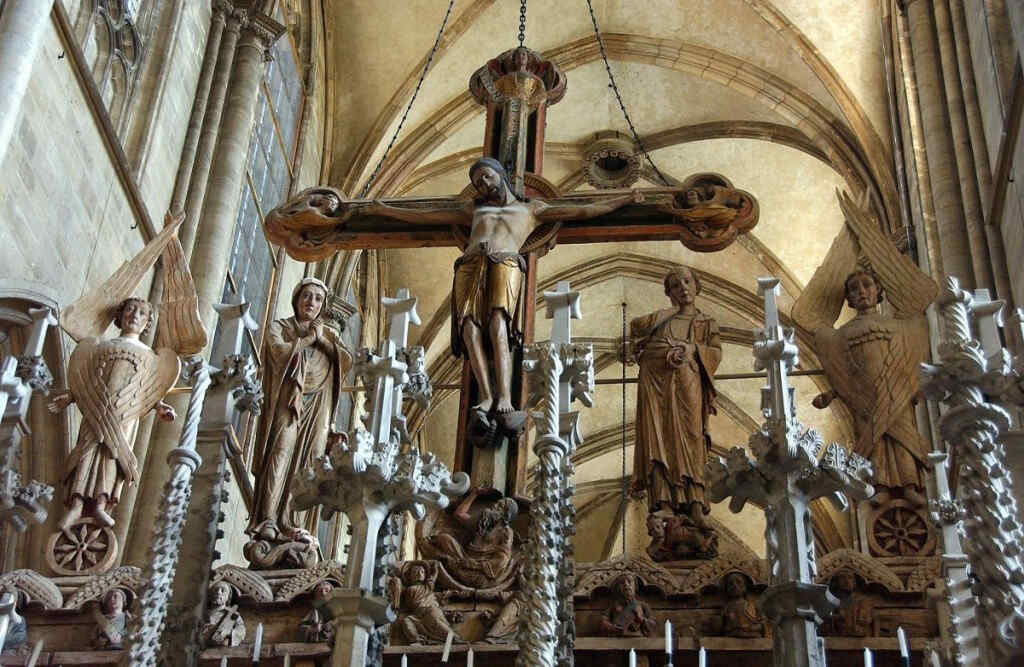 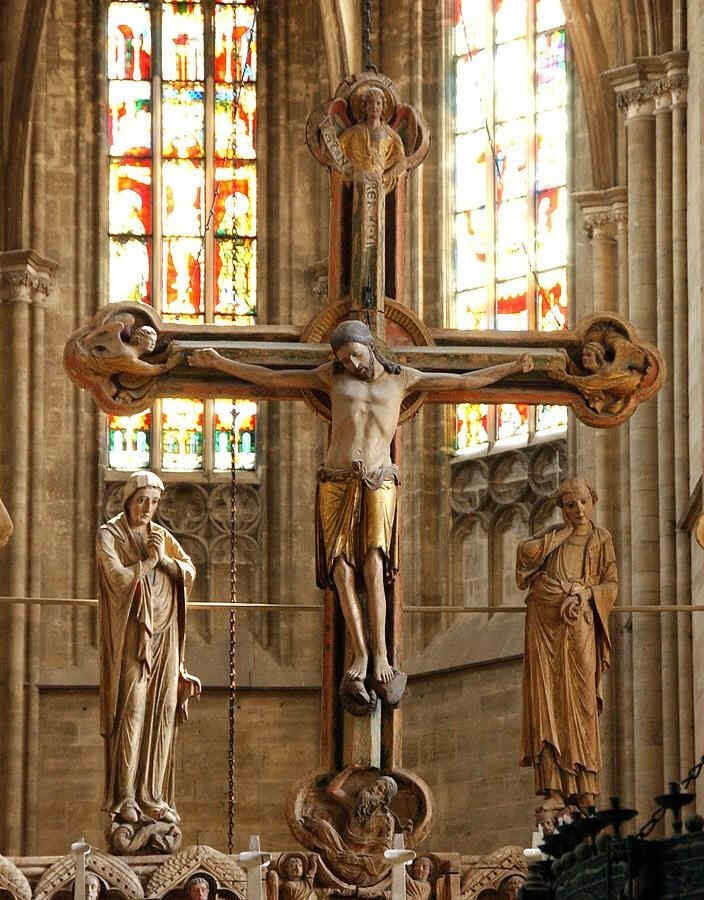 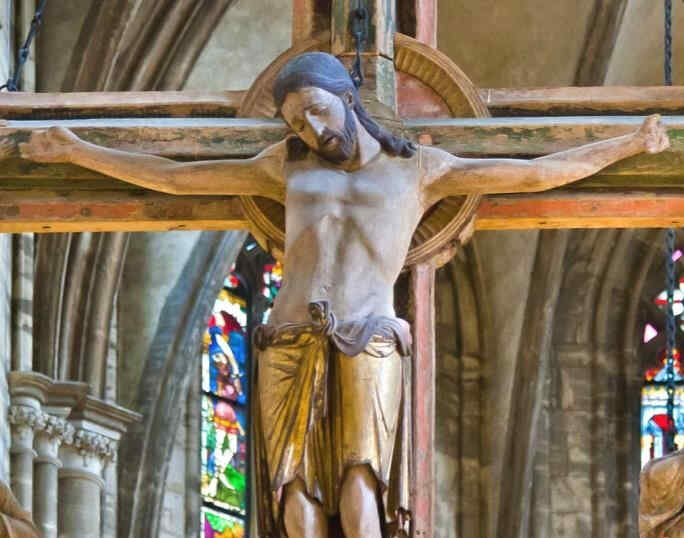 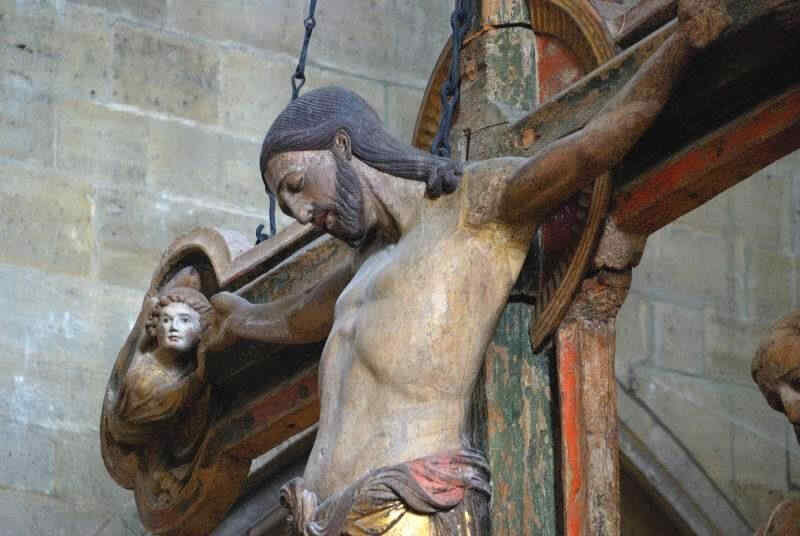 Look at this Crucifixion Group. I will only say one thing to characterise what is most important. In this group you can see how deeply the story of the Passion had found its way into their lives by that time. There is Mary, there is St. John, and in the center the Christ, looking down towards her. If you could see the face you would see an infinite deepening of soul in the expression, an overwhelming depth. In Mary, if you have a feeling for these things, you will recognise at once the flowing together of the more Roman, priestly conception with the Mid-European depth and tenderness of feeling. Here it is recognisable in a most wonderful way. We shall presently show the face of Mary in detail. This group reveals how they contrived, out of the specifically Mid-European creative impulse of the soul, to mould the Christianity which had conquered the Mid-European country. We will now show the detail. 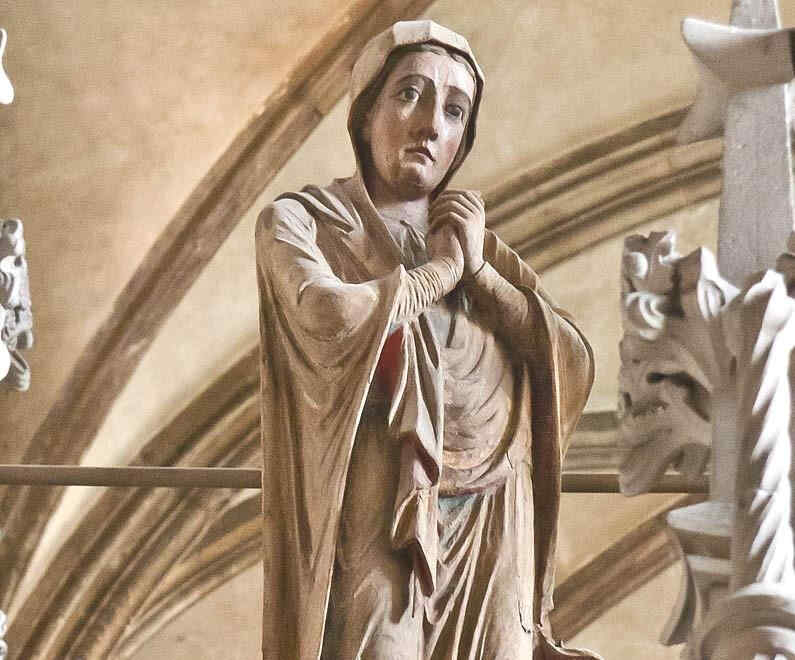 Wonderfully characteristic is the expression of the face. The expression in the Southern Art is such that the eyes look far out into the world; in the Northern Art the soul, as it were, presses forward into the look of the eyes from within. Here the two are altogether interwoven—united with one another. A tenderness of soul in the expressions hovers gently, wonderfully, over a more Latin, Roman rounding and perfection of the features. These things must not be pressed. But I beg of you to observe in all the following pictures how very differently the clothing and drapery is treated in the Mid-European Art and in the Southern. Undoubtedly, such things must not be pressed too far; yet it is true to say that in all the Southern Art the drapery rather surrounds and veils the human form, follows the lines of the form closely, continuing, as it were, the bodily forms. In the Mid-European Art the treatment of the drapery is different. It proceeds from the emotion and movement of the soul. According to the gesture of the hand and the whole attitude of the figure, the quick, mobile life of soul is continued into the raiment. The latter adheres less closely to the body. It does not seek, as in the Southern Art, to veil or to express the forms of the body. It is, rather, like a continuation of the living experience of the soul. You will see this more and more distinctly as we go on into the following centuries. We have now come to the famous: 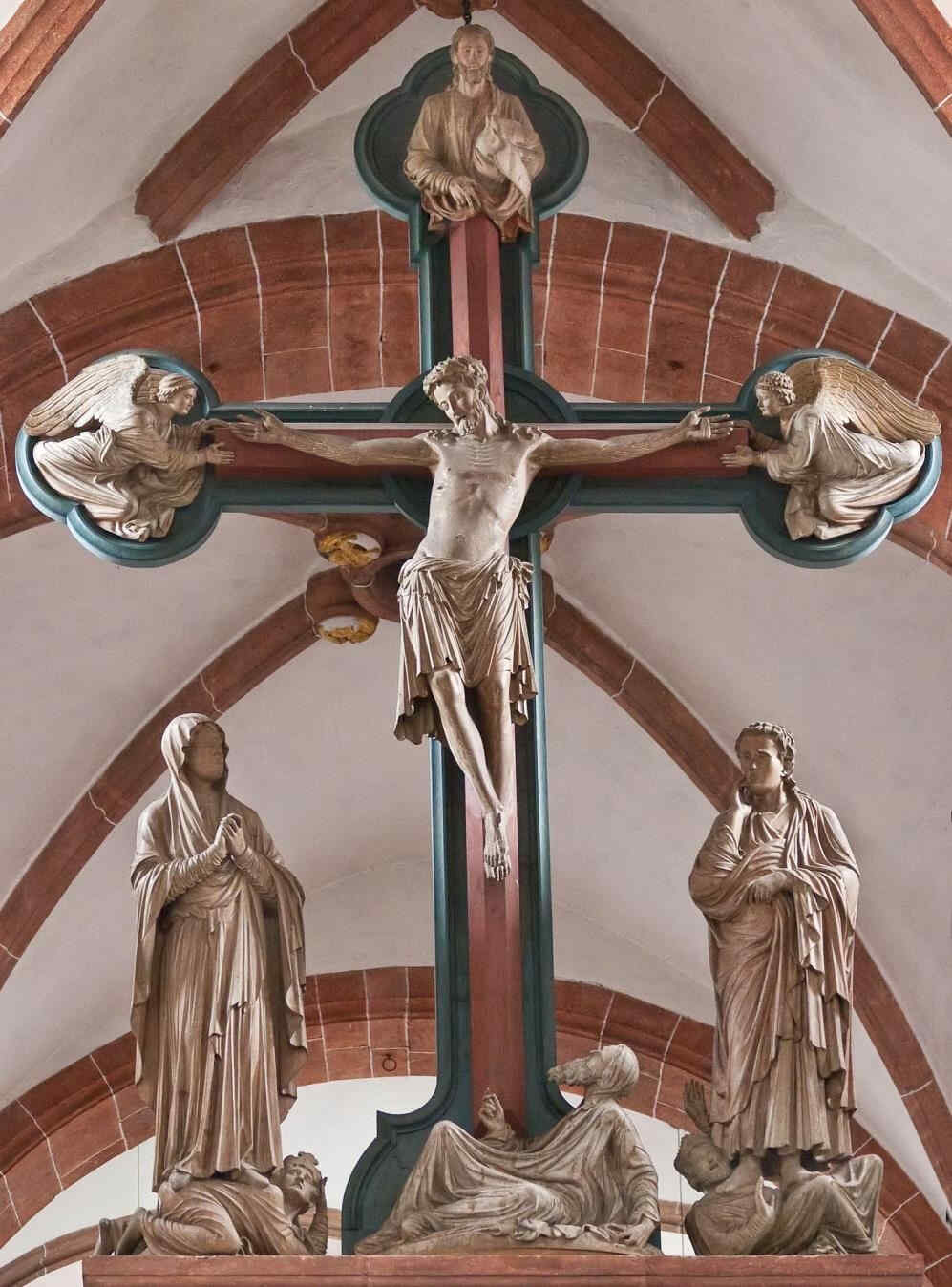 This, too, is in the wood, and dates from the first third of the 13th century. None the less, you will see in it a wonderful progression from the former group whose subject is so similar. Observe the communion of soul between the Mary and the Christ-Figure. See how the faith in the Christian world-conception, deeply united with the human soul, appears in the St. John and in the Mary-Figure, as the power that overcomes all things. The Christian world-conception had entered into the souls of these people so as to become an universal historic conception of all earthly evolution. See how Adam, down here, receives the Blood of the Redeemer dropping downward from the Cross. Study the face of Adam, how he is touched by the influence of Grace which he can now receive inasmuch as he may catch the Blood of the Redeemer flowing from the Cross. You will realise with what infinite depths Christianity had found its may into the lives of these people. It had risen to a universal and truly Cosmic conception. Angels carry the Cross. God the Father descends with the Dove, setting His seal upon the fact that what He had given to the Earth in His Son gives, at this moment, the whole Earth its meaning. In this group with all its artistic perfection we see how deeply Christianity had found its way into Middle Europe,because they tried again and again to permeate it with the human heart and feeling,—to permeate it from within the human soul. On the other hand, in the South, it was permeated by fancy and imagination, thus producing that peculiar permeation, so free from the moral element—(or shall we say, in order not to give offence, so free from moral cant)—which comes to expression in the Renaissance in the South. If you were to make a study of the progress in the representation of the Christ-Figure, this Head of Christ would be an important station. Also the Head of Christ in the Cathedral of Amiens, and afterwards, the Head of Christ by Albrecht Dürer. 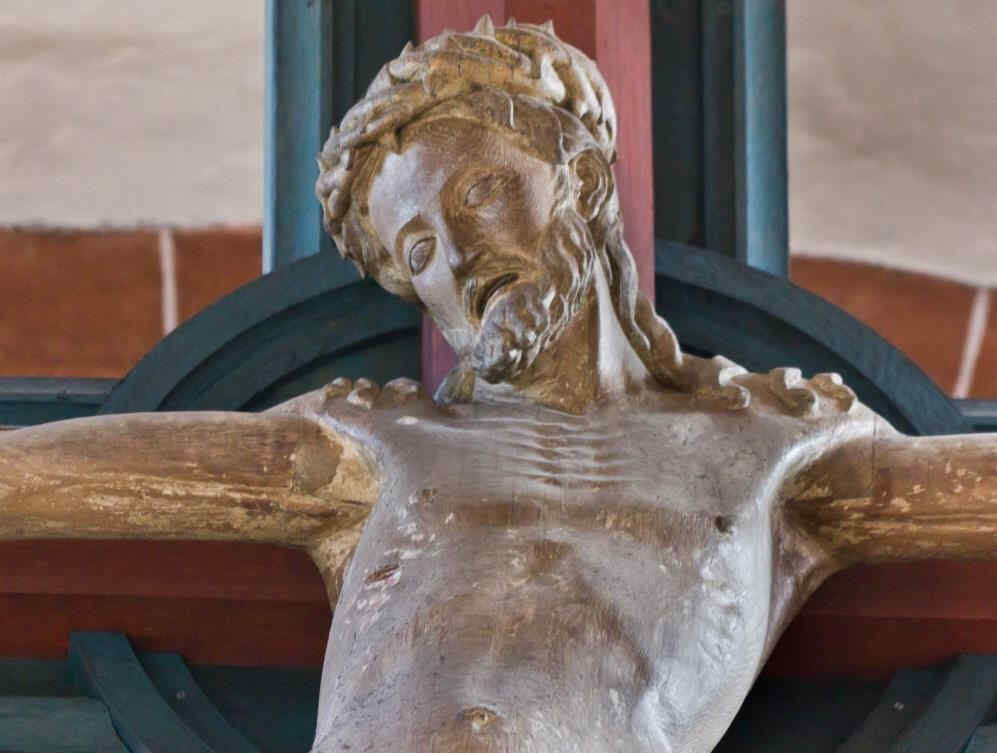 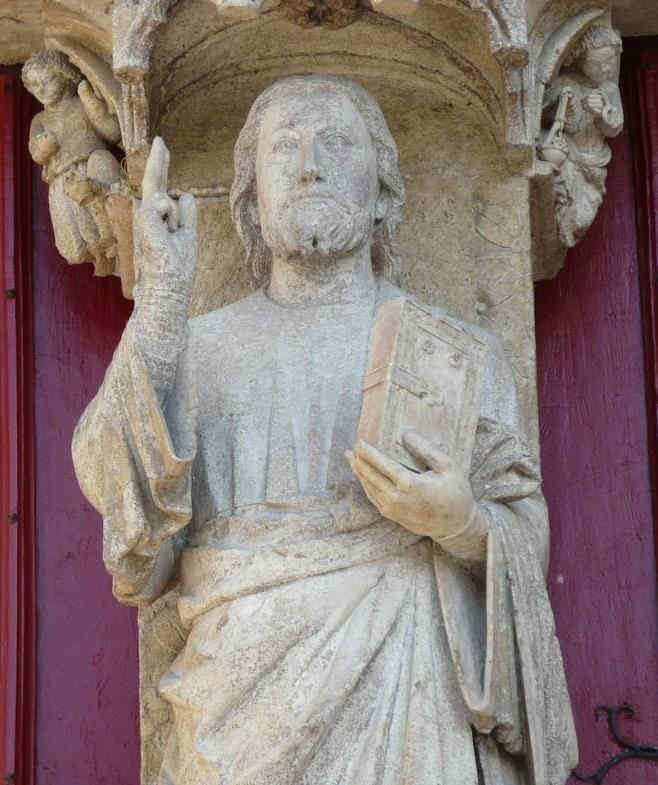 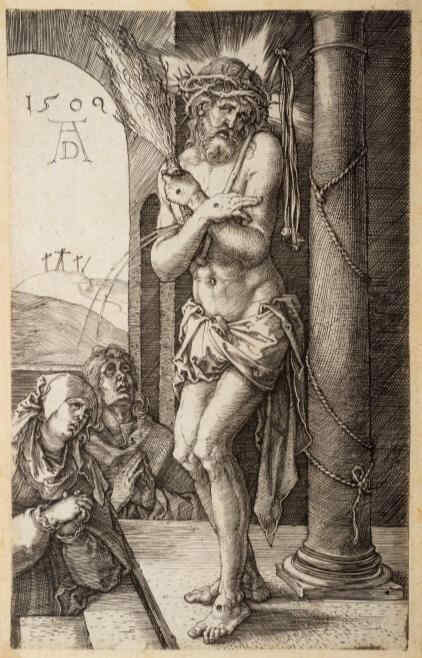 We now pass to some sculptures which are found at Freiburg in Saxony, also dating from the first third of the 13th century. They show an altogether different aspect, though here, too, it is the sacred history, and a deep striving for inwardness. It is not too much to say that one loves to dwell on every single face. The next picture: 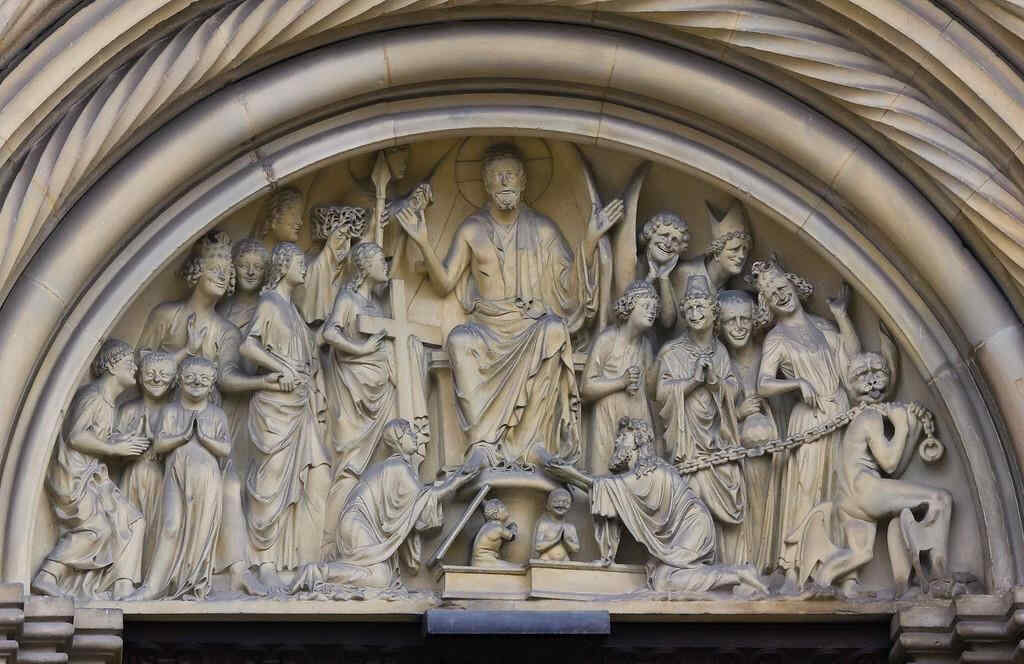 (St. Mary's Cathedral, Freiburg.) shows us two figures. The one, the figure of a woman, is hard to interpret. Perhaps she is an “Ecclesia.” The other is said to be Aaron. These things are not essential. The figures are undoubtedly connected, allegorically or in some other way, with the Christian world-conception. Once more, observe the deepening of the soul's life. The contrast of expression between the face on the left, and that on the right is particularly fascinating from this point of view. 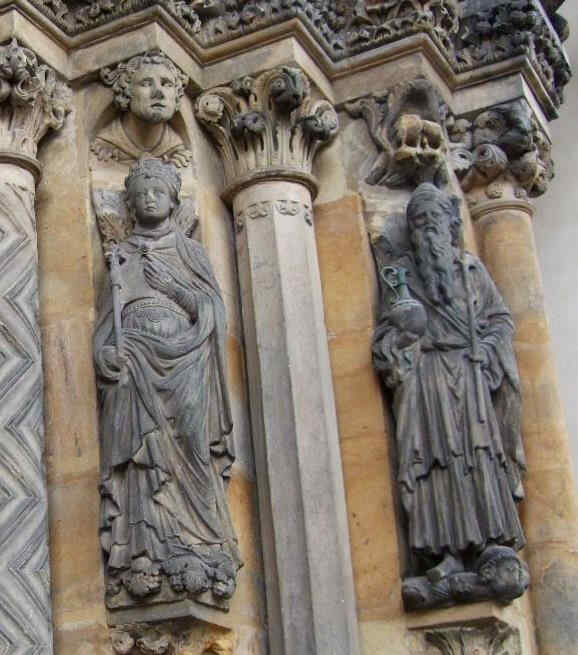 Supplementing what we showed last time of the Cathedrals at Naumburg and Strasburg, we will now show some sculptures from the Cathedral at Bamberg. Here, to begin with, we have two. 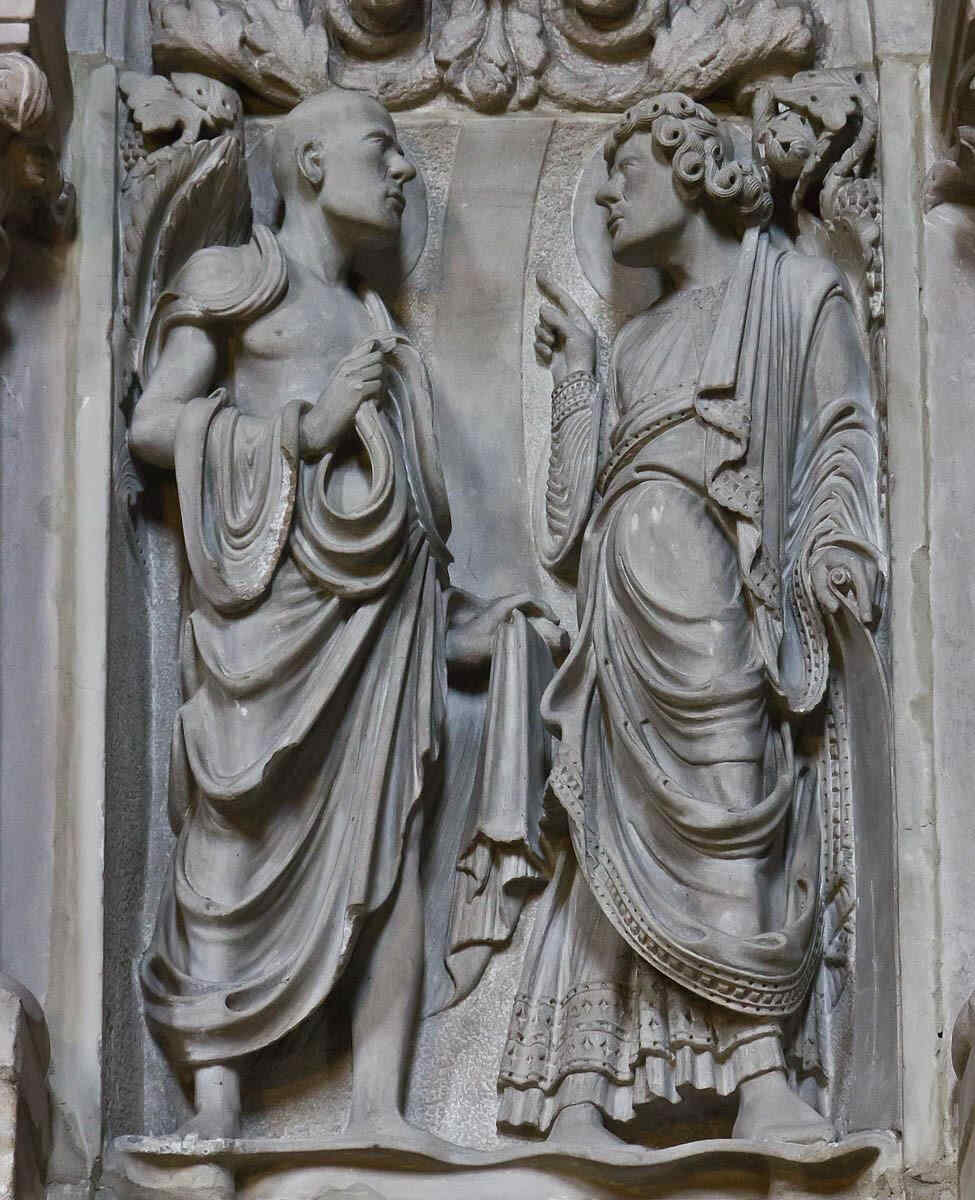 See how directly the dramatic element, the living movement of soul, is expressed in the attitudes, representing the interchange between one soul and another. C. single moment is presented to us, while at the same time the two contrasting characters are well expressed.  The composition is by no means great, but the expressiveness of soul is marvellous. He must remember that this dates from about 1240. Spiritual scientific research will in course of time be confirmed, in that it does not suggest—as many people still do today—that the Mid-European element, in its presentation of the Christian world-conception, was in any high degree influenced by the Southern. That, indeed, is not the case. On the contrary, the very opposite is true. The different streams are not as yet clearly seen by external history. It is not seen, for instance, what I pointed out the other day—how the Northern impulses worked down even into the creations of Raphael and Michelangelo. Artistically, this conception is altogether a product of the Northern spirit. 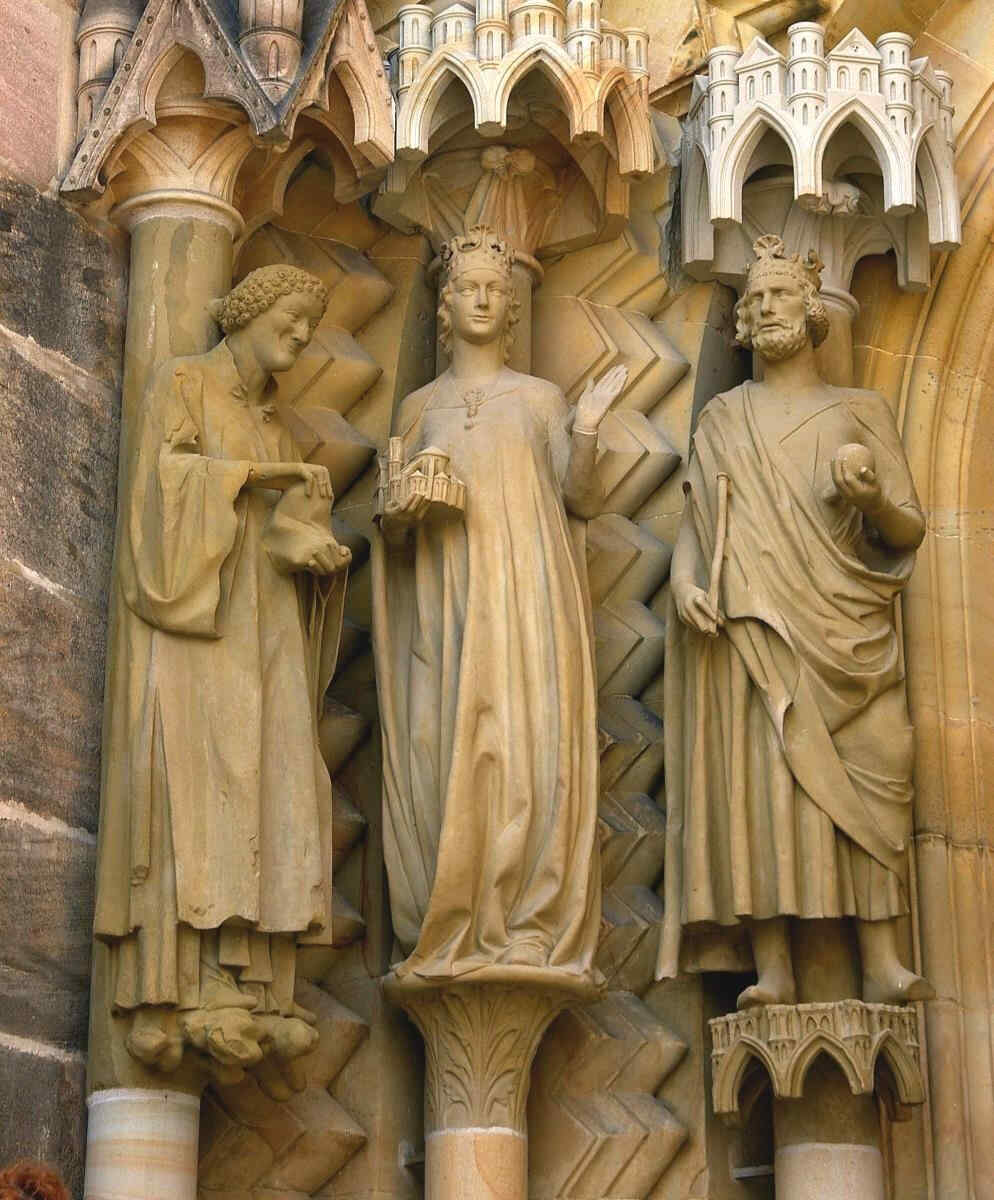 This example shows how the worldly and the religious elements played into one another. This was, indeed, the case, especially at the time with which we are now dealing. The worldly and the religious were brought together in the effort which I characterised just now. The souls of men had to be won over; the individual souls must first be called—must by some means be gathered together, if they are to look up in community, in congregation, to the spiritual world. Likewise, they must first be called if they are to express reverence in one way or another, for something in the outer worldly sphere. Hence the worldly is brought together with the ecclesiastical element. Here, then, we see the Emperor Heinrich, the Empress Kunigunde, and, on the left, St. Stephen. Needless to say, these things presuppose, as a rule, the naivete of the common people, their blind devotion and dependence. Today, in the fond belief of our contemporaries, these things are overcome. Inwardly, they are present all the more. On the part of the great lords themselves there is very frequently the underlying idea (not unconnected with very human qualities, which shall be nameless), that they themselves stand just a little nearer to the various Saints and supersensible powers than ordinary mortals do. 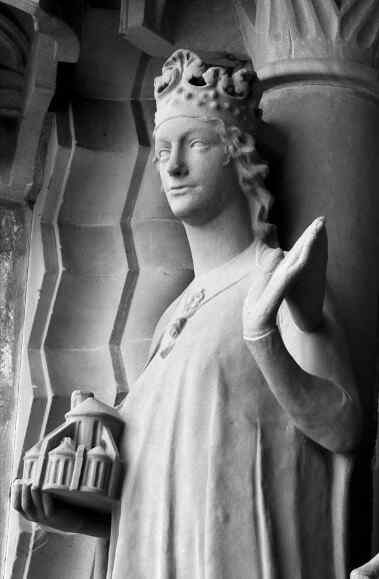 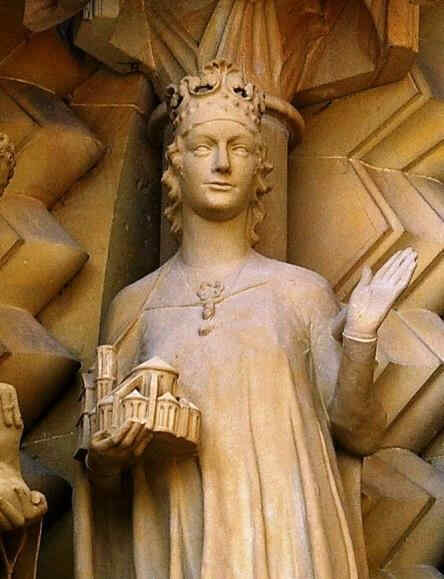 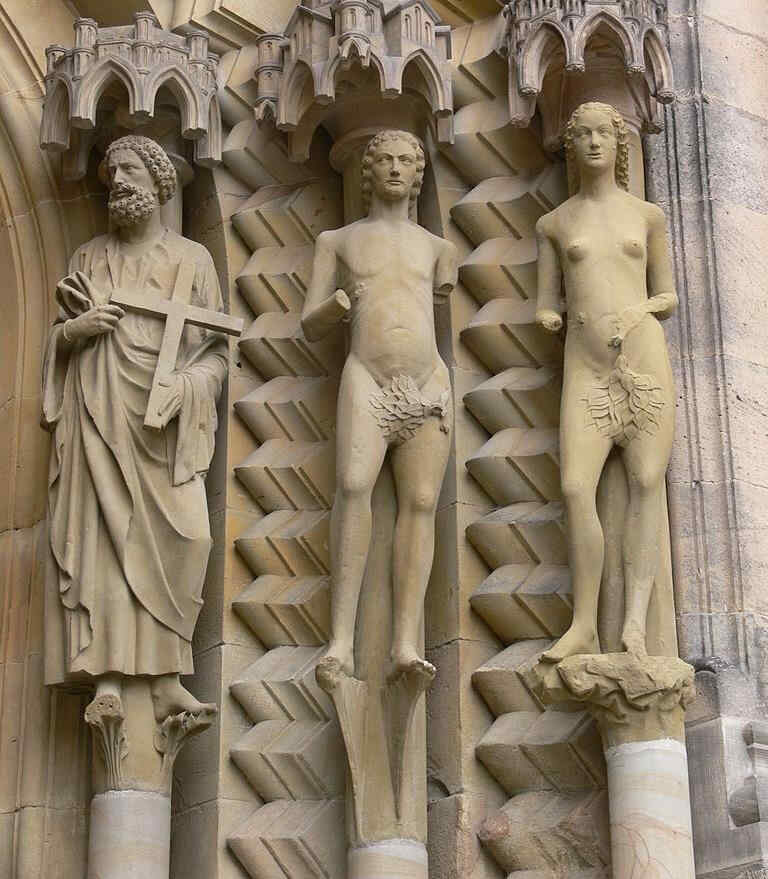 The Old and the New Testament were always conceived in unison, as the promise and the fulfilment. Follow the detail of these figures. 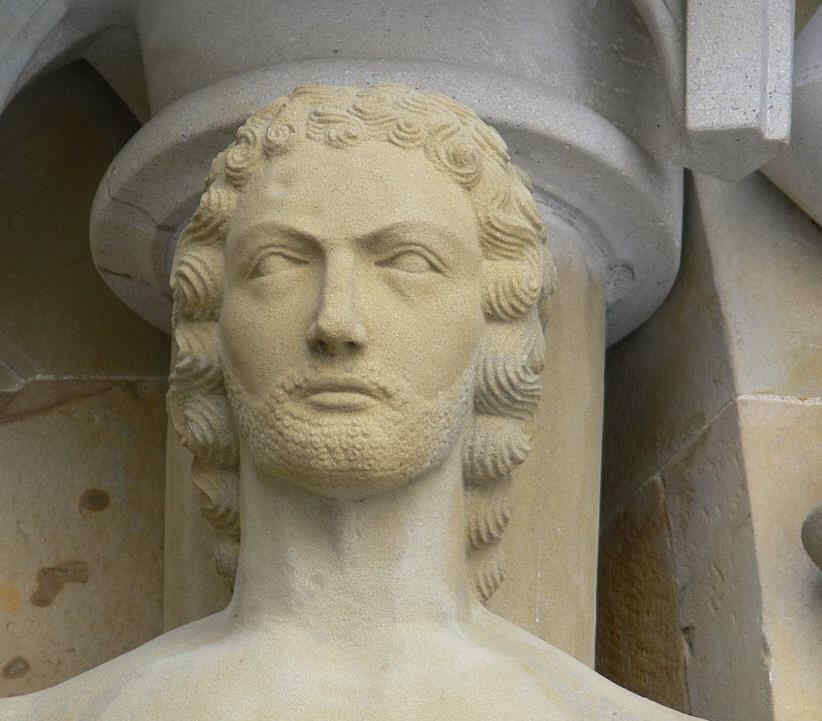 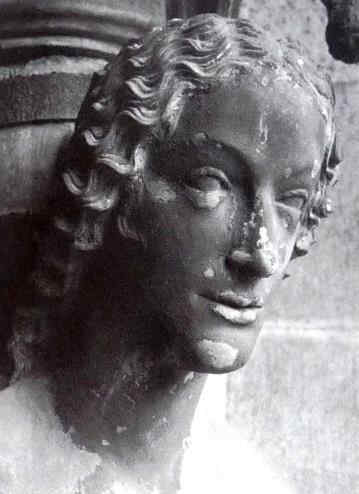 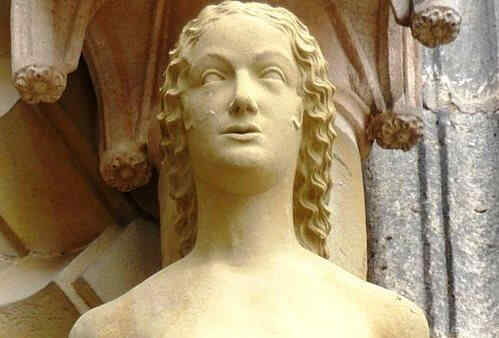 And now another figure from the same Cathedral. 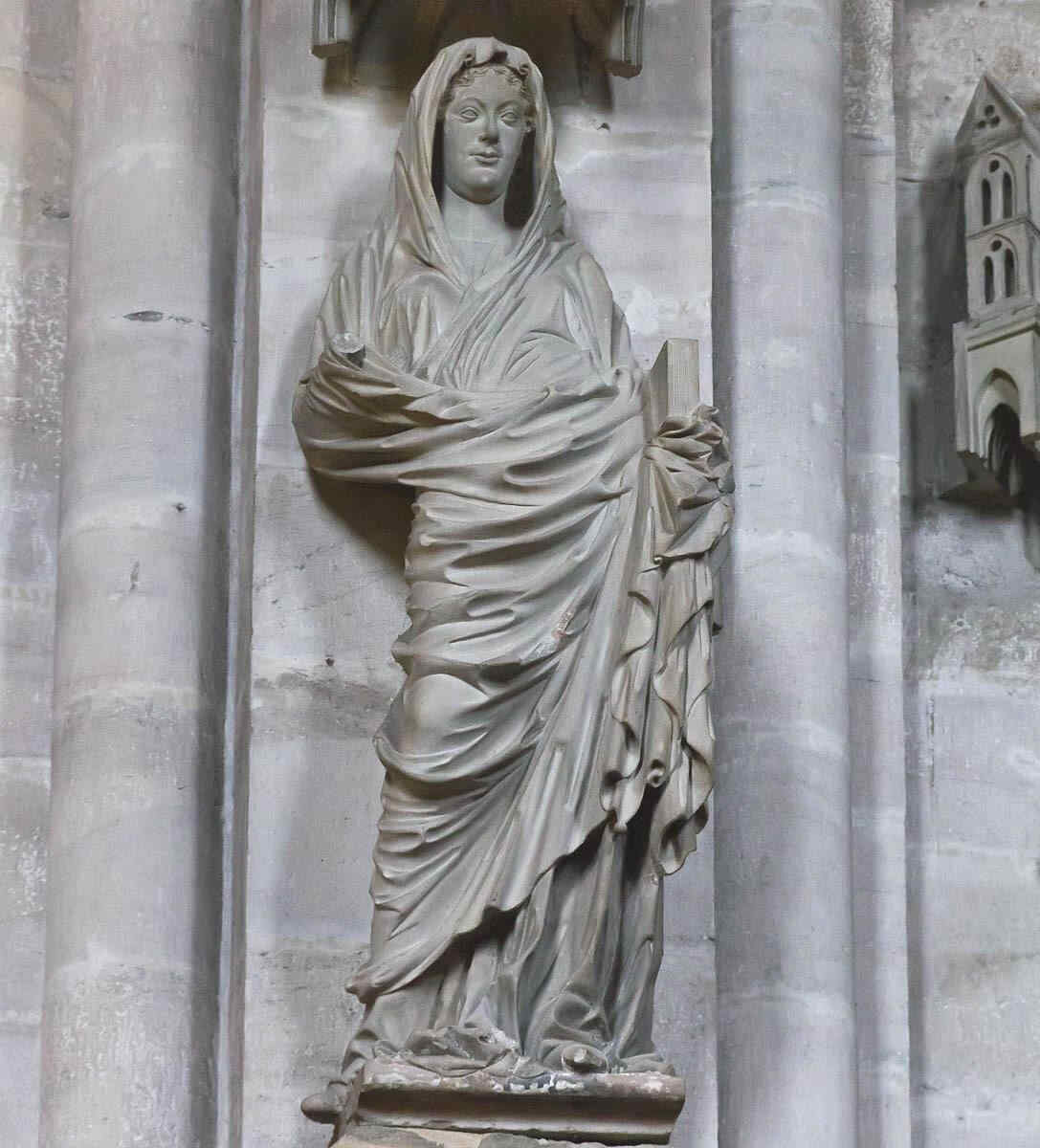 A figure of Mary, showing—from whatever point of view you may consider it—how richly the qualities which I described before, come to expression in this stream of Art. You must remember that this was done about the year 1245. What would you look for in the South at that time? The next Picture, from the Cathedral at Bamberg again, represents the figure of: 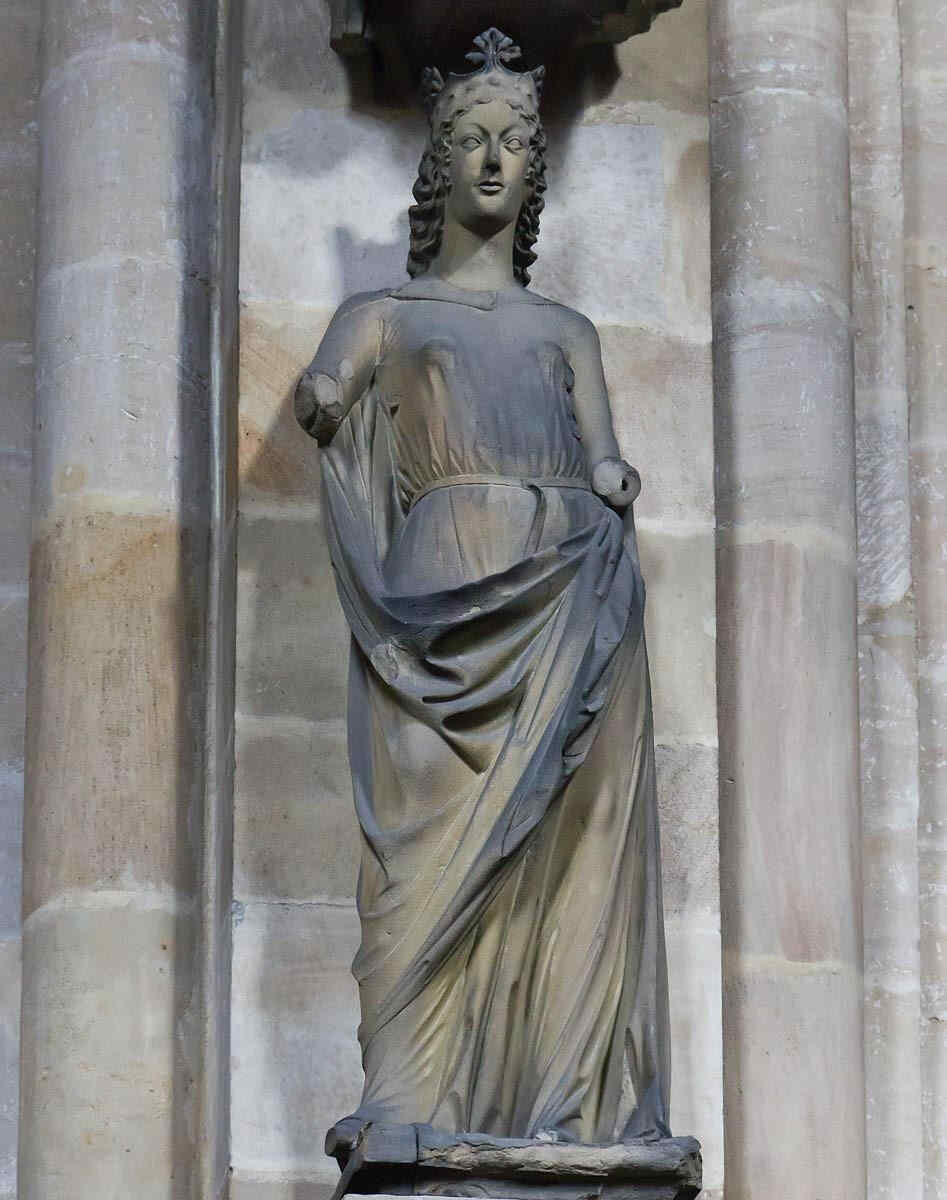 A favorite representation at that time. Last time we saw the corresponding figure from the Cathedral at Strasburg. The figure of the Church is conceived with a certain inner freedom. Her soul is free, she gazes freely far into the world, with wisdom. 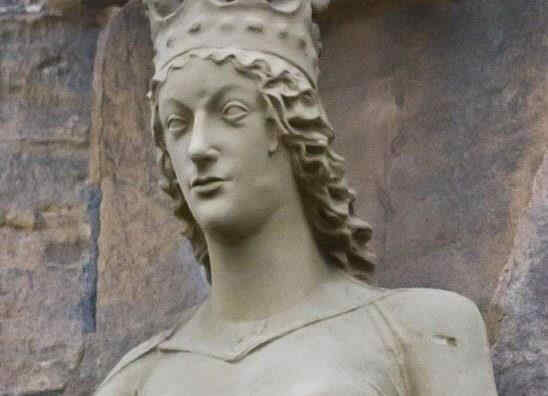 This figure is in contrast, as we saw last time, with the Synagogue, who is represented once more with bound and downcast eyes. The whole posture is intended to represent this contrast in every detail, even to the sweep of the drapery. 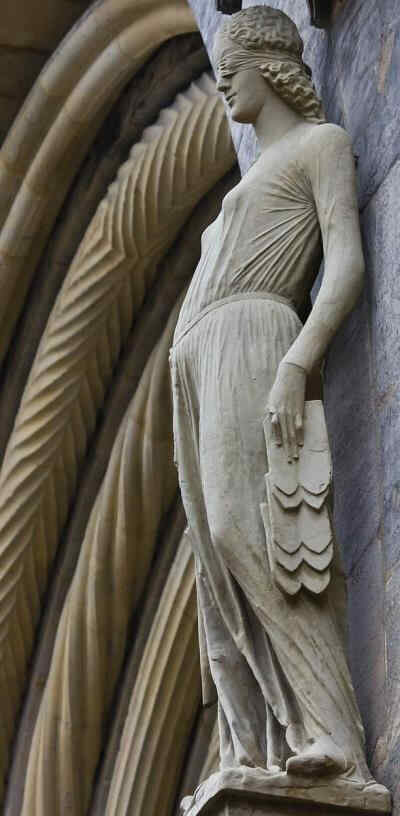 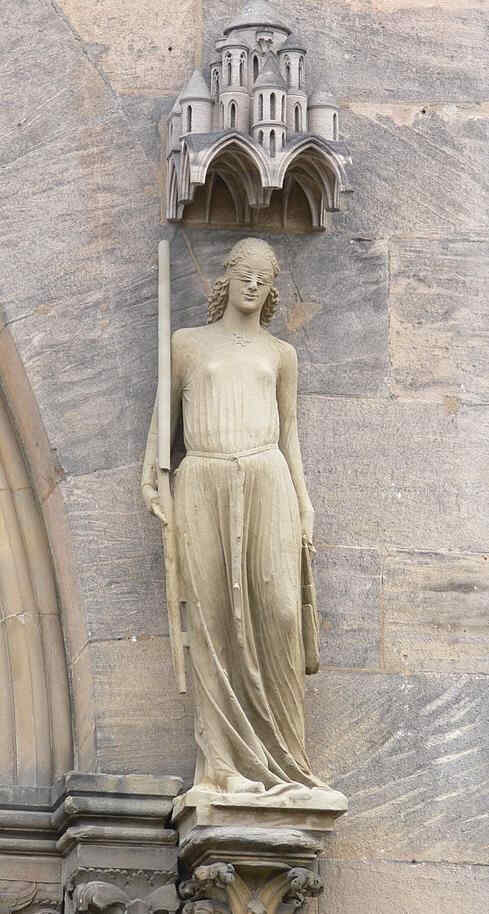 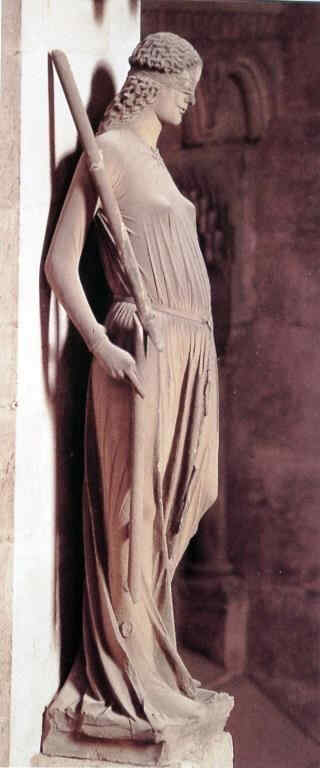 Look at the lower portion of the dress, how well it is adapted to the movement of the soul. We will insert the 'Church' once more, in order that you may compare the draperies: 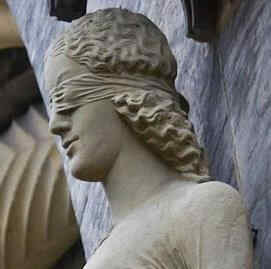 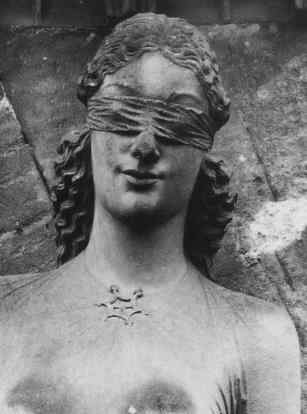 And now a worldly, or secular figure from the same Cathedral.  Study the expression well. The head, which we will now show in detail, is most wonderful: 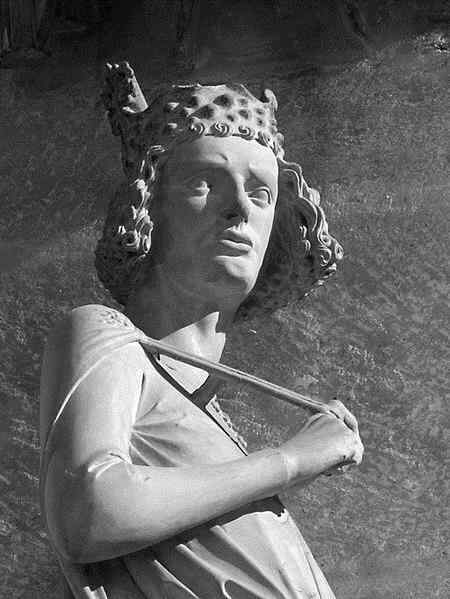 We now pass on to the 14th century, and see what had occurred by that time. We have a few figures from the Cathedral at Cologne, first half of the 14th century. 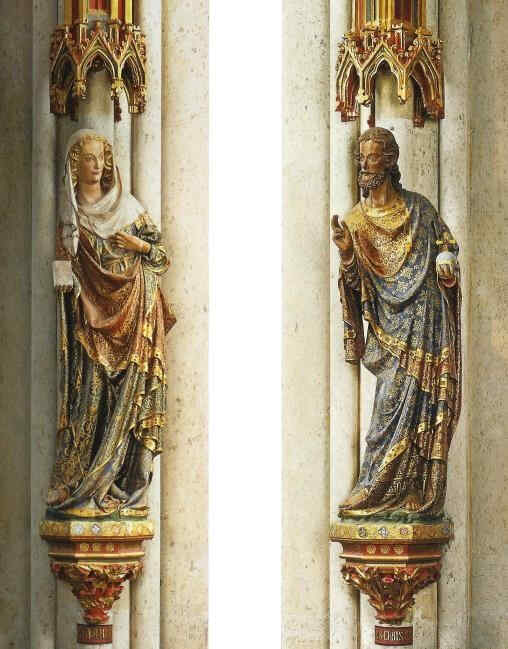 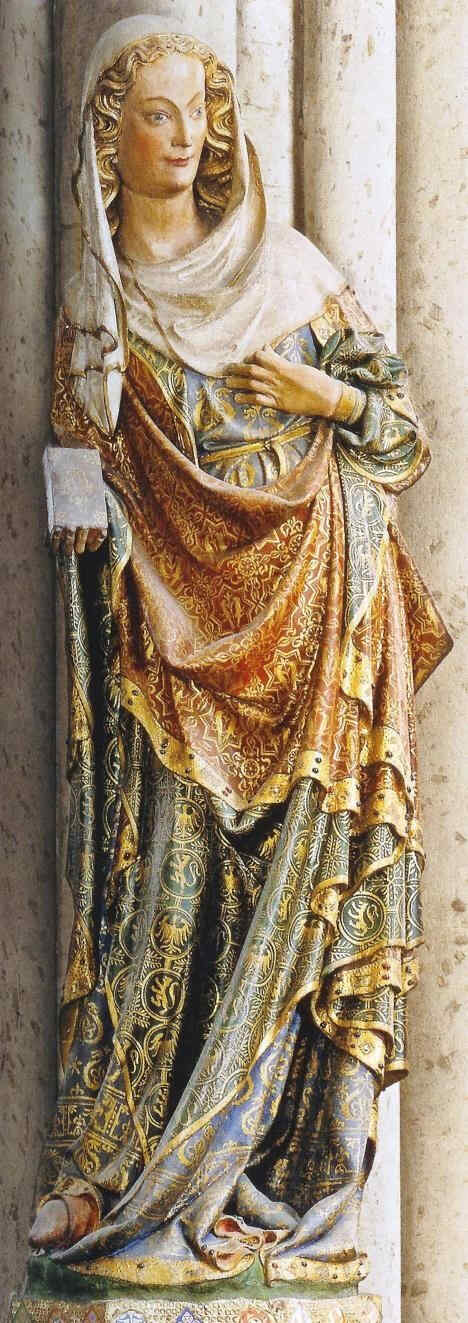 It is easy to see that a certain decline had taken place. The next picture is also from Cologne: 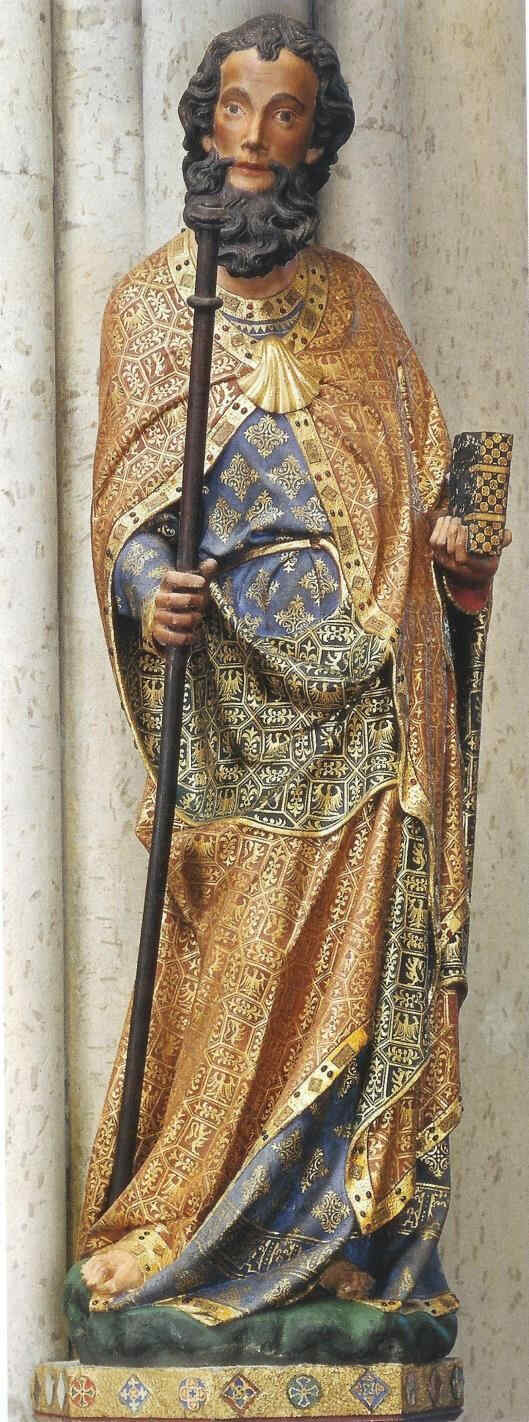  Going further in the 14th century we now come to a figure of St. Paul by a master known as the “Master of the Clay Figures.” These figures were executed in burnt earthenware.  Having now shown the rise, and to some extent the decline of a stream of evolution complete in itself, we will give a series of pictures from the Chartreuse de Champmol at Dijon, which are really great of their kind. Most, if not all of them are the independent work of the Dutch sculptor, Sluter, or else done under his direction. He brought to the Chartreuse at Dijon, from the Netherlands, an almost unique power of individual characterisation. From many points of view we see this individualising tendency in his work. 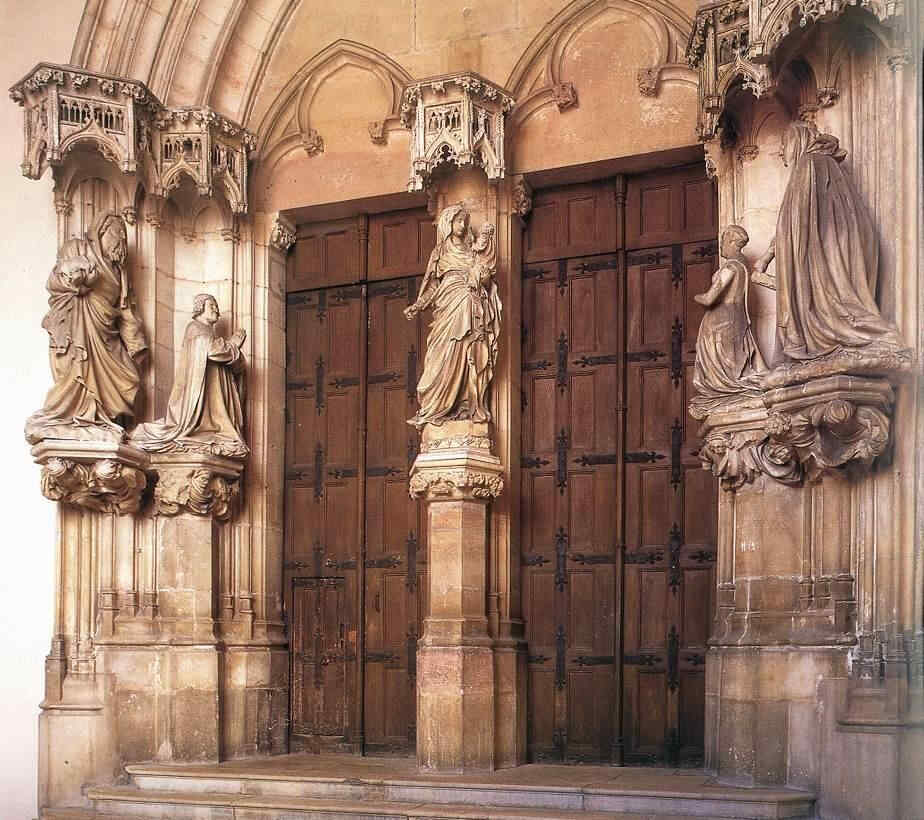 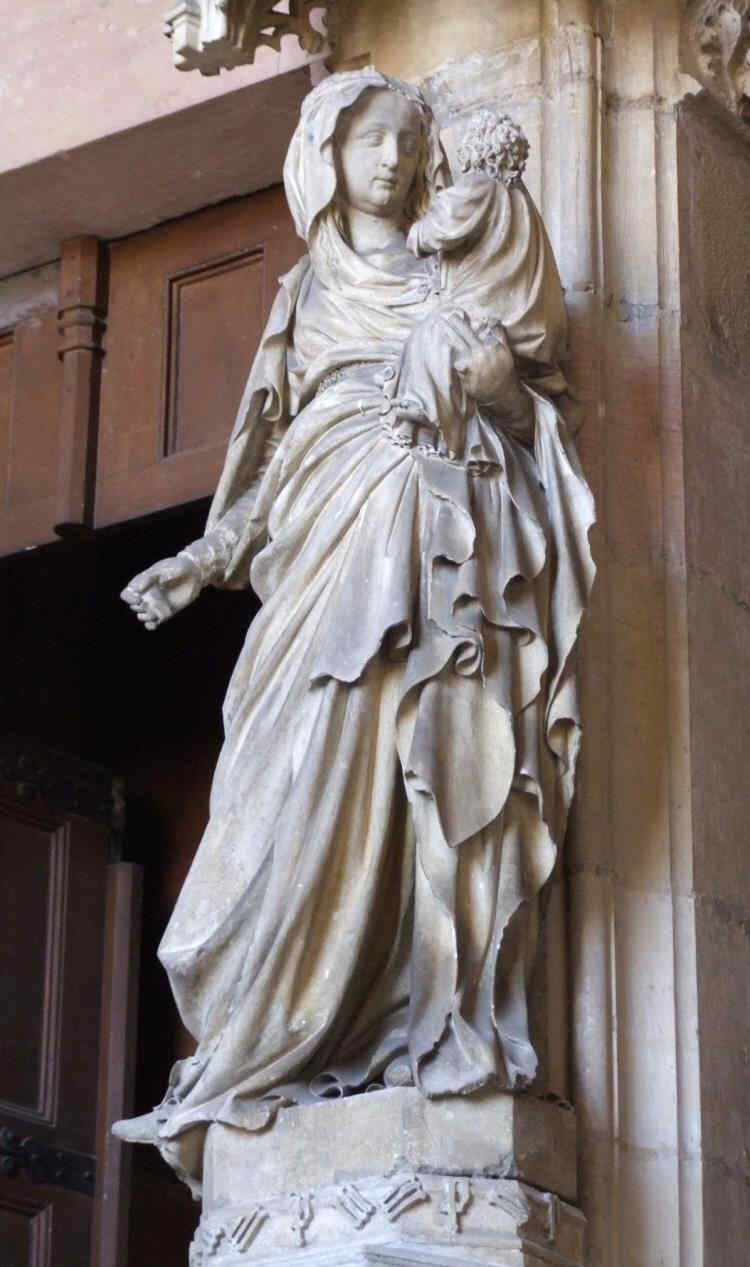 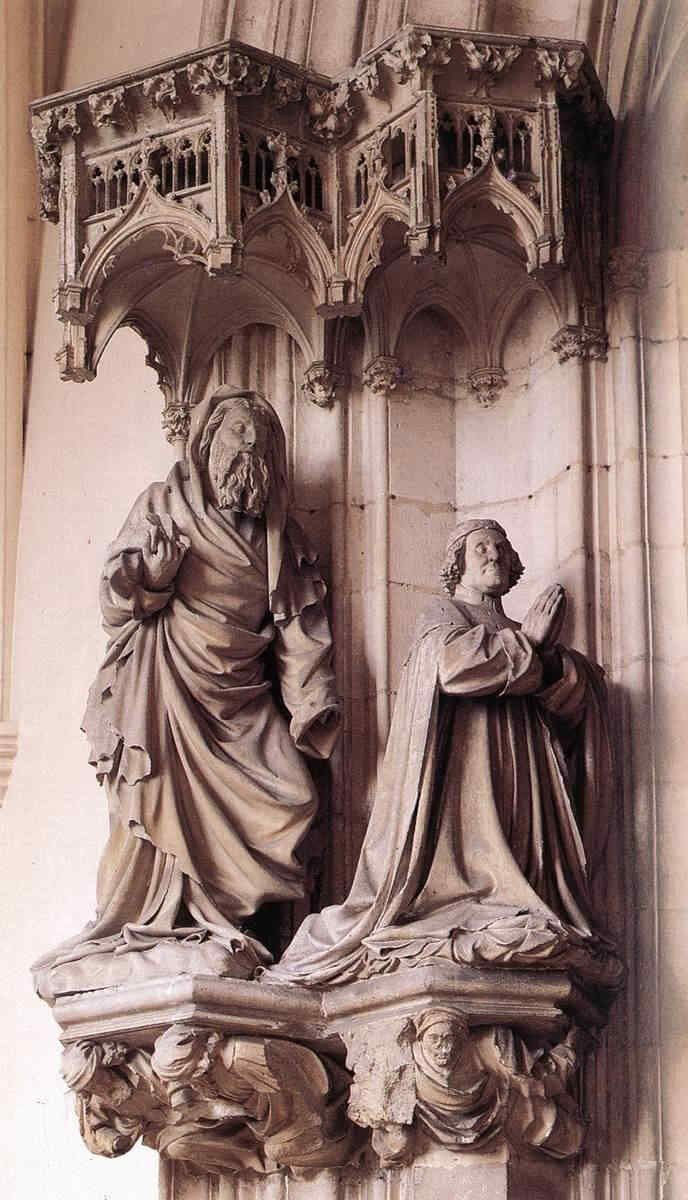 Here especially you see the Art of individual characterisation. Compare this Madonna and Child of Sluter's with the next picture (Moses) and realise the power of one and the same man to characterise these two. 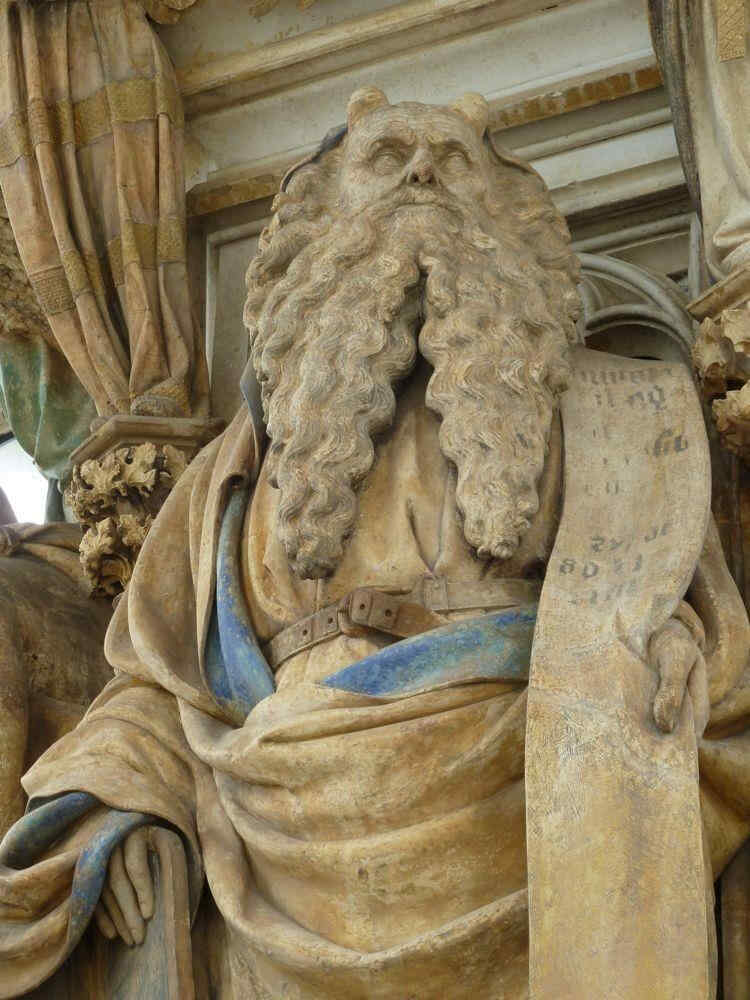 Remember that this Chartreuse at Dijon was built in 1306 to 1334; it was therefore the beginning of the 14th century. Compare this with Michelangelo's Moses—for why should these things not be placed together—they are, indeed, comparable. 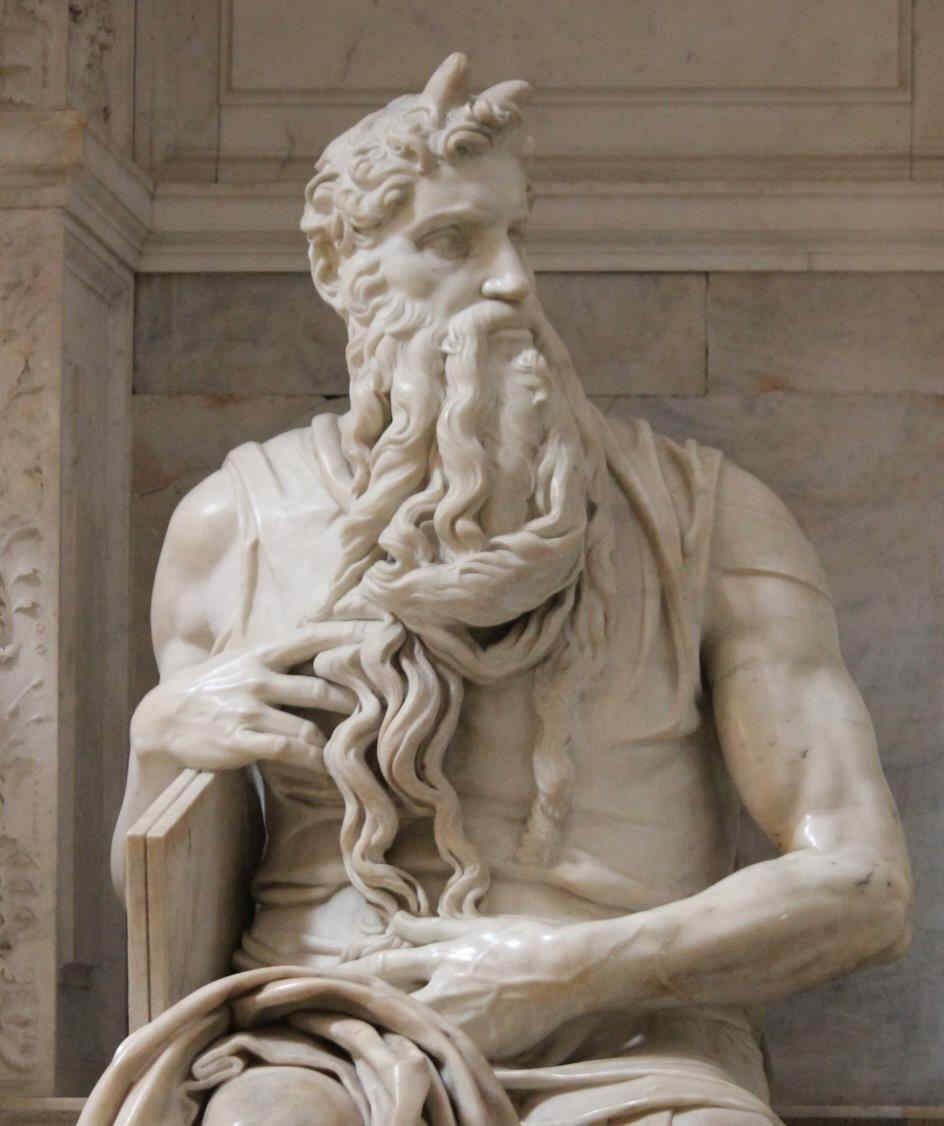 And now by the same artist as before—Sluter. 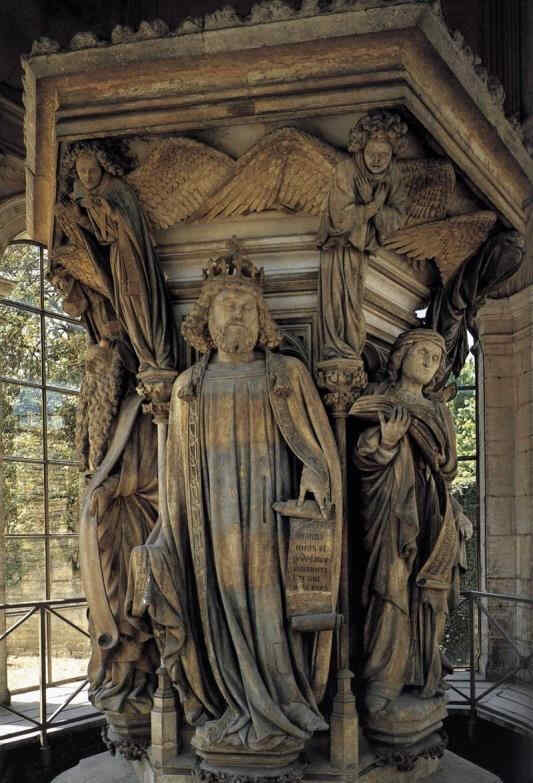 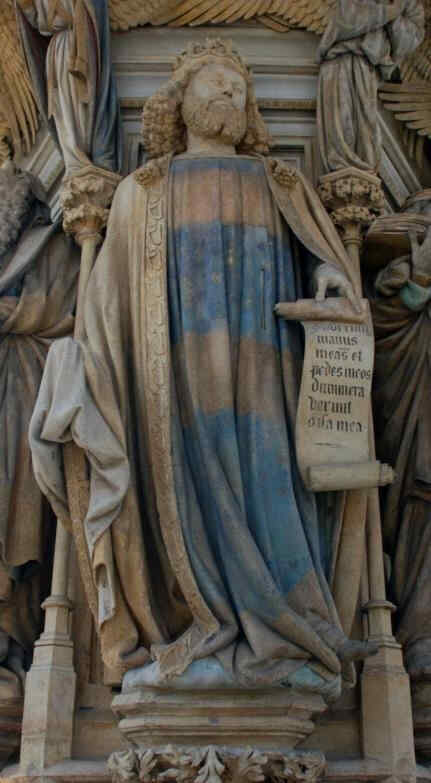 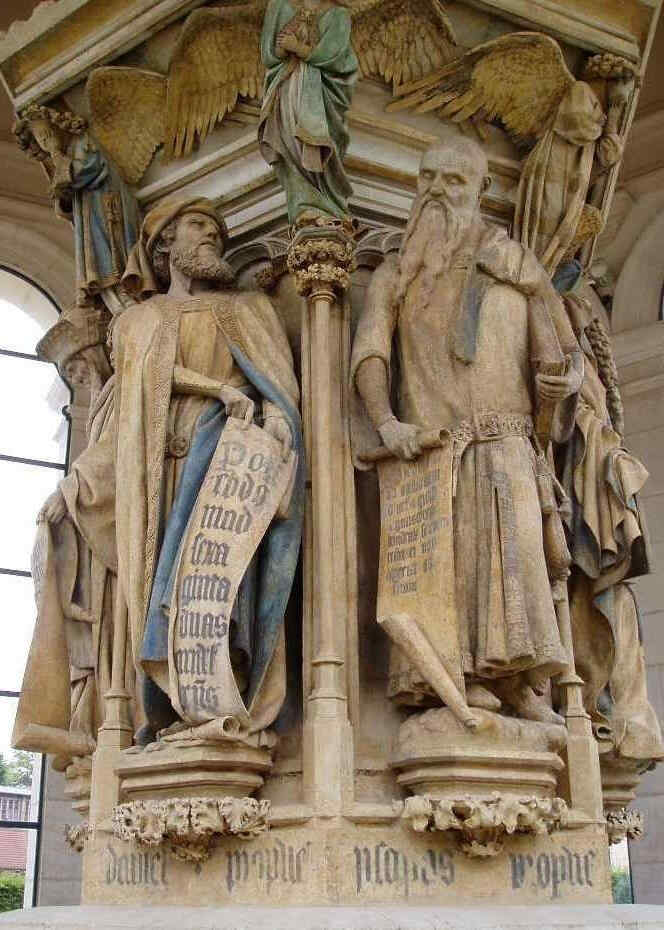 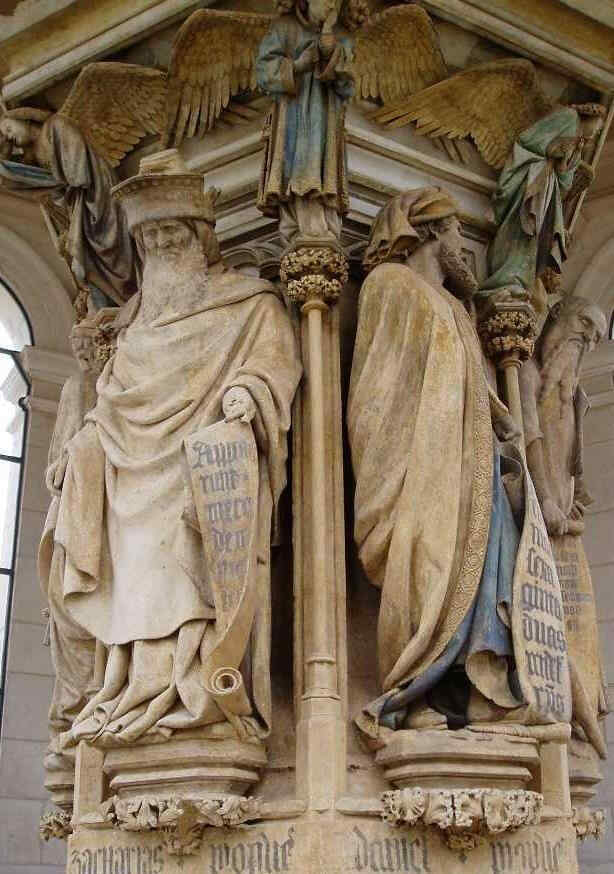 To live with the prophetic figures so as to achieve this degree of individualisation, was, indeed, most wonderful. We will now show one of the figures in detail: 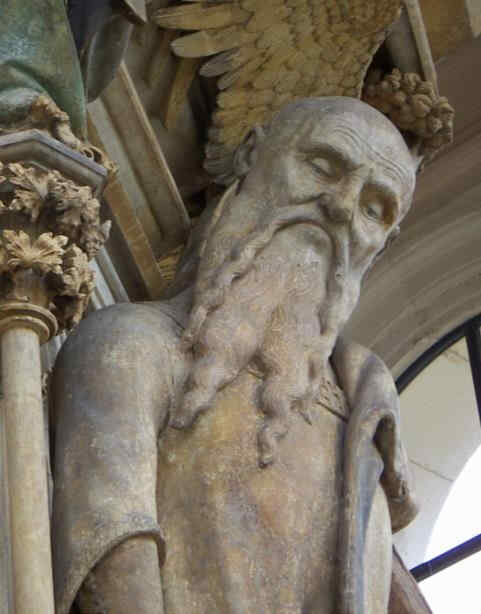  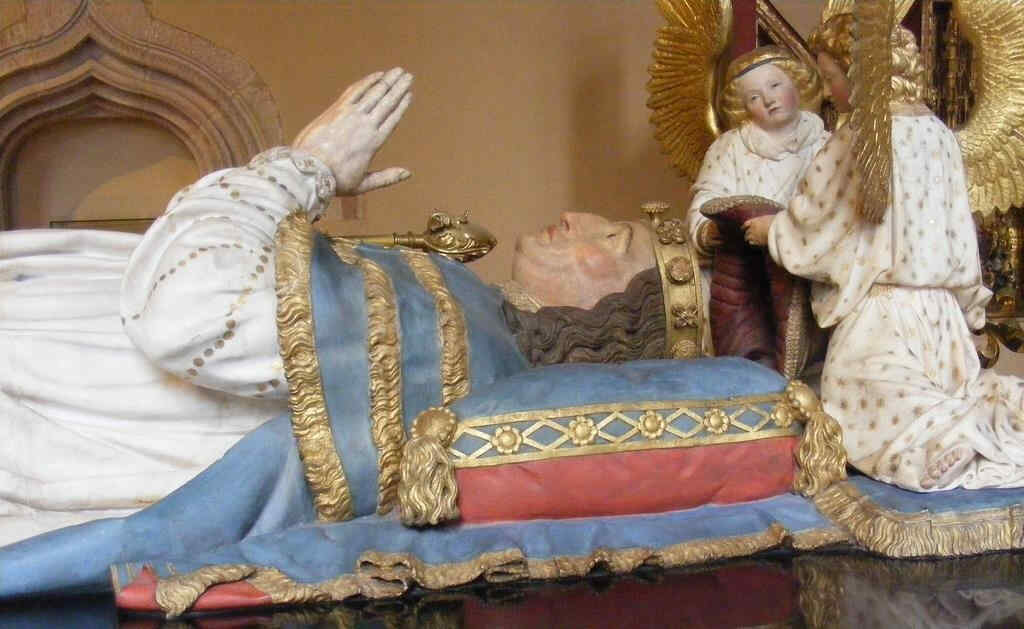 These are by the same artist. The age was especially great in the creation of tomb monuments. We will show the detail of the upper part: 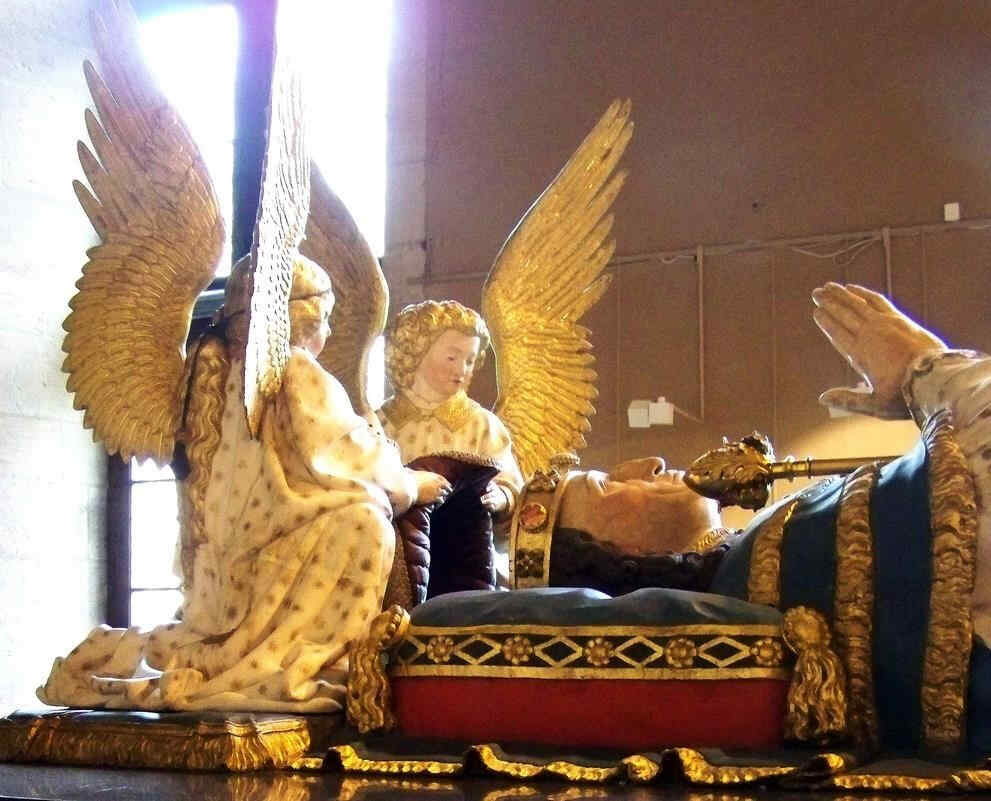 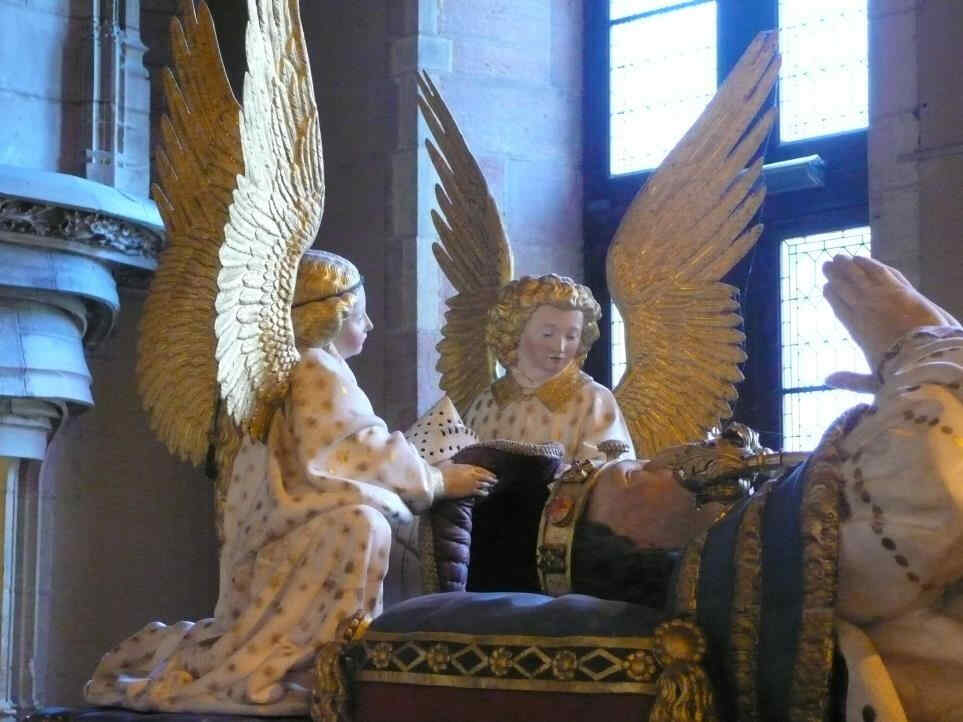 The figures round the base of the tomb which were formerly so small, are wonderfully executed when you come to see them in detail. 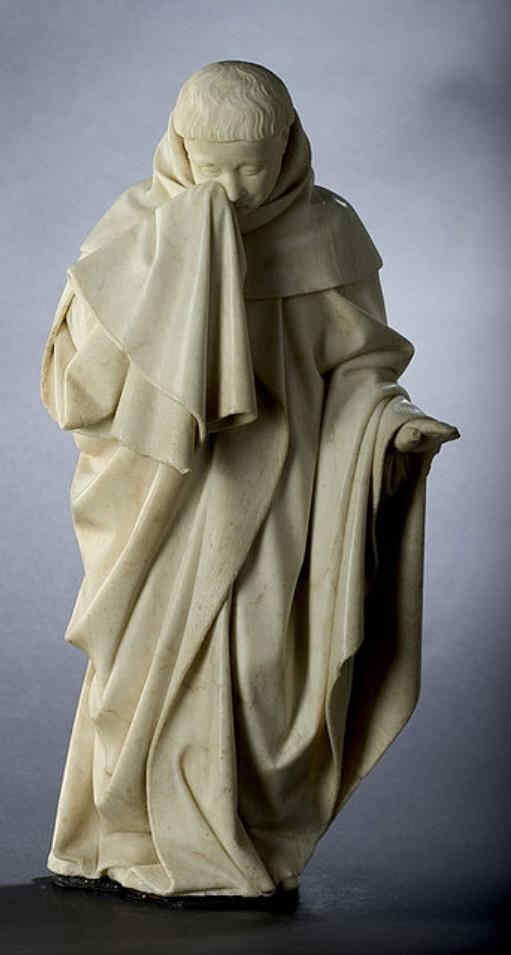 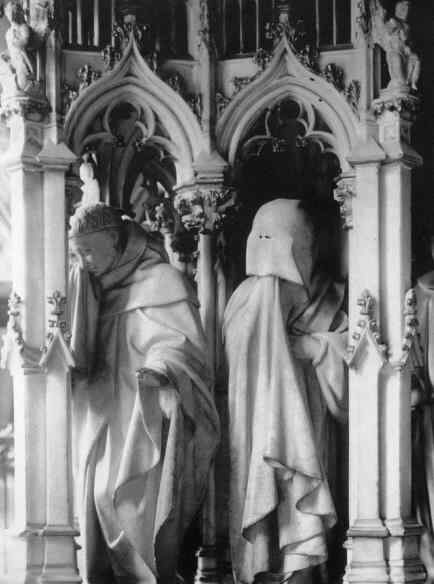 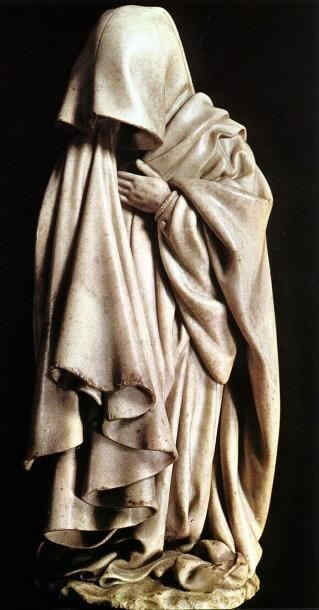 Such is the individual characterisation of all the single figures round the base of the tomb. Here is another group. 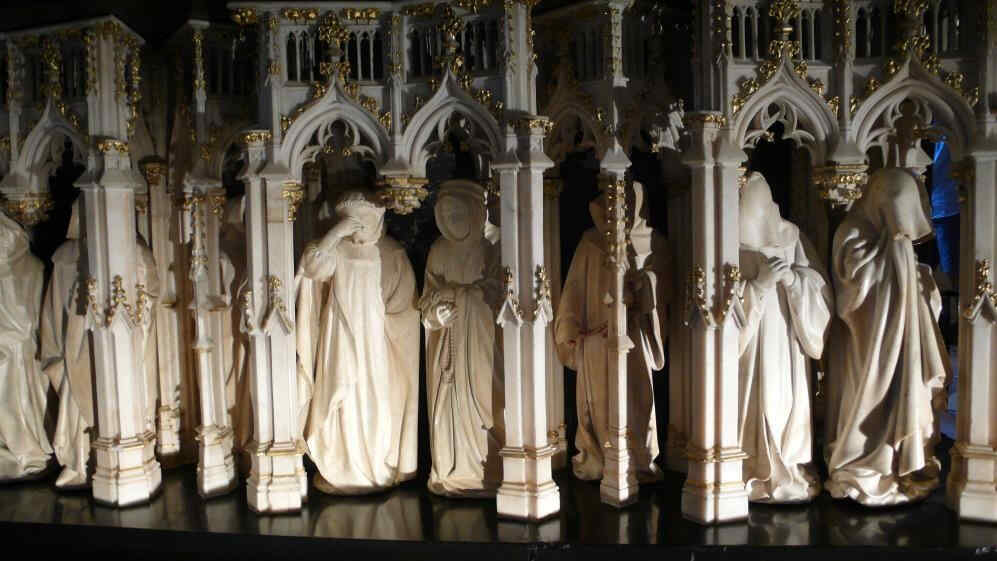 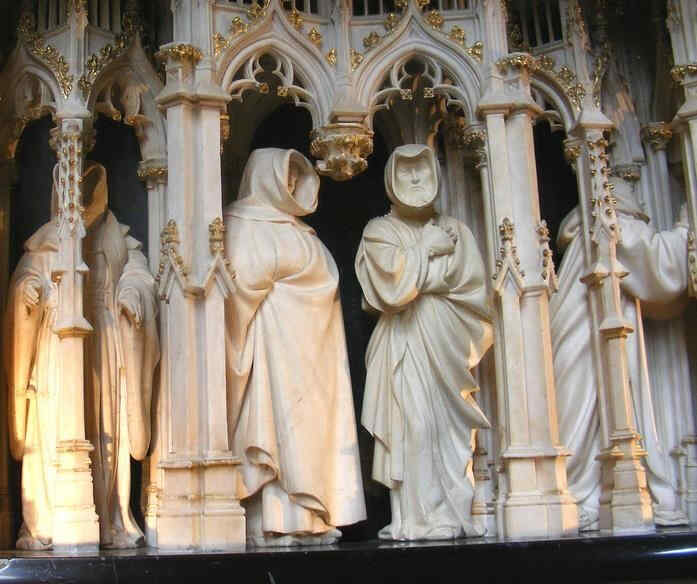 We now go on to an artist of the 15th century. (We must go according to the pictures we possess at the moment.) The last pictures, you remember, were by an artist of the early 14th century. With the Cologne Master, and the Master of the Clay Figures who made the group we saw before, we came to the 14th century. We now pass on into the 15th. Here, then, we have two figures by Hans Multscher:  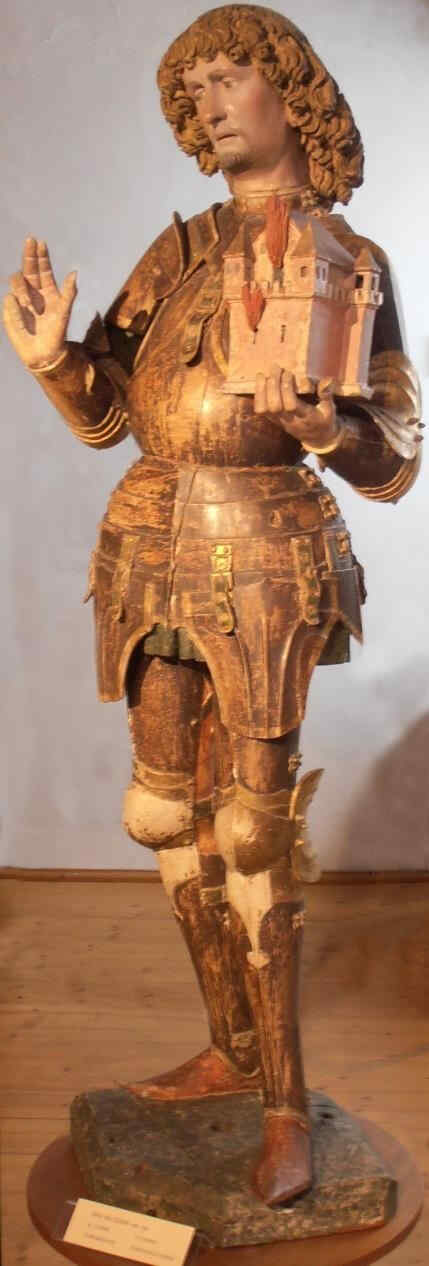 This is about the middle of the 15th century. The next is a Madonna, by the same artist (Multscher).  And now we go further and further in what I described just now as the elaboration of the Christian subjects with deep inwardness of soul. The following are figures carved in wood, at Blutenburg (end of the 15th century). The art of characterisation has, indeed, attained its ideal to a marvellous extent. The figure of Mary, carved in wood—end of the 13th century: 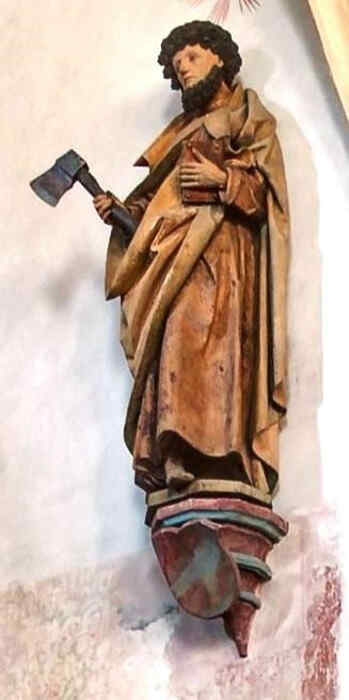  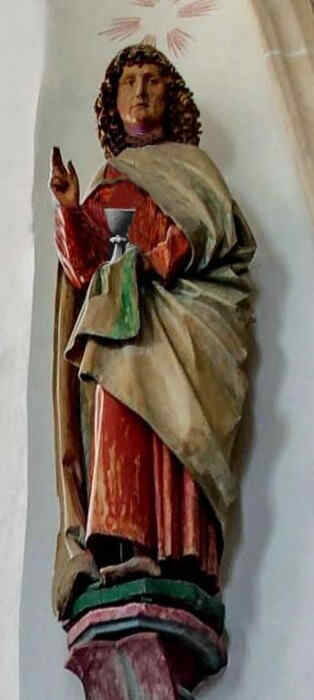 This, then, is the time when Michelangelo and Raphael were born. The next picture, too, is from Blutenburg. 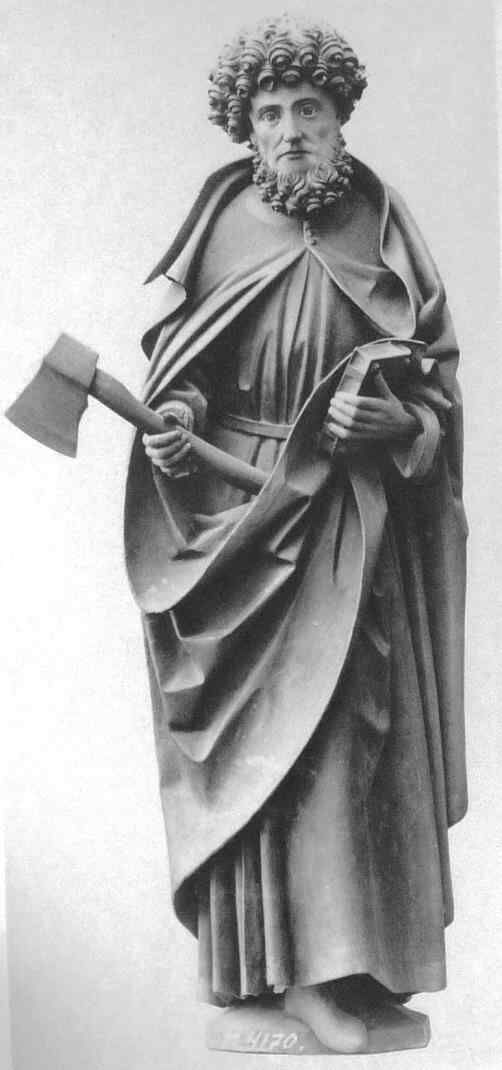 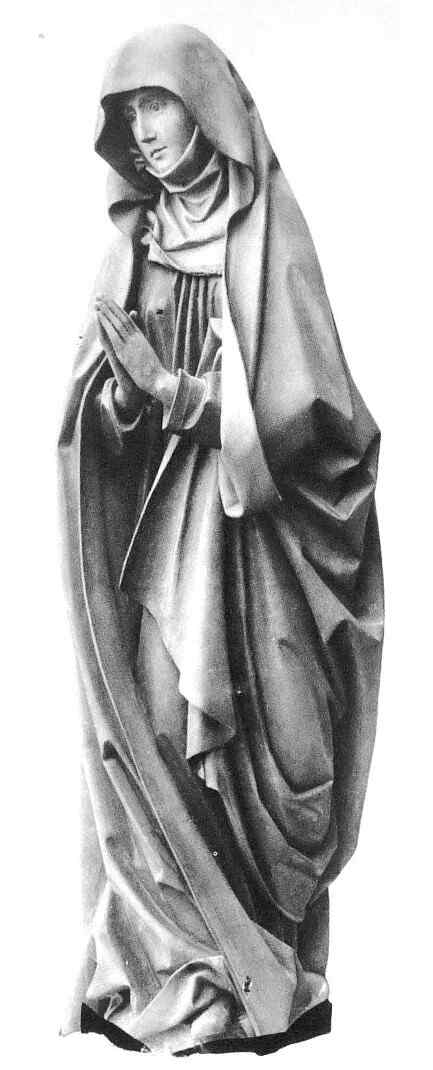 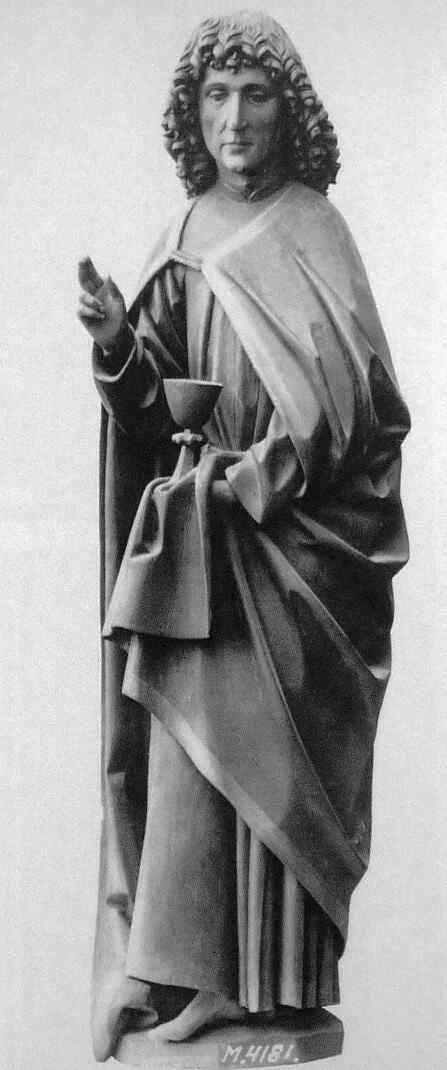 The time when these highly individual figures were created was also especially great in wood-carving, with which they decorated the Choristers' seats in their churches. We will give two examples from the Frauenkirche in Munich, end of the 15th century. 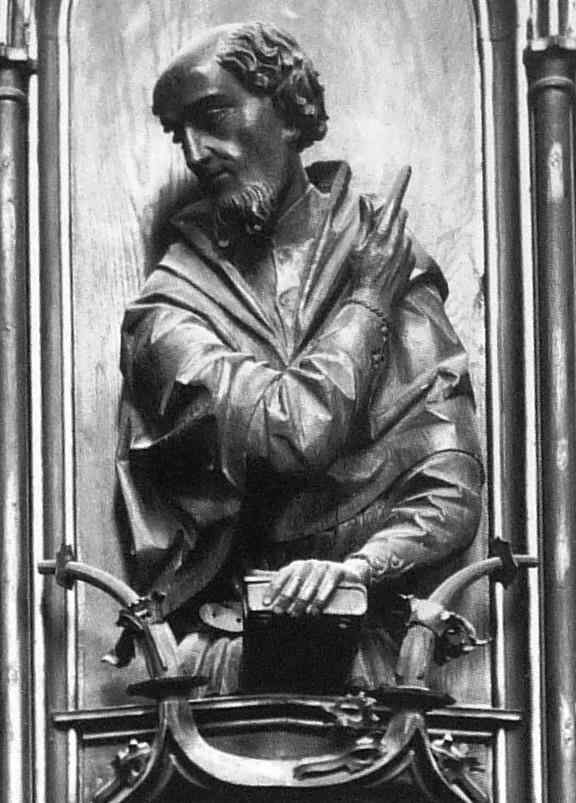 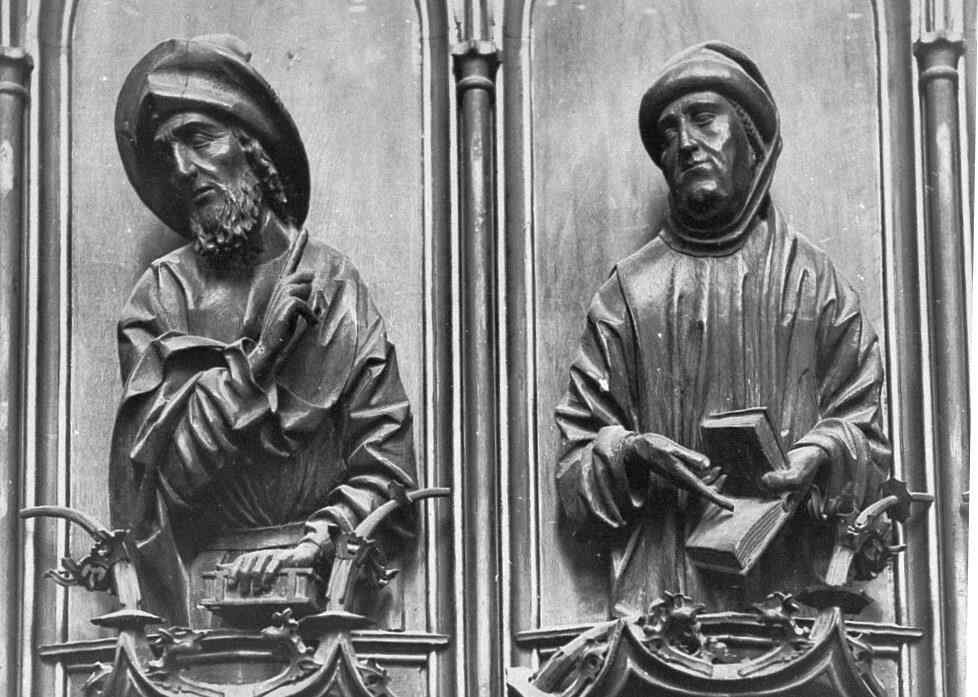 We now come to the sculptor who worked at the end of the 15th century. 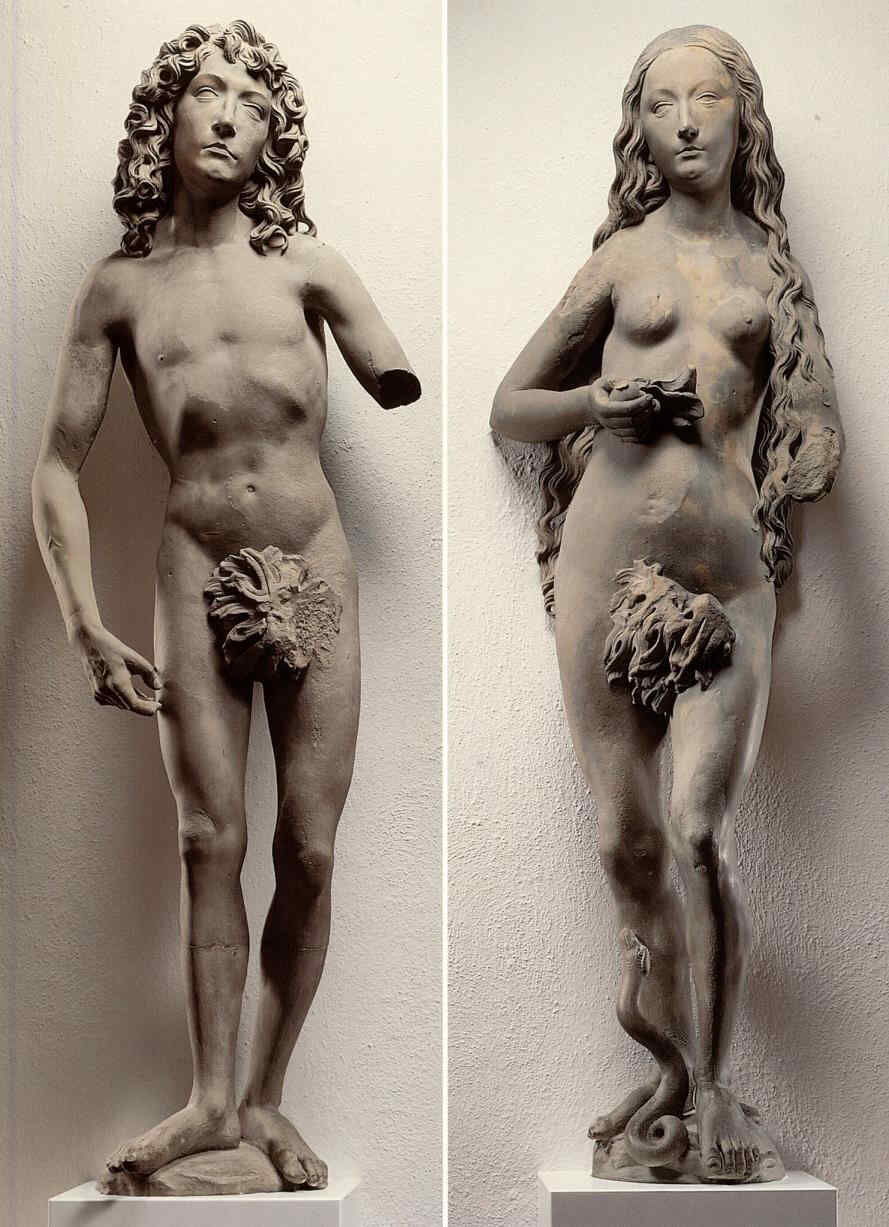  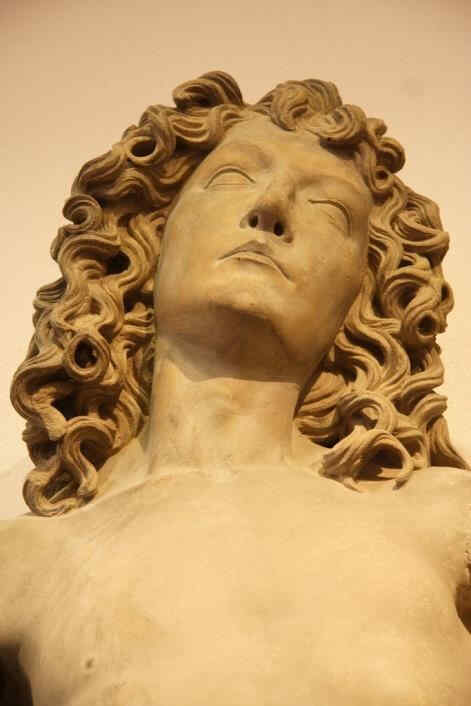 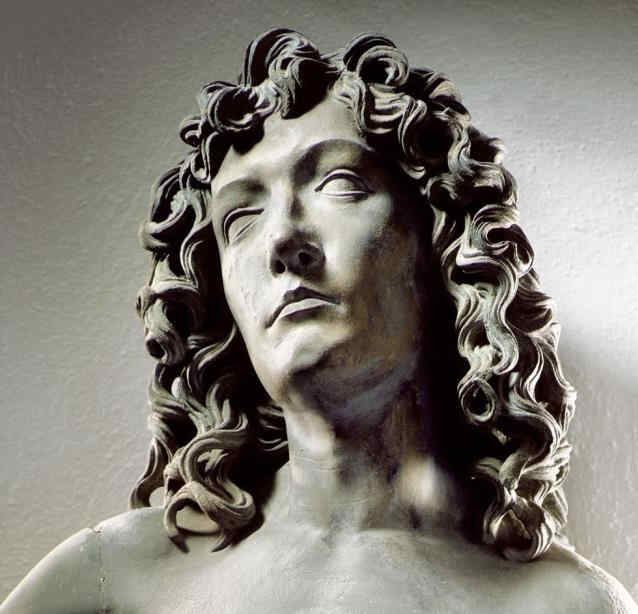  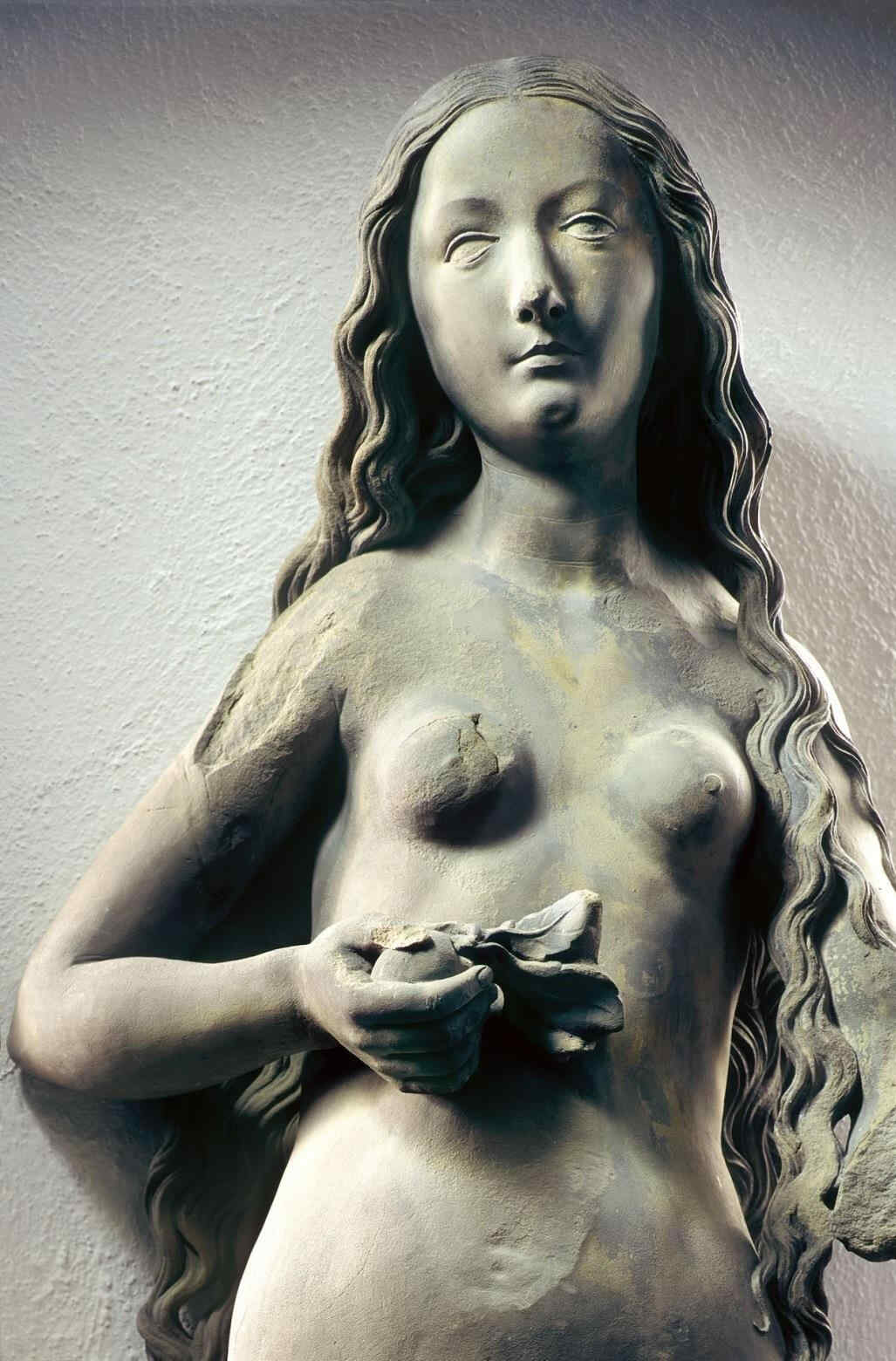 And this was the time when the High Renaissance in Italy had not as yet begun. These works were created about 1490–1495.  This St. Elizabeth—created in the early 16th century—is now in the (Germanisches Museum, at Nuremberg.) 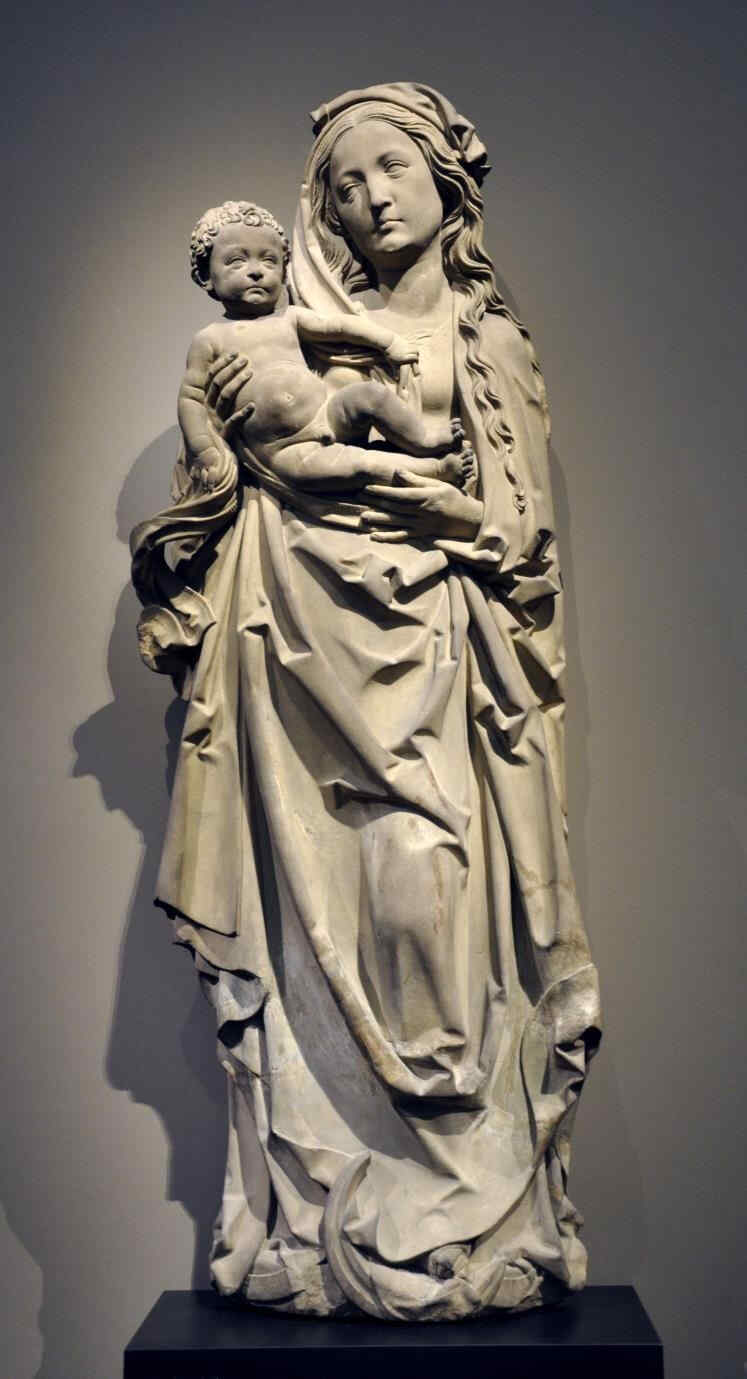 This, too, dates from the beginning of the 16th century. 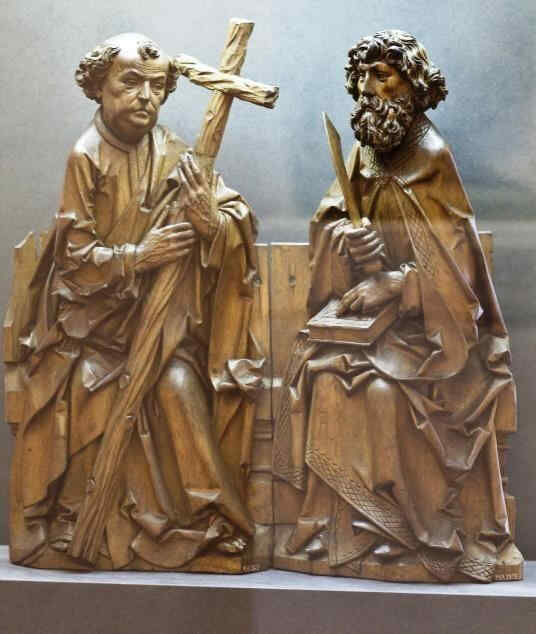 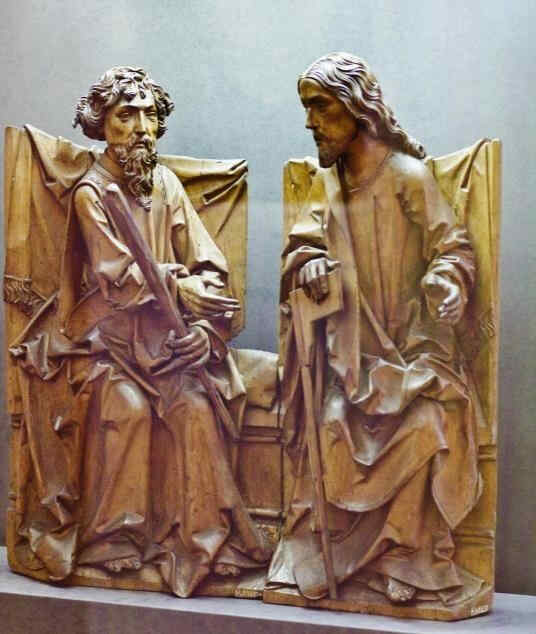 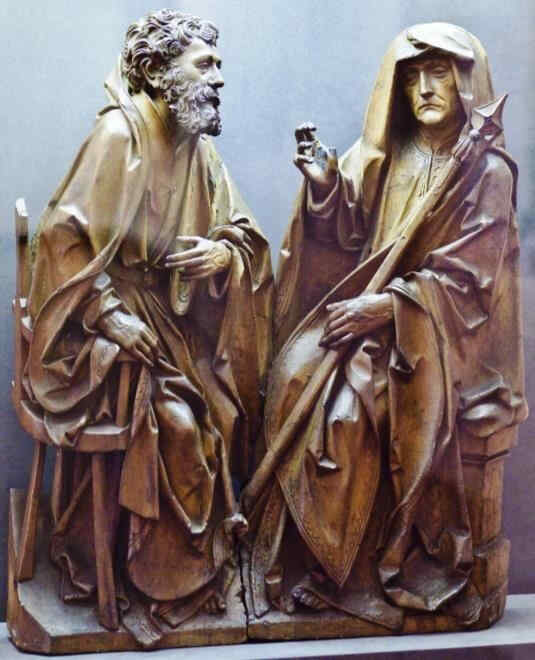 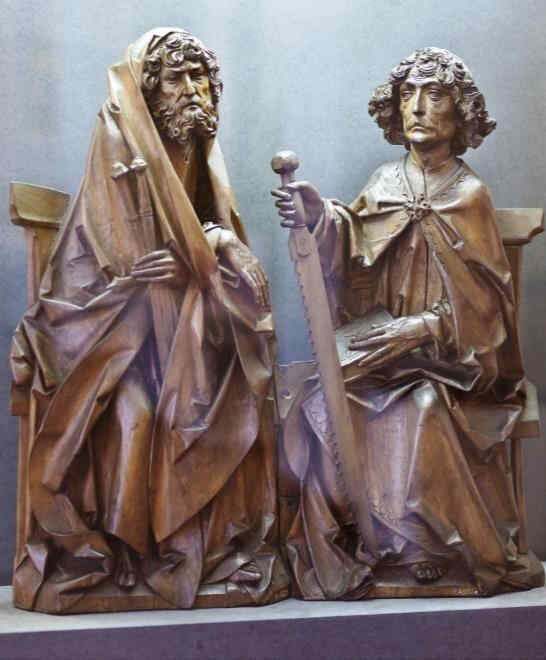 There are wonderful types among these twelve Apostles; one would like to study every single head alone: 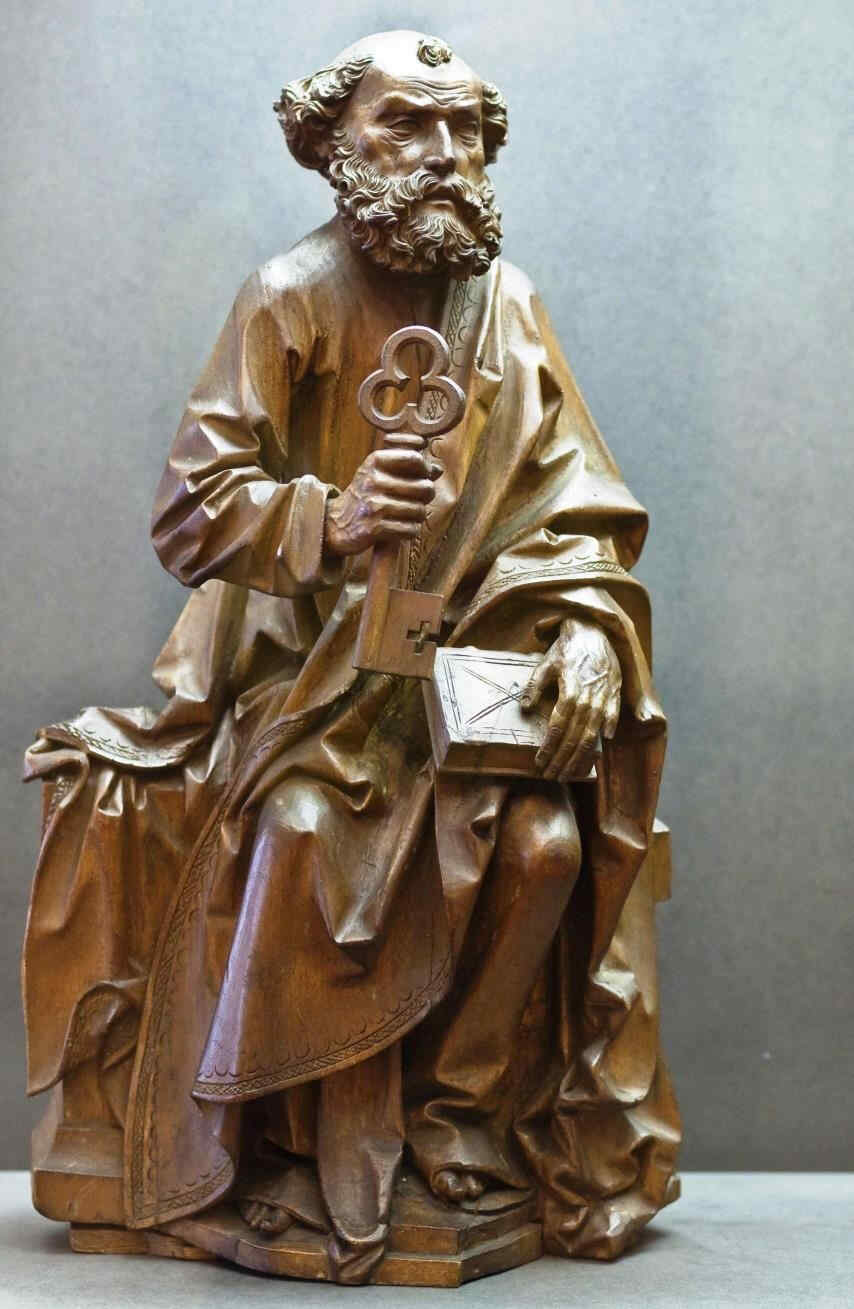 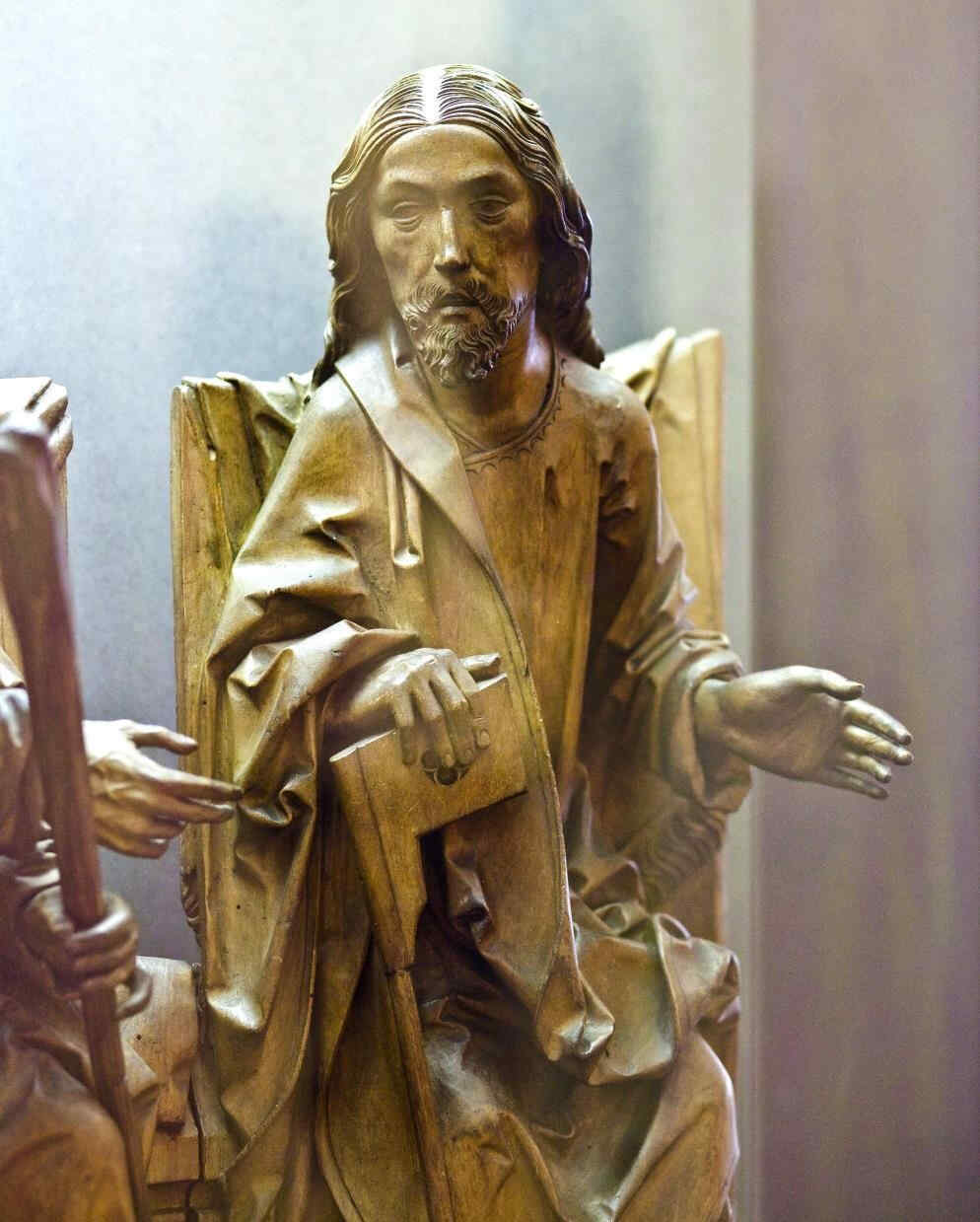 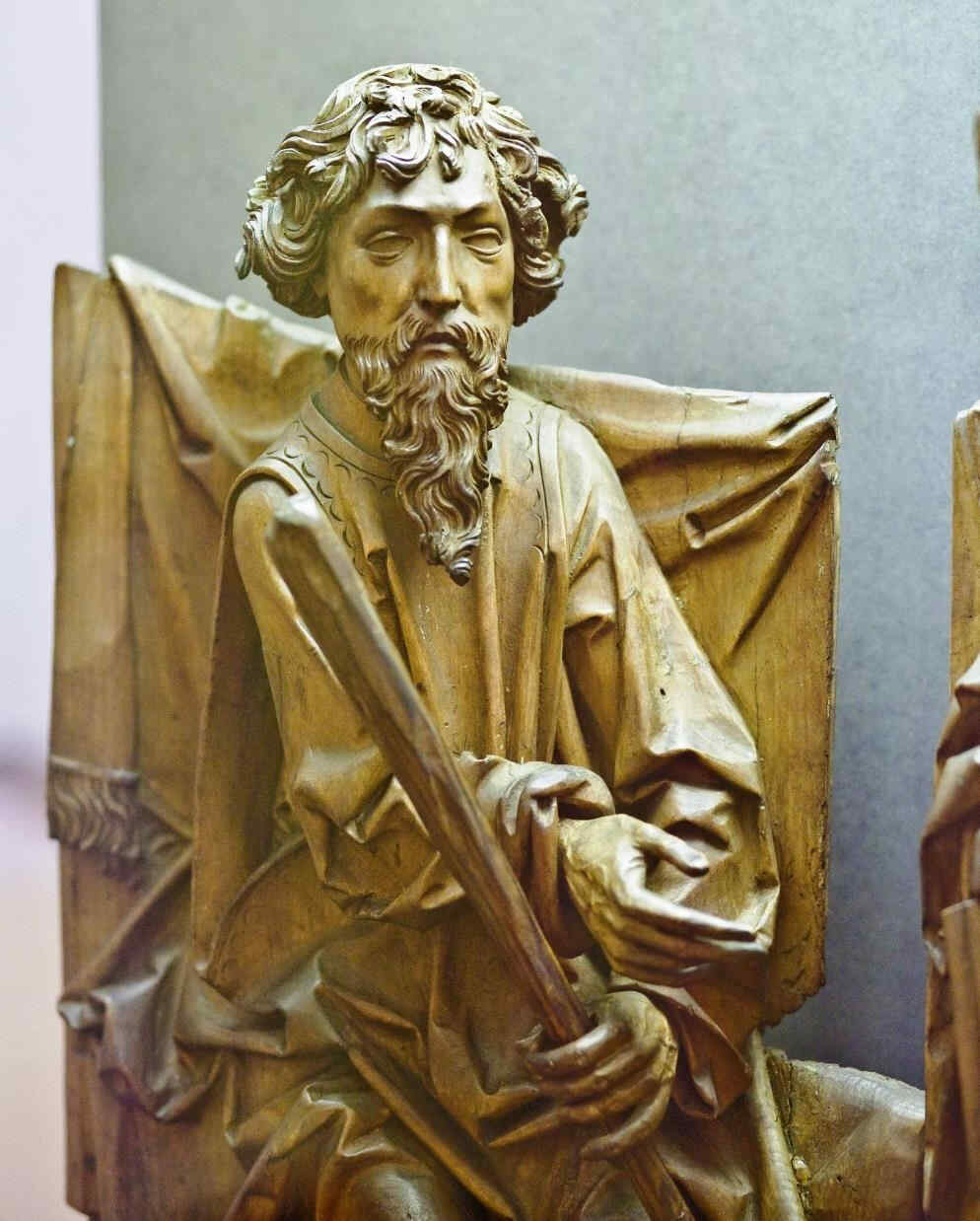 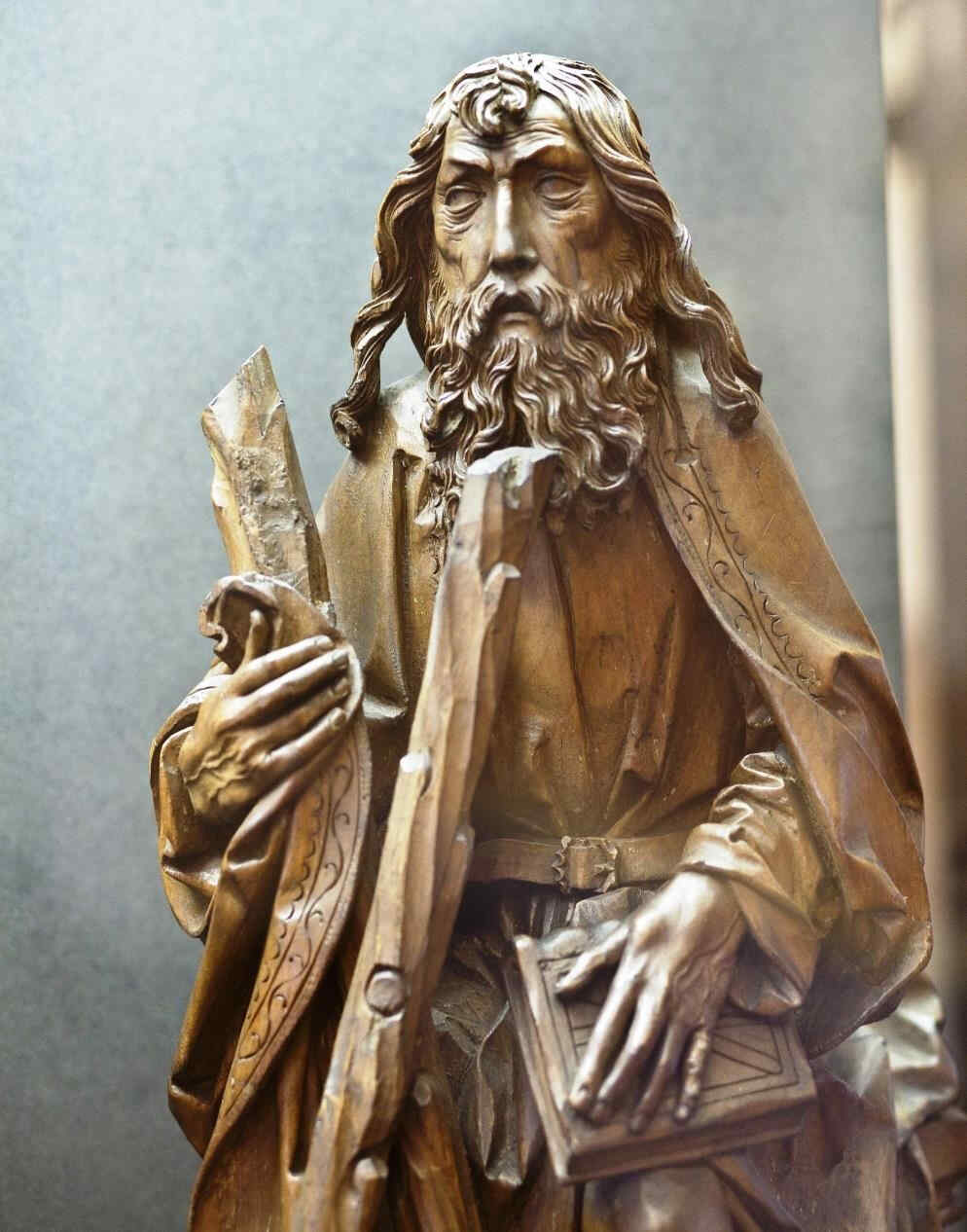   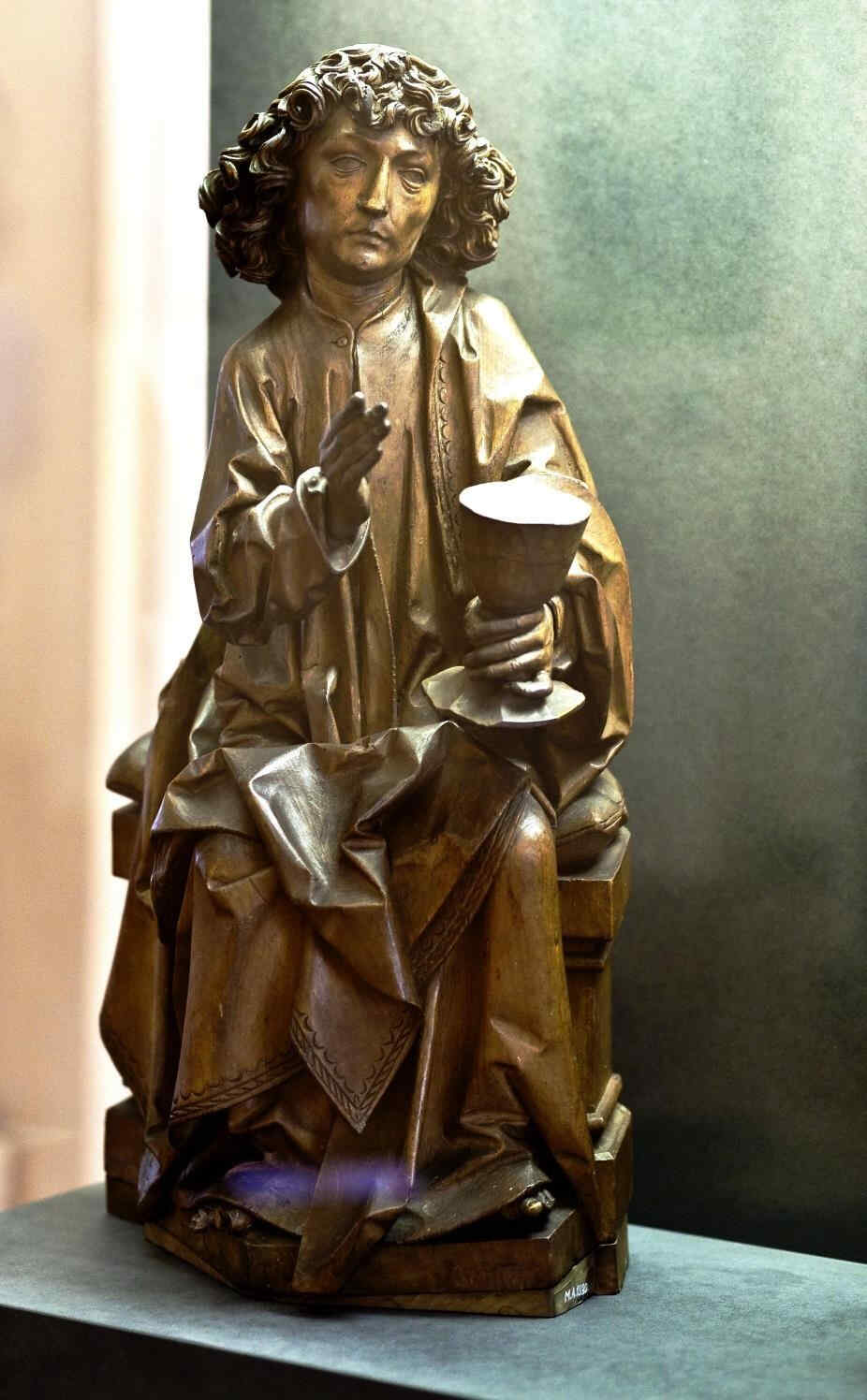 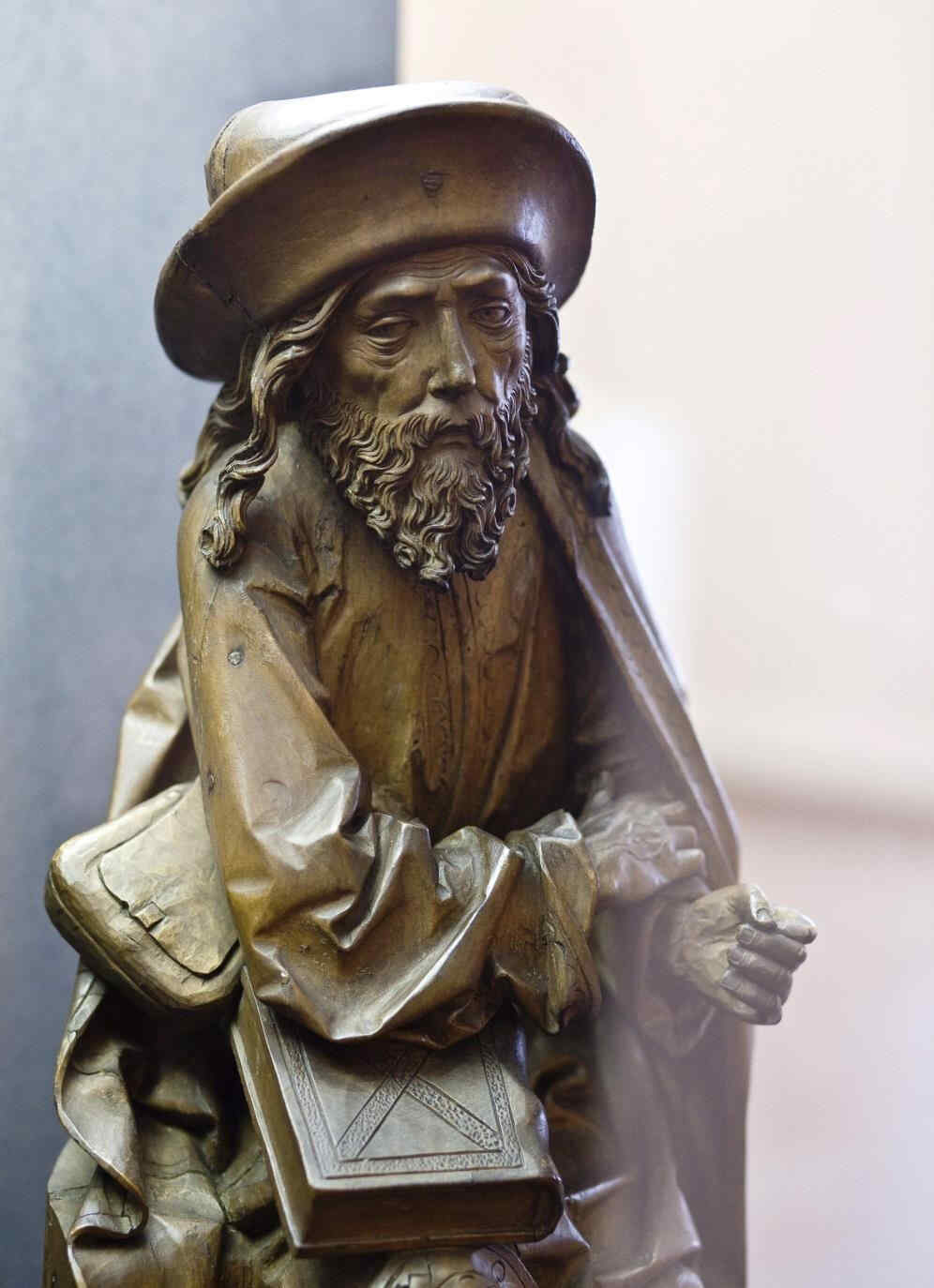 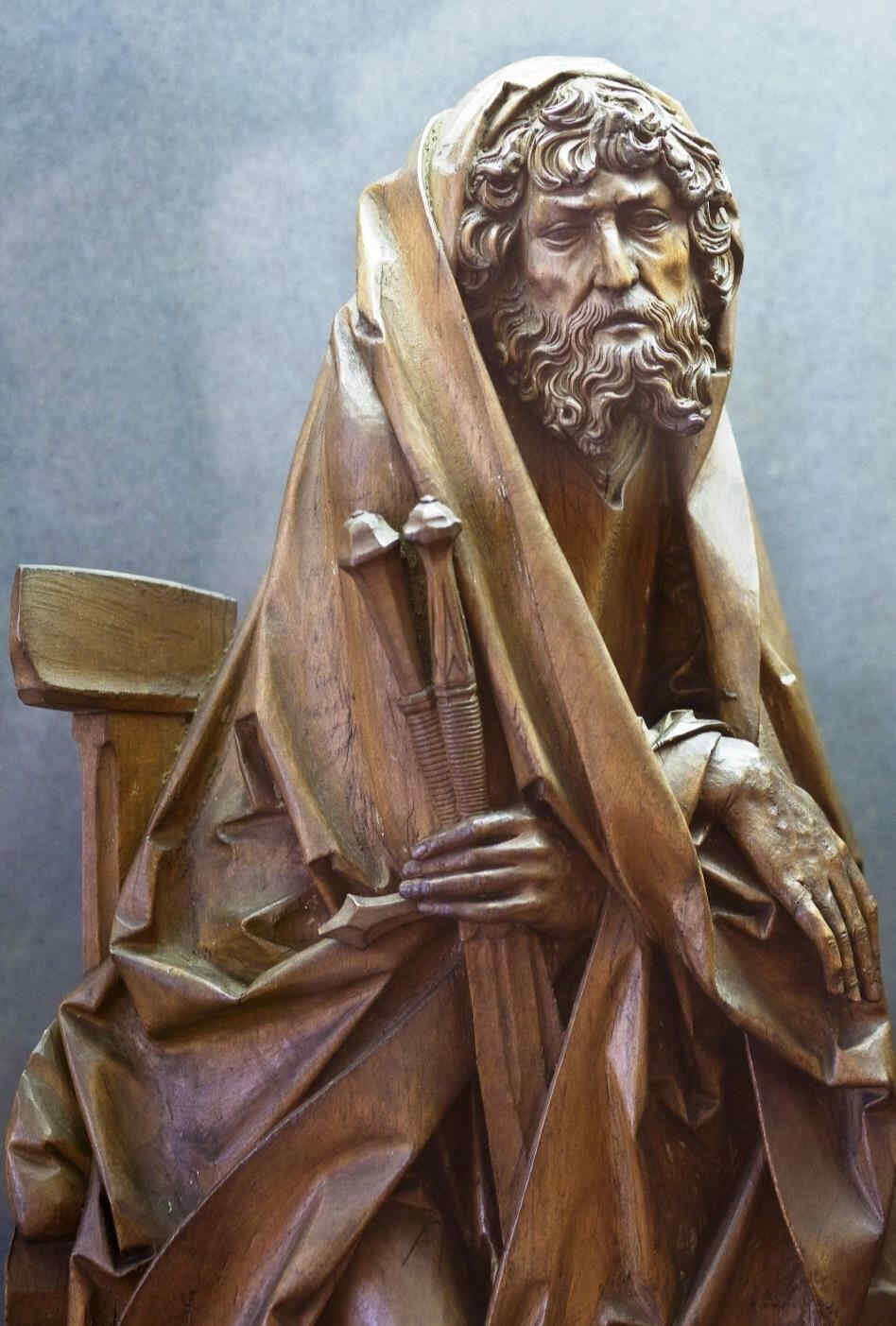 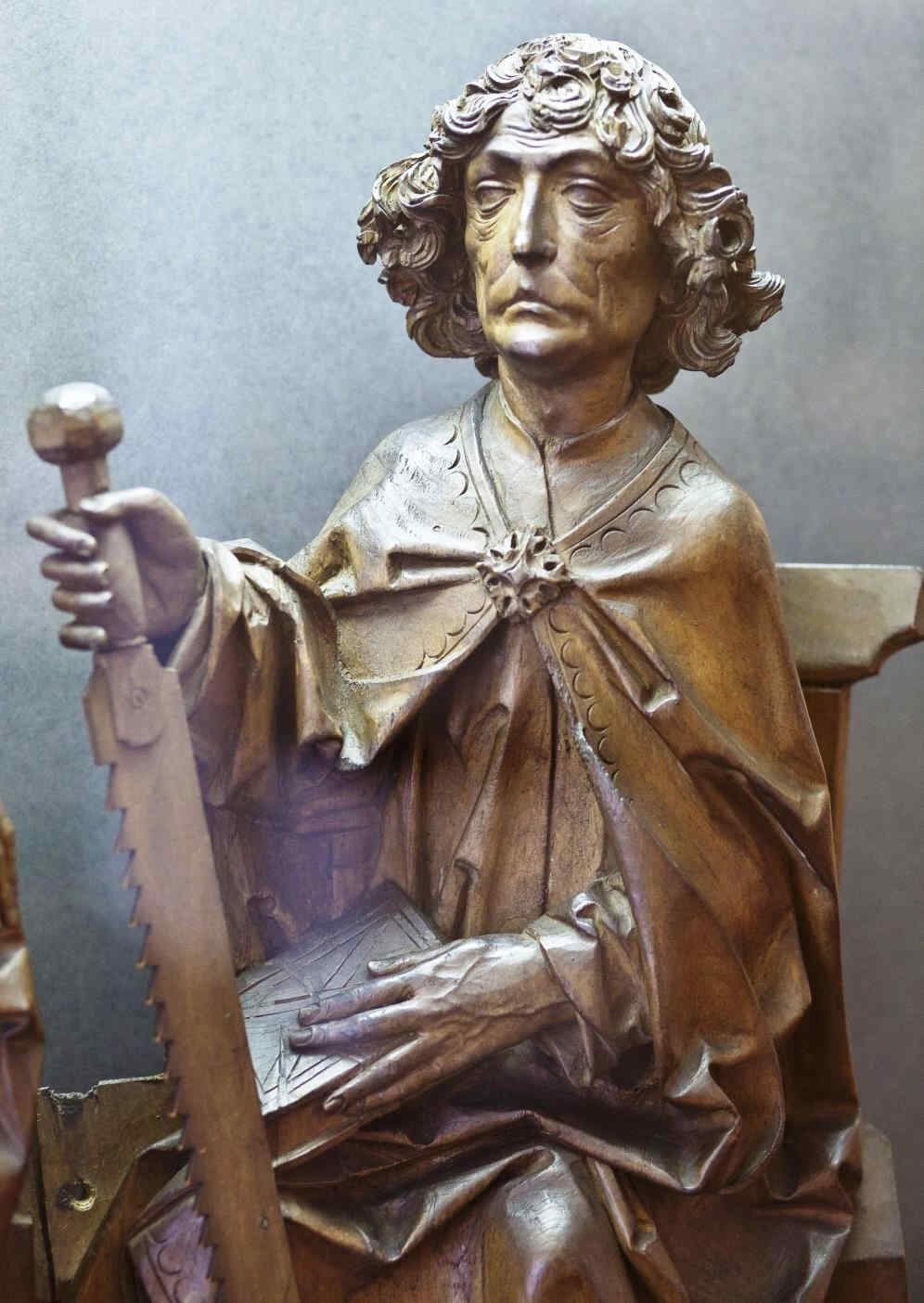 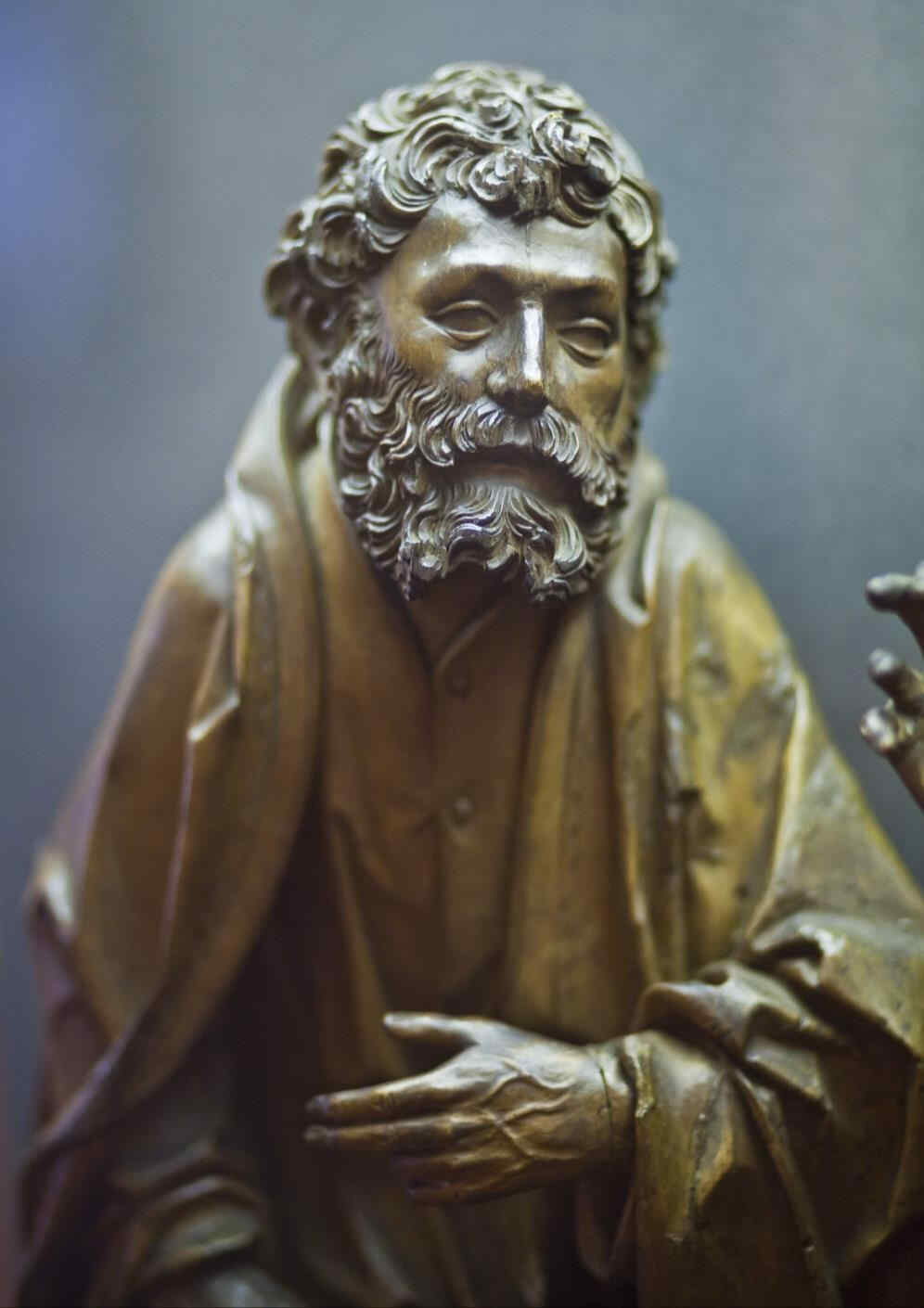 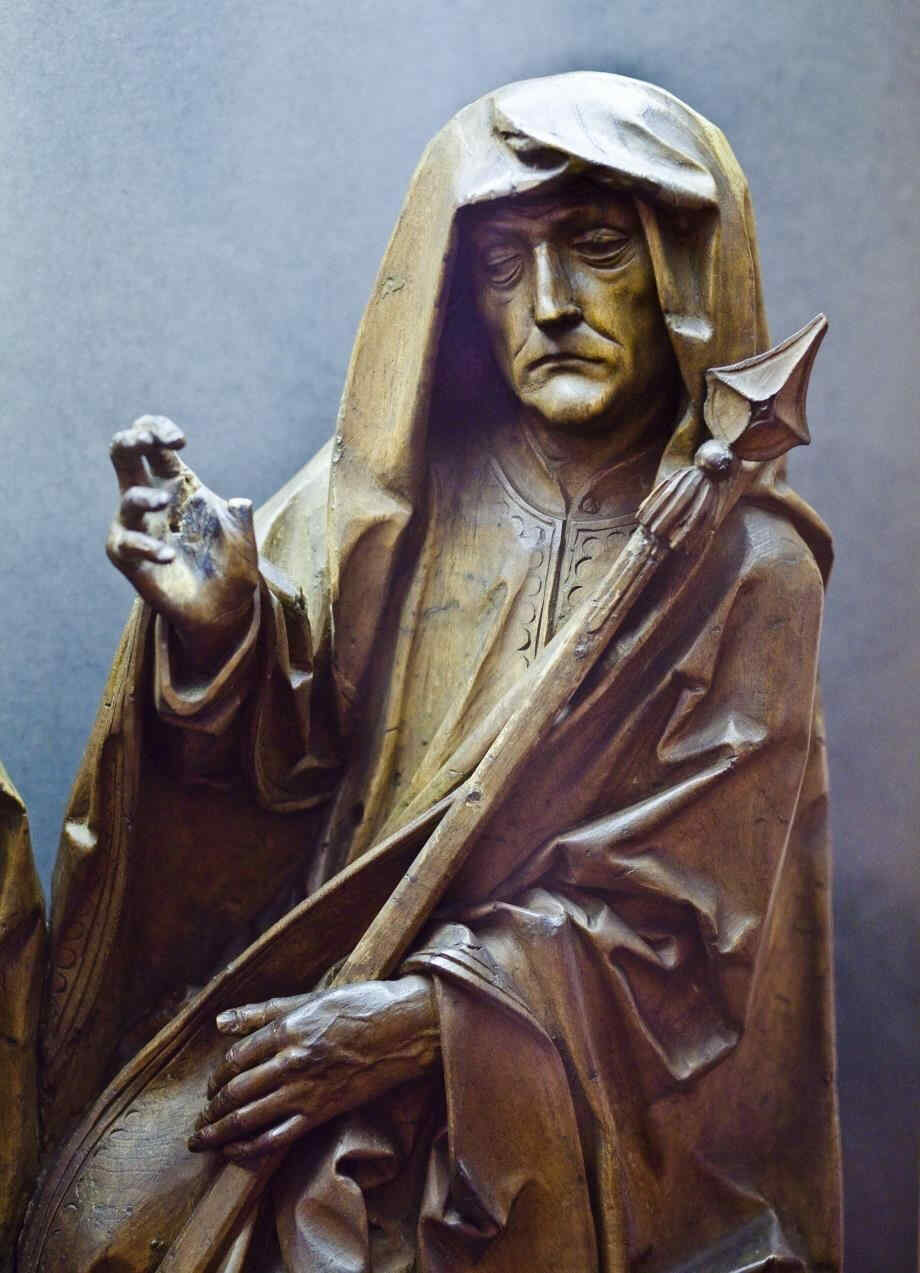 Finally, we give two examples of the sculptor—Veit Stoss—early 16th century, who worked in Cracow and also in Southern Germany, creating his plastic works in many different materials. 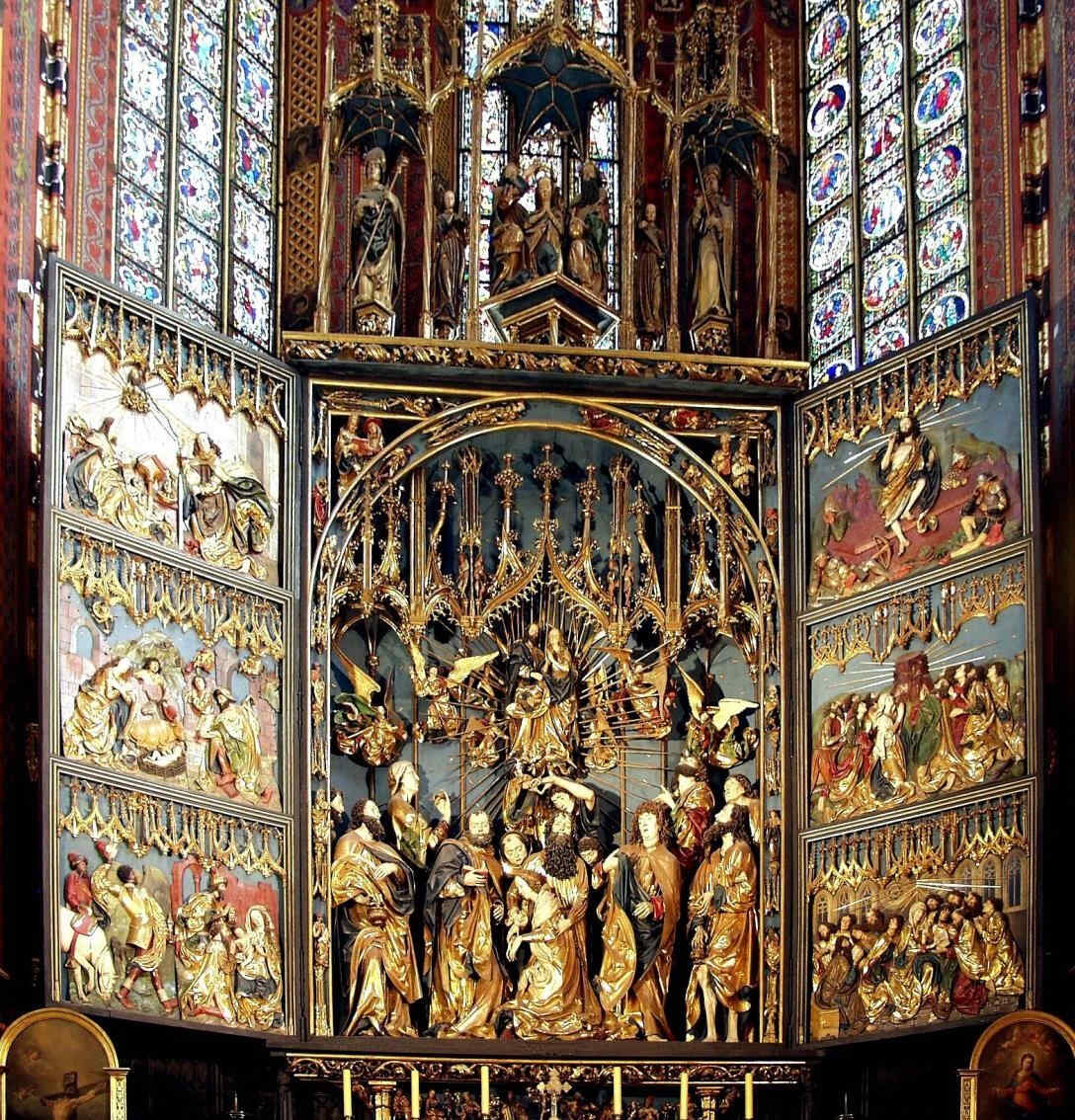 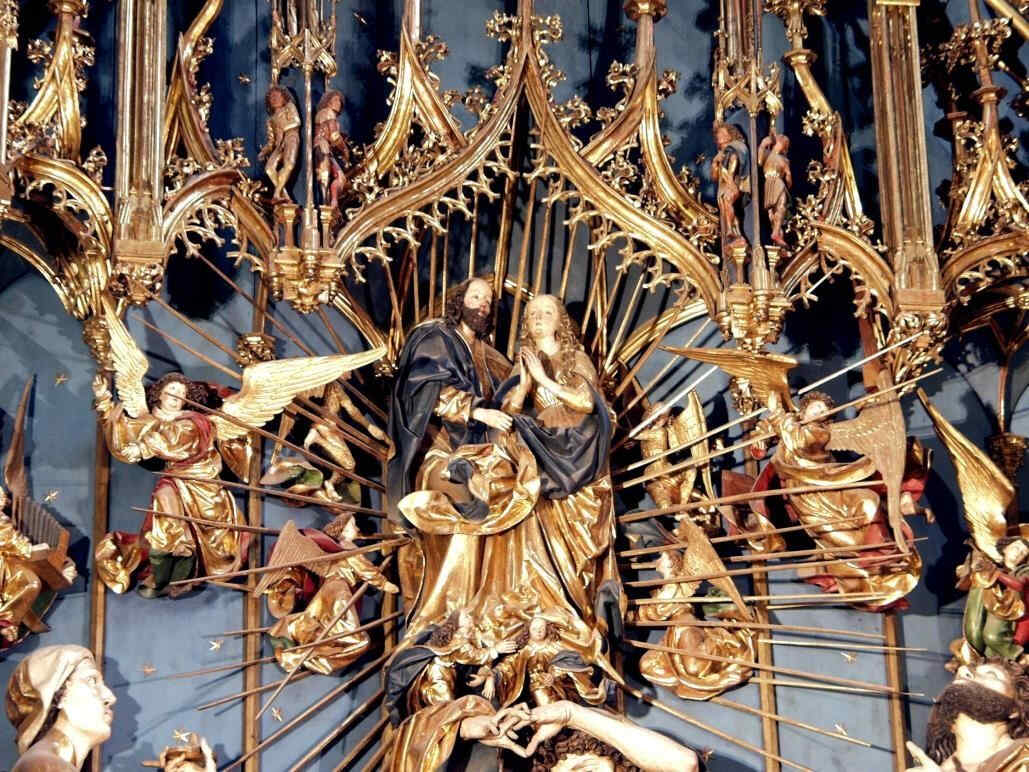 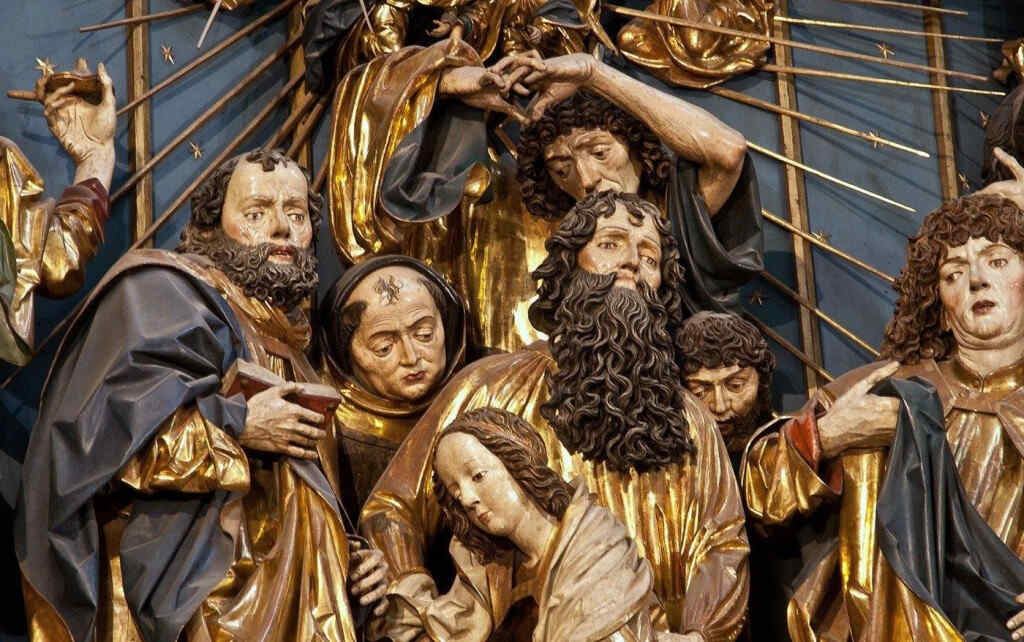 The next picture is in Nuremberg,. “The Angel's Greeting,” it is called.   I will also show three paintings by Hans Baldung, also known as Hans Grun, who worked in Dürer's workshop at the beginning of the 16th century—about 1507–1509. 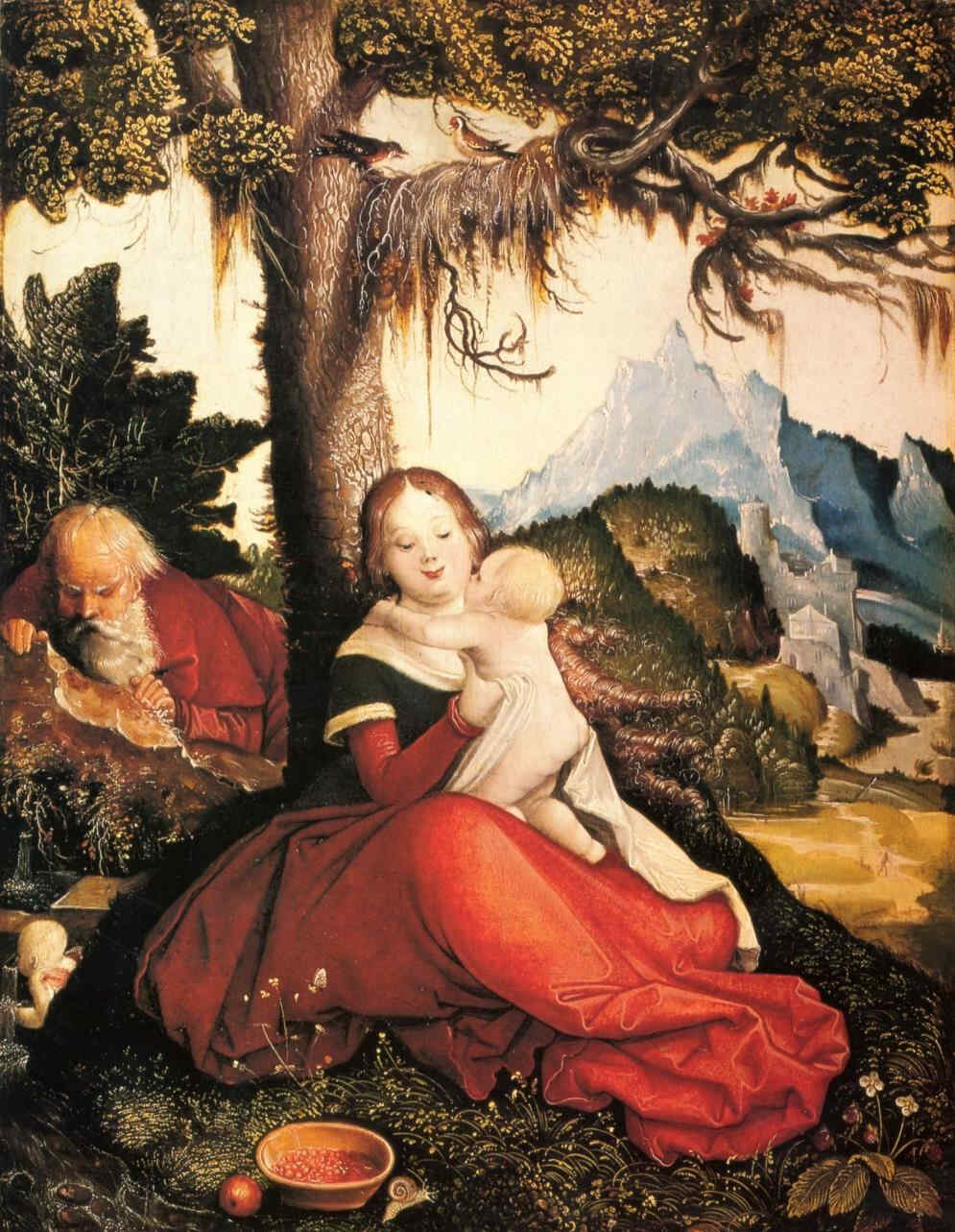 His pictures reveal once more, in the sphere of painting, how everything is turned towards the life of the soul. 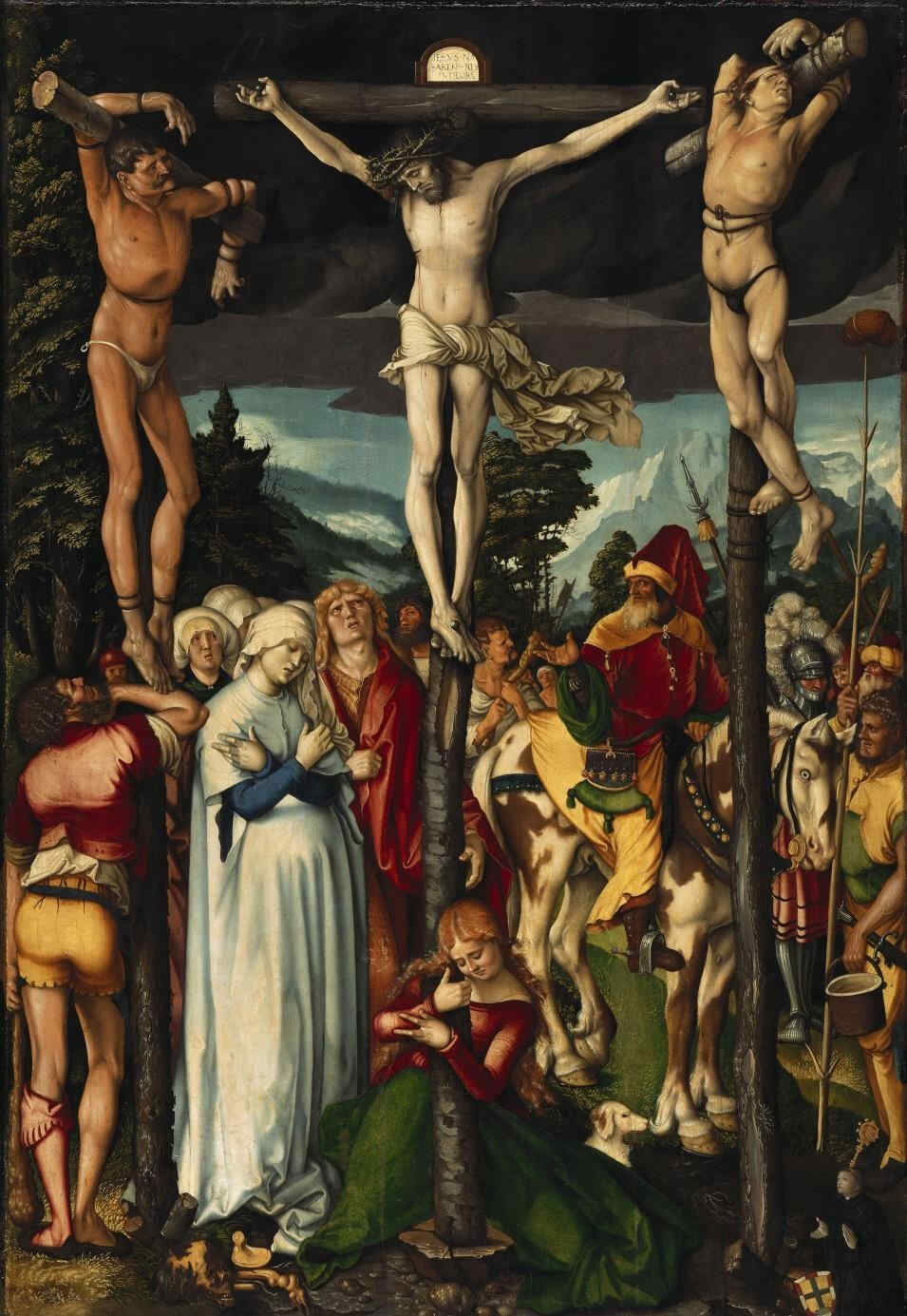 Hans Baldung was also a portrait painter of no mean order. Here you have an example. 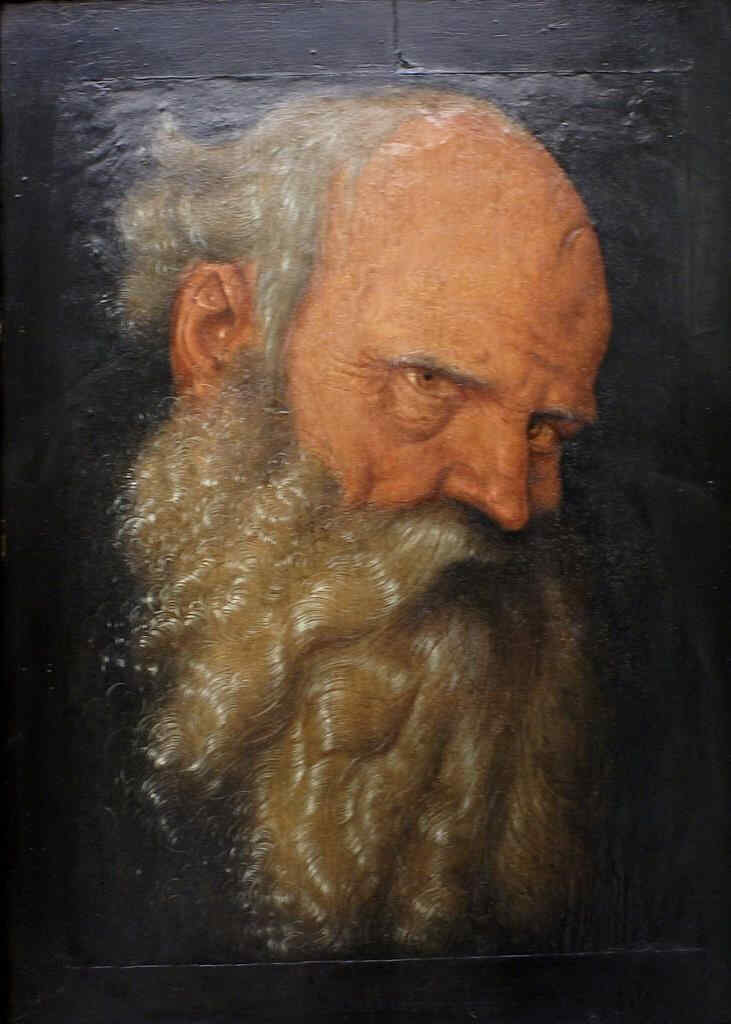 Here you see how the same master cultivated the art of portraiture. He was a pupil of Dürer's, who subsequently lived at Strasburg, and at Freiburg in Breisgau. He did some wonderful paintings of the Life of Christ, and of the Mother of Christ. You will find a picture by him at Basel—“Christ on the Cross.” 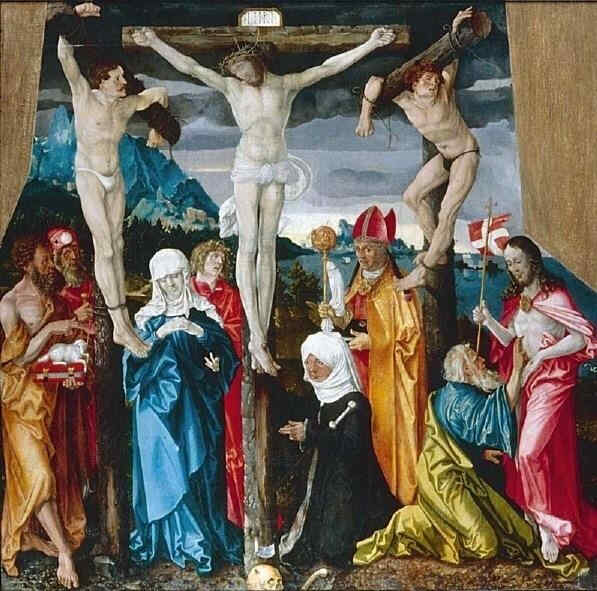 This picture, then, is of the early 16th century—the time of Raphael and Michelangelo in Rome. My dear Friends, the more we multiply these pictures, the more should we see, from this juxtaposition of the Northern and Southern Art, what an immense revolution took place at the turn of the fourth and fifth Post-Atlantean Epochs. And the more should we realise how infinitely rich in content is the simple statement that at that historic moment Civilisation passed from the development of the Intellectual, or Feeling Soul into that of the Spiritual Soul. Infinitely much is contained in such a simple statement. But we only learn to understand these things of Spiritual Science rightly when we follow them into the several and detailed domains of human life. In conclusion, my dear Friends, I still wish to speak a word of solemn remembrance to you on this day. The day after tomorrow is the anniversary of the death of our dear friend, Fraulein Stinde, and in our hearts we will not forget to think on that day of all that came into our Movement through the work of this dear and valued member. And we will also turn our thoughts to her soul as she works on in the Spiritual Worlds—deeply and lovingly connected as she is with our Movement. On this day especially we will deepen the thoughts and feelings of our hearts which are directed to her. I only wished to add this word of remembrance to remind you of the day after tomorrow. In memory of all that unites us with our dear friend—with the soul of our dear Sophie Stinde—let us now rise from our seats. |
| 114. The Gospel of St. Luke: Love and Compassion, the Mission of the Bodhisattvas and the Buddha
16 Sep 1909, Basel Tr. Dorothy S. Osmond, Owen Barfield Rudolf Steiner |
|---|
| It was clothed in momentous words, words that resounded through the whole of evolution and have become the Christmas message. Rightly rendered, these words would be as follows: ‘The Divine Beings manifest themselves from on high, that peace may reign on the Earth below among men who are filled with good will!’ |
| 114. The Gospel of St. Luke: Love and Compassion, the Mission of the Bodhisattvas and the Buddha
16 Sep 1909, Basel Tr. Dorothy S. Osmond, Owen Barfield Rudolf Steiner |
|---|
Throughout the Christian era the Gospel of St. John was the text that made the strongest impression upon those who were trying to deepen their understanding of the cosmic mysteries of Christianity. This was the Gospel used by all the Christian mystics who were striving to mould their lives in accordance with its presentation of the personality and nature of Christ Jesus. In the course of the centuries a somewhat different attitude was adopted by Christian humanity to the Gospel of St. Luke—an attitude altogether in keeping with the indications given in the last lecture, from another point of view, regarding the contrast between these two Gospels. Whereas the Gospel of St. John was in a certain sense a text for mystics, the Gospel of St. Luke was always a devotional book for humble folk, for those whose simplicity and innocence of heart enabled them to rise into the sphere of truly Christian feeling. The Gospel of St. Luke has been a book of devotion throughout the centuries. For all those who were bowed down with sorrow or suffering it was a fount of consolation, speaking with such tenderness of the great Comforter, the great Benefactor of mankind, the Saviour of the heavy-laden and oppressed. It was a book to which especially those who longed to be filled with Christian love turned their hearts and minds, because the power of love is revealed more clearly in this Gospel than in any other Christian document. Those who were in any way conscious—and strictly speaking this applies to everyone—of having the burden of some guilt upon their hearts, at all times found consolation and edification when they turned to the Gospel of St. Luke and understood its message. They could say to themselves: Christ Jesus came not only for the righteous but also for sinners; He sat with publicans and transgressors. Whereas much preparation is necessary before the full power of St. John's Gospel can be realized, it may be said of St. Luke's Gospel that no nature is too immature to be aware of the warmth streaming from it. From the earliest times this Gospel was an inspiration to the most childlike of men. All that remains childlike in the human soul from tenderest youth to ripest age has always felt drawn to the Gospel of St. Luke. And as regards pictorial representations of Christian truths and what art has acquired from these truths, we find that although much is derived from the other Gospels, the indications for the most intimate messages conveyed to the human heart by forms of art, by paintings, are to be found precisely in the Gospel of St. Luke. The portrayals of the deep connection between Christ Jesus and John the Baptist have their source in this imperishable Gospel. Anyone who allows it to work upon his soul will find that from beginning to end it gives expression to the principle of love, compassion and innocence—in a certain sense, childlike innocence. Where else do we find such a tender portrayal of the childlike nature as in what is said of the childhood of Jesus of Nazareth in the Gospel of St. Luke? The reason will become clear as we penetrate more deeply into the words of this wonderful text. It will be necessary now to say certain things that may seem paradoxical to those of you who have heard other lectures or courses of lectures given by me on the same subject. But if you will wait for the explanations to be given in the next lectures, you will realize that what I shall say is in harmony with what you have previously heard from me about Christ Jesus and Jesus of Nazareth. The whole complicated range of truth cannot be presented all at once, and today I shall have to indicate an aspect of the Christian truths that may seem not to tally exactly with what has been said on some previous occasion. Our procedure must be, first to show how the separate currents of truth have developed and then the mutual agreement and harmony that finally become apparent. The Gospel of St. John was deliberately our starting-point, and I was naturally unable to indicate more than part of the truth in the various courses of lectures. What was said still holds good, as we shall see, although our attention to-day must be turned to an unusual aspect of Christian truths. A wonderful passage in the Gospel of St. Luke describes how an Angel appeared to the shepherds in the fields and announced to them that the Saviour of the world was born. Then come the words: ‘And suddenly there was with the Angel a multitude of the heavenly host.’ Picture the scene to yourselves: as the shepherds look upwards the heavens open and the Beings of the spiritual world are revealed in sublime pictures. What was the proclamation to the shepherds? It was clothed in momentous words, words that resounded through the whole of evolution and have become the Christmas message. Rightly rendered, these words would be as follows: ‘The Divine Beings manifest themselves from on high, that peace may reign on the Earth below among men who are filled with good will!’ The usual expression, ‘glory’ is entirely out of place here. The sentence is correct in the form I have now given, and the contrast should be clearly emphasized. What the shepherds saw was the manifestation of spiritual Beings from on high, and the revelation occurred when it did in order that peace might pour into human hearts that were filled with a good will. As we shall see, many mysteries of Christianity are embodied in these words, provided only they are rightly understood. But certain preliminaries are necessary if light is to be thrown on this momentous proclamation. Above all we must endeavour to study the accounts available to clairvoyant faculties from the Akashic Chronicle. With opened eyes of spirit we must contemplate the epoch when Christ Jesus came to humanity, and ask ourselves: What was the historical background and the source of the spiritual impulse poured into Earth evolution at that time? Currents of spiritual life from many different sides converged and flowed into the evolution of humanity at that point. The very diverse world-conceptions that had arisen in various regions of the Earth in the course of the ages converged in Palestine as though into one central point and came to expression in the events there. We may therefore ask: What are the sources of these streams? It was indicated yesterday that in the Gospel of St. Luke we have the fruits of Imaginative Cognition, and that this knowledge is gained in the form of pictures. In the events just mentioned a picture is placed before us of the manifestation to the shepherds of spiritual Beings from on high: first, the picture is of a spiritual Being, an Angel, who is followed by a ‘heavenly host’. Here we must ask: What does a clairvoyant initiated into the mysteries of existence see in this picture—which he can always evoke again at will—when he gazes into the Akashic Chronicle? What was it that was revealed to the shepherds? What was this angelic host, and whence did it come? This picture portrays one of the great spiritual streams that flowed through the process of evolution, gradually rising higher and higher, until at the time of the events in Palestine its light could shine down upon the Earth only from spiritual heights. From the angelic host revealed to the shepherds, we are led back, in deciphering the Akashic Chronicle, to one of the greatest streams of spiritual life in the evolution of humanity, a stream which, several centuries before the coming of Christ, spread far and wide in the form of Buddhism. An investigator of the Akashic Chronicle who traces back into previous ages the origin of the revelation to the shepherds, is led, strange as it will seem to you, to the ‘Enlightenment’ of the great Buddha. The light that shone out in India, setting men's hearts and minds astir as the religion of love and compassion, as a great world-conception, and even to-day is spiritual nourishment for a very large section of humanity—that light appeared again in the revelation to the shepherds! For it too was to stream into the revelation in Palestine. The account given at the beginning of St. Luke's Gospel cannot be understood unless we consider (again from the vantage-point of spiritual-scientific research) the significance of Buddha and what his revelation actually brought about in the course of human evolution. When Buddha was born in the East, five to six centuries before our era, there appeared in him an Individuality who had lived many times on Earth and in the course of his previous incarnations had already reached the very lofty stage of human development designated by an Oriental expression as that of a ‘Bodhisattva’. Some of you have heard lectures on different aspects of the nature of the Bodhisattvas. In the lecture-course Spiritual Hierarchies and their Reflection in the physical World, given in Düsseldorf some months ago, I spoke of how the Bodhisattvas are related to the whole of cosmic evolution; in Munich, in the lecture-course The East in the Light of the West1 they were referred to from a different point of view. To-day we shall consider the nature of the Bodhisattvas from still another side and you will gradually perceive the harmony between the single truths. He who became a Buddha had first to be a Bodhisattva; individual development to the rank of Buddhahood is preceded by the stage of ‘Bodhisattva’. We will now think of the nature of the Bodhisattvas in relation to the evolution of humanity considered from the viewpoint of spiritual science. The capacities and faculties possessed and developed by human beings in any particular epoch were not always in existence. To believe that the same faculties possessed by man to-day were also present in primeval times is due to incapacity and unwillingness to see beyond the present. Man's faculties, everything he is able to accomplish and know, vary from epoch to epoch. His faculties to-day are developed to the point where with his own power of reasoning he is justified in saying: ‘I recognize this or that truth by means of my intelligence and my reason; I can recognize what is moral or immoral, logical or illogical in a certain respect. But it would be a mistake to believe that these capacities for distinguishing the logical from the illogical or the moral from the immoral, were always to be found in human nature. They came into existence and developed gradually. What man can accomplish to-day by means of his own capacities, he had at one time to be taught—as a child is taught by its parents or teachers—by Beings who though incarnated among men were more highly developed by virtue of their spiritual faculties and could hold converse in the Mysteries with divine-spiritual Beings even loftier than themselves. Individualities who, though themselves incarnated in physical bodies, could have intercourse with still higher, non-incarnated Individualities, existed at all times. For example, before men acquired the faculty of logical thinking by means of which they themselves are able to think logically to-day, they were obliged to learn from certain teachers. These teachers themselves were not able to think logically through faculties developed in the physical body itself, but only through their intercourse in the Mysteries with divine-spiritual Beings in higher realms. Such teachers proclaimed the principles of logic and morality from revelations they received from higher worlds in times before men themselves were able, out of their own earthly nature, to think logically or discover the principles of morality. The Bodhisattvas are one category of Beings who, though incarnated in physical bodies, have inter-course with divine-spiritual Beings in order to bring down and impart to men what they themselves learn from their divine Teachers. The Bodhisattva is a Being incarnated in a human body, whose faculties enable him to commune with divine-spiritual Beings. Before Gautama Buddha became a ‘Buddha’, he was a Bodhisattva, that is to say, an Individuality who, in the Mysteries, was able to commune with higher, divine-spiritual Beings. In remote, primeval ages of Earth evolution, a Being such as the Bodhisattva was entrusted in the higher world with a definite task, a definite mission, which he continues to discharge. When the Earth was still in early stages of development, even before the Atlantean and Lemurian epochs, the Bodhisattva who was incarnated and became Buddha six hundred years before our era, was assigned a task which he never abandoned. From epoch to epoch, through every age, his work was to impart to Earth evolution as much as the beings concerned enabled it to receive. For each Bodhisattva there comes a time when, with the mission entrusted to him in the primeval past, he reaches a definite point—the point when what he has been able to let flow into humanity ‘from above’ can become a faculty of man's own. A human faculty to-day was once a faculty of divine-spiritual Beings brought down to man from spiritual heights by the Bodhisattvas. Hence there comes a time when a spiritual emissary such as a Bodhisattva can say; ‘I have accomplished my mission. Humanity has now received that for which it has been prepared through many, many epochs.’ Having reached this point, the Bodhisattva can become ‘Buddha’. That is to say, the time has come when he, as a Being with the particular mission to which I have referred, need no longer incarnate in a human physical body; he has incarnated for the last time in such a body and need not incarnate again as a spiritual emissary in the above sense. This point of time arrived for Gautama Buddha. The task assigned to him had led him again and again down to the Earth; but he appeared in his final incarnation as Bodhisattva when, after his Enlightenment, he became Buddha. He incarnated in a human body that had developed to the highest possible stage those faculties which hitherto had had to be bestowed from above, but were now gradually to become human faculties in the fullest sense. When a Bodhisattva has succeeded through his foregoing development in making a human body so perfect that it can itself evolve the faculties connected with his particular mission, he need not incarnate again. He then hovers in spiritual realms, sending his influence into humanity, furthering and guiding human affairs. Henceforth it is the task of men to develop the gifts formerly bestowed upon them from heavenly heights, saying to themselves: ‘We must now ourselves develop in a way that will further elaborate the faculties acquired in full measure for the first time in the incarnation when the Bodhisattva became Buddha.’ When the Being who works through successive epochs as Bodhisattva appears as one into whose human nature every faculty that previously flowed down from heavenly heights has been integrated and can now be expressed through him as an individual—that Being is a ‘Buddha’. All this is revealed by Gautama Buddha. Had he, as Bodhisattva, withdrawn earlier from his mission, men could no longer have been blessed by the bestowal of these faculties from on high. But when evolution had progressed so far that these faculties could be present in a single human being on Earth, the seed was laid that would enable men in the future to develop them in their own natures. Thus the Individuality who, as long as he was a Bodhisattva, did not enter fully into the human form but towered upwards into heavenly heights—this Individuality now for the first time drew completely into human nature and was fully embodied in that one incarnation. But then he again withdrew. For with this incarnation as Buddha a certain quotum of revelations had been given to humanity, thereafter to be developed further in men themselves. Hence the Bodhisattva, having become Buddha, might withdraw from the Earth to spiritual heights, might abide there and guide the affairs of humanity from regions where only a certain power of clairvoyance is able to behold him. What, then, was the task of that supremely great Individuality usually called the ‘Buddha’? If we want to understand the task and mission of this Buddha in the sense of true esoteriscism, we must realize the following. The cognitive faculty of mankind has developed gradually. Attention has repeatedly been drawn to the fact that in the Atlantean epoch a large proportion of humanity was clairvoyant and able to gaze into the spiritual worlds, and that certain remnants of this old clairvoyance were still present in post-Atlantean times. After the Atlantean epoch, in the periods of the civilizations of ancient India, Persia, Egypt and Chaldea—even as late as the Graeco-Latin age—there were numbers of human beings, many more than modern man would ever imagine, who possessed the heritage of this old clairvoyance; the astral plane was open to them and they could see into the hidden depths of existence. Perception of man's etheric body was quite usual in the Graeco-Latin age; numbers of people were able to see the human head surrounded by an etheric cloud that has gradually become entirely concealed within the head. But humanity was to advance to a form of knowledge acquired through the outer senses and through the spiritual faculties connected with the senses. Man was gradually to emerge altogether from the spiritual world and to engage in pure sense-observation, in intellectual, logical thinking. By degrees he was to make his way to non-clairvoyant cognition, because he must pass through this stage in order to regain clairvoyant knowledge in the future. But such knowledge will then be united with the fruits of cognition based upon the senses and the intellect. At the present time we are living in an intermediate period. We look back to a past when man was clairvoyant, and to a future when this will again be the case. In our present age the majority of human beings are dependent upon what they perceive with their senses and grasp with their intellect. There are, of course, certain heights even in sensory perception and in knowledge yielded by the intellect and reasoning mind; everywhere there are ‘degrees of knowledge’. One person in a certain incarnation passes through his existence on Earth with little insight into what is moral, and little compassion for his fellow-men. We say of him that he is at a low stage of morality. Another passes through life with very slightly developed intellectual capacities; we call him a person of low intelligence. But these powers of intellectual cognition are capable of rising to a very lofty level. A man whom, in Fichte's sense, we call a ‘moral genius’ reaches the highest level of moral Imagination but there are many intermediate stages. Without possessing clairvoyant faculties we can reach this height only by ennobling powers that are at the disposal of ordinary humanity. These stages had to be attained by man in the course of Earth evolution. What man knows to-day to a certain extent through his own intelligence and also what he attains through his own moral strength, namely the consciousness that he must have compassion with the sufferings and sorrows of others—this consciousness could not have been acquired by a human being in primeval times through his own efforts. It can be said to-day that such insight is unfolded by a healthy moral sense, even without clairvoyance, and to an increasing extent men will come to realize not only that compassion is the very highest virtue but that without love humanity can make no progress. Man's moral sense will grow steadily stronger. But there were epochs in the past when he would never have understood by himself that compassion and love belong to a very high stage of development. It was therefore necessary for spiritual Beings such as the Bodhisattvas to incarnate in human forms. Revelations of the power of compassion and love came to such Beings from the higher worlds and they were able to teach men how to act accordingly. What men have come to recognize to-day through their own powers as the lofty virtues of compassion and love—this had to be taught, through epoch after epoch, from heavenly heights. The Teacher of love and compassion in times when men themselves did not yet realize the nature of those virtues was the Bodhisattva who incarnated for the last time as Gautama Buddha. Buddha was formerly the Bodhisattva, the Teacher of love and compassion. He was the Teacher throughout the epochs just referred to, when men still possessed a certain natural clairvoyance. As Bodhisattva he incarnated in bodies endowed with powers of clairvoyance. Then, when he became Buddha and looked back into these previous incarnations, he could describe the experiences of his inmost soul when it gazed into the depths of existence hidden behind sense-phenomena. He possessed this faculty in previous embodiments and was born with it into the family of Sakya from which his father, Suddhodana, descended. When Gautama was born he was still a Bodhisattva, that is to say he came at the stage of development reached in his previous incarnations. He who is usually called the ‘Buddha’ was born to his father Suddhodana and his mother Mayadevi as a Bodhisattva and possessed the faculty of clairvoyance in a high degree even as a child. He was always able to gaze into the depths of existence. Let us realize that in the course of human evolution this capacity to gaze into the depths of existence has assumed very definite forms. It was the mission of humanity in earthly evolution to allow the old, dim clairvoyance gradually to die away; vestiges that persisted did not, therefore, retain the best elements of that ancient faculty. The best elements were the first to be lost. What remained was often a lower form of vision of the astral world, a vision of those demonic forces which drag man's instincts and passions to a lower level. Through Initiation we can look into the spiritual world and perceive forces and beings that are connected with the finest thoughts and sentiments of men, but we also perceive the spiritual powers behind unbridled passions, sensuality, consuming egoism. The vestiges of clairvoyance in the majority of human beings—it was different, of course, in the Initiates—led to vision of these wild, demonic powers behind the lower human passions. Whoever is able to see into the spiritual world can of course perceive all this himself; true vision depends upon the development of human faculties. But the one vision cannot be attained without the other. As a Bodhisattva the Buddha had been obliged to incarnate in a body constituted as other human bodies were at that time. The body in which he incarnated provided him with the power to look deeply into the astral substrata of existence and even as a child he was able to perceive all the astral forces underlying the unbridled passions of men, their consuming lusts and sensuality. He had been protected from witnessing physical depravity in the outer world, with its accompanying sufferings and sorrows. Confined to his father's palace, shielded from every unpleasant experience, he was indulged and pampered in a way considered fitting for his rank. But this seclusion only enhanced his power of vision, and while he was carefully protected and everything indicative of pain and sickness hidden from him, his eyes of spirit were able to gaze at the astral pictures hovering around him of all the wild, degrading passions of men. Whoever can read the external biography of Buddha with genuine esoteric insight will surmise this. It must be emphasized that in exoteric accounts there is often a great deal that cannot be understood without knowledge of the esoteric foundations—and this applies very particularly to the life of Buddha. It must seem strange to Orientalists and others who study the life of Buddha to read that he was surrounded in the palace by ‘forty thousand dancing-girls and eighty-four thousand women’. That statement is to be found in books sold to-day for a few shillings and the writers are obviously not particularly astonished at the existence of such a harem! What is the explanation? It is not realized that this points to the intensity of the experiences that arose in Buddha through his astral visions. Guarded from childhood against all knowledge of sorrow and suffering in the world of physical humanity, he perceived everything as spiritual forces in the spiritual world. He saw all this because he was born into a body such as could be produced at that time; but from the outset he was proof against the delusive pictures around him, having in his previous incarnations risen to the height of a Bodhisattva. Because in this incarnation he was living as the Bodhisattva he felt impelled to go out into the world in order to see the things indicated by the pictures appearing in the astral world around him in the palace. Every picture kindled within him an urge to go out and see the world, to leave his prison. That was the impelling urge in his soul, for as Bodhisattva there was in him the lofty spiritual power connected with the mission of imparting to mankind the teaching of compassion and love, with all its implications. Hence it was necessary for him to become acquainted with humanity in the world in which man can assimilate this teaching through moral insight. Buddha was to acquire knowledge of the life of humanity in the physical world. From Bodhisattva he was to become Buddha—as a man among men. The only possibility of achieving this was to abandon all the faculties that had remained to him from his former incarnations and to turn outwards to the physical plane in order to live there among men as a model, an ideal, an example to humanity of the development of these qualities. Naturally, many intermediate stages are necessary before an advance from the stage of Bodhisattva to that of Buddha can be accomplished in this sense. Such an advance does not take place from one day to the next. Buddha felt impelled to leave the palace. The story is that on one occasion he escaped from his royal prison and came across an aged man. Hitherto he had been surrounded only by the spectacle of exuberant youth, in order to induce him to believe that nothing else existed. Now, in the old man, he encountered the phenomenon of advanced age on the physical plane. Then he came across a sick man; then he saw a corpse—the manifestation of death on the physical plane. All this came before him. The legend—here once again truer than any external account—goes on to relate something very indicative of Buddha's essential nature: that when he left the palace, the horse by which he was drawn was so saddened by his decision to forsake everything that had surrounded him since his birth that it died of grief and was transported as a spiritual being into the spiritual world.2—A profound truth is expressed here. It would lead too far for me to explain why a horse is taken as a symbol for a spiritual power of man. I will only remind you of Plato, who speaks of a horse led by a bridle when he is using a symbol for certain human capacities that are still bestowed from above and have not been developed by man from his own inmost self. When Buddha departed from the palace he relinquished these faculties, left them in the spiritual world whence they had always guided him. This is indicated in the picture of the horse which dies of grief and is transported into the spiritual world. But it was only gradually that Buddha could attain the rank he was destined to reach in his final incarnation on the Earth. He had first to learn on the physical plane everything that as Bodhisattva he had known only through spiritual vision. To begin with he encountered two teachers, the one an exponent of the ancient Indian world-conception known as the Sankhya philosophy, the other an exponent of the Yoga philosophy. Buddha steeped himself in what they expounded to him. No matter how exalted a being may be, he has to become acquainted with the external achievements of humanity and although a Bodhisattva may learn more quickly, he must learn none the less. If the Bodhisattva who lived six hundred years before our era were born to-day, he would still, like a child at school, first have to learn about happenings on Earth while he was still in spiritual heights. It was essential that Buddha too, should have knowledge of what had been accomplished since his previous incarnation. He learnt the principles of the Sankhya philosophy from the one teacher and of the Yoga philosophy from the other, thereby acquiring a certain insight into world-conceptions which solved the riddles of life for many in those days, and into their effect upon the souls of men. In the Sankhya philosophy he was able to assimilate an intricate system of logical thought, but the more he familiarized himself with it, the less did it satisfy him, until finally it seemed to him to be utterly devoid of life. He realized that he must seek elsewhere than in the traditional Sankhya philosophy for the sources of what it was his task to achieve in this incarnation. The second system was the Yoga philosophy of Patanjali, which sought to establish connection with the Divine through certain processes in the life of the soul. Buddha devoted deep study to the Yoga philosophy as well; he assimilated it, made it part of his very being. But it too left him unsatisfied, for he perceived that it was something that had simply been handed down from ancient time. Human beings were meant, however, to acquire different faculties, to achieve moral development themselves. Having put the Yoga philosophy to the test in his own soul, Buddha realized that it could not satisfy the needs of his mission. He then came into the neighbourhood of five ascetics who had striven to approach the mysteries of existence by the path of severest self-discipline, mortification and privation. Having tested this path too, Buddha was again obliged to admit that it would not satisfy the needs of his mission at that time. For a certain period he underwent all the privations and mortifications practised by the monks. He starved as they did, in order to eliminate greed and thereby evoke deeper forces which come into action when the body is weakened and then, rising up from the depths of the bodily nature, can lead a man rapidly into the spiritual world. But the stage of development he had reached enabled Buddha to perceive the futility of this mortification, fasting and starvation. Because he was a Bodhisattva, his development in previous incarnations had enabled him to bring the physical body to the highest pitch of perfection possible in that age. Hence he could experience what any man must experience when he takes this particular path into the spiritual world. Whoever pursues the Sankhya or Yoga philosophy to a certain point without having developed in himself what Buddha had previously acquired, whoever aspires to scale the pure heights of Divine Spirit through logical thinking without having first gained the requisite moral strength, will be subjected to temptation by the demon Mara. This ordeal was undergone by Buddha as a test. At this point the human being is beset by all the devils of pride, vanity and ambition, as was Buddha when Mara stood before him. But having previously reached the lofty stage of Bodhisattva, he recognized the demon and was proof against him. Buddha could say to himself: If men continue to develop along the old path, without the new impulse contained in the teaching of compassion and love, they are bound, not being Bodhisattvas, to fall prey to the demon Mara, who pours all the forces of pride and vanity into their souls. This was what Buddha experienced when he had worked through the Sankhya and Yoga philosophies, following them to their final conclusions. While he was with the monks, however, he had had an experience in which the demon assumed a different form, one in which he arrays before the human being an abundance of external, physical possessions—‘the kingdoms of the world and the glory of them’—in order to divert him from the spiritual world. Buddha found that this temptation comes precisely on the path of mortification, for the demon Mara approached him, saying: ‘Be not misled into abandoning everything that was yours as a king's son; return to the royal palace!’ Another man would have yielded to what was then presented to him, but Buddha's development was such that he could see through the tempter and his aim, could perceive what would befall humanity if men lived on as hitherto and chose the path of hunger and mortification as the only means of ascent into the spiritual world. Being himself proof against this temptation he could disclose to men the great danger that would threaten them if they chose to penetrate into the spiritual world simply by means of fasting and external measures of the kind, without the foundation of an active moral sense. Thus while still a Bodhisattva, Buddha had advanced to those two boundary-points in development which a man who is not a Bodhisattva had better avoid altogether. Translating this into words of ordinary parlance, we may say: ‘The highest knowledge is full of glory and of beauty. But see that you approach this knowledge with a clean heart, noble purpose and purified soul—otherwise the devil of pride, vanity and ambition will seize you!’ The second teaching is this: ‘Strive not to enter the spiritual world by any external path, through mortification or fasting, until you have purified your moral sense—otherwise the tempter will approach you from the other side!’—These are the two teachings whose light shines from Buddha into our own age. While still a Bodhisattva he revealed the essential purpose of his mission—which was to impart the moral sense to humanity in an age when men were not yet capable of unfolding it out of their own hearts. Thus when he realized the dangers of asceticism for mankind he left the five monks and went to a place where, by an intense deepening of those faculties of human nature which can be developed without the old clairvoyance, without any capacity inherited from earlier times, he achieved the highest perfection that it will ever be possible for mankind to achieve by means of these faculties. In the twenty-ninth year of his life, after having abandoned the path of asceticism, there dawned upon Buddha during his seven days of meditation under the ‘Bodhi-tree’ the great Truths that can flash up in a man when, in deep contemplation, he strives to discover what his own faculties can impart to him. There dawned upon Buddha the great teachings he then proclaimed as the Four Truths and the doctrine of compassion and love presented as the Eightfold Path. We shall be considering these teachings of Buddha later on. At the moment it will be sufficient to say that they are a kind of portrayal of the moral sense and of the purest doctrine of compassion and love. They arose when, under the ‘Bodhi-tree’, the Bodhisattva of India became Buddha. The teaching of compassion and love came into existence then for the first time in the history of mankind in the form of human faculties which man has since been able to develop from his own very self. That is the essential point. Therefore shortly before his death Buddha said to his disciples: ‘Grieve not that the Master is departing. I am leaving with you the Law of Wisdom and the Law of Discipline. For the future they will serve as substitutes for the Master.’ These words mean simply: Hitherto the Bodhisattva has taught you what is expressed in the Law; now, having fulfilled his incarnation on Earth, he may withdraw. For men will absorb into their own hearts the teaching of the Bodhisattva and from their own hearts will be able to develop this teaching as the religion of compassion and love. That was what came to pass in India when, after seven days of inner contemplation, the Bodhisattva became Buddha; and that was what he taught in diverse forms to the pupils who were around him. The actual forms in which he gave his teaching will still have to be considered. It was necessary for us to-day to look back to what happened six hundred years before our era because we shall neither understand the path of Christianity nor what is indicated about that path, above all by the writer of the Gospel of St. Luke, unless we follow evolution backwards from the events in Palestine to the Sermon at Benares. Since Buddha attained that rank there was no need for him to return to the Earth; since then he has been a spiritual Being, living in the spiritual world and participating in everything that has transpired on Earth. When the greatest of all happenings on the Earth was about to come to pass, there appeared to the shepherds in the fields a Being from spiritual heights who made the proclamation recorded in the Gospel of St. Luke. Then, together with the Angel, there suddenly appeared a ‘heavenly host’. The ‘heavenly host’ was the picture of the glorified Buddha, seen by the shepherds in vision; he was the Bodhisattva of ancient times, the Being in his spiritual form who for thousands and thousands of years had brought to men the message of compassion and love. Now, after his last incarnation on the Earth, he soared in spiritual heights and appeared to the shepherds together with the Angel who had announced to them the Event of Palestine. These are the findings of spiritual investigation. It was the Bodhisattva of old who now, in the glory of Buddhahood, appeared to the shepherds. From the Akashic Chronicle we learn that in Palestine, in the ‘City of David’, a child was born to parents descended from the priestly line of the House of David. This child—I say it with emphasis—born of parents of whom the father at any rate was descended from the priestly line of the House of David, was to be shone upon from the very day of birth by the power radiating from Buddha in the spiritual world. We look with the shepherds into the manger where ‘Jesus of Nazareth’, as he is usually called, was born, and see the radiance above the little child; we know that in this picture is expressed the power of the Bodhisattva who became Buddha—the power that had formerly streamed to men and, working now upon humanity from the spiritual world, accomplished its greatest deed by shedding its lustre upon the child born at Bethlehem. When the Individuality whose power now rayed down from spiritual heights upon the child of parents belonging to David's line was born in India long ago—when the Buddha to be was born as Bodhisattva—the whole momentous significance of the events described to-day was revealed to a sage living at that time, and what he beheld in the spiritual world caused that sage—Asita was his name—to go to the royal palace to look for the little Bodhisattva-child. When he saw the babe he foretold his mighty mission as Buddha, predicting, to the father's dismay, that the child would not rule over his kingdom, but would become a Buddha. Then Asita began to weep, and when asked whether misfortune threatened the child, he answered: ‘No, I am weeping because I am so old that I shall not live to see the day when this Saviour, the Bodhisattva, will walk the Earth as Buddha!’ Asita did not live to see the Bodhisattva become Buddha and there was good reason for his grief at that time. But the same Asita who had seen the Bodhisattva as a babe in the palace of King Suddhodana, was born again as the personality who, in the Gospel of St. Luke, is referred to as Simeon in the scene of the presentation in the temple. We are told that Simeon was inspired by the Spirit to go into the temple where the child was brought to him (Luke II, 25–32). Simeon was the same being who, as Asita, had wept because in that incarnation he would not be able to see the Bodhisattva attaining Buddhahood. But it was granted to him to witness the further stage in the development of this Individuality, and having ‘the Holy Spirit upon him’ he was able to perceive, at the presentation in the temple, the radiance of the glorified Bodhisattva above the head of the Jesus-child of the House of David. Then he could say to himself: ‘Now you need no longer grieve, for what you did not live to see at that earlier time, you now behold: the glory of the Saviour shining above this babe. Lord, now let thy servant die in peace!’
|
| 194. The Michael Revelation
07 Dec 1919, Dornach Rudolf Steiner |
|---|
| You know that an old true perception which we can only understand aright through anthroposophy, says that at the end of the ordinary year, when Christmas time draws near, these days come in which the spiritual influences which work on man within the earthly sphere are most intense in their working. |
| 194. The Michael Revelation
07 Dec 1919, Dornach Rudolf Steiner |
|---|
My dear friends, I must again in my introduction burden you with a small piece of news, and, since this is perhaps the last of our lectures before my departure, (although my absence will not be very long this time) I have to make this rather distasteful announcement. It is one of the results of those numerous attacks which are now occurring and is distinguished from the others which I have already imparted to you, by being perhaps of an even more vulgar nature than the others. In a publication which I believe comes from not very far away, and calls itself The Suisse-Beizique Outremer, there appears an article concerning the kernel of the social question, and begins with the words:
Now, my dear friends, first the logic, which in this case pretends to morality. Now as I have had in recent times to say many things about morality, this quotation does not fit in badly. First as to the logic which is a piece of morality. A man spreads a very vulgar rumour and says at the same time that he will not contribute to this spreading. He says he will not assert something and yet asserts it! That is the logic of many persons of the present day! Now I should just like to bring the facts before you. Our friends will remember that, in the course of the decades since the 80’s of the previous century — of course there are some here whose memories do not extend to all these decades, but that does not matter. Some of those sitting here know that I have held many lectures, and you will know that all through that time, my only relationship to Wilhelm II was to ignore him altogether. Anything else would have been impossible. In face of the attitude which indeed not only existed in what was formerly Germany or in other countries, as far as I was concerned, it is obvious that here in this land, the subject was entirely avoided. I may just say here, because I have thought about the matter since yesterday evening, when I got the article. I have considered what my relations to this Wilhelm II really are. I have seen him once when I sat in the second row of a Berlin Theatre and he sat in one of the boxes. I was as far away from him as I am here from those sitting in the last rows. Another time I was walking down Friedrich Strasse and he was riding with his generals, with the Staff-Marshall. And then I saw him once again walking in a procession, behind the coffin of the Grand-Duchess Sophie of Saxe-Weimar. I have never spoken a single word to him, and have never been in his presence. That is the truth, my dear friends; but today the possibility exists that the truth is not only distorted by card-players at their beer-parties and by gossips at tea-parties. That indeed has been done for a long time, but it is now done by journalists, whose papers are read today without anyone bothering as to their attitude concerning the truth. So we must put forward the question: What chance in the face of such baseless corruption, has a spiritual movement which indeed finds it necessary to say, “Wisdom lies only in the truth”, and this not from any external bragging, but feeling it as the innermost nerve of its existence. In the course of our observations of the last few weeks, my dear friends, we had again and again to point out that, if what I here call spiritual science is really to press forward into the world, it is absolutely necessary that there should be a basis of honourable, upright truthfulness, as regards what it has to say to the world. I have often drawn attention to this — that it is necessary for anyone implicated in such a spiritual scientific movement, to see that even in his most insignificant words and in the most insignificant impartations of everyday facts there prevails an absolute, literal truth. Because the present inexactitude as regards the truth in everyday life, has an inner force of growth. It grows and has a vitality of its own, and it extends to these things which can really no longer be characterised, because they transcend all measure of what is common to man, for in those human beings who in such a way multiply their culminations on paper by means of the art of printing, there is that which makes our civilisation corrupt. It is indeed true that as long as the conflict is not taken up in an earnest and upright way against everything which comes from such holes and corners, humanity will simply involve itself more deeply into those things which can be so clearly perceived today. My dear friends, we must behold in such symptoms, what is now happening in the world; therefore it is here necessary that in small things as well as in great, all that opposes a sense of truth must be fought again and again. Anyone who has the smallest idea of what is really connected today with the personality of Rasputin, knows from what baseless, vulgar quarter such calumny comes. You see, my dear friends, it is not merely from the clerical side that the attacks become more and more numerous; but also from the side of the laity, many things threaten the spiritual scientific impulse which seeks to make itself felt in civilisation. I should really like to find words that have more power than mine have had hitherto, for this reveals itself at every turn. I really want words which have more carrying-powers than mine have had hitherto, in order to fight that which opposes the spreading today of truth in the world. One would like to find more force, because unfortunately the souls of most men today are really asleep concerning what is here meant by truth, and they forget the infinite earnestness behind these matters as soon as it has been placed before them. I want to say the following to you today, as the principal thing. I want you to try, during the next few weeks in which I shall not be able to hold lectures here, to meditate on the feeling for truth, on the attitude towards truth, on the carrying-power, momentous sense of truth, and upon the dreadfully corruptive influence of the tendency to untruth which permeates the world so intensely today. Believe me, human thoughts are real powers; and untruths, even if they prevail in tiny things, are deathly for what must be designated as the spirit furthering earthly development. In the long run one cannot help in spreading what is most to further the earth, if one has again and again, to encounter pure untruth. So I had again to say this as introduction, in order that you might be clear that this might result even perhaps in esotericism having gradually to abandon what is passing among our ranks as a spiritual scientific movement. Do not think that these words are without importance. It is necessary that each should take council earnestly with himself, and should meditate on his own attitude to the question of the carrying power of truth, as seen in small things in everyday communications — and to untruth, which may appear as a corrupt, immoral, illogical statement, as in this article. These things differ only in quantity; in quality they are fundamentally the same. You see, what I have said in these weeks culminates in the fact that we are facing the breaking-in of a spiritual world into our present world, which is the result of that cultural development which began about the middle of the 15th century. About that time everything became different in the civilised world. That which men before that time, had brought into their consciousness, dealt more with the inner being of man’s organism. You can find in old writings, in so far as they are to be had today, expressions which are very similar to our physical, chemical expressions, as I mentioned in the last lecture. But modern chemists and physicists will not really understand the things written in such books, for the simple reason that they believe that these terms refer to external processes. These external processes are not therein described, but inner processes of man’s physical or other bodies only. Only since the time of Galileo or Giordano Bruno has man begin to turn his attention more to the external world, and today we are so far advanced that we have a natural science, which has already influenced popular thinking, and even now popular feeling. We have a natural science which speaks of man, things in the mineral, plant and animal kingdoms, but can in no way give explanations of the being of man himself; not even as regards his physical, bodily nature. Today man must already put this question: “How am I, as a human being, related to what is in the external kingdoms around me, to that which surrounds me in the animal, plant, mineral, in the external physical human kingdom, in the kingdom of air and water, fire, of clouds, sun, moon and stars, how am I, as man related to all that?” Now we cannot rationally answer this, unless we recapitulate some things which we have had to observe concerning man. When we consider man as he stands before us, as a being of sense and intellect we can say: “We perceive through our eyes, through our ears, through the other sense organs which, although scattered over the rest of the body, are really Head-organs; through these senses we perceive the external world. We then elaborate our perceptions of the external world through those ideas and concepts which are united with our brain as an instrument. We retain something of what we thus experience through our senses, and this is necessary to us, to our inner integrity as human beings; we retain something of what we have conceived through our so-called reasoning intelligence, we keep back our Memory-concept.” That, my dear friends, is in short, what we have taken out of the external world; something which was brought about in us by the external world through our senses; that which we have made out of this external reception through our intelligence we retain as our Memory-concept. What then are we, with reference to the way we as human beings face the world in the manner described? Let us start from the simple phenomenon connected with the susceptibility of our senses, which I have already pointed out a few days ago. First of all you look at a flame, then shut your eyes, and you have an after image of the flame. This after image of the flame which you carry in your eye, disappears gradually. Goethe, who always utters these things imaginatively, says that the after-image re-echoes. It re-instates the original constitution of the eye and the nerves bound up therewith, after they have been changed through the light-impression which has fallen on the eye. What transpires in this way in your sense-organs is only a simplified form of what transpires in your memory when you receive external impressions in general, when you think them over and they remain in you as Memory-concepts. The difference is only this: If you see an impression with your eyes, let us say a flame — then you have an idea, a concept of the flame, and that resounds in you, but does not last very long. But now, if you take up something with the whole man, and think it over, you can always recall it later; and this greater after-image, this memory, lasts much longer; under certain conditions it lasts throughout your whole life. Now what is the cause of that? You see, if you keep that simple after-image which you have in the eye, and which only lasts perhaps a couple of minutes or perhaps even for only part of a minute, and then sinks down into nothingness, that is only because it does not travel through your entire organism, but simply remains in one part of it. That which becomes a memory-concept, goes through a far greater part — I will tell you in a minute what part — of your total organism; it then comes into contact with your etheric body, and passes through the etheric body into the surrounding cosmic ether. When a picture not only remains as a sense image, in a single organ, but goes through a great part of your entire organism, when it inserts itself into the etheric body, going outwards into the cosmic ether, you can retain it as a memory for the entire life. It is only a question of whether the impression goes deep enough, and grasps the etheric body, which does not retain it, but carries it out into the cosmic ether, inscribes it there, engraves it therein. Do not think that when you remember a thing that this is merely a process in your inner being. When you experience something, you cannot simply write it, as it were, in your notebook, although many people do this with their experiences today, and then simply take the notebook and read them off. But that which you remember, that you inscribe in the cosmic ether; and it is the cosmic ether which evokes it again in you, like the impression of a seal on sealing-wax, when you ought to remember it. Recollection is no mere personal affair, my dear friends, it implies an understanding with the cosmos. You cannot be alone when, as an inwardly collected man, you seek to recall your experiences; for remembering or failing to remember one’s experiences creates a disturbance in the being of man. I have often given you the following example, just think what it signifies. A man whom I knew very well and who held an important position, suddenly got the impulse to go to a railway station without any reason, and buy a ticket to distant places unknown to him, in which he had nothing whatever to do. He did all this in quite a different condition of consciousness. During that time he knew nothing of what he really was, and only came back to himself when he was in Berlin, in a workhouse. The whole intermediate time was blotted out of his consciousness, from the moment he got into the train in Darmstadt, till he found himself in Berlin. It was afterwards discovered, from the accounts of different people, that he had been in Budapest and Lemberg; and from Lemberg had travelled to Berlin, where he came back to consciousness in a workhouse. Remember his mind was in perfect order, nothing was wrong there; he knew perfectly well during the time from his start in Darmstadt to his reception in Berlin, all that has to be done, to buy railway tickets, and how to look after himself in the intervening time, and so on. But, all the time he did these things, he had no recollection of his former life; and afterwards he had no memory of his experience after leaving Darmstadt; and no recollection of the whole journey. What happened during that time could only be ascertained by outside information. That is one instance; I could give you many such. This is merely to draw your attention to what our life would be if there were not a continuous stream of memory going through all your experiences. Just think, if there were any time, (excluding that spent in sleep which you naturally do not remember) when you as human beings would have to think of your ego as if no memory were there. That which belongs to our sense-receptivity, to our intellect, is our own personal affair; but as soon as a thing becomes memory, it is something which, although a man experiences it in his soul-life, it is also an affair of the universe, it is an arrangement with the cosmos. Now, present day man does not know, as intensely as he should, what I have just explained as a fact; but it will have to be one of the constituent parts of the future education of man; not to regard as a personal matter thoughts which in the etheric man lead to memory, but as something for which he is responsible to the whole cosmos. My dear friends, when I began this series of lectures (GA 194), I told you there was once a time, to which we can go back is history when, as for instance with the Greeks, there was a land-consciousness, which did not go very far. This consciousness was then transformed into an Earth-consciousness in modern times; but in the future there must enter into humanity a cosmic and universal consciousness, where man must again realise himself as a citizen of the entire cosmos, as was the case in pre-historic times. The way to this cosmic consciousness, will be to feel quite clearly and distinctly within one, the personal responsibility for the thought which can lead to recollection, to memory. What I have described to you so far belongs, as I have told you to a great part of man’s organism, but not actually to the entire man. Now in order to characterise to you what is here the case, I must indicate it in diagram [see below].  Suppose this to be the region of the senses [white], in which I include all the senses; this is also the region of the intellect. We should then come to that part of the human organism [red] which reflects — throws back the thoughts we cherish [red arrows], so that they can become memories; that part of man which contacts the objectivity of the cosmos. I have already indicated to you the parts of the human body in which man comes thus into contact with the cosmos. For instance if you follow a nerve which starts from any part of the body and goes to the spinal cord — I will draw this diagrammatically — you will find that for each such nerve there is another also (or approximately so), which again comes back, and leads somewhere else. I have often told you that the idea of there being sensory and motor nerves is nonsense.  But the important thing is this: — that, in reality, the course of each nerve springs from the circumference, and goes back to it again. But that nerve-path is somewhere broken, just like an electric wire when a spark bridges the gap. There is a kind of springing-over, a sensitive fluid from the so-called sensory nerve to the so-called motor-nerve. Now there are many such places in our spine, for instance, and other parts of the human body; and they are the places in space where man does not simply belong to himself, but belongs to the cosmos. If you connect all those places together, taking the ganglia of the sympathetic nerve-system as well, you reach the boundary. You can say that if, as it were, you divide man into halves — (this is more than the half, but let us suppose it to be) — you can halve man and observe him as a great sense-organ; regarding the taking in through the senses as a sense-receptivity, and the working-over through the intellect as a further, finer sense-activity. Further, you may consider the arising of Memory-Pictures as after-images which, however, remain permanently during the life between birth and death because memory is created by contact with the cosmic ether. Our own ether comes in contact with the cosmic ether and so there occurs transactions between us and the cosmic ether. (That is the one half of man). The other half of man, is that which, in a sense, has the limbs as its end-organs; everything which comprises the limb-system. And as the one half ends in the sphere of the senses [plate 13, white], so the other half ends in the limbs, to which of course the feet, hands, and arms are attached. This is naturally a very rough sketch. Now, just as I have drawn as belonging to the senses, everything which is of the nature of intelligence, so I have now to add the inner aspect of the limb-system, and that is of the nature of Will. This Will-nature is the other pole of man’s being [orange]; and between those two lie the inner boundaries which you get if you unite all the nerve-endings, and all the ganglia as I have described. Now you go somewhat beyond this boundary on the one side, regarding it as a sieve through the holes of which on the one side presses the Will, on the other the intelligence [yellow], then in the middle you get the sphere of feeling; because everything which belongs to feeling is, in reality, half Will and half intelligence. The Will wells up from below, the intelligence descends from above, and the result is feeling. In feeling there is always existing dreamily, on the one side intelligence and sleeping on the other side Will. After we have prepared ourselves in this way, when we have seen on the one side the pole of intelligence and on the other the pole of Will, after we have seen that the physical organs above are the expression of intelligence, we can now ask: “With what in the external world does that which is now man agree?” We have learnt to know two poles, two aspects of the human being — what is there in the external world with which that harmonises; which is there in man? The answer is — nothing, nothing at all in reality. We have in the outer world a mineral, plant and animal kingdom. With none of these kingdoms does that which we find in man inwardly, and which also pertains to the body harmonise. Now, my dear friends, you will be able here to raise a mighty objection, which is naturally very pertinent to the matter, you will say: We must consist of the same substance as this external world, for we eat these substances and thus unite ourselves with the substances of the mineral kingdom, while we salt our food, and take to ourselves other substances, in eating plants. There are also meat eaters, as you know; and they unite themselves with the substances of animals, and so on. You see, my dear friends, the belief that we really have something to do with the substances of the external world in our own body, is a terrible error. That which our body, our corporeality really does is this. It has continually to arm itself against those influences from the outer world, even against those which come through the food we eat. Of course it is terribly difficult to make this fact comprehensible to our fellowmen, for the important part of our body does not lie in our consuming nourishing foods, but in excreting them. Many things we excrete quickly, but others only in the course of seven, eight years. But nothing of what you have eaten today will be within you in eight years time. By that time everything will have been transmuted; the activity of your body consists in throwing off and not in taking in. The fact that you have to take in food has in reality no more significance for your body, than the ground for your walking; if you had no ground under your feet you could not walk, but you, as human beings have nothing to do with the ground; it is only there to support you. Your bodily activity must encounter resistance, it must constantly push against something, and so you must continually eat, so that your bodily activity should meet resistance. Just as we would sink into the soil if the ground did not support us, so would the body’s activity sink into nothingness unless it were met by that basis which is prepared and which permeates the whole body. You do not eat in order to unite yourself with the food, but in order to be able to mediate that activity which is necessary in the excretion of the food. For our human life consists in this activity, of excreting the nourishment; and just as little as you may reckon the soil as belonging to the sole of your foot, so little should you reckon as belonging to your human nature what exists in your food, in so far as it exists in the external world — that is, if you want to think the truth. Man in his entirety is nothing but a reaction against his environment, because fundamentally he is activity through and through. Of course, what I have now explained takes place in an altogether different way for the organs of the Senses and the Intellect, to what it does for the organs of the Will-sphere. To this extent man is a polaric being; but what exists in the outer world has not much to do with what transpires in these two poles of man’s polaric being. We have in the outer world the plant and mineral kingdoms. Well, this mineral and plant kingdom is not in strong relationship with our own being. If we want to investigate with what this Mineral and Plant kingdom is allied, we must look into that world which we pass through before birth, before conception; that spiritual world through which we descend into the physical. If we let our gaze roam over the Plants and Minerals, we must really say: “Before my birth I was in the spiritual world. I cannot see this spiritual world through my senses; I cannot think it through my physical intellect; but this spiritual world which conceals itself from me through a kind of veil as long as I am a sense-being, reveals itself externally to me in the Plant-world and in the basis of the latter, the mineral world.” That Mineral and Plant world have far more to do with our life in the spiritual world than with our life between birth and death. Of course, not those Plants we see in our environment through our senses, which reveal themselves to us; they are the effects of those forces with which we are connected between death and rebirth. The Animal world, too, has not much to do with what we are as human beings, but has more to do with the time immediately following death, of which it manifests as external polar-opposite. So we can say: We do not know what exists in man if we only learn the environment of man in natural science. That Science which our present-day possesses, and which it especially values, is a Science which contains nothing of man’s nature in reality. You may thoroughly know everything which is investigated according to scientific methods, yet thereby learn nothing about the being of man, because in natural science today there is contained nothing of the being of man. Since the last four centuries popular ideas have sprung up from the popularising of the methods of natural science. Even the peasant on the land thinks along the lines of natural science, although he may clothe his thoughts in his own words. Catholicism with its dogmatic materialism today thinks in the sense of natural science; natural scientific thought dominates everything. But we have now reached the point when it has become necessary to build up the social order. Over a great part of the civilised world today — which part will grow gradually until finally it embraces the whole world — there forces its way up the desire for the construction of a new social order. Men think of a new social reconstruction. Where do the social demands that live today in civilised humanity spring from? From the absolutely subconscious impulses of human nature. What is there to satisfy them? The results of Natural scientific thought! Today in the widest circles, this is called “social thinking”, because these results are applied to the social life of man. So it has come about that in the East of Europe, from the result of a purely scientific materialistic thinking, a new social order is to be erected by the state. Those men whom Dr. Helphand, who calls himself Parvus,2 has — following the instructions of Ludendorf and Hindenburg 3 — imported into Russia, so that they could form Bolshevism there, are the incarnation of these scientific methods. We may even say that the practical proof of what these natural scientific methods will become if put into the heads of certain social revolutionaries through the services of Helphand — for it was he who conducted that sealed wagon through Germany, under the protection of Ludendorf and Hindenburg to take these men to Bolshevism in Russia — is the incarnated method of natural science which is at home today in Russia. My dear friends, one should not overlook the scope of these methods, I have already pointed out certain facts. There are two philosophers – very common, ordinary philosophers. The one, Avenarius,4 taught at the University of Zurich, a man who certainly developed an extraordinarily narrow-minded thought. The other is Ernest Mach 5 who taught in Prague and Vienna. I myself heard him lecture at Vienna in 1882 in the Academy of Science. He always appeared to me as the very incarnation of narrow-mindedness and rectitude. If you ask today concerning the “state philosophy” of Bolshevism, it is not an accident but an inner necessity that it should be that of Avenarius and Mach, for these things belong together; the most extreme consequences of Natural scientific methods transformed into social thinking. Therefore one must take the matter earnestly. The scientific thought first blossomed as a social flower in the East, and it will blossom further, unless the root of the matter is attacked, in the scientific materialistic life itself. The question is this, my dear friends. A certain wave of Thinking and feeling goes through the world; this wave is stimulated by the social scientific materialistic Thinking. While this wave spreads today, it lays hold of the necessary social thinking, but there it becomes a destructive power for humanity, an absolutely destructive force in humanity. The guiding, leading circles have not had the force and power to push into human thinking a real productive spiritual wave; and therefore the materialistic wave has arisen in the social thinking of the great masses of the proletariat. And Marxism which has expressed itself so grotesquely in the last four to five years, is the social blossom and fruit of a materialistic, scientific method in social Thought. We must not fail to recognise that this is the configuration of the present civilised world, otherwise we shall sleep through the most important phenomena and symptoms of life. One is not a full human being at the present time, if one sleeps through this phenomenon. Certain humans beings, here and there, transcend the general judgment; they already feel today to a certain extent that, if we go Thinking and feeling as we have done we cannot progress, but shall only come more and more into Chaos. Therefore cries of the following kind though they are indeed rare today, do exist. Permit me to read to you one of these appeals. In the 31st number of the socialistic weekly paper: The New Earth in Vienna there appears an interesting article under the title Crisis in World Views by Karl Polanyi.6 Therein it is said that a general opposition has arisen against the capitalist economic order, together with a deviation from Marxian socialism. There still prevails today an amalgamation of socialism, and Marxism which is the vexation of all modern thinking, each step in the intellectual solution of the most burning social problems of the times is shipwrecked in the swamp of this spiritual decay. The outbreak of the World-War was the turning point for all capitalistic and therewith Marxian thought.
This is, you see, the cry of a soul, who can only see the negative side, of what is leading our time into chaos. And now comes the question, the terrible fateful question: “What is to appear in its place?” That question is put but the author quoted, and he goes on to say: “The answer to this question is not clear as regards the fate of Marxism. To upright spirits striving towards clearness, this is a disorganised Thinking. If the Sun is extinguished, one would rather find oneself in darkness than regard a will-of-the-wisp as the Sun.
Indeed, my dear friends, a yearning soul who realises:”We are steering towards chaos”, who even puts that fateful question: “What is to appear in its place?” and who then continues with the answer by dishing up the old phrases Justice, Freedom, Love that have become word-husks. Long enough indeed have these been preached; but the concrete path is not contained in these phrases.
Agreed, “It does take away from man his free outlook,” but this is not made free through phrases. The author proceeds:
“But where is this new spirit?” asks the author, who, it seems has a feeling for the nullity of our time, for that which leads to chaos. Only one of our friends, one of those who has been in our world-view for years, adds to what I have just read, a few lines. What I have just read to you comes from one who sees something new must come, but concludes by remaining with the old phrases. But our friend adds: “Herewith we see a view of the world which perceives that Marxism, as it appears today in its most logical form as Bolshevism, belongs to an old Thinking. It is only the reflection of the old Capitalistic world; it suffers just as much in its spiritual life. If it is an opponent to the latter in economic life, yet in its spiritual basis it is one with it. But in its place and in place of the modern natural scientific view, there must appear a new concept of the world, which proceeds from an Anthroposophical view of a Philosophy of Freedom.” These are, of course, a few lines which a friend of our movement has added but it is clear to one who looks with the affairs of modern man that because things are as they are, this Anthroposophical spiritual science will seek its way, and unless one admits that the process of the disease which is going though our present life can only be healed by anthroposophical spiritual investigation, nothing can come out of the chaos. In all humility we must therefore say:”If only a few persons could be found who, to the question: What must appear in its place?” would give the answer Dr. Kolisko gave in Vienna to this Karl Polany. As long as people believe the health of our movement is to be sought in any sectarianism, they will never realise the meaning of our movement. They must first see we have to do with something which concerns the World, a cosmic affair, then they will understand the sense of our movement. Only he can be a real bearer of this World-View, who in this way not only realises its meaning but can make it the innermost impulse of his own will. I do not want to adorn with many words what I have said in these lectures. We have not long to wait before we can continue similar discussions, but I must just say that it would satisfy a deep need of my heart, if only many of you would take those words which I said at the beginning of this lecture, in which I wanted to indicate one of the most important things of our present world-position, and during the next few weeks would lay them to heart. We have spoken of many of the evil influences coming from the elementary world at the present time. You know that an old true perception which we can only understand aright through anthroposophy, says that at the end of the ordinary year, when Christmas time draws near, these days come in which the spiritual influences which work on man within the earthly sphere are most intense in their working. Let us seek, just at this time — a time which for centuries was so important and essential to human beings, but which in our age is only a time for bestowing suitable gifts — let us seek something corresponding to the old psychic custom. Let us seek refuge in those good spiritual powers, who still seek to gain influence on our human destiny, but can only do so if we allow the full earnestness to work in our souls, which consists of the relationship of the spiritual world with the world of man.
|
| 251. The History of the Anthroposophical Society 1913–1922: Report on the Vienna West-East Congress
18 Jun 1922, Dornach Rudolf Steiner |
|---|
| From the western part of this German element, as you know, we borrowed our Christmas plays, which were transplanted there from more western German areas centuries ago. If you go back down to the area between the Theiss and the Danube, that is, to central and southern Central Hungary, you will find a Swabian population, a Swabian-German population. |
| 251. The History of the Anthroposophical Society 1913–1922: Report on the Vienna West-East Congress
18 Jun 1922, Dornach Rudolf Steiner |
|---|
My dear friends! Congresses, such as the first Stuttgart and then the second Vienna Congresses were, have actually become a necessity for the anthroposophical movement, as a result of external pressure. From the very beginning, the anthroposophical movement has worked from within the esoteric, and it is self-evident that an esoteric movement does not appear in an agitative way, but rather seeks its way in such a way that, although it gives everyone the opportunity to hear, it only addresses those people who feel a certain inclination towards it from their hearts and minds, and who then, it must be said, find their way to it in a fateful way. But now, from a certain point on, our literature in particular has spread very rapidly and has thus come into the hands of many people, especially those who have a certain scientific orientation in the sense of the current times. All kinds of scientific schools of thought then began to deal with anthroposophy in a polemical or other way. This in turn inspired many to defend this anthroposophical worldview with the scientific tools that were their own, and so it came about that – one might say – challenged by the world, the anthroposophical movement had to be active in the most diverse branches of life. It is fair to say that this simply came to us from outside; at first we were not at all inclined to deviate from the old ways of spreading anthroposophy. We were forced to do so. At the beginning, we were on the defensive on many different fronts. Anthroposophy was attacked, and usually in the most unobjective way. However, a number of extraordinarily capable people gradually grew into the role of defending it, and are indeed able to apply the basic anthroposophical principles and also anthroposophical research to the individual fields. Little by little, work could begin on developing a large number of important branches of life and science in the anthroposophical sense. The fact that publications were then also issued in these various fields meant that the anthroposophical movement was all the more exposed to the most diverse circles, and after a certain time it was simply necessary to go before the general public. From the anthroposophical point of view, too, there were the great issues of the day, at least from the standpoint of culture, to which one had to take a definite stand, for the reasons we have often discussed here. It was this that essentially provided the impetus for something like the first Stuttgart Congress and, now, the Vienna Congress. Now our friends have set the Vienna Congress a special task. This task was obvious. It was obvious, I would say, from the nature of Vienna – the nature of Vienna within the Austrian nature. And recently there has been a lot of talk among us about the special cultural characteristics of the East and those of the West. From this, one tried to recognize the foundations from which, in the face of the forces of decline that are so active today, forces of the rising will arise. This led to the fact that in this particularly suitable place, in Vienna, this approach was moved to the center of the congress negotiations. The congress was named the “West-East Congress”. This was based on the conviction that we are now at a point in the history of Western civilization where we need to come to an understanding of the entire cultural world of the earth, and this must come primarily from intellectual and spiritual sources. I have also pointed out here, as was rightly said by an English colonial minister, that the point of consideration for world affairs is actually shifting from the North Sea and the Atlantic Ocean to the Pacific Ocean. One can say – and this is an extremely significant statement – that in the past, Europe and the connection between Europe and America were what mattered, and what has actually mattered since the fifteenth century, since Asia was more or less cut off from Europe by the Turkish incursion. At that time, a great cultural upheaval took place, and what then essentially became the cultural life of modern times was a Western-oriented cultural life. Now, with the shift in the focus of external cultural life across the Pacific Ocean, the beginning has been made that the whole earth must become one large area to be treated uniformly in terms of all cultural issues. But since understanding and trust are necessary between people who want to have anything to do with each other at all, this must first be preceded by an understanding in the spiritual realm. If we look across to Asia today, we see everywhere that people are living in the last remnants of an ancient and magnificent spiritual culture, a spiritual culture that has driven out everything else, both in terms of state and legal life and in terms of economic life. We, like these people in Asia, cannot understand the people of the West, how they look at the machine-like nature of the West's external culture, how they find that something machine-like also appears in the external social order, how they look down with a certain contempt on the externalized view of life in the West. On the other hand, we know how the West has produced those cultural forces that must now develop in the future, and how the West also carries a spirituality within it, but which has not yet fully emerged today. But everything depends on the West learning to look again with a greater understanding at what the East contains, even if today it is definitely producing and even feeling a sense of decline, and on the East learning to look at the West in such a way that it affirms it, not just negates it, as has been the case so far. Of course, a great deal remains to be done in order to create the spiritual foundations necessary for such an understanding. Today, when economic conditions are so extraordinarily pressing for cooperation, we cannot hope that the order of these economic conditions, even if it sometimes appears so, can achieve anything other than a surrogate, which will wait for a definitive solution for so long that it will have to wait until an understanding of the spiritual conditions has been reached that extends to the very core of human nature. Our Congress of Vienna should serve this understanding in a certain way, and I would say in the central intellectual field. And in this respect, one could indeed indulge in certain hopes. One must take into account the whole Austrian essence in order to find such hopes justified. You see, my dear friends, for many decades people have been predicting the dissolution of Austria, and it has not happened. It took a world war for it to come to this dissolution. At present, the situation is such that the German part of Austria is actually in a terrible position. This German part of Austria cannot, in principle, survive on its own. For however much could be objected to the old Austria, the individual areas that now form the successor states could only advance together for certain reasons within Europe, especially in Central Europe. And this is particularly evident in those parts of the old Austria that are inhabited by Germans, where the purely nationalistic idea will be impossible to implement in the long term. It is, after all, a purely abstract idea and essentially arose from the fact that, in the absence of a real intellectual life, the national question in the nineteenth century increasingly came to be seen as a surrogate for intellectual life. What exists today as German Austria has no economic means of surviving independently, and in particular it has no means of having Vienna as its capital. The fact of the matter is that Vienna, in the size to which it has gradually developed, could only survive as the capital of old Austria; now it is much too big for what remains of German Austria, and therefore does not internally provide the conditions for a viable existence everywhere. But again, it must be said that this Austria, also “German-Austria”, has absorbed cultural enzymes in the course of its development, which nevertheless offer the possibility that precisely this Austria, especially in intellectual terms, could create a bridge between the West and the East, between which it is stuck precisely because of its peoples and its geographical location. One must only realize the following: In Austria, the “fact exists that the German element forms a kind of cultural basis everywhere. Start from the east of Austria. You will find a pure German people, the Transylvanian Saxons, mixed with Romanian and Serbian ethnic elements in old Transylvania, who had retained their German identity until well into my youth. But the Transylvanian Saxons were an ethnic element that contained a thoroughly German core and a very specific type of German individuality, which was, I would say, a cultural colony. Then go further up, south of the Carpathians. Hungary did indeed extend as far as these Carpathians. Today, north of the Danube, lies the Slovak part of Czechoslovakia. It used to belong to Hungary. Of course, there is a Slovak population there, and there has been extensive Magyarization, especially through schools, since the 1860s. But the Spiš Germans and the other Germans lived there like a cultural ferment, scattered everywhere as far as Pressburg. And everywhere in Slovak-Magyar culture, the German element lives on the bottom, although in the second half of the nineteenth century it was on the verge of disappearing. From the western part of this German element, as you know, we borrowed our Christmas plays, which were transplanted there from more western German areas centuries ago. If you go back down to the area between the Theiss and the Danube, that is, to central and southern Central Hungary, you will find a Swabian population, a Swabian-German population. Go to the west of Hungary, where Hungary bordered on present-day Burgenland, and you will find the so-called “WasserKroaten”, a thoroughly German population. So in this eastern part, you will find the formerly immigrated Germans at the bottom of the population speaking other languages. They often adopted the other element in later times, but they were very effective; blood does not deny itself there. And above all, it does not deny itself in the thought forms. Anyone who is well versed in such thought forms knows how to distinguish between them, even if they are still present in Magyar or Romanian, or even if they appear in another language, such as the Germanic elements that migrated there in earlier centuries and were gradually dying out, but which nevertheless continue to have an effect. If you go over to the present-day western part, to Czechoslovakia, to the former Bohemia, Moravia and Silesia, you will again find a German population everywhere at the bottom. Not only that there is such a closed population south of the Erzgebirge, but you will find everywhere - in Prague, for example, about a third or a quarter of the population was German - everywhere, as in the other areas, too, Germans were scattered. The process was definitely such that although German culture gradually disappeared, German culture asserted itself everywhere, even in areas where other languages were spoken. If you go to the south, for example, in southern Slovenia, in a Serbian area, you will find a district – the Gottschee region – with a small German cultural colony interspersed among it. And you will find a compact German community in northern Styria, in Salzburg, in northern Tyrol, where it meets other populations to the south, but where Germans were scattered everywhere down to the German national borders in Austria. You will then find the compact German population in Upper and Lower Austria. That was the old Austria. More and more, the individual nationalities came to the fore. More and more, the individual nationalities asserted themselves. But basically, there was no area in which the German element – I would say – had not somehow found its way in, as a force, and was not somehow effective. But still, Austria was changing more and more. And then it came to the point that more and more of the other nationalities asserted themselves: the Romanian, the Ukrainian, the Ruthenian, the Polish, the Hungarian, the South Slav, Serbian, Slovenian, Croatian and the Slavonic, the Italian, the Bohemian, that is, the Czech. Today we see the process taking hold in the interior of Austria as well. It is hardly possible to say that Vienna is a German city in the other sense, that at least German is still spoken there. But even if it should come to pass that the Slovenian element from the south and the Czech element from the north spread further and further, and that the German character of Austria would disappear altogether, the German forces would still be present throughout Austria as effective forces. But the essential thing is that precisely within that which originated in the German element in Austria, a certain independence asserted itself against all other Germans on the European continent. The Austrian element, however intimately it interacted with the rest of the German character, was always something thoroughly independent. And that came about because Catholicism in Austria retained a certain form. Now, it is of course very easy to misunderstand me in my present arguments, but since I cannot be sufficiently explicit, I must expose myself to these misunderstandings. It is true that one can, of course, object to much of what was present in the domination of Catholicism in Austria – and this was done within Austria itself. But this Catholicism in Austria always gave Austria and especially Vienna a very specific character. One could see how a liberal wave of cultural life was sweeping over Austria in the 1860s and 1870s, a liberal wave that only looked at – I would say – external forms of thought. But even within these external forms of thought, what was contained in Catholicism continued to have an effect. You only have to consider how long it actually was that in Austria, with the exception of very specific areas of educational life, no one could actually become an educated person, a truly scientifically leading person, without somehow joining the leading forces of Catholicism. One studied at grammar schools, which were essentially run by monks. The monks were everywhere grammar school professors, for the most part exemplary grammar school professors. The strict scholastic thinking in its further development into the nineteenth century was something that was imposed on the whole of Austrian educational life, and on Austrian scientific life, and which has remained to this day. We must not forget such phenomena as, for example, that in my youth the textbooks – up to those of descriptive geometry – were written by Benedictine monks or other monks. The individual grammar schools were looked after by the clergy, who certainly had to pass their state exams, but who brought a very specific spirit, a very specific way of thinking, into Austrian grammar schools. The Austrian grammar schools, which one could say only brought down the liberal era, had been liberalized by an excellent man, who, however, made them into excellent grammar schools: by Leo Thun in the 1850s. So that if you really want to understand much of what Austrian educational life is, you have to go to the monasteries, not exactly to the archpriests, not to the archbishops and bishops, but to the monasteries. Throughout the entire 19th century, there was still an incredible amount of learning in the monasteries. The learning that was then expressed by the most important researchers at the university was in the monasteries. The most important researchers had emerged from the monasteries, or if they had not emerged from the monastery, they were still part of an educational tradition that was deeply influenced by the monasteries. Only Austrian Catholicism, until it experienced its reaction at the end of the nineteenth century, was actually a development trend that moved towards an extraordinarily liberal element. You could see everywhere in the monks in the various branches of science how the sharply trained thinking that the monk had acquired from the old scholastic science had an effect on science, and especially on the pedagogy of science, and how only the Catholic, theocratic essence should remain untouched, so to speak. So that actually everything that did not reach the level of a world view developed within Austria, and thus the concept of the sciences in their specialties developed something extraordinarily significant. You see, one of the most important researchers in the field of modern science, who is now mentioned everywhere, is Gregor Mendel. He was an Austrian religious in Moravia. While we were holding our Congress of Vienna, anniversary articles about Gregor Mendel appeared everywhere. It was perhaps the most interesting side event of our congress that the newspapers everywhere were full of tributes to Gregor Mendel. It was the case that this Gregor Mendel had actually emerged from the monastic education, that he had become a natural scientist who is now recognized everywhere, and whose theory of heredity is regarded as something extraordinary throughout the world. And Gregor Mendel is truly the type of person who, growing out of the Austrian essence, is active in individual fields of knowledge. But there were many others like Gregor Mendel, people of action – not all of them made epoch-making discoveries – in nineteenth-century Austrian education, so that one can say that it was precisely in the field of science that Catholicism bore its most significant fruit. In addition, there was something else that is often overlooked. A German who outgrows the Austrian way of life also outgrows a dialect. In addition to this dialect, there is a kind of general Austrian language that is not really spoken from the heart by anyone, but which is all the more suitable for being a language that goes beyond the needs of the day and which has then become the language of science. Because it is elevated above the dialects, it has also found its way into Latin logic in an extraordinary way. In the Austrian form of expression there is something on the one hand that is extraordinarily pliable, but on the other hand there is also something lively. All of this is just there. If you take that as a basic feature of the Austrian character, then again you also have to take into account the external Austrian character. You see, my dear friends, certainly one could come to Austria in the 1970s, in the 1980s, in the 1990s, one could come to Austria in the twentieth century, one can come now, one finds, of course, in Austria everywhere in a certain sense also that which is otherwise also in the world. The inventions and discoveries, even the scientific achievements come everywhere, of course. Of course, Vienna and Austria have not been spared cinemas and so on. But in all this, there is still this very peculiar essence of Austria. And one would like to say: throughout the entire nineteenth century, perhaps precisely because of its close ties to Catholicism, there was no particular inclination in Austria to become more intimately connected with what was flowing in from outside. The Austrian retained himself when he began to dress in the French or English fashion for my sake, but always something specifically Austrian up to the aristocratic classes. Now, my dear friends, you know that I don't really want to become a psychoanalyst – you know I have no particular inclination for it – but when it comes to the Austrian character, I feel like saying: external circumstances force you to develop something like psychoanalysis, because when you get to the Austrian character, there is something everywhere that is not fully realized in consciousness. The Austrians readily absorb everything foreign; in many respects they are even extraordinarily proud of this foreignness. But then, inwardly, in their consciousness, they have no full connection with it. And just as when one psychoanalyzes an individual person, one searches for hidden “soul provinces,” so one is always tempted, when one comes upon the Austrian character, to search for such hidden soul provinces, even in the individual Austrian. If one approaches him with a psychoanalytic eye, one finds everywhere: He carries something with him from earlier. It is buried deep in his unconscious being; it sometimes comes to the surface. But it must first be brought to his attention, or he must do it himself. And if you go about it thoroughly, if you just analyze enough, you will discover in almost everyone, especially in the educated Austrian – in the uneducated, it can be seen from the outside – something that Emperor Joseph, Emperor Franz and everything that came later in the nineteenth century, actually has little to do with it; you go back to Empress Maria Theresa and even further back than Maria Theresa. Something from the eighteenth century comes to light everywhere. Every Austrian has something from the eighteenth century at the bottom of his soul, a hidden province of the soul; just as a psychoanalyst seeks out this repressed region of the soul and then detaches it from the soul, because people have not processed the eighteenth century at all, it is as if the whole of Austria has not fully processed the eighteenth century, as if at some point in time of Empress Maria Theresia this had settled in the soul and then it was brought up again. So that one really has to reckon with an extraordinary amount of instinct, but, I would say, historical instinct. You come across a lot of things that existed earlier, hidden in the heart, when you get to know the Austrian completely, as they say in Austria, inside and out. And in Austria, people try to get to know each other inside and out. All this predestines the Austrian to build a kind of bridge between West and East. Much of what has led to the tearing down of this bridge, what especially the present time in the West and in the East and also in the center just outside of Austria carries within itself, that comes to light when one looks at Austria so superficially , but if you look at the deeper level, you will find that there are hidden soul provinces everywhere, from which much can be brought up to build this bridge between West and East. You see, with the West-East Congress we were now placed in this life, we were really placed differently than in Stuttgart with the first anthroposophical congress! We were placed quite differently, I would say, by the whole outward nuance in Stuttgart! Yes, in Stuttgart, right, there spoke for my sake = let's say - Hahn next to Kolisko, Blümel next to Fräulein von Heydebrand, Leinhas next to Baravalle. That makes no difference for Stuttgart. Yes, for Vienna it made a very considerable difference, of course, and you could notice this difference everywhere you listened. You were simply placed in a very special element at this West-East Congress. And our Austrians made no effort at all at this West-East Congress to somehow deny their Austrian identity. For example, I paid particular attention when an Austrian came, and I always thought to myself: now I am curious to see if he will start his speech with “if”. He put a conditional sentence at the beginning! This is something that is deeply rooted in the character. It announces something that works quite differently in the Austrian. On the one hand, there is something in the Austrian that wants to look very thoroughly at the conditions of his own behavior, but on the other hand, there is also something in him that always wants to apologize a little. And all of this can be done better through the conditional sentences than if you thunder out a position. Yes, these are the things that must be considered if one wants to understand the full significance of this West-East Congress. Isn't it true that everything was geared towards building a bridge between the West and the East? Scientific results, scientific methods, the artistic, everything was considered in this sense. It is extremely difficult for me to express what I would like to say as impressions; but it seems to me that if I summarize this in a few images, these images could indeed convey some of the impressions that one can have. You see, in our Austrian speakers at the Congress of Vienna, Austrianness was not completely denied. You could still psychoanalyze the speeches. I hope you won't take offense at this, because it's meant well, and after all, it doesn't do any harm if we can reach a general understanding. You see, there is our extraordinarily capable Kolisko. But if you want to grasp his individuality, if you want to grasp what he presents himself as when he speaks in Vienna, then you have to say: you are actually quite involuntarily led to the question: what kind of monk would he have become if he had sought his path of education in the pre-Deserian era? Well, our dear Kolisko would undoubtedly have become a Dominican, just as Baravalle and Blümel would undoubtedly have become Benedictines, Doctor Schubert would have become a Piarist and Doctor Stein would have become a Cistercian. So, you see, today we can see – I would even say with our own hands – what was there at the bottom of their souls. I would like to say: someone who has an ear can still hear today from Baravalle and Doctor Blümel the fine spirit that once only the Benedictines had within Austrian education; from Doctor Schubert one can hear what the Piarists had, from Doctor Stein what the Cistercians achieved, and likewise the trained dialectic and sharply contoured concepts sharp-contoured concepts, the scientific method of searching thoroughly, all this, when viewed from this perspective – which is only possible if one takes a cultural-historical approach, as Dr. Kolisko did at the Congress of Vienna – is reminiscent of what was brought into Austrian education by the Dominican element. I would remind you that Austrian university professors used to be Dominicans. They no longer know this, but in their soul province it is present, they were in an old Dominican monastery! And one must only be aware of the fact that a very old element is present there. The Austrians, and the other numerous foreigners – the congress was extremely well attended from all over the world – also hear this specific coloration, which is then incorporated into the entire congress proceedings. It is certainly the case that because there are so many Austrians among us, our lecturers, especially the Viennese, undoubtedly felt a sense of home in Vienna. Now, one must just be clear about one thing: the other gentlemen, let's say, our dear Uehli, Hahn, Schwebsch, Dr. Heydebrand, Rittelmeyer, Leinhas, Husemann, Unger, Heyer - yes, in Austria these are the very clever foreign gentlemen who come as guests. And that is how they are perceived: the very clever foreign gentlemen who come to visit, who are only allowed in at the border, if you notice that they are clever, because there are enough of the other kind in the country. You see, I'm not saying this on my own initiative, but only what the mood is: these are the clever guests – just as one has always appointed strangers to the universities, right, who then actually have the task of being clever! That is something that is taken for granted. One becomes more objective. One becomes more objective in Vienna in particular. Then something as magnificent as the first lecture by our dear friend Dr. Hahn was this time seems tremendously incisive. And then, in turn, a certain impartiality that has remained comes into play. For example, there was something extraordinarily beneficial that came out of the whole event, in that Dr. Schwebsch treated Bruckner with North German thought-forms; and then there was also the Bruckner performance, and something - I would say - not only Austrian, but generally cultural played into the matter. But because it was like that, the congress took on an extraordinarily pleasant character – I am really saying this now, whether someone I am talking about is there or not: I speak in the same way. For my sake, everyone I am talking about could be there. The congress was given a particularly pleasant touch by the fine lecture given by our dear friend Steffen. In Vienna, we have a particularly fine sense for this nuance. On the one hand, we clearly felt the connection – the Swiss connection. In a sense, there is something Swiss about it, but the Austrian has a small reservation. He feels uncomfortable when he is in Vienna, and the Swiss – he comes by train. He actually expects the Swiss to come on foot and to have stayed in Innsbruck, Salzburg and Linz beforehand, and that people there had already heard of him and that he had written letters to people there. Otherwise, people are too surprised by the one who killed Gessler, aren't they, because that's the Swiss in Vienna after all. And so, at first, what brings the Swiss to Vienna is something amazing, and people are then angry. And that was certainly the case with our dear friend Steffen, that he did not give further lectures. And I am convinced that people would have wanted Steffen to have given at least three lectures of the exquisite subtlety that he gave in Vienna. The only reason I might not have wanted it was because he would have been so well understood that they would not have let him leave. He is needed here in Dornach. So you see, there were various nuances. Yes, I am not just saying this out of theory, I have already received voices in the last few days that have told me: We could make good use of Steffen in Vienna, can't we have him? But I declined. So not out of theory — as I generally speak out of experience more than it might initially appear. Well, it's true that I myself have been away from Vienna and Austria for so long that all these things are less relevant to me; but of course, when you enter Austria, you feel all that I have said. And that is why you feel compelled to place your own things in what is there in such a nuanced way that it takes into account what it is all about. For example, I have been away from Austria for so long that people have naturally forgotten that I was ever there and no longer give any credence to the fact that I was there. But Dr. Kolisko, you see, a mishap occurred that was quite fatal at this congress. Dr. Kolisko was invited by the Viennese medical association to give a lecture to this association as early as May 26. Now, this has its downsides; it is always unpleasant to give a lecture on a completely new field, on a completely new treatment method, only to experts, and as they say in Austria, there was a huge fuss, a terrible row, which of course was a bad start to our congress. The commotion did not continue into our congress, which was extraordinarily harmonious in all respects, but the doctors actually stayed away from the congress in their entirety. And since important medical matters were to be discussed in the seminars, this was of course a significant failure of the whole congress. We wanted to engage with the people. But that didn't happen at all. The medical profession wasn't there. And that is something that will probably trouble us for a long time to come, and it will make it extremely difficult to assert the medical side in Austria. And that would have been extremely important for the very reason that medicine in Austria has always had an extraordinarily respected representation. Just think, if we had succeeded in making even a small initial breakthrough with the medical profession in Austria, it would have been a tremendous step forward for our medical cause. That is something we missed out on. It would not have led to anything if I had advised Dr. Kolisko against attending the conference, because it was not possible, since he had already been invited. On the other hand, we could not say that we would or wanted to withdraw from this invitation. That could not be said either. So there was a certain difficulty. That was the general difficulty, that Dr. Kolisko's excellent discussion was mocked and laughed at, and that it led to the medical profession sabotaging the congress. But in the case of Dr. Kolisko, something specific was added. Otherwise I would not have said that I had been away for so long. But Dr. Kolisko wanted to come up with something really drastic. So people said to themselves: Dr. Kolisko, the son of a pathologist at the University of Vienna who was still famous in his nineties, who studied with us, who is a true member of the Viennese medical school, who also worked as an assistant in Vienna, yes, can he really do that? He still has the pencil that he bought in Vienna, that was used in Vienna at the time to copy the lecture notes, which he has now sharpened so often that it is now a tiny stump. He is using our pencil to write down the Anthroposophical matter, that is of course not allowed, we cannot allow that! Yes, you see, that was of course also effective. Such things must certainly be taken into account. And so of course we had this somewhat unpleasant start. But despite that, our congress went really extremely well. It can be said that the individual contributors expressed themselves in the very best way there, and it can be said that the Viennese audience really went along with it in a very unique way. Now, we must not forget in all of this: the congress was extremely well prepared in a certain direction, and our friends van Leer, Polzer, Breitenstein, Zeissig, Eichenberger and many others went to great lengths, really worked for months in the most intensive way because preparing for the congress requires an extraordinary amount of work to do everything that was necessary to administer it, so that the congress was prepared in a truly extraordinary diligent and dedicated manner. At the same time, it was the case that, for the first time, we were working in full public view, so to speak. Of course, this was also the case with our other endeavors. But it was not the case in the way it was in Vienna, where we worked in full public view and the Congress was taken as something that the whole Viennese public took for granted as being their concern. The whole of Vienna's public was involved with this congress, and of course all kinds of phenomena arose from that; for it is natural that people could not immediately digest everything we had to give them, everything we had to present to them. But it must be said that, both in the way the lectures were received and in the way the eurythmy presentations were received, which were never actually as warmly received as in Vienna, and also in the way, for example, the declamatory was received, everywhere it has been shown that with a certain artistic feeling, apart from listening only to the dogmatic, in an artistic grasp lay only that which actually came towards one. And so it is precisely at this congress, with its artistic aspects – with the Bruckner performance, with the performance of the Thomastik Quartet, with the very beautiful evening that was organized by Mrs. Werbeck-Svärdström, ärdström, who has supported this congress with her art in a truly devoted way. In all that we have been able to offer artistically, and in the artistic reception of the lectures, there has been a very special atmosphere. And at least the feeling will have remained there that one would have to deal with the problems that were at issue, that the question of East-West in such a way, which goes back to the spiritual, must actually be tackled. And in this respect, Vienna was a well-chosen place, that is, the given place, because in no other city would one have been able to feel just as much the need to grasp the matter spiritually today. The fact is that this Austria, which is so terribly afflicted today, is not really paying much attention to the other areas of life; they go on as usual – or rather, they do not go away. But precisely because everything else is already so far in decline in this rump of Austria, in this “German-Austria” with the much too large city of Vienna, that is why people there turn to the spiritual. And that is precisely the advantage of Austrian Catholicism, that it has never sworn by dogma like any other Catholicism. Austrian Catholicism is actually much more based on looking, on feeling. Even within the clergy, the dogmatic is something that is respected and cultivated, but it is not what actually has an effect. In Austria, people do not think that they have to swear by a dogma or be as strongly opposed to a dogma as they do in Switzerland or Germany. A dogma is something that is also regarded more like a work of art. And so this very ancient Viennese culture, with its strong artistic influence, has indeed been extraordinarily receptive to what we were able to bring from our side, especially from an East-West point of view, so that it really must be said: everything went as each individual event increased more and more. And when the conference was over, it became clear from talking to people in Vienna that the conference was seen as a strong stimulus everywhere, quite apart from the fact that it was possible to see how strongly what had emerged from anthroposophy in recent years had taken effect in Vienna, particularly in certain sections of the population. It is the case that, for example, the threefold social order is very much on people's minds there, without it being mentioned, without anything being said about its origin. They are thinking in this sense, in this style. So, looking at the course of the congress itself, one must say: I know, of course, that there has been a lot of grumbling and there will be a lot more, the worst is yet to come in this regard, that is not the question now. But one must say: there is a growing interest, a participation of all sections of the population. On the last evening, a number of workers who had attended the entire congress appeared before me and expressed their great interest. Other groups, including some that used to belong to the upper classes, also showed great interest. This congress has already had such an impact that one has to say: It means something within the outer element of our anthroposophical movement. And of course we will have an extraordinary amount to learn from what happened there, because now, for once, complete outsiders were present who, even though they emphasized that they disagree with much or even everything, at least see the matter as something that needs to be addressed. This is something that, if understood in the right way, can be pursued very specifically in the wake of the Congress of Vienna, so that the world will judge: this is something that a person who cares about something must take into account and deal with today, not only with the forces of decline but also with the forces of the rising. It can certainly be said that apart from the external success, which was indisputably there in the benevolent reception of all our speakers, the approval that our speakers received, the approval that our artistic performances received, there was also undoubtedly a certain internal success. And from this, in turn, new duties arise for us, duties that are actually of a very profound nature. For we will again have to become a little more broad-minded if the congress is to be what it can be. It is precisely under the effects of this congress that we will have to become more broad-minded again. It is absolutely necessary that we do not close ourselves off within the Anthroposophical Society, but that we draw the threads to everything that confronts us today, even if it often has a very unclear striving within itself; that we also not avoid coming into contact with our opponents in those relationships that can at least open up the possibility – even if one has to be a fierce opponent – of somehow engaging with each other in certain forms. This is something that is at least imposed on us as a duty. Another duty is that we must try to work out ever more clearly the fact that anthroposophy can truly work fruitfully in all areas of life. So that one can say overall: the Congress of Vienna is a kind of turning point in relation to what the anthroposophical movement should be. I do not believe that I have left anything to be said about the details of the Vienna Congress unconsidered, although I have spoken in seemingly general terms. But I believe that one can only understand the Vienna Congress if one understands it in terms of the whole will of the anthroposophical movement and if one understands it in the way it was able to work into the specific Austrian being. And there it has worked in a characteristic way. Those of our friends who were present from all countries will have felt this, and I believe that on the one hand the anthroposophical movement has every reason to welcome with deep satisfaction the fact that so many friends were really there from all over the world, and that on the other hand these friends will not regret having taken part in this event in Vienna. I do not want to fail to explicitly mention in this reflection that it gave me great satisfaction that this call to come to Vienna found an echo in so many of our friends in different countries, that so many came. It was important that a great many of our friends were there to take away what was said, sung, played and so on. But it was also important that a great many of our friends take with them the feeling that created a special atmosphere there. That is how I wanted to describe this congress. |
| 166. Necessity and Freedom: Lecture I
25 Jan 1916, Berlin Tr. Pauline Wehrle Rudolf Steiner |
|---|
| Today I would just like to add a few words about the following. When I was here at Christmas, I drew your attention to the fact that in our time especially, such contradictory things are emerging, that they are quite confusing for human thinking. |
| 166. Necessity and Freedom: Lecture I
25 Jan 1916, Berlin Tr. Pauline Wehrle Rudolf Steiner |
||||||||||||||
|---|---|---|---|---|---|---|---|---|---|---|---|---|---|---|
Now that we can be together again, it will be my task in the coming days to speak about important but rather difficult aspects of human and world existence, and we shall certainly not be able to reach any conclusion about these in this lecture; we can only make a beginning. As we proceed we will see how tremendously important these very questions are if we are to connect ourselves inwardly with the soul-stirring events of our times. If I had to summarize in a few words what I am going to speak about, I would say “necessity in world events and in human actions” and “human freedom in these two domains.” There is hardly anyone who is not more or less intensely concerned with these problems, and perhaps there are hardly any events on the physical plane that urge us as strongly to deal with these questions as the ones that are at present overshadowing the peoples of Europe and reverberating in their souls. If we look at world events and our own actions, feeling, willing, and thinking within these events, considering them for the moment in conjunction with what we call divine cosmic guidance, wisdom-filled cosmic guidance, we see that this divine guidance is at work everywhere. And if we look at something that has happened and that perhaps we ourselves have been involved in, we can ask afterwards “Was the reason for this event we were involved in so much a part of wise cosmic guidance that we can say it was inevitable for it to happen as it did, and we ourselves could not have acted differently in it?” Or, looking more toward the future, we could also say “At some time in the future one or another thing will happen in which we believe we may be playing a part. Ought we not assume of the wise world guidance we presupposed that what happens in the future will also come about inevitably or, as we often say, is predetermined?” Can our freedom exist under such conditions? Can we resolve to use the ideas and skills we have acquired to intervene in some way? Can we do anything to alter things through the way we intervene if we do not want them to happen in the way they would be bound to happen without our intervention? If we look back on the past, we tend to have the impression that everything was inevitable and could not have happened differently. If we look more toward the future, we have the impression that it must be possible for us to intervene in the course of events with our own will as much as we can. In short, we will always be in a conflict between supposing an absolute and all-pervading necessity on the one hand and necessarily assuming that we are free on the other. For without this latter assumption we cannot maintain our world view and would have to accept the fact that we are like cogs in the huge machine of existence, governed by the forces ruling the machine to the point where even the duties of the cogs are predetermined. As you know, the conflict between choosing one thing or the other runs to some extent through all our intellectual endeavors. There have always been philosophers called determinists who supposed that all the events we are involved in through our actions and our willing are strictly predetermined, and there have also always been indeterminists who supposed that, on the contrary, human beings can intervene in the course of evolution through their will and their ideas. You know too that the most extreme form of determinism is fatalism, which clings so firmly to the belief that the world is pervaded by spiritual necessity as to presuppose that not one single thing could possibly happen differently from the way it was predetermined, that human beings cannot do other than submit passively to a fate that fills the whole world just because everything is predetermined. Perhaps some of you also know that Kant set up an antinomian chart on one side of which he wrote a particular statement and always set its opposite on the other side.1 For example, on one side stood the assertion “In terms of space the world is infinite,” and on the other side “In terms of space the world is finite.” He then went on to show that with the concepts at our disposal we can prove one of these just as well as the other. We can prove with the same logical exactitude that “the world is infinite with regard to both space and time” or that “the world is finite, boarded-up, in terms of space and that it had a beginning in time.” The questions we have introduced also belong among the ones Kant put on his antinomian chart. He drew people's attention to the fact that one can just as well prove positively, in as proper and logical a way as possible, that everything that happens in the world, including human action, is subject to rigid necessity, as one can prove that human beings are free and influence in one way or another the course of events when they bring their will to bear on it. Kant considered these questions to be outside the realm of human knowledge, to be questions that lie beyond the limits of human knowledge, because we can prove the one just as easily and conclusively as the other. Our studies of the last few years will actually have more or less given you the groundwork to get to the bottom of this strange mystery. For it certainly is a mysterious question whether human beings are bound by necessity or are free. It is a puzzling matter. Yet it is even more puzzling that both these alternatives can be conclusively proved. You will find no basis at all for overcoming doubt in this sphere if you look outside of what we call spiritual science. Only the background spiritual science can give will enable you to discover something about what is at the bottom of this mysterious question. This time we will deal with our subject in very slow stages. I would just like to ask in anticipation, “How is such a thing possible that human beings can prove something and also prove its opposite?” When we approach a matter of this kind, we are certainly made aware of certain limits in normal human comprehension, in ordinary human logic. We meet with this limitation of human logic in regard to other things too. It always appears when human beings want to approach infinity with their concepts. I can show you this by means of a very simple example. As soon as human beings want to approach infinity with their intellects, something occurs that can be called confusion in their concepts. I will demonstrate this in a very simple way. You must just be a little patient and follow a train of thought to which you are probably not accustomed. Suppose I write these figures on the blackboard one after the other, 1, 2, 3, 4, 5, and so on. I could write an infinite number of them: 1, 2, 3, 4, 5, 6, etc., couldn't I? I can also write a second column of figures; on the right of each number I can put double the number, like this:
Again I can write an infinite number of them. Now you will agree with me that each number in the right-hand column is in the left-hand column too. I can underline 2, 4, 6, 8, and so on. Look at the left column for a moment; an infinite series of numbers is possible. This infinite series contains all the numbers included in the right column. 2, 4, 6, and so on are all there. I can continue underlining them. If you look at the figures that are underlined, you will see that they are exactly half of all the numbers together because every other one is underlined. But when I write them on the right-hand side, I can write 2, 4, 6, 8, and so on into infinity. I have an infinite number both on the left and on the right, and you cannot say that there are fewer on the right than on the left. There is no doubt that I am bound to have just as many numbers on the right as on the left. And yet, as every other number would have to be crossed out on the left to make the left column the same as the right, the infinite number on the left is only half the infinite number on the right. Obviously I have just as many numbers on the right as on the left, namely an infinite number, for each number on the right has one corresponding to it on the left—yet the amount of numbers on the right cannot but be half that of the numbers on the left. There is no question about it, as soon as we deal with infinity, our thinking becomes confused. The problem arising here also cannot be solved, for it is just as true that on the right there are half as many numbers as on the left as it is true that there are exactly as many numbers on the right as on the left. Here you have the problem in its simplest form. This brings us to the realization that our concepts cannot actually be used where infinity is concerned, where we go beyond the sense world—and infinity does go beyond the sense world. And do not imagine this to apply only to unlimited infinity, for you cannot use your concepts where limited infinity is concerned either, as the same confusion arises there. Suppose you draw a triangle, a square, a pentagon, a hexagon and so on. When you reach a construction with a hundred sides, you will have come very close to a circle. You will no longer be able to distinguish the small lines very clearly, especially if you look at them from a distance. Therefore you can say that a circle is a polygon with an infinite number of sides. If you have a small circle there are an infinite number of sides in it; if you have a circle twice the size, you still have an infinite number of sides—and yet exactly twice as many! So you do not need to go as far as unlimited infinity, for if you take a small circle with an infinite number of sides and a circle twice the size with an infinite number of sides, then even in the realm of visible, limited infinity you can encounter something that throws your concepts into utter confusion. What I have just said is extremely important. For people completely fail to notice that there is only a certain field where our concepts apply, namely the field of the physical plane, and that there is a particular reason why this has to be so. You know, at a place where people are attacking us rather severely—which is now happening in many places from a great many people—a pastor gave a speech opposing our spiritual science, and thinking it might be especially effective, he concluded with a quotation from Matthias Claudius.2 This quotation says roughly that human beings are really poor sinners who cannot know much and ought to rest content with what they do know and not chase after what they cannot know. The pastor picked this verse out of a poem by Matthias Claudius because he thought he could charge us with wanting to transcend the sense world—after all, had not Matthias Claudius already said that human beings are nothing but sinners who are unable to get beyond this world of the senses? “By chance,” as people say, a friend of ours looked up this poem by Matthias Claudius and also read the verse preceding it. This preceding verse says that a person can go out into the open and, although the moon is always a round orb, if it does not happen to be full moon, he sees only part of the moon even though the other part is there. In the same way there are many things in the world people could become aware of if only they looked at them at the right moment. Thus Matthias Claudius wanted to draw attention to the fact that people should not confine themselves to immediate sense appearance and that anyone who allows himself to be deceived by this is a poor sinner. In fact, what the good pastor quoted from Matthias Claudius reflected on himself. The sense world—if we happen not to be just like that pastor—at times makes us aware that wherever we look we should also look in the opposite direction and adjust our first view accordingly. However, the world of the senses cannot supply this immediate adjustment with regard to what transcends the sense world. We cannot just quote the other verse. That is why human beings philosophize away and, of course, are convinced of the truth of their speculations, for they can be logically proved. But their opposite can also be logically proved. So let us tackle the question today, “Why is it that when we transcend the sense world our thinking gets so confused?” And we will now look at the question in a way which will bring us closer to an answer. How does it happen that two contradictory statements can both be proved right? We will find this has to do with the fact that human life is in a kind of central position, a point of balance between two polar opposite forces, the ahrimanic and the luciferic. You can of course cogitate on freedom and necessity and imagine you have compelling evidence that the world contains only necessity. But the compelling force of this argument comes from Ahriman. When we prove things in one direction, it is Ahriman who leads us astray, and if we prove their opposite, we are misled by Lucifer. For we are always exposed to these two powers, and if we do not take into account that we are placed in between them, we shall never get to the bottom of the conflicts in human nature, such as the one we have been considering. It was actually in the course of the nineteenth century that people lost the feeling that throughout the world order there are, besides a state of equilibrium, pendulum swings to the right and the left, a swing toward Ahriman and a swing toward Lucifer. This feeling has been totally lost. After all, if you speak nowadays of Ahriman and Lucifer, you are considered not quite sane, aren't you? It was not as bad as this until the middle of the nineteenth century, for a very clever philosopher, Thrandorff, wrote a very nice article here in Berlin in the middle of the nineteenth century in an attempt to refute the argument of a certain clergyman.3 This clergyman let it be known—and it should be alright to say this in our circles—that there is no devil and that it is really a dreadful superstition to speak of one. We speak of Ahriman rather than of the devil. The philosopher Thrandorff spoke out against the clergyman in a very interesting article, “The Devil: No Dogmatic Bogy.” As late as the middle of the 1850s he tried as it were to prove the existence of Ahriman on a strictly philosophical basis. In the course of the public lectures I am to give here in the near future I hope I can speak about this extinct part of human spiritual life, about an aspect of theosophy that completely disappeared in the middle of the nineteenth century. Right up to that time people had still spoken about these things, even if they called them by other names. The feeling for these things has now been lost, but basically it was there in a delicate form right into the fourteenth and fifteenth centuries, until it had to recede into the background for a while in the natural course of things. We know of course, as I have often emphasized, that spiritual science does not in the slightest way deny the great value and significance of progress in the natural sciences. But this progress in science would not have been possible unless the feeling for this opposition between Ahriman and Lucifer, which can be discovered only on a spiritual level, had been lost. It now has to emerge again above the threshold of human consciousness. I would like to give you an example of how things stood in regard to Ahriman and Lucifer in the days when people had only a feeling left that there are two different powers at work. Here is an example to illustrate this. In the old town hall in Prague there is a remarkable clock that was made in the fifteenth century. This clock is really a marvel. At first sight it looks like a sort of sundial, but it is so intricately constructed that it shows the course of the hours in a twofold way: the old Bohemian and the modern way. In the old Bohemian way the hours went from 1 or rather from 0 to 24, and the other way only to 12. At sunset the pointer or gnomon—and there was a shadow there—always pointed to 1. The clock was so arranged that the pointer literally always indicated 1 at sunset. That is to say, despite the varying times of sunset the hand always showed 1. In addition to this, the clock also showed when sun or moon eclipses occurred. It also showed the course of the various planets through the constellations, giving the planetary orbits. It really was a wonderful construction and even showed the movable festivals, that is to say, it indicated on what day Easter fell in a particular year. It was also a calendar, giving the course of the year from January to December, including the fact that Easter is movable. A special pointer showed on what day Easter fell, despite it being movable, and it also showed Whitsun. This clock, then, was constructed in the fifteenth century in an extraordinarily impressive way. And the story of how it was constructed has been investigated. But apart from this story—and the documents are there for you to read, with lots of descriptions—there is a legend that also aims at giving an account of the marvelous quality of this clock: first regarding its wonderful construction, and then regarding the fact that the man who was gifted enough to make such a clock always wound it up as long as he lived. After his death nobody could wind it, and they searched everywhere for people who could put it in order and get it going. As a rule they only found people who damaged it. Then someone would be found who said he could sort it out and did so, yet time and again the clock went wrong. These facts grew into a kind of folk tale, which runs as follows: Once upon a time through a special gift from heaven a simple man acquired the ability to make this clock. He alone knew how to look after it. The legend attaches great significance to the fact that he was only a simple man who acquired this ability through special grace; that is to say, he was inspired by the spiritual world. But it came about that the governor wanted to keep this clock specially for Prague and prevent any other town from having one like it. So he had the inspired clockmaker blinded by having his eyes plucked out. Thus the man withdrew from the scene. But just before his death he begged once more to be permitted a moment in which to set the clock to rights again, and according to the legend he used this moment to make a quick manipulation and put the clock into such disorder that nobody could ever put it right again. At first sight this seems a very unpretentious story. But in the way the story is constructed there is a sure feeling for the existence of Ahriman and Lucifer and the balance between them. Think how sensitively this story has been formed. The same sensitive construction can be found in countless such folk tales; it grows out of this same sure feeling for Lucifer and Ahriman. The story begins with the position of equilibrium, doesn't it? Through an act of grace from the spiritual world the man acquires the ability to construct an extraordinary clock. There is no trace of egotism in it, though anybody can give way to egotism. It was a gift of grace, and he really did not build the clock out of egotism. Nor was there any intellectuality in it, for it is expressly stated that he was a simple man. This whole description of the skill being an act of grace with no trace of egotism, and of his being a simple man who was free of intellectuality, was in fact given in order to indicate that there was no trace of Ahriman and Lucifer in this man's soul, but that he was entirely under the influence of divine powers that were good and progressive. Lucifer lived in the governor. It was out of egotism that he wanted to keep the clock exclusively for his own town, and this was why he blinded the clockmaker. Lucifer is placed on the one side. But as soon as Lucifer is there, he always allies himself with his brother Ahriman. And because the man has been blinded, this other power acquires the capacity to attack from outside through skillful manipulation. That is the work of Ahriman. Thus the power for good is placed between Lucifer and Ahriman. You can find a sensitive construction like this in many of the folk tales, even the simplest of them. But it was possible for this feeling of the intervention of Ahriman and Lucifer in life to get lost at a time when a sense had to gain ground that positive and negative electricity, positive and negative magnetism, and so on, are the basic forces of the material world. This feeling for perceiving the world spiritually had to withdraw in order for scientific investigation to flourish. We shall now look at how Ahriman and Lucifer intervene in what human beings call knowledge, in what people call their relation to the world in general, in a way that leads to the very confusion we were speaking about. This confusion is especially evident in the questions we have introduced. Let us take a simple hypothetical example. I could just as well have taken this from great world events as from everyday occurrences. Let us suppose that three or four people are preparing to go out for a drive. They plan to travel, let us say, through a mountain pass. This pass has overhanging rocks. The people are ready for the drive and intend setting out at an arranged time. But the chauffeur has just ordered another mug of beer which is served a bit too late. He therefore delays the departure by five minutes. Then he sets out with the party. They drive through the ravine. Just as they come to the overhanging rock it breaks loose, falls on top of the vehicle, and crushes the whole party. They all perish, or perhaps it was only the passengers who were killed and the chauffeur was spared. Here we have a case in point. You could ask whether it was the chauffeur's fault, or whether the whole thing was governed by absolute necessity. Was it absolutely inevitable that these people should meet with this disaster at that precise moment? And was the chauffeur's tardiness just part of this necessity? Or could we imagine that if only the chauffeur had been punctual, he would have driven them through the mountain pass a long time before the rock fell, and they would never have been hit by it? Here in the midst of everyday life you have this question of freedom and necessity which is intimately connected with “guilty” or “innocent.” Obviously, if everything is subject to absolute necessity, we cannot say that the chauffeur was guilty at all from a higher point of view, as it was entirely inevitable that these people met their death. We meet this problem in life all the time. It is, as we have said, one of the most difficult of questions, the kind of question in which Ahriman and Lucifer interfere most easily when we try to find a solution. Ahriman is the one who appears first when this question is being tackled, as we shall see. We will have to approach this question from a different angle if we want to get at an answer. You see, if we set about solving a question like this by starting with the thought “I can easily follow the course of events: the boulder fell—that happened,” and then ask “Is this actually based on necessity or freedom? Could things have happened differently?” we are only looking at the external events. We are looking at the events as they happen on the physical plane. Now people follow this approach out of the same impulse that leads them, if they have a materialistic outlook, to stop short at the physical body when contemplating the human being. Anyone who knows nothing about spiritual science will stop short at the physical body nowadays, won't he? He will say “The human being you see and feel is what exists.” He does not go beyond the physical body to the etheric body. And if he is a thoroughly pig-headed materialist, he will jeer and scoff when he hears people saying there is a finer, etheric body underlying the dense physical body. Yet you know how well-founded the view is that among the members of the human being the etheric body is the one most closely associated with the physical body, and in the course of time we have become accustomed to knowing that we must not just speak of the human physical body but also of the human etheric body, and so on. Some of you, however, may not yet have asked yourselves “What kind of world is that other world outside the human being, the world in which the ordinary world events occur?” We have of course spoken of a number of things in this connection. We have said that to begin with when we perceive the external events of the physical plane with our senses, we have no idea that wherever we look there are elemental beings; it is exactly the same when we first look at the human being. Human beings have an etheric body, which we have often also called an elemental body. Outside in nature, in external physical happenings in general, we have a succession of physical events and also the world of elemental existence. This runs absolutely parallel: the human being with a physical and an etheric body, and physical processes with events of the elemental world flowing into them. It would be just as one-sided to say that external processes are merely physical as to say that a human being has a physical body only, when we ought to be saying that he also has an etheric body. What we perceive with our physical senses and physical intellect is one thing. But there is something behind it that is analogous to the human etheric body. Behind every external physical occurrence there is a higher, more subtle one. There are people who have a certain awareness of such things. This awareness can come to them in two different ways. You may have noticed something like the following either in yourself or in other people. A person has had some experience. But afterwards he comes to you and says—or it may be something you experienced and you may say, “Actually I had the feeling that while this experience was taking place externally, something quite different was happening to me as well, in a higher part of my being.” This is to say, deeper natures may feel that events not taking place on the physical plane at all can yet have an important effect on the course of their life. First, such people know something has happened to them. Others go even further and see things of this kind symbolically in a dream. Someone dreams he experiences this or that. He dreams, for instance, that he is killed by a boulder. He wakes up and is able to say, “That was a symbolic dream; something has taken place in my soul life.” It can often be proved true in life that something took place in the soul that was of far greater significance than what happened to the person on the physical plane. He may have progressed a stage higher in knowledge, purified part of his will nature, or made his feelings more sensitive or something of that kind. In lectures given here recently I drew attention to the fact that what a person knows with his I is actually only a part of all that happens to him, and that the astral body knows a very great deal more, though not consciously. You will remember my telling you this. The astral body certainly knows of a great deal that happens to us in the supersensible realm and not in the realm of the senses. Now we have arrived from another direction at the fact that something is continually happening to us in the supersensible realm. Just as in the case of my moving my hand, the physical movement is only part of the whole process and behind it there is an etheric process, a process of my etheric body, so every physical process outside me is permeated by a subtle elementary process that runs parallel with it and takes place in the supersensible realm. Not only beings are permeated by a supersensible element, but so is the whole of existence. Remember something I have repeatedly referred to and which even seems somewhat paradoxical. I have pointed out that in the spiritual realm we often have the opposite of what exists on the physical plane, not always, but often. Thus if something is true here for the physical plane, the truth with regard to the spiritual aspect can look quite different. Not always, as I say. But I have counted many cases over the years where one would have to say that on the spiritual level there is exactly the opposite result from what one would expect to happen on the physical plane. With regard to supersensible occurrences running parallel with those of the sense world, this is occasionally, in fact very often, the case. So let us examine it. If we see a party of people setting off by coach and taking a drive, and a piece of rock falls and crushes them, that is the physical occurrence. Parallel with this physical event, that is to say, within it in the same way as our etheric body is within us, there is a supersensible occurrence. And we have to recognize that this may be the exact opposite of what is happening here on the physical plane. In fact it is very frequently the exact opposite. This can also create great confusion if we do not watch out. For instance, the following may happen. If someone has acquired atavistic clairvoyance and has a kind of second sight, he or she may have the following experience: Supposing a party of people is setting out on a journey, but at the last moment one of the party decides to stay behind, the person who has second sight, let us say. Instead of going with the others, that person stays behind and after a while has a vision. In this vision any event can appear to that person. He or she could of course just as well see the party being hit by boulders as see, for instance—and this can be a matter of disposition—that some especially good fortune happens to them. He or she could very well see the party having a very joyful experience, and might subsequently hear that the party had perished in the way I described. This could happen if the clairvoyant were not to see what was happening on the physical plane—which he might very well have seen—but had seen what was happening as a parallel event on the astral plane: for the moment these people left the physical plane they may well have been called to something special in the spiritual world, something that filled them with an abundance of new life in the spiritual world. In short, the clairvoyant person may have seen an event of the supersensible worlds going on in exactly the opposite direction, and this absolutely contradictory event could be true. It might really be the case that here on the physical plane a misfortune exists that corresponds in the supersensible world to some great good fortune for those same souls. Now someone who thinks he is smarter than the wise guidance of the world (and there are such people) might say, “If I ruled the world, I would not do it in such a way that I call souls to happiness in the spiritual world and at the same time shower them with misfortune here on the physical plane. I would do it better than that!” Well, all one can say to people like that is, “Surely one can understand that here on the physical plane people can easily be misled by Ahriman. But cosmic wisdom always knows better.” It could be a matter of the following: The task awaiting the souls in the spiritual world requires their having this experience here on the physical plane, so that they can look back, so to speak, to this physical event of their earthly lives and gain a certain strength they need. That is to say, for the souls who experience them these two occurrences, the physical and the spiritual one, may necessarily belong together. We could quote hypothetical examples of all kinds, showing that when something takes place here on the physical plane there exists, as it were, an etheric body of this event, an elemental, supersensible event belonging to it. We must not merely generalize like pantheists do and stop short at the general statement that there is a spiritual world underlying the physical, but we must give concrete examples. We must be aware that behind every physical occurrence there is a spiritual occurrence, a real spiritual occurrence, and both together form a whole. If we follow the course of events on the physical plane, we can say that we get to the point where we link together the events of the physical plane by means of thoughts. And as we watch things happen on the physical plane we actually reach the point of finding a “cause” for each “effect.” That is how things are. People everywhere look for the cause belonging to each effect. Whenever anything has happened, people always have to find the cause of it. But this means finding the inevitability. If you look with sufficient pedantry at the simple example I chose, you could say, “Well now, this party had gathered and had fixed their departure for a definite time. But if I follow up why the chauffeur was tardy, I will go in several directions. First of all, I may look at the chauffeur himself and consider how he was brought up and how he became tardy. Then I will look at the various circumstances leading to his getting his mug of beer too late. All I will be able to find in this way is merely a chain of causes. I will be able to show how one event fits in with the others in such a way that the affair could not possibly have happened otherwise. I will gradually come to the point where I completely eliminate the chauffeur's free will, for if we have a cause for every effect, this includes everything the chauffeur does as well.” The chauffeur only wanted another mug of beer, didn't he, because he had probably not been thrashed sufficiently when he was young. If he had been thrashed more often—and it is not his fault that he was not—things would not have turned out as they did. Looking at it this way we can base the whole thing on a chain of cause and effect. This has to do with the fact that it is only on the physical plane that we can use concepts. For just consider: if you want to understand something, one thought must be able to follow from another, that is to say, you depend on being able to develop one thought out of another. It lies in the nature of concepts that one follows from the other. That must be so. Yet, what can be clearly and necessarily linked together through concepts on the physical plane immediately changes as soon as we enter the neighboring supersensible world. There we have to do not with cause and effect but with beings. This is where beings are active. At every moment one or another being is working on or withdrawing from a task. There it is not at all a matter of what can be grasped by concepts in the usual sense. If you tried using concepts for what is happening in the spiritual world, the following could happen. You might think, “Well, here I am. Certainly I am far enough advanced to perceive that something spiritual is happening. At one moment a gnome approaches, then a sylph, and soon afterwards another being. Now all the beings are together. I will do my best to fathom what the effects will have to be.” On the physical plane this is sometimes easy to do, of course. If we hit a billiard ball in a certain direction, we know which way the other one will go, because we can calculate it. Yet on the spiritual plane it may happen that when you have seen a being and now know “Ah, that is a gnome, he is setting out to do something and will do such and such; he is joining forces with another being, thus the following is bound to happen,” you think you have figured it all out. But the next moment another being appears and changes the whole thing, or a being you were counting on drops out and disappears and no longer participates. There, everything is based on beings. You cannot link everything together with your concepts in the same way as you can on the physical plane. That is quite impossible. There, you cannot explain one thing following from the other on the basis of concepts. Things work together in an entirely different manner in the spiritual world, in the series or stream of spiritual happenings running parallel with physical happenings. We must become familiar with the fact that underlying our world there is a world we must not only assume to be spiritual in comparison to ours, but we must also assume its events to be connected with each other in a totally different way than those in our world. For we can do nothing at all in the spiritual world, in the actual reality of this spiritual world, with the way we are used to explaining things in the world of our concepts. Thus we see that two worlds interpenetrate; one of them can be grasped with concepts and the other cannot, but can only be perceived. I am pointing to something that goes very deep, but people are not aware how deep it goes. Just consider for a moment that if someone were to believe he could prove everything, and that only what has been proved is true, the following could happen. That person could say, “As a matter of fact, everything has to be proved, and what has not been proved is unacceptable. Therefore everything that happens in the course of the history of the world must be capable of being proved. So I only need to think hard and I am bound to be able to prove, for instance, whether the Mystery of Golgotha took place or not.” Indeed, people are so very inclined nowadays to say that if the Mystery of Golgotha cannot be proved, the whole thing is nonsense and there never was such an event. And what do people think of proofs? They think that one starts with one definite concept and proceeds from this to the next one, and if it is possible to do this right through, the matter is proved. But no world other than the physical functions according to this kind of proof. This reasoning does not apply to any other world. For if we were able to prove that the Mystery of Golgotha had to take place of necessity, and this could be concluded from our concepts, it would not have been a free deed at all! Christ would then have been compelled to come down to the earth from the cosmos simply because human concepts prove and therefore dictate it. However, the Mystery of Golgotha has to be a free deed, that is to say, it has to be just the kind of deed that cannot be proved. It is important that people come to realize this. It is the same thing, after all, when people want to prove either that God created the world or that he did not. There, too, they proceed from one thought to another. But “creating the world,” at any rate will have been a free deed of a divine being! From this it follows that we cannot prove the Creation as following of necessity from our series of concepts; rather, we have to perceive it to arrive at it. So we are saying something of tremendous importance when we state that the very next world to ours—which, as a supersensible world, permeates ours—is not organized in a way we can penetrate by means of our concepts and their conclusiveness, but that there a kind of vision comes into its own in which events are arranged in a totally different way. Today I would just like to add a few words about the following. When I was here at Christmas, I drew your attention to the fact that in our time especially, such contradictory things are emerging, that they are quite confusing for human thinking. Just imagine, a book has just been published by the great scientist Ernst Haeckel called Thoughts about Eternity,4 I have already mentioned it earlier. These Thoughts about Eternity contain exactly the opposite of what many other people have concluded as a result of living through recent world events. Just think, there are many people today (we shall come to speak of this fact in its particular connection with our present studies, but today I just wanted to give an introduction) who have experienced a deepening of their religious feelings just because world events are having such a terribly overwhelming effect on their souls; for they say, “Unless there is a supersensible world underlying our physical world, how can we explain what is happening in our time?” Many people have rediscovered their feeling for religion. I do not need to describe their train of thought; it is obvious and can be discerned in so many people. Haeckel arrives at a different train of thought. He explains in his recently published book that people believe in immortality of the soul. However, he says, current events prove clearly enough that any such belief is ridiculous, for we witness thousands of people perishing every day for no reason at all. With these events in mind, how can any sensible person imagine that there can be any talk about the immortality of the soul? How is it possible for a higher world order to stand behind things of this sort? These shocking events seem to Haeckel to prove his dogma that one cannot speak of immortality of the soul. Here we have antinomy again: A large proportion of humanity is experiencing a deepening of religious feeling, while the very same events are making Haeckel tremendously superficial where religion is concerned. All this is connected with the fact that nowadays people are unable to understand the relationship between the world accessible to their senses and their brain-bound intellect and the supersensible world underlying it. No sooner do they approach these things than their thinking gets confused. Yet despite all the disillusionment it brings, our time will certainly in one way also bring about a deepening of people's souls, a turning away from materialism. It will be necessary that knowledge of the way supersensible events complement happenings in the world of the senses arise from a pure activity of the soul devoting itself to an impartial exploration of the world. It is necessary that there should be at least a small number of people who are able to realize that all the pain and suffering being experienced at present on the physical plane are, from the point of view of the whole of human evolution, only one side and that there is also another side, a supersensible side. We have drawn your attention to this supersensible aspect from various points of view, and we will speak of still further ones. But when peace returns to Europe's blood-stained soil, we will again and again experience the need for a group of people capable of hearing and sensing spiritually what the spiritual worlds will then be saying to humanity in times of peace. And we must never tire of impressing the following lines upon our hearts and souls, for it will be proved over and over again how deeply true they are:
| ||||||||||||||
| 253. Community Life, Inner Development, Sexuality and the Spiritual Teacher: The Goesch-Sprengel Situation - Address I
21 Aug 1915, Dornach Tr. Catherine E. Creeger Rudolf Steiner |
|---|
| 4 I will not discuss the matter of the “keeper of the seal” any further today; I just want to point out that her letters started coming around Christmas, mysteriously enough. It may well be that I shall have to say something about this at some point, but I really do not want to do it today. |
| 253. Community Life, Inner Development, Sexuality and the Spiritual Teacher: The Goesch-Sprengel Situation - Address I
21 Aug 1915, Dornach Tr. Catherine E. Creeger Rudolf Steiner |
|---|
Letter from Heinrich and Gertrud Goesch to Rudolf Steiner19 August 1915, Dornach Dear Dr. Steiner: Alongside the work dedicated to the good within your activity in our spiritual movement, I have noticed certain behaviors that serve evil purposes. On the good side, I am grateful for the esoteric knowledge and teachings you have imparted to us, for the mystery dramas you have given us, for the introduction of eurythmy, and for the art of the Johannesbau. In these contexts, I continue to recognize you as an envoy of the great white lodge and am filled with profound gratitude to you and to anything you do that is devoted to the good. However, I perceive the way you cultivate relationships between yourself and other members of our spiritual movement as serving evil purposes, and I see this behavior as gravely endangering our movement. The relationships you create between yourself and other members turn the others into merely parts of yourself rather than independent spiritual entities alongside you. You only appear to act as a human being among equals. In actuality, you scorn any truly human connection and presume to intervene in the lives of others in a way that belongs only to the gods and not to any modern human being. In this way, you create an anti-Christian relationship between yourself and the other members of our spiritual movement. These people have readied themselves to meet great spiritual teachings in our time, but you are making them poorer than the poorest materialists out there, who in spite of their distorted Christianity that has turned into its exact opposite are still able to develop a strong I. If it goes on like this, however, your followers will eventually fall prey to black magic as a result of the constant weakening of their I through how you behave toward them. There have already been instances of highly respected members substituting a reliance on your word for reliance on the truth; they cut off any criticism of any part of your work, objecting that your critics would be placing themselves above you. They feel that putting oneself above you is such an act of wanton temerity as to be out of the question, and that with their objection the issue is resolved once and for all. The members are not to blame for erroneous ideas like this—you are. In your concern to promulgate ever more of your teachings, you have neglected to cultivate the attitude among your pupils that as Christians, individuals must put themselves not only below any other person, but also above any other; not only are the least of our fellow human beings of irreplaceable value to us in their most profound depths of being, but also the least of us carry responsibility for the most advanced and must oppose their errors. Your own teachings have strengthened me in this conviction. In real life, however, you apply a number of means that work counter to this Christian ideal of human community. I will now discuss two of these means in detail so that the thrust of my contentions becomes clearer. It is a fact that you have developed the habit of making promises and not keeping them. No one will maintain that you do not have a sufficiently clear view of the future, or that you are too weak to carry out your original intentions, either of which would constitute a certain justification for failing to keep promises. No, this is a case of deliberately causing disappointment. Since the promises were unsolicited and made at your own initiative, it is also a case of deliberate intervention into someone else's life in order do something that is by rights reserved for destiny. A disappointment that comes to us through karma has a direct and beneficial effect on our development. In contrast, a disappointment deliberately arranged for us by another person is at the very least a heavy blow, and if our confidence in the person delivering the blow is not shaken, it also constitutes a weakening of our I. The difference is the same as the difference between meeting an accidental death in a burning building and death by burning at the stake, premeditated by others. Because of their trust in you, recipients of such a promise who are waiting for it to be kept get into a state of tension and uncertainty; meanwhile you are able to calmly survey their gradually increasing disappointment. Once the people in question have realized that the promise is not going to be kept, they will not take your word seriously in the future and thus will distance themselves from you, at least to some extent. However, since on the whole they continue to put their trust in you, they will lose all standards for the sanctity of giving one's word, and may perhaps begin to act as you do. As a result, they are dependent on you in a humanly unworthy fashion and will try to affect others in the same way you do. Alternatively, people may respond in one of the three following ways: First, because of the confidence they have in you, they may assume that there must be a deep occult meaning behind the way you act. They will conclude that there can be profound occult reasons that permit or even obligate someone to make promises without intending to keep them. Occasionally we even meet people whose emotions are so confused that they admire that kind of behavior and take it as a sign of something superhuman. It is evident, however, that nothing in this world can authorize a modern human being to make promises without intending to keep them. Causing disappointment is something reserved for the gods who direct our karma. This sort of conceptual confusion is all the more dangerous for a student of esotericism because modern spiritual science appeals to our healthy capacity for discernment, which is undermined by things like this. In a most unfortunate fashion, your word displaces the truth; the thought “I must not place myself above him” displaces the realization that you have done something evil. The human dignity of these people crumbles away bit by bit, and they turn into spiritually dependent tools in your hands. The second possibility for those whose trust has been betrayed is that in order to be able to maintain their confidence in you, the people in question never let themselves become fully conscious of the fact that you never had any intention of keeping the promises you made to them. As a way out, they take your not keeping promises as a new revelation of a being they do not experience as really human and cannot hold responsible as they would a human being. This point of view is in fact already represented within the Society and is leading to your becoming ever more shadowlike as a human being. The third and final possibility is that some people will choose the radical way out, forgetting the fact that a promise of some kind was ever made. This, too, robs people of a bit of their I. As a result, your coworkers in our spiritual movement will be shadows whose I is weakened, rather than independent individuals. You yourself, however, are the one to blame for all this. A second example of the evil nature of your behavior is your refusal to accept any criticism of people working in our movement. On occasion, you have implied that any such criticism stems from negative emotions. This is a false assumption. I am not talking about malicious or destructive criticism. Many of our members, out of their sincere sense of responsibility, are capable of constructive criticism, and that is what I am talking about. The only possible reason for avoiding such criticism would be knowing that people in positions of responsibility are unfit for their jobs. In our modern age, people are meant to come together out of their own free will and freely create the kind of hierarchy and order necessary for us to accomplish what we have to do, and a certain amount of constructive mutual criticism is our only guarantee of success. In fact, the only way a true, natural, and appropriate hierarchical order can come about nowadays is if this kind of criticism is allowed to work. If people who have been criticized do not choose to take action on justified accusations—and in fact they are morally obliged to actively seek criticism—they must give up their positions in the hierarchy so that the truth can triumph. Their superiors should not protect people like that by acting as if everything were going fine. This is what our modern age requires. However, if at any level in the hierarchical order mistakes are not criticized but tolerated and allowed to persist, we are only creating a false hierarchy that is based, not on real human capabilities and relationships, but on fiction—a fiction that is maintained only through further wrongdoing. Once again, the result is a lack of humanity and Christianity in our relationships in general, and once again you are to blame. In the organization of our Society as it has gradually developed under your guidance, the strengths of the members are usurped to the advantage of yourself and perhaps of certain other people prominent in this false hierarchy. Meanwhile, the Society's affairs are being mismanaged. Personal oversensitivity on the part of those being criticized is something that needs to be eliminated; you might give a lecture about this sometime. As a general rule, especially if it comes at the right moment, criticism can take a stimulating and gratifying form and be free of any personal bitterness, so that its thorns are removed and the recipient can be glad to receive help in resolving the issue. The nervousness and animosity so prevalent among the critics spring in part from the justified feeling that even the most objective criticism will not be heeded, but will be looked at askance and disregarded. A truly superior person has no reason to fear criticism; true superiority can stand the test of even the most pointed criticism. In the event that people attempt to offer criticism out of a sense of responsibility but are not really able to grasp the facts of the case, those people can usually be made to see their misunderstanding sooner or later without any undue waste of time. At the moment, I am not talking about a case like this one, where the criticism has already developed into a well-founded rejection of an entire self-contained system confronting me. In this case, no amount of postponement would make any difference. If in a specific instance, however, a person I myself recognize as superior—not simply someone who, for some unknown reason, is my superior in a false hierarchy—points out that I do not yet fully understand the case in question, I will gladly defer my criticism until the case can be considered closed. Under your influence, however, the principle at work in our spiritual movement is that any such criticism should be withheld indefinitely—until the facts of the case have been forgotten. And this principle applies not only to certain specific cases, but to all such instances. This is not only wrong and harmful to everyone, it also undermines our discernment, on which so much depends. Once again, I have to point out the inherent contradiction between spiritual science's appeal to people's healthy power of judgment and the fact that in most instances in our movement, this power of judgment must be subordinated to incomprehensible reasons for measures being taken. You must admit, however, that at this point in time, two thousand years after Christ, people possess certain standards that all individuals can apply and must also allow to be applied to themselves, if they are not to be utterly lost. There are certainly a sufficient number of closed cases that really are subject to our judgment. The mere fact that a person feels compelled to think about a particular case usually suggests that he or she is capable of achieving some clarity in the matter, though not necessarily without help. As things stand at the moment, our members are constantly expending a considerable portion of their spiritual energy on the useless task of seeking out hidden wisdom-filled motives for the evil behavior of yourself and your highest colleagues, while you stand by, calmly observing this waste of effort. Or, in order not to lose faith in you, these people have to decide to repress these truth-seeking forces in themselves and thus fall prey to partial stupefaction. What happens with these forces then? What a horrible thought to pursue! In any case, you represent a great focal point of forces of which individuals are merely the instruments, to be used as you choose for incomprehensible ends. There is no question in our movement of real interaction taking place between complete human beings, interaction in which each one is allowed to contribute his or her best. You are not a friend to all the members; your whole attitude rejects lively friendly relationships. In truth, for many people, you are the greatest enemy they have ever encountered. All these things I have described are not only objectively evil, they also directly contradict the teachings you promulgate. It is from you that I learned the reasons that lead me to reject the way you act. As time goes on, you give an ever stronger impression of acting on your connection to the Christ impulse only in your lectures; outside the lectures, you embrace impulses that are quite the opposite. In parts, it already seems to me as if your teaching has been somewhat influenced by what you practice in real life—not the content of your teachings, but their formal structure. In their structure, certain sentences make promises that are then not kept and can only serve the purpose of subjecting the reader to fruitless thought and work. (See “Gedanken wahrend der Zeit des Krieges.”)2 If people try to explain this by saying that you, like any other human being, may have changed your mind over the course of time, you reject this as irksome criticism (Preface to Riddles of Philosophy, last paragraph).3 Both these passages, by the way, clearly show a change in style verging on the incomprehensible. The kind of interpersonal attitude you create not only contradicts your teachings; your behavior also contradicts what you yourself demand of spiritual teachers in the modern age. Such teachers should appeal only to people's consciousness. Their self-chosen obligation toward their students is to never exercise any magical influence on the students' subconscious that the latter have not consented to or cannot control. You, however, are doing this incessantly through the behavior I described and through other occult means. For you, every handshake, every friendly conversation becomes a means of cultivating these false relationships. The bliss that fills the members after meeting with you is not the bliss of the communion of saints, but a merely Luciferic-Ahrimanic one. You, not the members themselves, are to blame for this. You even try to use these handshakes and friendly conversations to pull members back into the fold against their will once they have recognized the falsity of the relationships you try to create. I have perceived with certainty that you exercise undue influence on your followers in this way. In the modern age, when any uncontrollable influence on the subconscious of others must be avoided, it is not enough to simply give lectures or introduce new spirituality. In addition, the life you lead together with the other members of our movement must be governed by Christian impulses; your relationships with your followers must become like those of Benedictus, so beautifully portrayed in your fourth mystery drama. In fact, now that we have received so much in the way of teachings, developing such relationships is the much more urgent obligation. When I ask myself how it can possibly be that you whose task it was to proclaim these teachings can act in ways directly counter to them, I can conceive of two possible answers. On the one hand, I can guess at the reasons why the great white lodge might have had to choose a person who is not yet completely Christianized for this task, and in your capacity as teacher I still accept you as the envoy of the lodge. On the other hand, it seems to me that your most profound motivation is by no means actively evil, although what I have had to say might be erroneously interpreted to imply that. No, it is simply a too one-sided interest in renewing these teachings in a way appropriate to our times, and above all a fear of real life. By avoiding and obstructing real life and by creating substitutes for it, however, you allow an evil force to develop. In this, I see the greatest danger to our spiritual movement and to yourself. Fully Christian occultists can never rest content with simply passing on teachings; they must also enter into a life partnership with their students. True relationships from person to person in the Christian sense require each one of us to be an open book to all others to the extent their individual strength permits. All people should give themselves completely to their fellows to whatever extent the latter can receive them. This should be the basis of any modern hierarchy. Those higher up in the hierarchy must turn to those beneath them with whatever they have to give. What you practice, however, is anti-Christian and just the opposite. Whenever possible you arrange things so that intentions are kept in the dark and events are treated as if they had not happened. It is not enough to confess that like anyone else, you too can have a weak moment. Whenever we meet any other person (a person who in the Christian sense is just as necessary as ourselves), we do so as people who are imperfect in some way and still need to learn. This fact must not only be admitted, it must be constantly confirmed in our actions as human beings. It is truly necessary to seek out this interaction with our fellows, no matter how much an occultist of the old school may dread it. It is not enough to simply protest against blind admiration; we must also seek out objective criticism. In communities of this sort, spiritual teachers must renounce all the help available to them in pre-Christian times for making students receptive to their teachings. Above all, they must renounce the unapproachable authority of the teacher filled with divine wisdom, who taught students in whom the I had not yet been born. They must also do without the complete isolation of teachers and pupils from all human relationships. The problem I am pointing out here did not exist for pre-Christian initiators. The individual I had not yet been born, and the divine being working through the teachers had the authority to intervene in the destiny of the students in ways otherwise reserved for karma. But as Christians, we must see modern initiates first and foremost as human beings, and our confidence in them depends on them not exercising any superhuman influence on our destiny. For someone who is directing all his energies toward the renewal of occult teachings for our times, the temptation is great to reject the difficult tasks of Christian community and to artificially make his teaching easier by any of the means appropriate in earlier times. However, these things have become evil in our times, and it would be better nowadays for the teacher to remain invisible except when promulgating the doctrine than it would be for him to relate to his students as you are doing. Maintaining and strengthening the I of each student is much more important than passing on the teachings—after all, the teachings are directed to the individual I. Any restriction of the ego's rights must also result in the teachings taking root within the individual in the wrong way. Any dulling of individual discernment represents a grave danger to those striving for the spirit. I will admit that in one sense, this kind of right living is infinitely more difficult for you than for others. Christian occultists must take up a challenge that other people will face only in times to come; that is, to both live and be a seer. They are in constant danger of falsely confusing these different planes and the laws that govern them. But they cannot escape this danger by refusing the challenge; for without being able to orient themselves according to the Christ impulse, they would still get these two planes mixed up in unjustified ways. When this happens in a meeting with a pupil, the pupil will be the first to experience the disastrous results, although they will soon revert to the teacher. The community of the Grail is perhaps the only place where this challenge has been met satisfactorily to any extent. You yourself admit that you are not totally satisfied with what you have been able to tell us about the Grail, and you have clearly described your own difficulties in researching the Grail mysteries, although you call the new initiates “initiates of the Grail.” Perhaps the Grail will grant us salvation in this difficult hour. Through the events I have described, my wife and I find ourselves in a situation with regard to yourself that makes it impossible for us to encounter you again in the way my wife did for the last time on Sunday, July 25, in the Schreinerei, and I on Thursday, August 5, on the steps leading to the eurythmy room. We were both in possession of this knowledge already at that time, as you were well aware. Nevertheless, you shook our hands and drew us into conversation as if nothing had happened. Healthy tact would have made that kind of thing impossible for any non-clairvoyant, so in your case I have to recognize it as an attempt at impermissible intervention into my inner being. I will refrain from explaining this statement in greater detail at this point because that would lead us too far afield. It is still possible for me to greet you from a distance with all due respect as the bearer of great teachings, as I attempted to do on that evening. But I cannot submit to exchanging handshakes and friendly conversations with you as if nothing had happened, and especially not since I have clearly seen that these very handshakes and conversations are one of your chief means of exercising impermissible influences on your pupils and since I cannot share the opinion of a certain respected member that these things exist for the purpose of testing one's own strength in the face of outside influences. To inform you of the need to avoid further personal contact is the purpose of this letter inasmuch as it concerns the two of us personally. With regard to yourself, my purpose in writing to you about this very serious matter is to see accomplished the little I can do as your fellow human being, namely, to confront you with the fact that a person on the physical plane and using physical means has been able to point out to you the evil in your actions. You would be condemned to a shadowy existence if no one would turn to you like this. I hope that the fact that at least a few people nowadays are capable of recognizing your errors as such, remembering them and taking a stand against them, will be of help to you in the now necessary process of restructuring life in our spiritual movement. There are a few other members whom I can expect to understand the matters under discussion here, and I shall inform them of the contents of this letter. It is imperative, however, that you begin to thoroughly transform the relationship between yourself and other members of the movement, as I have indicated. The objective purpose of my writing to you is to express this in the hopes that our movement will continue to work in accordance with the intentions of evolution. What would be the consequence if you were to reject this challenge? At least in certain instances, you have already forfeited an activity that must have been assigned to you by the masters of the white lodge—the personal instruction of individuals. For as I have already said, a profound mistrust in your treatment of individual human destinies is all too justified. I can also not imagine how an esoteric lesson could take place under the prevailing circumstances. If you restricted yourself to disseminating ever more aspects of the teachings but let everything else continue as before, and if not enough members were able to work their way through to the necessary insights, the Society would degenerate into an exoteric association at best. There are already certain signs of this happening, alongside the tendencies to evil and to stupefaction. Either that or, if your followers become aware of their responsibility, they will have to bring about a complete separation between the teacher and what is taught, leaving you to discharge the duties of your holy office as a guilty and tormented Amfortas among hungry and sorrowful disciples. I am now coming to the end of what I want to say at present. I have not been able to clothe these insights—which I achieved under the guidance of the Keeper of the Seal of the Society for Theosophical Art and Style, who is under the protection of Christian Rosenkreutz—in the ideal form I had envisioned. The obstacles were still too great for someone only recently released from your spell. But I have decided to send the letter anyway because the moment demands it. When I wonder about the emotions with which you will receive this letter, the question of whether you will find your way to people with whom you can go through this experience and begin the necessary transformations weighs on me especially heavily. This is an area where, in this Christian age, the occultist as such is bound to fail and must be simply a human among humans, just as Christ Jesus had to experience things on Earth that he could not experience as a God. May you turn to this Spirit for help! Heinrich Goesch I have read you this letter, my friends, because it concerns each and every one of you just as much as it concerns me, and because it seems obvious to me that you must each decide for yourself to what extent you believe its claims correspond to actual practice within our Society. Otherwise people might think that I am afraid of this charge of contributing to the “stupefaction” of our members, and that I do not see you as sufficiently independent to leave it up to each one of you to judge the situation individually as you see fit. However, you must realize that a letter like this cannot be seen in isolation; it is a symptom of what is going on in our Society. That is why I will take no part in discussing either this letter or anything that will need to be done as a result of it. It is clear that it must be left up to the members to decide what needs to be done and how to go about it, at least to begin with. In particular, I will refrain from saying anything about the passage claiming that promises have not been kept. If assessing this matter is left to individual discretion, each one of you will know how things stand, since each one of you must know what you have been promised and whether the promises were kept. However, I would expect and request the Society as such, or those members living in the neighborhood of the building in Dornach, to take a decided stand on this issue in the very near future. I myself will not get involved in discussions on the matter at all. There are only a few things I want to tell you, and I ask you to take my remarks as what I have to say in connection with what I have just read, especially because it is obvious from other symptoms, not just from this letter, that many things I have said to members in lectures here in the course of the last few weeks and months have had no effect at all. First of all, there is one thing I would like to emphasize. My friends, I cannot allow anyone to dictate how I conduct myself with members of the Society. It is up to me, and me alone, to decide how I find it necessary to relate to them. This is not to be taken as any kind of guideline for you; I am simply speaking for myself. I will not allow anyone to prescribe in any way how I should interact with members, inasmuch as this interaction has to do with the sins of omission I am supposed to have committed against them. There is a very deep and weighty reason why this has to be the way it is. Not only this letter, but also many other things that have come up in the Society intermittently down through the years and with increasing frequency lately, show that many people simply do not make an effort to understand the kind of responsibility carried by someone communicating esoteric truths. It seems that many of our members don't want to try to understand what it sometimes takes to speak even a single sentence of that sort. With all the spiritual preparation it takes to give a lecture, it is simply not possible to sit with different little groups of members until two in the morning every night chatting about all kinds of useless and superfluous stuff. This fact is not sufficiently appreciated, nor are many other things that people seem to require of me and that then get counted as sins of omission. I need my time, and I need it in a totally different way than what people seem to want to understand. If I weren't using it the way I am, you would be hearing the same kind of stupid esoteric views from me that you can hear so much of in the rest of the world. So much for the sins of omission. I also do not understand how the statement that my dealings with individual members and with groups of members are not Christian enough fits together with the complaint that I am exerting an undue influence over you by means of black magic whenever I take the liberty of shaking hands with one of you or involving you in conversation. I am certainly open to changing this practice if the Society will make its views on the subject known, because it is up to you, of course, whether you want to shake hands or get involved in a friendly conversation with me. If this opinion becomes prevalent, it should be expressed, and then handshakes can, of course, be avoided in the future. For reasons I expressed earlier, I will not go into this any further, but there is still one thing I must mention because it is so very typical. There is a passage in this letter that reads as follows: “Through the events I have described, my wife and I find ourselves in a situation with regard to yourself that makes it impossible for us to encounter you again in the way my wife did for the last time on Sunday, July 25, in the Schreinerei, and I on Thursday, August 5, on the steps leading to the eurythmy room. We were both in possession of this knowledge already at that time. Nevertheless, you shook our hands and drew us into conversation as if nothing had happened. Healthy tact would have made that kind of thing impossible for any non-clairvoyant, so in your case I have to recognize it as an attempt at impermissible intervention into my inner being.” Let me just mention that on the Friday before Sunday the 25th, a member of our Society approached me with an inquiry from Mrs. Goesch with regard to her child, who had fallen down and gotten hurt somehow. I responded by saying that if she wished, I could take a look at what was wrong with the child. Shortly thereafter that person returned, bringing Mrs. Goesch and the child to me. On the following Sunday, here in the Schreinerei, I intervened in the inner being of Mrs. Goesch by shaking her hand and asking her how the child was doing. My encounter with Mr. Goesch on the stairs leading up to the eurythmy room on Thursday, August 5, consisted of my responding to Mr. Goesch, who had asked me whether it was all right for the child (whom I had just seen standing down by the door) to take part in eurythmy exercises again, by saying that of course that was entirely up to the parents, since what the parents wanted was the only thing to consider in whether or not the child should come to eurythmy again. At that point, I also made the mistake of extending my hand to Mr. Goesch. These are the two instances in which I intervened in someone else's inner being by means of black magic. Let me still comment on one more passage from the end of this letter: “I am now coming to the end of what I want to say at present. I have not been able to clothe my insights—which I achieved through the guidance of the Keeper of the Seal of the Society for Theosophical Art and Style, who is under the protection of Christian Rosenkreutz—in the ideal form I had envisioned. The obstacles were still too great for someone only recently released from your spell.” I believe you all know who the so-called keeper of the seal is, and all I have to say about this is that the person in question has written a number of letters to both me and my wife in the past few months, including one Mrs. Steiner received only today.4 I will not discuss the matter of the “keeper of the seal” any further today; I just want to point out that her letters started coming around Christmas, mysteriously enough. It may well be that I shall have to say something about this at some point, but I really do not want to do it today. I want you to come to a conclusion without being influenced by me. It is certainly almost impossible to be aware of the mysterious connection between this letter and the “keeper of the seal” and say nothing further about it, but today may not be the right time for that. However, I do still want to mention that some years ago in fall I announced that due to certain embarrassing symptoms that had appeared within our Society, it seemed necessary to found a society of a more restricted sort.5 To begin with, I attempted to invest a number of long-term members close to me with certain offices, on the assumption that these people would become independently active in accordance with their new titles. At that time, I said that if anything came of it, the membership would hear about it by Epiphany. No one heard a thing, which means that the Society for Theosophical Art and Style does not exist. That is a perfectly justified assumption, since no one has heard anything to the contrary, and it is equally safe to assume that an announcement would have been made if my intentions had in fact been realized. The way my plans were received, however, made it impossible for this society to come about. It was simply an experiment. My friends, I have often said that the Anthroposophical Society has to make sense as a society if it is to make sense at all. After all, other arrangements could be made for lecturing on esoteric teachings. I have also often pointed out that if certain signs and symptoms continue to appear in the Society, finding another form for it will become inevitable because the present form and present arrangements are not serving the purpose. I was trying to avoid certain things prevalent in the Theosophical Society when I founded the Anthroposophical Society, of which I do not want to be a member, since that is crucial to what I have to do for this spiritual movement. Our Society also often comes under attack from outside, and of course these attacks are also directed at the Society's teacher and lecturer. This should lead our active members to take up the obligation to defend our cause, if they take the idea of our Society as seriously as they should. However, libelous pamphlets of the most despicable sort, containing the most unbelievable calumnies, have been appearing, and I leave it up to each one of you to judge whether everyone who could do something about them has taken the idea of the Society as seriously as would be necessary if the Society is to withstand these attacks from outside. My friends, it is neither feasible nor possible for those who have an interest in the survival of the Anthroposophical Society to always first come to me to discuss what they ought to do in defense of me and our cause. That has to come to an end. If it does not, it would mean that it is actually true that people here are assigned their positions by me. I have to respect the independence of the members, even if that means, as it unfortunately does in many cases, that I have to deny them something. The fact of the matter is that the way things have been going, I could truly have done much more if I had not had to get involved in a lot of things that actually did not warrant my involvement. At least where the well-being of our Society is concerned, it is an absurdity to want to clear everything with me first. If what I want to do is to be accomplished on behalf of the Society, then please allow me the time to do it. The Society is wrongly conceived of if people are always turning to one individual; it must include taking personal initiative in what needs to be done on behalf of the Society. For this reason, my friends, today's incident must be seen as an important and even crucial one. That is why I read you this letter, which is basically only an isolated symptom of something flaring up here, there, and everywhere. I will wait patiently to see what you, as members of the Society, will do about it. Meanwhile, I will continue to fulfill my obligations; the program will continue tomorrow as planned. But it goes without saying that how everything goes on after that will depend on the position the Society takes on what it has heard today. This is not something to be taken as an isolated case; it touches on many fundamental issues I have been pointing to for months in many discussions.6 When Rudolf Steiner had finished, a discussion took place; no stenographic record was kept. Some people must have spoken up in defense of the point of view expressed in Goesch's letter, because as one participant recollects, Rudolf Steiner left the room together with Marie Steiner, saying “I cannot have anything more to do with a society like this!”7 The great majority of those present must have been ashamed of this state of affairs, and on that same evening they composed this expression of confidence: Dornach Dear Dr. Steiner: As members of the Anthroposophical Society, we wish to express our righteous indignation and our feeling of shame that someone of mendacious and immoral outlook, as evident in Mr. Heinrich Goesch's letter, has dared to address you in a fashion dictated by the most despicable delusions of grandeur. We must painfully reproach ourselves for not having understood how to prevent what has happened and for having proved unable thus far to create a circle of people in which the thoughts and feelings expressed in this letter could not have arisen. We ask your forgiveness as our loved and respected teacher. We also ask that you not retract your confidence in us, or rather, that you trust in us again, because we are firmly resolved to better realize the ideal of the Anthroposophical Society and to be more aware of our responsibility in future. It is a matter of course that, given the point of view they represent, we no longer wish to consider Miss Alice Sprengel, Mr. Heinrich Goesch, and Mrs. Gertrud Goesch as having a place in our midst. We ask you, dear Dr. Steiner, to take our signatures as an assurance of our unconditional and constant trust and our sincerest gratitude. signed by Michael Bauer and over 300 others8 This vote of confidence was a spontaneous and purely human expression of the signers' relationship to Rudolf Steiner. The facts of the case are addressed in Rudolf Steiner's own contributions. The professional comments of one Dr. Amann (Basel, September 14, 1915) shed some light on the difficulties the members faced in judging the situation:
Rudolf Steiner continued in the same vein on the following evening, August 22, 1915, discussing the case further.
|
| 223. Michaelmas and the Soul-Forces of Man: Lecture III
30 Sep 1923, Vienna Tr. Samuel P. Lockwood, Loni Lockwood Rudolf Steiner |
|---|
| While in former periods of human evolution festivals like Christmas or Easter exerted a far-reaching influence on the entire social life and its manifestations, they have become but a faint echo of what they once meant, expressing themselves in all sorts of customs that lack all deeper social significance. |
| 223. Michaelmas and the Soul-Forces of Man: Lecture III
30 Sep 1923, Vienna Tr. Samuel P. Lockwood, Loni Lockwood Rudolf Steiner |
|---|
In the first of these lectures I endeavored to set forth how Michael's Conflict with the Dragon persisted into the 18th Century as a determining idea, really a determining impulse in mankind; and in the second lecture I tried to show how a productive revival of this impulse may and really must be brought about. But now, before discussing particulars for a Michael Festival at the beginning of autumn, I should like today to speak about several prerequisites involved in such an intention. The core of the matter is this: all impulses such as the Michael impulse depend upon man's attaining to super-sensible enlightenment concerning his connection not only with earthly but with cosmic conditions: he must learn to feel himself not only as an earth citizen but as a citizen of the universe, as far as this is perceptible either spiritually or, in image, physically. Nowadays, of course, our general education offers only the most meager opportunities for sensing our connection with the cosmos. True, by means of their materialistically colored science men are aware of earth conditions to the point of feeling connected with them, at least as regards their material life in the wider sense. But the knowledge of this connection certainly engenders no enthusiasm, hence all outer signs of such a connection have become very dim. Human feeling for the traditional festivals has grown dim and shadowy. While in former periods of human evolution festivals like Christmas or Easter exerted a far-reaching influence on the entire social life and its manifestations, they have become but a faint echo of what they once meant, expressing themselves in all sorts of customs that lack all deeper social significance. Now, if we intend in some way to realize the Michael Festival with its particularly far-reaching social significance, we must naturally first create a feeling for what it might signify; for by no means must it bear the character of our modern festivities, but should be brought forth from the depths of the human being. These depths we can only reach by once more penetrating and entering into our relationship with the extra-terrestrial cosmos and with what this yields for the cycle of the seasons. To illustrate what I really mean by all that, I need only ask you to consider how abstract, how dreadfully out of touch with the human being, are all the feelings and conceptions of the extraterrestrial universe that today enter human consciousness. Think of what astronomy, astro-physics, and other related sciences accomplish today. They compute the paths of the planets—the positions of the fixed stars, if you like; and from the results of research in spectral analysis they arrive at conclusions concerning the material composition of these heavenly bodies. But what have all the results of such methods to do with the intimate inner soul life of man? This man, equipped with all such sky-wisdom, feels himself a hermit on what he thinks of as the planet earth. And the present habits of thinking connected with these matters are at bottom only a system of very circumscribed concepts. To get a better light on this, let us consider a condition of consciousness certainly present in ordinary life, though an inferior one: the condition of dream-pervaded sleep. In order to obtain points of contact for today's discussion I will tell you in a few words what relates to this condition. Dreaming may be associated with inner conditions of the human organism and transform these into pictures resembling symbols [See: Rudolf Steiner, Supersensible Knowledge (Anthroposophy) as a Demand of the Age; Anthroposophy and the Ethical-Religious Conduct of Life, Anthroposophic Press, New York.]—the movements of the heart, for example, can be symbolized by flames, and so forth: we can determine concretely and in detail the connection between dream symbols and our inner organic states and processes. Or alternatively, outer events of our life may be symbolized, events that have remained in us as memories or the like. In any case it is misleading to take the conceptional content of a dream very seriously. This can be interesting, it has a sensational aspect, it is of great interest to many people; but for those who see deeper into the nature of man the dream content as it pertains to the conception proper is of extraordinarily little significance. The dramatic development of a dream, on the other hand, is of the greatest import. I will illustrate this: Suppose a man dreams he is climbing a mountain. It is an excessively difficult climb and becomes ever more so, the higher he goes. Finally he reaches a point where his strength fails him and conditions have become so unfavorable that he cannot proceed: he must come to a halt. Something like fear, something of disappointment enters his dream. Perhaps at this point he wakes up.—Now, something underlies this dream that should really not be sought in the pictures themselves as they appeal to the imagination, but rather in the emotional experiencing of an intention, in the increasingly formidable obstructions appearing in the path of this intention, and in the circumstance of encountering even more insuperable obstacles. If we think of all that as proceeding in an emotional-dramatic way we discover a certain emotional content underlying the actual dream pictures as dramatic content.—This same emotional content could give rise to quite a different dream. The man might dream he is entering a cave. It gets darker and darker as he gropes along until he finally comes to a swamp. There he wades a bit farther, but finally arrives at a quagmire that stops further progress. This picture embraces the same emotional and sentient dramatic content as the other; and the dramatic content in question could be dreamt in still many other forms. The pictorial content of a dream may vary continually; the essential factor is what underlies the dream in the way of movements, tension and relaxation, hope and disappointment. Nevertheless, the dream presents itself in pictures, and we must ask, How do these arise? They do so, for example, because at the moment of awaking something is experienced by the ego and astral body outside the physical and etheric bodies. The nature of such super-sensible experiences is of course something that cannot possibly be expressed in pictures borrowed from the sense world; but as the ego and the astral body reunite with the physical and etheric bodies they have no choice but to use pictures from the available supply. In this way the peculiar dream drama is clothed in pictures. Now we begin to take an interest in the content of these pictures. Their conformation is entirely different from that of other experiences. Why? Our dreams employ nothing but outer or inner experiences, but they give these a different contiguity. Why is this? It is because dreams are a protest against our mode of life in the physical sense-world during our waking hours. There we live wholly interwoven with the system of natural laws, and dreams break through this. Dreams will not stand for it, so they rip events out of their context and present them in another sequence. They protest against the system of natural laws—in fact, men should learn that every immersion into spirit is just such a protest. In this connection, there are certain quaint people who keep trying to penetrate the spiritual world by means of the ordinary natural-scientific method. Extraordinarily interesting in this connection is Dr. Ludwig Staudenmaier's book on Experimental Magic. A man of that type starts with the assumption that everything which is to be comprehended should be comprehended according to the natural-scientific mode of thought. Now, Staudenmaier does not exactly occupy himself with dreams as such but with so-called mediumistic phenomena, which are really an extension of the dream world. In healthy human beings the dream remains an experience that does not pass over into the outer organization; whereas in the case of a medium everything that is ordinarily experienced by the ego, and the astral body, and that then takes shape in the pictures provided by the physical and etheric bodies, passes over into the experiences of the physical and etheric bodies. This is what gives rise to all the phenomena associated with mediumistic conditions.—Staudenmaier was quite right in refusing to be guided by what other mediums offered him, so he set about making himself into a sort of medium. He dreamt while writing, so to speak: he applied the pencil as he had seen mediums do it, and sure enough, it worked! But he was greatly astonished at what came to light: he was amazed at sequences he had never thought of. He wrote all sorts of things wholly foreign to the realm of his conscious life. What he had written was frequently so remote from his conscious life that he asked, “Who is writing this?” And the answer came, “Spirits.” He had to write “spirits!” Imagine: the materialist, who of course recognizes no spirits, had to write down “spirits.” But he was convinced that whatever was writing through him was lying, so he asked next why the spirits lied to him so; and they said, “Well, we have to lie to you—that is our way.” Then he asked about all sorts of things that concerned himself, and once they went so far as to say “muttonhead.” [Kohlkopf—literally “cabbage-head.”] Now, we cannot assume his frame of mind to have been such as to make him label himself a muttonhead. But in any case, all sorts of things came to light that were summed upon the phrase, “we have to lie to you;” so he reflected that since there are naturally no spirits, his subconscious mind must be speaking. But now the case becomes still more alarming: the subconscious calls the conscious mind a muttonhead, and it lies; hence this personality would have to confess, “In my subconscious mind I am an unqualified liar.” But ultimately all this merely points to the fact that the world into which the medium plunges down registers a protest against the constraint of the laws of nature, exactly as does the world of dreams. Everything we can think, will, or feel in the physical sense-world is distorted the moment we enter this more or less subconscious world. Why? Well, dreams are the bridge leading to the spiritual world, and the spiritual world is wholly permeated by a set of laws that are not the laws of nature, but laws that bear an entirely different inner character. Dreams are the transition to this world. It is grave error to imagine that the spiritual world can be comprehended by means of natural laws; and dreams are the herald, as it were, warning us of the impossibility of merely extending the laws of nature when we penetrate into the spiritual world. The same methods can be carried over if we prepare ourselves to accomplish this; but in penetrating into the spiritual world we enter an entirely different system of laws. The idea that the world can and should be comprehended only by means of the mental capacities developed in the course of the last three or four hundred years has today become an axiom. This has come about gradually. Today there are no longer such men as were still to be found in the first half of the 19th Century, men for example, of the type of Johannes Müller, Haeckel's teacher, who confessed that many a bit of research he was carrying on purely as a physiologist refused to be clarified as long as he thought about it in his ordinary waking condition, but that subsequently a dream had brought back to him the whole work of preparing the tissue when awake, all the steps he had taken, and thus many such riddles were solved in his dreams. And Johannes Müller was also one of those who were still fully convinced that in sleep a man dwells in this peculiar spiritual weaving, untouched by inexorable natural laws; where one can even penetrate into the system of physical nature laws, because underlying these there is again something spiritual, and because what is spiritual is fundamentally not subject to natural necessity but merely manifests this on the visible surface. One really has to speak in paradoxes if thoughts that result quite naturally from spiritual research are to be carried to their logical conclusion. No one who thinks in line with modern natural science believes that a light shining at a given point in space will appear equally bright at a distance. The physicist computes the decrease in the strength of light by the square of the distance, and he calculates gravity in the same way. Regarding these physical entities, he knows that the validity of what is true on the earth's surface diminishes as we pass out into the surrounding cosmos. But he refuses to apply this principle to his thinking. Yet in this respect thinking differs in no way from anything we can learn about earth matters in the laboratories, in the operating rooms—from anything on earth, right down to twice two is four. If gravity diminishes by the square of the distance, why should not the validity of the system of nature laws diminish in a similar ratio and eventually, beyond a certain distance, cease altogether? That is where spiritual science penetrates. It points out that when the Nebula of Orion or the Canes Nebula is to be the subject of research, the same course is followed as though, with tellurian concepts, Venus, for example, were to be illuminated by the flame of a candle. When spiritual science reveals the truth by means of such analogies people think it is paradoxical. Nevertheless, in the state in which during sleep we penetrate into the spiritual world, greater possibilities are offered us for investigating the Nebula of Orion or the Canes Nebula than are provided by working in laboratories or in observatories. Research would yield much more if we dreamt about these matters instead of reflecting on them with our intellect. As soon as we enter the cosmos it is useless to apply the results of our earthly research. The nature of our present-day education is such that we are prone to apply to the whole cosmos what we consider true in our little earth cell; but it is obvious that truth cannot come to light in this way. If we proceed from considerations of this sort, a good deal of what confronted men in former things through a primitive, but penetrating, clairvoyant way of looking at things takes on greater value than it has for present-day mankind in general. We will not even pass by the knowledge that came into being in the pastoral life of primitive times, which is nowadays so superficially ignored; for those old shepherds dreamt many a solution to the mysteries of the stars better than can be computed today by our clever scientists with their observatories and spectroscopes. Strange as that may sound, it is true. By studying in a spiritual-scientific way what has been preserved from olden times we can find our way into this mysterious connection we have with the cosmos. Let me tell you here of what can be discovered if we seek through spiritual science the deeply religious and ethical, but also social import of the old Druidic Mysteries on the one hand, and those of the Mithras Mysteries on the other; for this will give us points of contact with the way in which we should conceive the shaping of a Michael Festival. Regarding the Druid Mysteries, the lecture cycle I gave a few weeks ago in Penmaenmawr, [See: Rudolf Steiner, Evolution of the World and Humanity, Anthroposophic Press, New York (actually, Anthroposophic Publishing Company, London, 1926. Also in Evolution of Consciousness, Rudolf Steiner Press, 1966.—e.Ed)] Wales—the spot in England that lies exactly behind the island of Anglesea—is of quite special significance because in that place many reminders of the old sacrificial sanctuaries and Mystery temples of the Druids are to be found lying about in fragments. Today these relics, these cromlechs and mounds, are not really very impressive. One climbs up to the mountain tops and finds stones arranged in such a way as to form a sort of chamber, with a larger stone on top; or one sees the cromlechs arranged in circles—originally there were always twelve. In the immediate vicinity of Penmaenmawr were to be found two such sun-circles adjoining each other; and in this particular neighborhood, where even in the spiritual life of nature there is so much that has a different effect from that of nature elsewhere, what I have set forth in various anthroposophical lectures concerning the Druid Mysteries could be tested with the utmost clarity. There is indeed a quite special spiritual atmosphere in this region where—on the island of Anglesea—the Society of King Arthur had a settlement. I must describe it as follows: In speaking of super-sensible things we cannot form thoughts in the same way as we usually do in life or in science, where abstract thoughts are formed, conclusions drawn, and so forth. But to be reduced, in addition, even to speaking more or less abstractly—our language, which has become abstract, demands this—well, if we want to describe something in a spiritual-scientific way we cannot be as abstract as all that in the inner being of our soul: everything must be presented pictorially. We must have pictures, imaginations, before the mind's eye. And this means something different from having thoughts. Thoughts in the soul are extraordinarily patient, according to the degree of our inner indolence: we can hold them; but imaginations always lead a life of their own: we feel quite clearly that an imagination presents itself to us. It is different from writing or drawing, yet similar. We write or draw with our soul; but imaginations are not abstractly held fast like mere thoughts: we write them. In most parts of Europe where civilization has already taken on so abstract a character these imaginations flit past comparatively very quickly: depicting the super-sensible always involves an inner effort. It is as though we wrote something that would then be immediately wiped away by some demonic power—gone again at once. The same is true of imaginations by means of which we bring the super-sensible to consciousness and experience it in our soul. Now, the spiritual atmosphere in the region of Wales that I mentioned has this peculiarity: while imaginations stamp themselves less readily into the astral element, they persist longer, being more deeply imprinted. That is what appears so conspicuous in that locality; and indeed, everything there points to a more spiritual way of retracing the path to what those old Druid priests really strove for—not during the decadence of the Druid cults, when they contained much that was rather distasteful and even nefarious, but in the time of their flowering. Examining one of these cromlechs we find it to close off, in a primitive way, a certain space for a chamber that was covered for reasons having to do with the priest's purposes. When you observe sunlight you have first the physical sunlight. But this physical sunlight is wholly permeated by the spiritual activities of the sun; and to speak of the physical sunlight merely as does the modern physicist would be exactly the same as talking about a man's muscles, bones, blood, and so on, omitting all reference to the soul and spirit holding sway within him. Light is by no means mere phos: it is phosphoros, light-bearing—is endowed with something active and psychic. But this psychic element of light is lost to man in the mere sense-world.—Now, when the Druid priest entered this burying place—like other old cult sanctuaries, the cromlechs were mostly erected over graves—he set up this arrangement which in a certain way was impervious to the physical sun-rays; but the spiritual activities of the sun penetrated it, and the Druid priests were specially trained to perceive these. So he looked through these stones—they were always specially selected—into the chamber where the spiritual activity of the sun penetrated, but from which the physical effect was excluded. His vision had been finely schooled, for what can be seen in a primitive darkroom of that sort varies according to the date, whether February, July, August, or December. In July it is lightly tinged with yellow; in December it radiates a faintly bluish shade from within. And one capable of observing this beholds—in the qualitative changes undergone in the course of the year by this shadow-phenomenon enclosed in such a darkroom—the whole cycle of the seasons in the psycho-spiritual activity of the sun's radiance. And further: these sun-circles are arranged in the number twelve, like the twelve signs of the zodiac; and on the mountain we had climbed we found a large sun-circle and nearby a smaller one. If one had ascended, perhaps in a balloon, and looked down upon these two Druid circles, ignoring the insignificant distance between them, the same ground plan would have presented itself—there is something profoundly moving about this—as that of the Goetheanum in Dornach which was destroyed by fire. The old Druid priests had schooled themselves to read from what thus met their soul's eye how, at every time of day and at every season of the year as well, the sun's shadow varied. They could trace these shadow formations and by means of them determine accurately, this is the time of March, this is the time of October. Through the perception this brought them they were conscious of cosmic events, but also of cosmic conditions having significance for life on this earth. And now, think how people go about it today when they want to determine the influence of cosmic life on earthly life—even the peasants! They have a calendar telling what should be done on this or that day, and they do it, too, approximately; for the fundamental knowledge once available concerning these matters has vanished. But calendars there were none at the time of the old Druids, nor even writing: what the Druid priest was able to tell from his observations of the sun constituted men's knowledge of the connection between the heavens and the earth. And when the priest said: The position of the sun now calls for the sowing of wheat, or, it is the time to lead the bull through the herd, it was done. The cult of that epoch was anything but an abstract prayer: it regulated life in its obvious, practical demands in accord with the enlightenment obtained by communicating with the spirit of the universe. The great language of the heavens was deciphered, and then applied to earthly things. All this penetrated even the most intimate details of the social life. The priest indicated, according to his readings in the universe, what should be done on such and such a day of the year in order to achieve a favorable contact with the whole universe. That was a cult that actually made of the whole of life a sort of divine worship. By comparison, the most mystical mysticism of our time is a kind of abstraction, for it lets outer nature go its way, so to speak, without bothering about it: it lives and has its being in tradition and seeks inner exaltation, shutting itself off and concentrating within itself as far as possible in order to arrive at an abstract connection with some chimerical world of divine spirit. All this was very different in those olden times. Within the cult—and it was a cult that had a real, true connection with the universe—men united with what the Gods were perpetually creating and bringing about in the world: and as earth-men they carried out the will of the gods as read in the stellar script by means of the methods known to the Druid priests. But they had to know how to read the writing in the stars.—It is profoundly affecting to be able, at the very spot, to transport oneself back to conditions such as I have described as prevailing during the height of the Druid culture. Elsewhere in that region as well—even over as far as Norway—are to be found many such relics of the Druid culture. Similarly, all through Central Europe, in parts of Germany, in the Rhineland, even in western France, relics and reminders of the ancient Mithras Cult are to be found. Here again I will only indicate the most important features. The outer symbol of the Mithras Cult is always a bull ridden by a man thrusting a sword into the bull's neck; below, a scorpion biting the bull, or, a serpent; but whenever the representation is complete you will see this picture of bull and man surrounded by the firmament, and particularly the signs of the zodiac. Again we ask, What does this picture express? The answer will never be found by an external, antiquated science of history, because the latter has no means of establishing the interrelationships that can provide clues to the meaning of this man on the bull. In order to arrive at the solution one must know the nature of the training undergone by those who served the Mithras Cult. The whole ceremony could, of course, be run off in such a way as to be beautiful—or ugly, if you like—without anything intelligent transpiring. Only one who had passed through a certain training could make sense of it. That is why all the descriptions of the Mithras Mysteries are really twaddle, although the pictures give promise of yielding so much. The service of the Mithras Cult demanded in the neophyte a very fine and sensitive development of the capacity for receptive sentience. Everything depended upon the development of this faculty in him. I said yesterday in the public lecture [See: Rudolf Steiner, Supersensible Knowledge (Anthroposophy) as a Demand of the Age; Anthroposophy and the Ethical-Religious Conduct of Life, Anthroposophic Press, New York.] that the human heart is really a subconscious sense organ: subconsciously the head perceives through the heart what goes on in the physical functions of the lower body and the chest. Just as we perceive outer events in the sense-world through the eye, so the human heart is in reality a sense organ in its relation to the functions mentioned. Subconsciously by means of the heart, the head, and particularly the cerebellum, perceives the blood being nourished by the transformed foodstuffs, perceives the functioning of the kidneys, the liver, and other processes of the organism. The heart is the sense organ for perceiving all this in the upper portion of the human being. Now, to raise this heart as a sense organ to a certain degree of consciousness was the object in the schooling of those who were to be engaged in the Mithras Cult. They had to develop a sensitive, conscious feeling for the processes in the liver, kidneys, spleen, etc., in the human organism. The upper man, the headman, had to sense very delicately what went on in the chest-man and the limb-man. In older epochs that sort of schooling was not the mental training to which we are accustomed today, but a schooling of the whole human being, appealing in the main to the capacity for feeling. And just as we say, on the basis of outer optical perception, There are rain clouds or, the sky is blue, so the sufficiently matured disciple could say, Now the metabolism in my organism is of this nature, now it is of that. Actually, the processes within the human organism seem the same the year round only to the abstractionist. When science will once more have advanced to real truths concerning these things, men will be amazed to learn how they can establish, by means very different from the crude methods of our modern precision instruments, how the condition of our blood varies and the digestion functions differently in January from September, and in what way the heart as a sense organ is a marvelous barometer for the course of the seasons within the human limb-metabolic organism. The Mithras disciple was taught to perceive the course of the seasons within himself by means of his heart organization, his heart-science, which transmitted to him the passage of food transformed by digestion and taken into the blood. And what was there perceived really showed in man—in the motion of the inner man—the whole course of outer nature. Oh, what does our abstract science amount to, no matter how accurately we describe plants and plant cells, animals and animal tissues, compared with what once was present instinctively by reason of man's ability to make his entire being into an organ of perception, to develop his capacity for feeling into an organ capable of gleaning knowledge! Man bears within him the animal nature, and truly he does so more intensively than is usually imagined; and what the ancient Mithras followers perceived by means of their heart-science could not be represented otherwise than by the bull. The forces working through the metabolic-limb man, and tamed only by the upper man, are indicated by all that figures as the scorpion and the serpent winding around the bull. And the human being proper, in all his frailty, is mounted above in his primitive might, thrusting the sword of Michael into the neck of the bull. But what it was that must thus be conquered, and how it manifests itself in the course of the seasons, was known only to those who had been schooled in these matters. Here the symbol begins to take on significance. By means of ordinary human knowledge no amount of observation or picturesque presentation will make anything of it. It can only be understood if one knows something about the heart-science of the old Mithras pupils; for what they really studied when they looked at themselves through their heart was the spirit of the sun's annual passage through the zodiac. In this way the human being experienced himself as a higher being, riding on his lower nature; and therefore it was fitting that the cosmos should be arranged in a circle around him; in this manner cosmic spirituality was experienced. The more a renascent spiritual science makes it possible for us to examine what was brought to light by an ancient semi-conscious, dreamlike clairvoyance—but clairvoyance, nevertheless—the greater becomes our respect for it. A spirit of reverence for the ancient cultures pervades us when we see deeper into them and rediscover, for example, that the purpose of the Mithras Cult was to enable the priest, by penetrating the secrets of the seasons' cycle, to tell the members of his community what should be done on each day of the year. The Mithras Cult served to elicit from the heavens the knowledge of what should take place on earth. How infinitely greater is the enthusiasm, the incentive, for what must be done on earth if a man feels himself to be active in such a way that into his activity there flow the impulses deciphered from the great cosmic script he had read in the universe; that he made such knowledge his starting point and employed the resulting impulses in the ordinary affairs of daily life! However little this may accord with our modern concepts—naturally it does not—it was good and right according to the old ones. But in making this reservation we must clearly understand what it means to read in the universe what should be done in the lives of men on earth, thereby knowing ourself to be one with the divine in us—as over against debating the needs of the social life in the vein of Adam Smith or Karl Marx. Only one who can visualize this contrast is able to see clearly into the nature of the new impulses demanded by the social life of our time. This foundation alone can induce the right frame of mind for letting our cognition pass from the earth out into cosmic space: instead of abstractly calculating and computing and using a spectroscope, which is the common method when looking up to Mercury, Venus, Saturn, and so on, we thereby employ the means comprised in imagination, inspiration, and intuition. In that way, even when only imagination enters in, the heavenly bodies become something very different from the picture they present to modern astronomy—a picture derived partly from sense observation, partly from deductions. The moon, for example, appears to present-day astronomers as some sort of a superannuated heavenly body of mineral which, like a kind of mirror, reflects the sunlight that then, under certain conditions, falls on the earth. They do not bother very much about any of the effects of this sunlight. For a time these observations were applied to the weather, but the excessively clever people of the 19th Century naturally refused to believe in any relation between the various phases of the moon and the weather. Yet those who, like Gustav Theodor Fechner, harbored something of a mystic tendency in their soul, did believe in it. I have repeatedly told the story in our circles about the great 19th Century botanists Schleiden and Gustav Theodor Fechner, both active at the same university. Schleiden naturally considered it a mere superstition that Fechner should keep careful statistics on the rainfall during the full moon and the new moon periods. What Fechner had to say about the moon's influence on the weather amounted to pure superstition for Schleiden. But then the following episode occurred. The two professors had wives; and in those days it was still customary in Leipzig to collect rainwater for the laundry. Barrels were set up for this purpose; and Frau Professor Fechner and likewise Frau Professor Schleiden caught rainwater in such barrels, like everybody else. Now, the natural thing would have been for Frau Professor Schleiden to say, It is stupid to bother about what sort of an influence the moon phases have on the rainfall. But although Herr Professor Schleiden considered it stupid to take the matter seriously, Frau Professor Schleiden got into a violent dispute with Frau Professor Fechner because both ladies wanted to set up their barrels in the same place at the same time.—the women knew all about rain from practical experience, though the men on their professorial platforms took quite a different standpoint in the matter. The external aspects of the moon are as I have described them; but especially after rising from imagination to inspiration are we confronted with its spiritual content. This content of the moon is not just something to be understood in an abstract sense: it is a real moon population; and looked at in a spiritual-scientific way the moon presents itself as a sort of fortress in the cosmos. From the outside, not only the light-rays of the sun but all the external effects of the universe are reflected by the moon down to the earth; but in the interior of the moon there is a complete world that nowadays can be reached only by ascending, in a certain sense, to the spirit world. In older writings on the relation of the moon to other cosmic beings you can find many a hint of this, and compare it with what can now be said by anthroposophy about the nature of the moon. We have often heard that in olden times men had not only that instinctive wisdom of which I have spoken: they had beings as teachers who never descended into physical bodies—higher beings who occupied etheric bodies only, and whose instruction was imparted to men not by speaking, as we speak today, but by transmitting the wisdom in an inner way, as though inoculating the etheric body with it. People knew of the existence of these higher beings, just as we know that some physical teacher is present; but they also knew that these beings surrounded them in a strictly spiritual state. Everything connected with that “primordial wisdom,” recognized even by the Catholic Church—the primordial wisdom that once was available, and of which even the Vedas and the sublime Vedanta philosophy are but faint reverberations—all this can be traced back to the teaching of these higher spiritual beings. That wisdom, which was never written down, was not thought out by man: it grew in him. We must not think of the influence exerted by those primordial teachers as any sort of demonstrating instruction. Just as today, we learn to speak when we are children by imitating the older people, without any particular instruction—as indeed we develop a great deal as though through inner growth—so the primordial teachers exerted a mysterious influence on people of that ancient time, without any abstract instruction; with the result that at a certain age a man simply knew himself to be knowledgeable. Just as today a child gets his second teeth or reaches puberty at a certain age, so men of old became enlightened in the same way.—Doubtless many a modern college student would be delighted if this sort of thing still happened—if the light of wisdom simply flared up in him without his having to exert himself particularly! What a very different wisdom that was from anything we have today! It was an organic force in man, related to growth, and other forces. It was simply wisdom of an entirely different nature, and what took place in connection with it I can best explain by a comparison. Suppose I pour some sort of liquid into a glass and then add salt. When the salt is dissolved it leaves the liquid cloudy. Then I add an ingredient that will precipitate the salt, leaving the liquid purer, clearer, while the sediment is denser. Very well: if I want to describe what permeated men during the period of primordial wisdom, I must say it is a mixture of what is spiritually wholly pure and of a physical animalistic element. What nowadays we think, we imagine our abstract thoughts simply as functioning and holding sway without having any being in us: or again, breathing and the circulation seem like something by themselves, apart. But for primeval man in earlier earth epochs, that was all one: it was simply a case of his having to breathe and of his blood circulating in him; and it was in his circulation that he willed.—Then came the time when human thinking moved higher up toward the head and became purer, like the liquid in the glass, while the sediment, as we may call it, formed below. This occurred when the primordial teachers withdrew more and more from the earth, when this primal wisdom was no longer imparted in the old way. And whither did these primordial teachers withdraw? We find them again in the moon fortress I spoke of. That is where they are and where they continue to have their being. And what remained on earth was the sediment—meaning the present nature of the forces of propagation. These forces did not exist in their present form at the time when primordial wisdom held sway on earth: they gradually became that way—a sort of sediment. I am not implying that they are anything reprehensible, merely that in this connection they are the sediment. And our present abstract wisdom is what corresponds up above to the solvent liquid. This shows us that the development of humanity has brought about on the one hand the more spiritual features in the abstract sense, and on the other, the coarser animalistic qualities as a sediment.—Reflections of this sort will gradually evoke a conception of the spiritual content of the moon; but it must be remembered that this kind of science, which formerly was rather of a prophetic nature, was inherent in men's instinctive clairvoyance. Just as we can speak about the moon in this way—that is, about what I may call its population, its spiritual aspect—so we can adopt the same course in the case of Saturn. When by spiritual-scientific effort, we learn to know Saturn—a little is disclosed through imagination, but far more through inspiration and intuition—we delve ever deeper into the universe, and we find that we are tracing the process of sense perception. We experience this physical process; we see something, and then feel the red of it. That is something very different from withdrawing from the physical body, according to the methods you will find described in my books, and then being able to observe the effects of an outer object on the human physical organism; to observe how the ether forces, rising from within, seize on the physico-chemical process that takes place, for example, in the eye during optical perception. In reality, the act of exposing ourself in the ordinary way to the world in perception, even in scientific observation, does not affect us very deeply. But when a man steps out of himself in this way and confronts himself in the etheric body and possibly in the astral as well, and then sees ex postfacto how such a sense-process of perception or cognition came about—even though his spiritual nature had left his physical sense-nature—then he indeed feels a mighty, intensive process taking place in his spirituality. What he then experiences is real ecstasy. The world becomes immense; and what he is accustomed to seeing only in his outer circle of vision, namely, the zodiac and its external display of constellations, becomes something that arises from within him. If someone were to object that what thus arises might be mere recollections, this would only prove that he does not know the event in question; for what arises there are truly not recollections but mighty imaginations transfused by intuitions: here we begin to behold from within what we had previously seen only from without. As human beings we become interwoven with all the mysteries of the zodiac; and if we seize the favorable moment there may flash before us, out of the inner universe, the secret of Saturn, for example, in its passage across the zodiac. Reading in the cosmos, you see, consists in finding the methods for reading out of the inwardly seen heavenly bodies as they pass through the zodiac. What the individual planet tells us provides the vowels of the world-script; and all that forms around the vowels when the planets pass the zodiacal constellations gives us the consonants, if I may use this comparison. By obtaining an inner view of what we ordinarily observe only from the outside we really learn to know the essence of what pertains to the planets. That is the way to become acquainted with Saturn, for example, in its true inner being. We see its population, which is the guardian of our planetary system's memory; everything that has ever occurred in our planetary system since the beginning of time is preserved by the spirits of Saturn as in a mighty cosmic memory. So if anyone wants to study the great cosmic-historical course of our planetary system, surely he should not speculate about it, as did Kant and Laplace who concluded that once there was a primordial mist that condensed and got into a spiral motion from which the planets split off and circled around the sun, which remained in the middle. I have spoken of this repeatedly and remarked how nice it is to perform this experiment for children: you have a drop of oil floating on some liquid; above the liquid you have a piece of cardboard through which you stick a pin, and you now rotate the drop of oil by twirling the pin, with the result that smaller drops of oil split off. Now, it may be a good thing in life to forget oneself; but in a case like this we should not forget what we ourselves are doing in the experiment, namely, setting the drop of oil in motion. And by the same token, we should not forget the twirler in the Kant-Laplace theory: we would have to station him out in the universe and think of him as some great and mighty school teacher twirling the pin. Then the picture would have been true and honest; but modern science is simply not honest when dealing with such things. I am describing to you how one really arrives at seeing what lives in the planets and in the heavenly bodies in general. By means of Saturn we must study the constitution of the planetary system in its cosmic-historical evolution. Only a science that is spiritual can offer the human soul anything that can seem like a cosmic experience. Nowadays we really think only of earthly experiences. Cosmic experience leads us out to participation in the cosmos; and only by co-experiencing the cosmos in this way will we once more achieve a spiritualized instinct for the meaning of the seasons with which our organic life as well as our social life is interwoven—an instinct for the very different relation in which the earth stands to the cosmos while on its way from spring to summer, and again from summer through autumn into winter. We will learn to sense how differently life on earth flows along in the burgeoning spring than when the autumn brings the death of nature; we will feel the contrast between the awakening life in nature during spring and its sleeping state in the fall. In this way man will again be able to conform with the course of nature, celebrating festivals that have social significance, in the same way that the forces of nature, through his physical organization, make him one with his breathing and circulation. If we consider what is inside our skin we find that we live there in our breathing and in our circulation. What we are there we are as physical men; in respect of what goes on in us we belong to cosmic life. Outwardly we live as closely interwoven with outer nature as we do inwardly with our breathing and circulation. And what is man really in respect of his consciousness? Well, he is really an earthworm—and worse: an earthworm for whom it never rains! In certain localities where there is a great deal of rain, it is so pleasant to see the worms coming out of the ground—we must careful not to tread on them, as will everyone be who loves animals. And then we reflect: Those poor little chaps are down there underground all the time and only come out when it rains; but if it does not rain, they have to stay below. Now, the materialist of today is just such an earthworm—but one for whom it never rains; for if we continue with the simile, the rain would consist of the radiant shining into him of spiritual enlightenment, otherwise he would always be crawling about down there where there is no light. Today humanity must overcome this earthworm nature; it must emerge, must get into the light, into the spiritual light of day. And the call for a Michael Festival is the call for the spiritual light of day. That is what I wanted to point out to you before I can speak of the things that can inaugurate a Michael Festival as a festival of especial significance—significant socially as well. |
| 61. Turning Points Spiritual History: Christ and the 20th Century
25 Jan 1912, Berlin Tr. Walter F. Knox Rudolf Steiner |
|---|
| Von der Gewalt, die alle Wesen bindet, Befreit der Mensch sich, der sich überwindet, Und in dieser Uberwindung sich selber erst in Wahrheit findet, Wie die ganze Menschheit in Christus sich selber in Wahrheit finden kann.’ |
| 61. Turning Points Spiritual History: Christ and the 20th Century
25 Jan 1912, Berlin Tr. Walter F. Knox Rudolf Steiner |
|---|
It cannot be denied, even by those who have made only a slight study of spiritual life, that the subject chosen for our consideration to-day has aroused an interest in the widest circles, and we might add, that this desire for knowledge is of a scientific character. On the other hand, there seems to be an ever increasing tendency toward the formation of a world-philosophy, in which such questions as are associated with the name of Christ find no true and proper place. A previous lecture that I gave some few weeks ago in this building under the title, ‘The Origin of Man’, and a continuation of the same, upon ‘The Origin of the Animal World’ (delivered in the Architektenhaus) will doubtless have made clear to you a point to which I shall now again draw your attention. In every age, including the present period, the general conceptions and sentiments concerning such fundamental questions as ‘The Origin of Man’ and others of a similar nature, including those relative to that Being to Whom the name of Christ has been given, are directly rooted in, and dependent upon the accepted concepts of some prior age. We have already seen while considering various matters connected with man’s origin, that as a matter of fact, those theoretical ideas and conceptions which have sprung from the general mode of thought prevailing in our time are fundamentally at variance with the actual results of scientific research. On the other hand, it is just in this relation that we find the conclusions arrived at through the medium of Spiritual Science, which traces man’s origin back to spiritual forms, and not merely to that which is external and physically perceptible, are in full harmony with the results obtained in the field of Natural Science. Perhaps nowhere do we find this want of accord so marked between that current cosmic concept, which is so general in the thoughts and hearts of the people of our day, and that which science has been constrained to adopt, as in the case of the Christ-conception. This divergence may well be due to the fact that the questions involved belong to the greatest of all those concerning the cosmos. However, since the coming of the Christ-Movement into the world’s history, man’s power of conception concerning the Christ-Being and the form which it has taken, has ever been such as was best adapted to a particular period, or as one might say, was best suited to that section of humanity which was occupied with such thoughts. During the first centuries which followed the advent of Christianity into the world’s history, we realize in connection with a certain trend of ideas and spiritual tendency which has been called Gnosis [a term denoting a higher spiritual wisdom claimed by the Gnostics], that grand and mighty concepts were formed with regard to that Being whom we term The Christ. We find, however that the universal acceptance of these exalted gnostical conceptions continued for only a relatively short period as compared with that idea of The Christ which was, as one might say, generally approved and spread among the people, and later became the essence of the Church movement. It will be enlightening to consider briefly those lofty Christ-concepts which were evolved in the form of gnostical conceptions during the first centuries of the Christian era—not, be it understood, because Spiritual Science would seek to cloak those ideas which it has to put forward with regard to The Christ beneath a mantle of gnostic notions; such an assertion could only be made by those who because of the immaturity of their development in the field of Spiritual Science, are wholly incapable of truly differentiating between the nature of the various events and conditions which are met with in spiritual life. In many ways the concepts of the Spiritual Science of to-day, which will be recapitulated in this lecture, extend far beyond the ancient gnosis of those early Christian times; but this very fact makes it the more interesting that we should at least touch upon these old spiritual conceptions. There are many different points of view in connection with this by-gone higher wisdom, and various degrees of light and shade in that olden spiritual trend of thought, and we will draw attention to one of its most important aspects and which harmonizes best with the teachings of Spiritual Science in our time. During the first few centuries of the Christian era, this ancient gnosis put forward the most profound ideas concerning the Christ-Being—momentous indeed in relation to that enlightenment which came with the dawn of Christianity. This higher spiritual wisdom maintained that the Christ-Being was eternal, and not alone associated and concerned with the evolution and development of humanity, but with the surrounding world of the cosmos taken in its entirety. When considering the question of the Origin of Man we found that we were taken back to a form of humanity which floated or hovered, as it were, entirely in spiritual heights and which was not yet familiar with, nor embodied in, an outer material covering. We have seen that during the process of the earth’s evolution, mankind, starting from a purely spiritual state, gradually changed into that of a lower and denser form which we now call man; and that owing to the materialistic outlook of the present theory of evolution, which merely follows man’s earthly history backwards, his beginning has been traced to external animal forms. Spiritual Science, on the other hand, leads us directly to previous states which approach ever nearer and nearer to the immaterial soul, and finally points definitely to a spiritual origin. The old gnosis sought the Christ-Being in that region in which mankind hovered before he had assumed his material existence, and where he felt himself surrounded alone by spiritual life and spiritual reality. If we understand this ancient gnosis rightly, then must we look upon it from the gnostic point of view, that when man had so far developed as to have reached a point when his Etheric Body should be enclosed within a material covering in order that he might take part in the general course of physical evolution, there remained behind in the purely spiritual realms what might be termed a by-gone companion of man or ‘alter ego’, in the form of an element of the Christ-Being, which did not descend with him into the physical world. Further, according to this conception, mankind was destined to undergo a process of continued development in the material plane, and it was his mission to show evidence of achievement and progress. Hence, according to the gnosis, this Christ-Element continues to dwell in the spiritual realms while mankind undergoes his period of material evolution, so that during the whole time of man’s earthly history, the Christ-Being is not to be sought in that region to which man is related as a physical perceptual entity, but alone in the realms of pure spirit. That particular period which we call The Birth of Christianity, the ancient gnosis considered of especial import in the evolution of mankind upon Earth. It was regarded as that glorious moment when the Christ-Being entered the physical perceptual world in order to give an impulse to spiritual activity, for man had of himself retarded the soul’s development after he had descended upon the material plane. The gnosis looked upon primeval man during the very beginning of his evolution as a spiritual being bound to a world in which The Christ was then active, and it considered that He again descended upon our earth, where already for a long space humanity had been undergoing material evolution, at that particular period from which we now reckon our time. The question now arises—How did the ancient wisdom actually look upon this descent of a purely spiritual being into the evolution of humanity? It was regarded in the following manner:—According to the gnosis, an especially highly developed human individuality to Whom historical research has given the name of Jesus of Nazareth, had achieved such exceptional spiritual maturity that at a particular period definite soul conditions had come about, in virtue of which this singular personality had the power to absorb certain Divine qualities and wisdom from the Spirit-World, which up to then no man could acquire. From this time on, so the gnosis states, the soul of this especially selected personality felt itself sufficiently advanced to surrender to the indwelling of that Divine Being, Who up to that moment had had no part in the actual progress and development of humanity—namely, The Christ. That event which took place on the banks of the Jordan when Jesus of Nazareth was baptized by John, and which is recorded in the Bible (Mark i, 9 to 11), was regarded by this ancient gnosis as a manifestation of the entering of the Christ-Being into the course of human evolution. The gnosis further declared that some very singular spiritual condition had been engendered with regard to Jesus through this sacred baptism, which event we may consider as wholly symbolical or otherwise. We can obtain an idea of what underlies this gnostic concept if we pursue a line of thought somewhat as follows:—We begin with a realization of the fact that if we carefully observe the lives of other people, using those methods of thought which lead us to the very depth of the soul, and not the superficial mode so general in our time, we shall often find in the experience of such persons moments fraught with epoch-making events, when they feel that they stand at a turning-point in their lives. A situation of this nature may arise through some deep-lying sorrow or other trial of earthly origin. Then indeed they may say:—‘That which has now befallen me differs from all my previous experiences, for it causes me to look upon myself as a man transformed.’ Certain it is that in the case of many people there occurs at times something in the nature of a crisis, such as might be described as an awakening and renewing of special and distinctive forces of soul-life. If we imagine an experience of the above kind as representing in very imperfect and elementary manner an inner event similar to that which the gnosis regarded as having taken place at the time of the baptism of Jesus in Jordan (St. Mark i, 9), we can then readily conceive an entirely different form of happening hitherto unknown in connection with human existence, and quite unlike any which may break in upon men’s souls and is born merely of earthly trials and vicissitudes. That Divine power and supreme spiritual quality which flamed up in the soul of Jesus of Nazareth manifested in wholly new indwelling attributes, and therefrom arose a Godlike inner life shedding fresh light upon all forms of human culture quickened by its example. It was that Divine Essence which entered into the innermost being of Jesus of Nazareth—that glorious and most Holy Spirit creating in Him a new-born life, that the ancient gnosis termed THE CHRIST. The gnosis clearly realized that through The Christ there had come to mankind something in the nature of a new impulse, an impulse differing utterly from any that had been before. For all that Godlike stimulating power which was brought forth and unfolded in Jesus during the three years subsequent to His baptism by John was such as had never up to that time found place in the evolution of humanity. The gnosis states quite definitely that we must not consider a particular man [Jesus of Nazareth] as The Christ [as is oft-times done], but that we must realize and look for The Christ in the Divine Spirit which manifested IN Jesus, through those sublime and singular qualities that were latent within his innermost being. We have characterized this ancient spiritual wisdom concerning The Christ in the above manner, in order that it may be easy of comprehension. In the example previously cited of a special turning-point occurring in the life of a human soul, we have an instance at least in some ways analogous to the Christ-Event expressed in its most elementary form. It is especially difficult for mankind in these modern times to realize that circumstances of fundamental historic significance are directly connected with this outstanding incident, and which are of such momentous import as to form what might be termed the true centre of human evolution. When we compare this gnostical concept with various statements of Spiritual Science brought to your notice during these lectures, we find that it has in truth, no matter how we regard the facts, not only a grand and glorious conception of the Christ-Being, but it also evinces an exalted idea of man’s being, for it regards him as involved in an impulse, coming directly from the spiritual realms, and brought to bear upon the actual course of his historic growth and development. It is therefore not to be wondered at that this ancient gnostical conception was unpopular. Anyone who has obtained even a slight insight into the circumstances connected with the progress of mankind during the early centuries of the Christian era and onwards, the existing state of the human soul and the various conditions of social life at different periods, must at once admit that such concepts imply a loftiness of sentiment that was certainly not destined to find favour among the people. In order to appreciate this point we have only to consider the spiritual life of the present day. Whenever conversation turns upon any idea similar in character to this ancient higher spiritual wisdom, the majority of people at once say:—‘That is all an abstraction, a purely visionary notion—what we want is reality, something which directly affects our actual material life.’ Thus it is that even in our time mankind for the most part regards the old gnostical conception, as outlined, merely in the light of a wholly abstract impression. Humanity is still far from experiencing the feeling of greater satisfaction which comes of spiritual thought, and of realizing how much more true is the substantiality of all that underlies those spiritual concepts to which we may raise ourselves, than is that of things which most men regard as perceptual, concrete, and as having absolute reality. If it were otherwise we would not find, as is the case in the arts and professions, that man is ever urged toward what may be touched and seen, while all that is of the spirit, and calls for inner upliftment of the soul for its apprehension, is pushed aside and regarded as abstract and visionary. It is not possible in a few words to explain just how the popular conception of the Christ-Being evolved in the minds of the people. But it may be said that an echo of the true Christ-Concept, which pictures a Divine Being incarnate and abiding in the man Jesus of Nazareth, has lived on through the centuries side by side with that simple idea of Jesus, which looks upon Him as born in marvellous manner and as ever approaching mankind with divine tenderness and love; a theme which is developed even in the story of his childhood. In this concept we find Jesus of Nazareth hailed by humanity as its loving Saviour. And it is in that holy sense and feeling evoked by the deeds of this beloved Redeemer that we find a dim echo of the ancient gnostic Christ-Concept. During the whole course of what we might call the external history of Jesus, there is found an upturned vision which realized the presence of some great secret truth, some awe-inspiring mystery, which even as Jesus walked the earth endowed His personality with superhuman attributes. And this superhuman quality has been termed The Christ. Further, we find that as time went on humanity became ever less and less capable of understanding that bold concept, The gnostic Christ, and this ever-increasing inability of comprehension has continued even up to the present day. Already in the Middle Ages we note, that Science only dared to reason concerning that which is external and directly apparent to the senses, or about those things which it conceived as lying beyond our sense-perception in a kind of world governed by natural laws. It did not feel itself called upon to probe into those factors and influences which have entered into and played their respective parts in man’s evolution, in the form of noble and uplifting spiritual impulses. Thus it was that in the Middle Ages, questions concerning the origin and evolution of man in which the Christ-Impulse made itself felt, became solely objects of belief. This spiritual faith, however, continued on among the people from that time, side by side with all that was regarded as Science and absolute knowledge, but which took heed only of the lower order of cosmic matters and events. At this point it is of interest to note, that from the sixteenth century onward, this twofold method of thought has ever more and more tended toward a crisis, and for the reason that mankind was always prone to direct and confine his powers of cognition to the perceptual world alone, and to assign all matters of spiritual origin and dependent upon spiritual progress and evolution to the category of mere dogma. We cannot, however, enter upon this subject at the present time, for it is more essential that I now draw your attention to the fact that in the nineteenth century the course of development led mankind to a point where, as one might say, all true conception of The Christ was wholly lost, at least to a very large proportion of the people. But, nevertheless, we must admit that among a small section of the community the ancient gnostic concepts still lived on, and were yet further developed after a manner which we might regard as bringing about a deeper insight into the Christ-Impulse. In the case of the majority, even among the scientific theological circles, there was a general renunciation of the true Christ-Concept. An attempt was made to centre all in the personality of Jesus of Nazareth, and to look upon Him as One possessed of singular attributes, and especially chosen because of His profound and all-embracing comprehension of the laws and conditions of human evolution, and the Divine inner nature of mankind—but even so, to be considered as a man—although a man transcendent in all things. Thus it came about that in those days in place of the old Christology, there grew up what might be called a mere Jesus-life-research. The results of this mode of thought and study became ever more and more incredible, when considered in the light of all those Divine qualities which dwelt within the being of The Chosen One, Jesus of Nazareth. For according to these investigations Jesus was to be regarded as One specifically selected as endowed with supreme and unique spiritual attributes, but nevertheless possessed of human individuality. The crowning point in this class of conception is reached in such works as that entitled The Nature of Christianity, by Adolf Harnack, and other similar attempts in the direction of what we have termed Jesus-life-research, and which have appeared in many and varied forms. For the present, however, it is only necessary to merely draw attention to the results obtained from deep and earnest study along these lines, and since this subject is the most modern of any with which we are concerned we can do so very briefly. We would say that the methods employed during the nineteenth century in order to authenticate historically those events which occurred at the beginning of the Christian era, have led to no actual positive conclusions. It would take us much too far to enter into any kind of detail respecting this particular trend of thought; but anyone who will make a careful investigation into the results achieved in modern times in this connection, will know that an endeavour has been made to apply the ordinary methods of external research, to prove that the personality of Jesus of Nazareth actually lived at the beginning of our Christian spiritual life. Now this attempt to demonstrate the existence of Jesus by such historical means as may be applied in other cases has merely led to the following admission:—‘It is impossible to confirm the personality of Jesus of Nazareth by external material methods.’ But it by no means follows that the negative assumption, which claims that Jesus never lived, is thereby proved. These material investigations have simply shown that we cannot employ the same historical means in order to verify the life of Jesus of Nazareth, as may be used to demonstrate the existence of Aristotle, Socrates or Alexander the Great. But that is not all, for of late this field of inquiry has led to serious difficulties being experienced in quite another direction. It is only necessary to refer to such works as those by William Benjamin Smith, published by Diederich of Leipzig, to realize that the result of painstaking and exact research into Biblical and other documentary records relating to Christianity has again revealed the fact that [in many instances] these venerable documents cannot be referring to those matters to which, during the greater part of the nineteenth century, it was generally supposed they had reference. A special attempt was made to reconstruct the life of Jesus of Nazareth from the results of philological investigations into these ancient chronicles; but in the end it was found that in the very writings themselves there was evidence of an underlying significance of quite a different nature from that which appeared upon the surface. It became apparent that in spite of every effort to picture the life of Jesus by employing the most carefully chosen and exact methods, the Biblical records, those Christian documents wherein mankind feels itself upon a firm and truly Christian foundation, hardly mention Jesus of Nazareth as a human being. External science is thus driven to the following statement:—‘The ancient records scarcely ever allude to Jesus of Nazareth as a man, they refer to Him as a God ‘; and again to this remarkable anomalous assertion: ‘It is an error to believe that any proof may be found in the original Christian documents of the existence of Jesus of Nazareth as an actual human personality. Rather do we come to the conviction that what the evangelical and other olden sacred writings state is, that in the very beginning of the Christian era was a Deity, and only when we recognize this fact, does all that is written in these aged chronicles become of true significance and import.’ Now is not this all very extraordinary? According to the investigations of our period, when we allude to Jesus of Nazareth, we must speak of a Deity; but this same period and same line of research admits of no reality in this God or purely Spiritual Being. How, then, does present-day science regard The Christ? He is looked upon as a visionary creation, a mere ideal concept which insinuated itself into the history of mankind, and was called into being by a folk fantasy born of mental impulse. According to the latest investigations in this field, The Christ is to be regarded not as a reality, but as a kind of imaginary god. To put it plainly, we would say:—Modern scientific research is brought face to face with something for which it has absolutely no use; for what can it do with a God in Whom it has no faith? External science has merely proved that the Bible records speak of a Deity, but it knows of naught else to do with this Deity, than to ascribe to Him a place in the category of visionary concepts. We will now compare the attitude of external Science as characterized above, with what Spiritual Science has to say upon the matter. At this point I should like to mention a book entitled Christianity as Mystical Fact, of which I am the author. The fundamental idea underlying this work has been but little understood. I have therefore endeavoured to set forth its object more clearly in a preface to the second edition. My intention was to show that the history of mankind—World History—is not complete in that picture which we can generally obtain from external history and external documents, and for this reason:—Throughout all human evolution spiritual impulses are at work, spiritual factors are present, and these we must attribute to the agency of spiritual beings. If with this concept we compare the whole nature and method of the historic world-conception put forward by Leopold von Ranke and others, we can only say:—The highest point to which the Science of History has as yet reached is, that it actually speaks of historical ideas as if they were subject to the intrusion of abstract impressions coming, as one might say, from without during the course of human evolution and the development of Nations and of Peoples. That is the utmost extent of general belief in this direction. But ‘ideas’ are not what historians consider them to be, and do not develop force and exhibit power. The whole process of human evolution would be lifeless and spiritless if it proceeded merely historically, and if it were not that those ideas which enter into the souls of mankind are the expression of invisible and supersensible impulses, which rule and govern the whole field of human growth and development. Behind all that is revealed in this external progression, there still remains something which can only be unveiled by those supersensible means at the disposal of Spiritual Science, where the methods are applicable to things which are beyond the powers of our sense-perception. Attention has already been drawn to this subject in a previous lecture, and we shall again refer to it at some future date. I could demonstrate to you how the Christ-Impulse entered historically into the evolution of humanity in such manner that it proved itself to be an actual continuation of that self-same influence which played its part in the spiritual development of mankind in the by-gone days of the ancient mysteries; the actual nature of which is even yet but little understood. A true comprehension of all that was accomplished in pre-Christian times by the olden mysteries in connection with the laying down of spiritual foundations for the development of nations and of peoples can only come, when, through the methods of modern Spiritual Science, man has gained an understanding of that particular form of development through which the soul is transformed into an instrument capable of apprehending that Spirit-World which lies behind all things material and perceptual. In these lectures I have many times referred to transformations of this character. We now know that mankind, who in these days is in a sense confined and only interested in the immediate experiences of his intimate soul-life, may verily raise himself above his present state and assume a more perfect form of soul-being which can live in the Spirit-World, even as the human counterpart lives in the physical world. Through the study of history in the light of Spiritual Science, we learn that the possibility of thus raising the soul-being to spiritual heights through a process of purely intimate individual soul development, has come about gradually during the evolution of mankind, and was not known in primeval times. Whereas the soul may now through its own effort and measures rise freely, and while still possessed of its individual quality acquire the power of spiritual discernment, in pre-Christian times such was not the case; for the soul was then dependent upon an impulse born of certain modes and procedures, which were a part of the rites performed in the Sanctuaries of the Mysteries. In my book entitled Christianity as Mystical Fact, I have presented a somewhat detailed account of those ancient rites which were conducted by the priests in connection with the soul. These ceremonies took place in the various Temples of the Mysteries, as they were then considered to be, but which in this lecture we will regard more as Temples assigned to spiritual instruction. What actually took place in these sanctuaries may be briefly outlined as follows:—By means of certain methods and observances the soul was freed from its bodily covering, and it was made possible for it to remain for a time in a condition similar to, though in many ways differing from, the ordinary sleep-state. When we consider the sleep-state in the light of present-day Spiritual Science, we look upon it that while the human frame remains quiescent and sleeping, the actual centre of man’s Etheric Being is situated outside the recumbent figure, and that during such state the power of the true inner essence of this etheric nucleus is so low that unconsciousness supervenes, and the nucleus becomes, as it were, enveloped in darkness. The methods employed during these ancient mystic rites in order to affect the human soul were as follows:—Through the influence of certain advanced personalities, who had themselves passed through similar mystical initiation, a species of sleep-state was first induced. This was of such nature that the inner forces of the soul were thereby strengthened and intensified. When a certain stage was reached the soul left the body, which was then in a condition of deathlike sleep, and for a time entered upon a psychic existence, a kind of sleep-life, during which it could look upon the Spirit-World with full consciousness. While this sleep-life continued, the soul was able to realize its true position as an inhabitant of the spiritual realms. When, in due course, the soul was brought back once again to ordinary mundane conditions, there came to it recollections of all those things which it had observed and experienced while freed from the body. It was then that it could [while active within the human form] come before the people and stand forth as a prophet, bringing to them proofs of the existence of a Spirit-World and of an eternal life to come. In those olden days it was in the manner above indicated that the soul was enabled to take part in the life of the spiritual realms; and in the mysteries were found the canons to which it must submit, and for a long period, in order that the supreme spiritual leaders in the ancient Mystery Sanctuaries might bring about the final consummation of the soul’s desire. We will now ask this question:—Whence came those ancient standards of human conduct which have been passed on by peoples spread throughout the world during the course of man’s evolution; and those flashes of spiritual enlightenment proclaiming his Godlike origin and the eternity of the soul? The answer comes through Spiritual Science; from it we learn that this olden wisdom originated with those who had themselves undergone initiation after the manner we have outlined. There is a reflection of these primeval moral precedents, manifested in strange and curious fashion, in connection with Myths and Legends and various graphic portrayals of the past; for in these very fables we find depicted many of the same experiences which came, as if in a living dream, to the initiates in the Mystery-Sanctuaries. Indeed, we first begin to understand Mythology rightly, when we regard the forms and figures there presented, as pictorial representations of things which appeared to the spiritual vision of the Initiates during the time of their participation in the secret rites. If we would establish a relation between the mythological conceptions of olden times and the religious teachings of an earlier age, we must hark back to the ancient mysteries and ponder upon all that lay concealed therein, deep hidden from a profane external world. Mysteries revealed to those alone, who, through severe trials and unswerving observance of that secrecy and restraint imposed upon all, had truly fitted themselves to take part in the dark ceremonies of initiation. We cannot, however, at this point enter into the actual circumstances which led to the close veiling of the mystic rites performed in that now remote grey past. But when we turn our gaze backward and follow the course of spiritual development in pre-Christian times, we realize that it was ever in the dim obscurity enshrouding the inscrutable observances of that by-gone age, that man’s soul unfolded and was strengthened. The souls of men were not so fully developed in the past that they could of themselves and of their own efforts rise upward and enter the realms of the spirit, while merely dependent upon their immediate powers and unaided by the ministrations of the temple priests. In my book, Christianity as Mystical Fact, I have pointed out that even while external history ran its course a change was taking place; and it has there been my object to show how the whole plan and design underlying human evolution was such, that when the turning-point was reached which marked the birth of Christianity mankind was already prepared to enter upon a new era. This change had come about because of all that man had experienced and absorbed through repeated reincarnations, and through knowledge gained from initiates concerning the Spirit-World. From then on he would have the power of upliftment to spiritual heights within his own innermost soul, which could henceforth rise of its own effort, free from all external influence and unaided by those means which it was the custom to employ in the by-gone days of the mysteries. According to the views which we now hold, the most outstanding event that came to pass in Palestine, in connection with the spiritual progress of mankind was the final perfecting of the soul, so that it should be fitted for what we might call Self-Initiation. This ultimate consummation had been approached gradually and the necessary preparation had extended over possibly hundreds of years; yet the end came just about the very time when that special turning-point was reached which marked the beginning of the Christian era. The soul was then so far perfected that it was ready for self-initiation, during which act it would be merely guided by those having knowledge of the true path and of the trials that must be endured; henceforth self-initiation might be achieved without external aid rendered by Temple priests, or by leaders having understanding of the mysteries. And further, through the founding of Christianity all those other rites and observances which were performed time and time again in the innermost sanctuaries of the Temples, memories of which are still preserved in Legends, Myths and Mythologies connected with folklore, are found to have a place in that Grand Plan which underlies the world’s history. If we would indeed understand the Gospels, we should ask ourselves the following question:—‘What experiences were essential to a candidate for initiation in the days of the ancient Persians or Egyptians, who desired so to uplift his soul that it might gaze directly upon the Spirit-World?’ Injunctions concerning such matters were clearly set forth and formed the basis of what we might term a Ritual of Initiation. These commands and instructions covered a time extending from a certain event designated by some as The Baptism, and by others as The Temptation, up to that moment when the soul was led forth and blessed with a true discernment of the spiritual realms. When we compare such Initiation Rituals with the most important statements contained in the Gospels, then (as I have shown in the book to which I have just referred) we find that in the Gospels there appear once again detailed narratives concerning ancient initiation ceremonies, but here the descriptions have reference to that great outstanding historical character, Jesus of Nazareth. It further becomes clear that whereas in previous times an Initiation Candidate was raised to spiritual heights in the seclusion of the Temples of the Mysteries, Jesus of Nazareth, because of the course which history had taken, was already so far advanced that He not only remembered His experiences in the Spirit-World and thus brought enlightenment to humanity, but He became unified in spirit with One, to Whom no earthly being had as yet become united, namely, The Christ-Being. Thus we find a great similarity between the narrative of the spiritual development of Jesus of Nazareth up to that moment when The Christ entered into His soul and during the following three years when He drew inspiration and wisdom from this Divine source, and the descriptions of the wonted course of the ancient forms of initiation. In the accounts which tell us of all the trials and experiences which Jesus of Nazareth underwent in those olden days, we find the events connected with His initiation clearly marked by the magnitude and Godlike nature of the spiritual facts which underlie the historical descriptions. This is especially noticeable in the Gospel of St. John. While in previous times countless aspirants had taken part in the sacred rites, they had only advanced to that point when they could testify as follows:—‘The spiritual world is a reality, and to such a world does the human soul belong.’ But when it came to pass that Jesus was Himself initiated, He became actually unified and at one with the most significant and outstanding of all spiritual beings ever remembered by former initiates; and it was toward this supreme initiation that the ordered plan underlying all ancient forms and ceremonies had its trend. Thus do we behold The Mystery of Golgotha emerging from those secrets which were hidden in the dark mysteries of the past, to take its place in that grand design so fundamental to the world’s history. As long as man refuses to believe that in a certain locality and at a definite time Jesus of Nazareth was blessed with Divine initiation, and imbued with the spirit of The Christ in such manner that this Almighty influence could stream forth and act as an impulse upon all future generations—just so long will he remain unable to realize the true import and meaning of the Christ-Impulse in its relation to the evolution of mankind. When through the study of the basic principles of Spiritual Science the reality of great spiritual events such as we have portrayed is admitted, then will first dawn a true comprehension of all that has come to human evolution through the advent of the Christ-Impulse; and we shall no longer degrade the Gospels by discovering in them four separate rituals of initiation in which matters and circumstances concerning Jesus of Nazareth are hidden away and mysteriously concealed. When we come to understand these things rightly we shall realize that everything which followed as a result of the event in Palestine, held a deep significance for all later periods in human evolution. Now, although what we may term man’s deepest life-centre has always been, so to speak, near at hand, nevertheless this very life-centre was something the awareness of which had not up to the time of that great happening really penetrated into the consciousness of mankind. It was ordained that through The Mystery of Golgotha men’s eyes should be opened and a new era entered upon, in which it would be realized that in the life-centre, the Ego, there manifests an element which is common to both individual man and the entire cosmos. If we would know in what manner that great and vital change which was wrought in the world’s history by the coming of the Christ-Impulse, is regarded when viewed in the light of Spiritual Science, then we must first realize that:—Man, in respect of his being, consists of a Physical Body, an Etheric or Life Body, an Astral Body, and deep within and underlying all is the veritable Ego1—that true I, which continues on from incarnation to incarnation. Now, an awareness of the presence of this ultimate centre of life broke in upon man’s consciousness last of all. So that in pre-Christian times he had no thought of its existence. Even as the Physical Body is directly united and in contact with the Physical World, and the Astral Body with the Astral World, so is man’s deepest life-centre, the Ego, born of that Spirit-World which passeth man’s uttermost understanding. Hence, that great message which Christianity and the Christ-Impulse brought to mankind may be thus expressed:—Seek not the Deity and the Godlike primordial principle in the Astral Body, but in man’s innermost being, for there abideth the true Ego. Previous to the advent of Christianity man would exclaim:—‘My soul is indeed rooted in the Divine. It is the Divine quality alone which can extend the vision and bring unto me true enlightenment [through the powers of those who have a deeper knowledge of spiritual matters].’ But now he is learning to say:—‘If thou would’st truly know where thou canst unveil the profoundest depths of all that is Divine and active throughout the world; then look of thyself within thine Ego, for therein lieth the channel through which cometh unto thee the Word of God. His voice will break in upon thy conscious state if thou but rightly understandest that because of the Mystery of Golgatha, the powers which are of God have entered into mankind; and if thou wilt but realize that then indeed was a glorious initiation truly consummated—to stand forth as a grand historical event. But especially does God speak unto thee, if thou but exaltest thyself and makest thy soul to be as an instrument, able and fitted, to apprehend that which is of the spiritual realms.’ Before that supreme act came to pass at Golgatha, the way of those who would enter upon the life of the spirit, lay through the deep mysteries of the Temple Sanctuaries. The actual awakening of the Divine consciousness which speaks through the Ego is the very essence of the Christ-Impulse; and the growth and development of the ancient Initiation-Principle paved the way and made it possible that this great impulse should come to humanity. During the whole future course of evolution, because of the Mystery of Golgatha, there will enter into men’s souls an ever-increasing clarity of understanding and discernment of the Divine Spirit to which man is so truly united. That same Holy Spirit which even now speaks through the Ego, when man has indeed freed himself from all earthly conditions and circumstances. He who can understand the Gospels from this point of view will realize the wonderful evidence of racial development and preparation for those coming events which were brought about in the past by the powers of the Spirit-World. It will be apparent that throughout the ancient Hebrew evolution, mankind was ever being made ready to hear the voice which would later speak through the deep centre of man’s being, the Ego-centre; even as the spirit of the old Hebrew race spoke to Judaism. But the people of other nations had heard no such voice, for they were only conscious of the Divine Spirit as it held converse with the soul in the case of those who were truly initiated. It had become clear to Judaism that the evolution of mankind is a continuous process of development and progress, and that deep within man’s Ego there dwell those mystic forces which appertain to his innermost being. Hence the Jew became conscious of this thought:—‘When as an isolated personality, a part of the ancient Hebrew race, I look back upon the course of man’s evolution from the time of Abraham, and realize that Supreme Deity who has ruled over all things from generation to generation, there comes over me a vague undefinable feeling that everything which is Divine and of that Holy spiritual power which has fashioned the individual qualities of mankind, lives in me.’ It was in this way that the separate members of the old Hebrew race felt that they were united and at one with Abraham—their father. But Christianity definitely states that all such thoughts and conceptions concerning the Godlike qualities in man are lacking in completeness and fail to picture him in his most perfect form; even though he believe within himself that – ‘I AM THAT AM’. A true realization of those Divine attributes and forces which are active deep within mankind can only come when there is a clear apprehension of those things which are of the spirit and lie beyond all human generations. Therefore if we would give the above words their fuller and truer meaning we should say:—Before Abraham, was the I AM. This implies that man’s Ego is eternal; and that in the beginning was the same Godlike element which has continued on throughout all generations and will be for evermore. To this the Hebrew would add:—‘Look not upon that which fadeth away and is of man’s material being, but regard only the Divine Essence which has lived and flowed in the blood of all descendants of Abraham, who was indeed our father. See to it that ye shall know and discern this Holy Spirit in each one of God’s children. But seek it not in the bond which uniteth brother and sister, but in that which abideth in each one of you and cometh to the light when man, in very solitude, shall know himself in his innermost soul, and cry out, I AM.’ Christ Jesus uttered words of similar intent and which we must interpret in like manner; with one modification they are as follows:—‘If any man come to me, and forsaketh [‘Hate’, see Luke xiv, 26] not his father, and mother, and wife, and children, and brethren, and sisters, yea, and his own life also, he cannot be my disciple:2 We must not regard the significance of the above passage as in any way conflicting with the just claims of relationship and child love, but rather as indicating that The Christ had brought into the world that Principle of Divine Spirit which each individual man, because he is man, may find if he but seek steadfastly in the very centre of his being. It was because of this transcendent deed that, henceforth, mankind would enter into ever closer contact with the very heart of Christianity. Then would this most sacred principle rise up supreme, and while overcoming all diversity and error, bring about the realization of that universal quality which all may discern who but look deep within. The Gods of old were national gods—gods of the peoples—and had relation to certain racial peculiarities. We still find something of this nature in the East among the Buddhists. But the God who stands revealed through Christianity is One who will raise mankind above all human discord and divergence, and lead him on to that which he truly is, because he is indeed MAN. He who would gain knowledge of the fundamental character of the Christian Doctrine must necessarily regard those spiritual powers and impulses which have guided supreme events in world history as realities [he cannot aver that all was begotten of mere chance actions and purely human mental activity]. He must break away from previous concepts of what is basic and of primary historic import; for happenings which have long been so regarded are in reality but upon the surface of the world’s actual growth. Underlying and controlling all human progress and development are beings far above man’s normal powers of sense-perception who are just as real as is the animal and the man in our material world. Supreme and preeminent among those spirit mentors who govern and direct the growth and development of mankind is THE CHRIST—that Christ, who, according to the ancient gnosis, was active in the body of Jesus of Nazareth during a period of three years. Once again do we realize that Spiritual Science has attained to a concept and an understanding that enables it to throw light upon matters which have already claimed the attention of external science. The latter has been forced to admit that [in respect of The Christ] we are not merely concerned with a man, but with a Divine Being who, while He ruled and gave guidance must, nevertheless, in a certain sense, be considered as active within the man, Jesus. Here, however, we come upon a situation with which external science is unable to cope. Spiritual Science, on the other hand, leads us to the direct contemplation of beings thus acted upon and made subservient to divine spiritual powers, in the manner indicated, and regards such states as of actual occurrence; hence it can approach this sphere of modern investigation in a proper and logical manner. An amazing feature of twentieth-century spiritual development will be that external science will recognize and acknowledge that the concepts of the nineteenth century were in error, in so far as an attempt was then made to reduce the life of Christ Jesus to a life of Jesus of Nazareth only. Further it will be found that the final result of all research in this field will prove that in Christ Jesus we are concerned with a God; and when any science proclaims this truth it is a sign that it has begun to follow the true path. Spiritual Science would merely add that if mankind once admits the verity of the above statement, it may go forward ever assured that it is upon a certain and absolute foundation. The concept expressed in the above assertion is certainly in direct opposition to that material monistic cosmic conception, which has been formed in modern times. In two of my previous lectures to which I have already referred, namely, ‘The Origin of Man’, and ‘The Origin of the Animal Kingdom’, we have seen that Spiritual Science was in complete accord with the actual facts brought to light by external Science. We would here say that in the matter we are now considering, Spiritual Science is again disposed to associate itself with the results of conscientious scientific research; but where there is doubt and divergence, it will be found that external Science will fall short of that goal which may be reached through the methods of Spiritual Science. In these days man regards human life and human understanding, as they appear to him in the physical world, as if they were irreconcilable with a closely associated and actual outer spiritual realm. He further believes that at the uttermost, man’s greatest fault can only lie in forming wrong conceptions of the material world, or in doing something which is looked upon as detrimental or malicious, and which does not conform with outer and apparent progress. It is the custom at the present time in connection with the existing cosmic concept, to seek the origin of phenomena only in that which is close at hand; and it has become more and more clear the further man penetrates into spiritual life, that a point has now been reached with regard to this method where a complete change in ideas has become necessary. Both natural science and history have come to a stage where there is a definite scepticism concerning all spiritual matters, and these external sciences are now merely employed in collecting and associating outer perceptual facts, wholly regardless of that underlying spiritual reality which may be apprehended in all phenomena capable of sense-perception. One might almost say, that our present period has reached a point where scientific thought must be reversed, and assume a directly opposite attitude. The soul, through its constant inner striving, will in the end lead ultra materialism and ultra materialistic monism to adopt a concept, which as yet has played but a small part in man’s ideas concerning the cosmos. But in future investigations into the origin of things there will enter thoughts and ideas, so far, not generally accepted. In my two works, Philosophy of Spiritual Activity and Truth and Science, I have explained that man has been compelled to assume that the position in which he finds himself relatively to the world, is not his true position; and that he must first undergo a development of inner-life so that he may recognize reality in natural phenomena, in order to be able to place himself in just and ethical relation to such phenomena. Further, in the mind of man there must dawn a clear understanding of the fundamental idea in redemption in addition to mere apprehension of causative factors in life. It will be a task of the twentieth century to gain general acceptance of the concepts pertaining to Redemption, Deliverance and Reincarnation, among the external sciences. The position which man has himself assumed as expert and judge of the world does not represent reality; for he can only arrive at true concepts after he has freed himself from his present false ideas, risen to a higher standard of thought, and overcome those barriers which cause him to view all things in distorted and unreal form—such a consummation would be Perceptive-Redemption. Moral-Redemption comes about when man feels that the position which he occupies in his relation to the world is not his veritable standing, and when he realizes that he must seek a path leading over those obstacles which tower above him, blocking the way to all things appertaining to his true place in life. Concepts of the soul’s rebirth upon a higher plane, will yet be evolved from the wonders which come to light through the investigations of natural science, and the results of historical research. Man will then know, if he pictures the world as in a photographic image and conjures forth a vision of the scientific and historic progress of mankind, that this vision does not represent the material world alone, for underlying all human advancement there is clear evidence of a mighty spiritual plan of earnest training and development. He will no longer believe that the world as depicted by science is a mere physical creation, for he will realize that God’s laws are ever operative in such manner as to bring about his gradual unfoldment. If only natural science would extend its sphere of action beyond a mere portrayal of the perceptual world and rightly educate mankind, so that the human soul might break away from a position which is untenable, and rise to a state which would permit of its rebirth into a more exalted life—and if man could but know how glorious would then be the freedom from that restraint which ever hinders his upward progress, he would indeed have developed within himself those things fundamental to a true world concept of the Christ-Impulse. He would realize that he has power to look back into the grey mists of the past, to a period to which we have often referred, when his true being dwelt in a purely spiritual realm, later to descend into the material world that he might there of his own effort further his growth and advancement. Then would mankind understand the reason why it became imperative, that at a certain definite period in earthly progress a complete change of thought, a reversal of ideas, be brought about; he would know that it was in order that all might be empowered to tear themselves away from those false deceptive material concepts, which have entered so deeply into man’s consciousness. It is the Christ-Impulse which has checked man’s fall, and has saved humanity from being utterly immersed in those things which are but of the material world [and have neither value nor reality]. With respect to the evolution of humanity, The Christ is to be regarded objectively as the [Divine Principle] which is the source of our experience of a sacred power and quality entering the soul when reborn, and freed of all those primal transgressive tendencies which seek to find expression when man is associated with external earthly progress. It is this most holy essence, flowing in upon the world, which is indeed that manifestation we know as The Christ. If the twentieth century would but regard the glorious realities of man’s inner life in a serious light it would understand the Christ-Event, and no more be in conflict with the concept and verity of those happenings which take place during the soul’s rebirth into a higher sphere. Spiritual Science would then prove that the same actual principles underlie all historic progress and development, as obtained in the case of external natural phenomena and occurrences. With regard to man’s ideas concerning the cosmos, he has fallen into that very error which finds expression in the words of Schopenhauer:—‘The world is my own conception.’ This statement implies that we are surrounded by a universe of colour, sound, and so forth, dependent entirely upon the action of the eye and other sense organs for its being. But if we seek to comprehend the world in its totality, it is not true to say:—‘All colour has existence only in virtue of the physical constitution of the eye.’ For the organ of sight would not be there, if the light had not first conjured it into being. If, on the one hand, it is true that the sensation of light be determined by the eye’s structure, then, on the other hand, it is equally true that the eye has been created by the light through the sun’s action. Both of these verities must therefore be involved in one incomprehensible reality. Thus do we realize the truth underlying Goethe’s words, when he says:—
From animal matter the light has brought forth a corresponding instrument suitable to receive its impressions. Thus has the eye formed itself in the light, so that it may be sensible of its touch in order that the illumination which is within may meet and blend with the rays which come from without. Even as the eye has been fashioned through the light’s action, and apprehension of the latter comes through the agency of this organ of vision, so was the fulfilment of man’s inner Christ-Experience and rebirth of soul, brought about by that supreme Christ-Event—The Mystery of Golgatha. Spiritual Science tells us that before the advent of the Christ-Impulse, such inner experience could occur only under the stimulus of an external influence wrought through the agency of the mysteries, and not as is now the case, through a form of self-initiation induced within man’s very being. There is a certain similarity between the relation of the colours and the light waves to the eye, and the profound mystery of the inner Christ-Experience; for as the eye apprehends the bright radiance of the light, so in man’s deepest being does he become conscious of the Divine Essence—The Christ. That his soul can rise up, and of its own effort transcend all previous limitations, is now possible because the resplendent sun—that grand Mystery of Golgotha—has shed its glorious rays upon the world’s history. If it were not for that supreme objective event, and the objective Christ, there could be no such mysterious subjective inner experience as will enter into the life of mankind during the twentieth century, to be regarded earnestly and from a truly scientific stand-point. The twentieth century will see the dawn of those conditions necessary to a veritable understanding of the Christ-Impulse. It will be proved how absolute was its reality as a Divine centre of spiritual radiance, shining forth with a light which awakens an inner realization of that great truth reflected in Goethe’s words:—
Now, because of that spiritual bond between man’s latent capacity to overcome self, The Mystery of Golgotha, and the glorious Christ-Impulse, it follows that only by thus conquering can man know his being as it truly is, and knowing, he will henceforth regard his earthly nature as a quality from which he must be wholly freed. Further, he will realize that the attainment of a true standard of conduct and all genuine cognition and discernment can alone come to one who has sought and found redemption. It will be through an understanding of inner salvation that mankind will at last learn the true meaning of the concept of redemption as related to life’s historic evolution. Finally, we would say, that during the twentieth century there will spread abroad a great illumination which will bring to humanity a clear comprehension of the Christ-Impulse, and this new knowledge will be in complete accord with the significance of Goethe’s fuller message3:—
Notes for this lecture: 1. See lecture on Moses; footnote 2. 2. What is here implied is that the longing to be at one with the Christ Spirit which came into the world through Jesus of Nazareth, should be so intense that each of His disciples must be ready to sacrifice all ties of human love so that he may devote his life and being to the absolute service of THE CHRIST Who manifests within. Judging from the context the word ‘Hate’ which is in Luke xiv, 26, would appear to be of doubtful origin. [Ed.] 3. Von der Gewalt, die alle Wesen bindet, |

